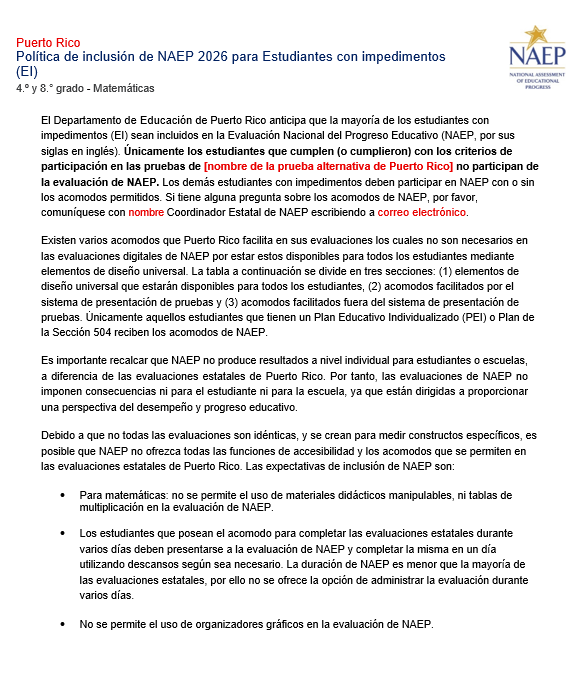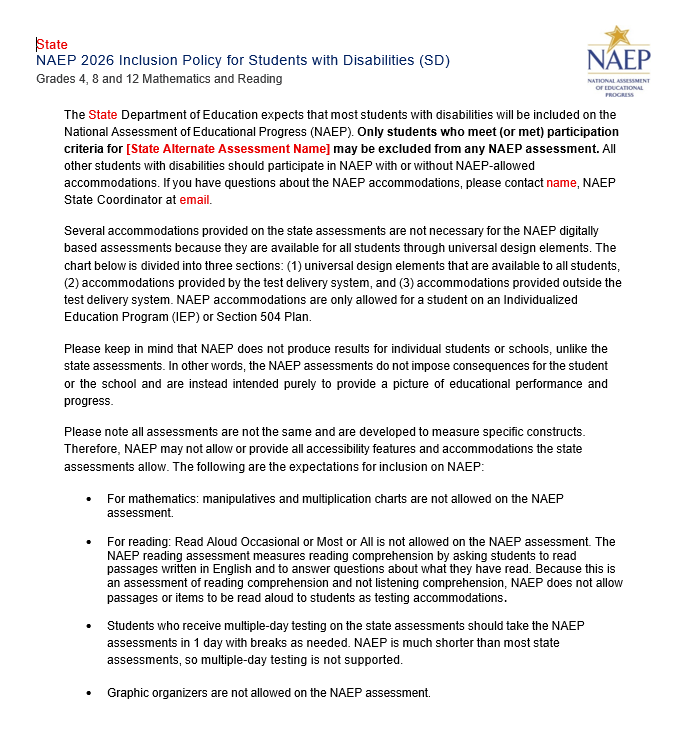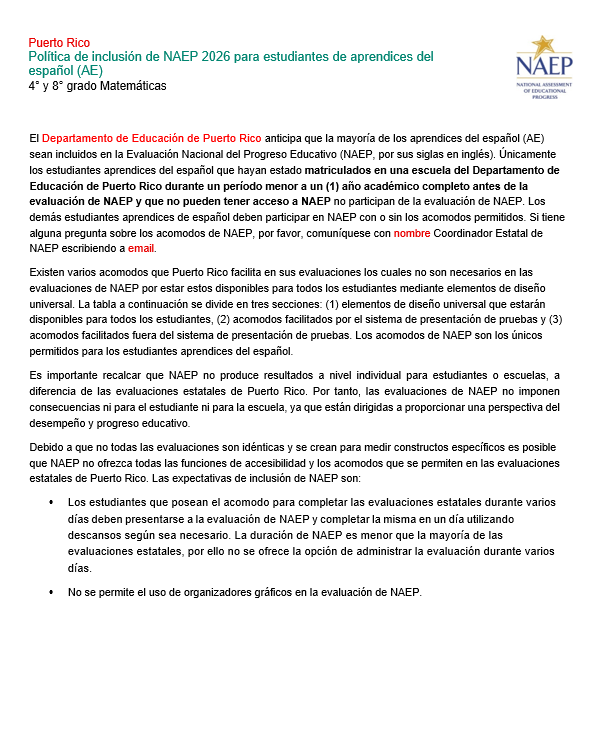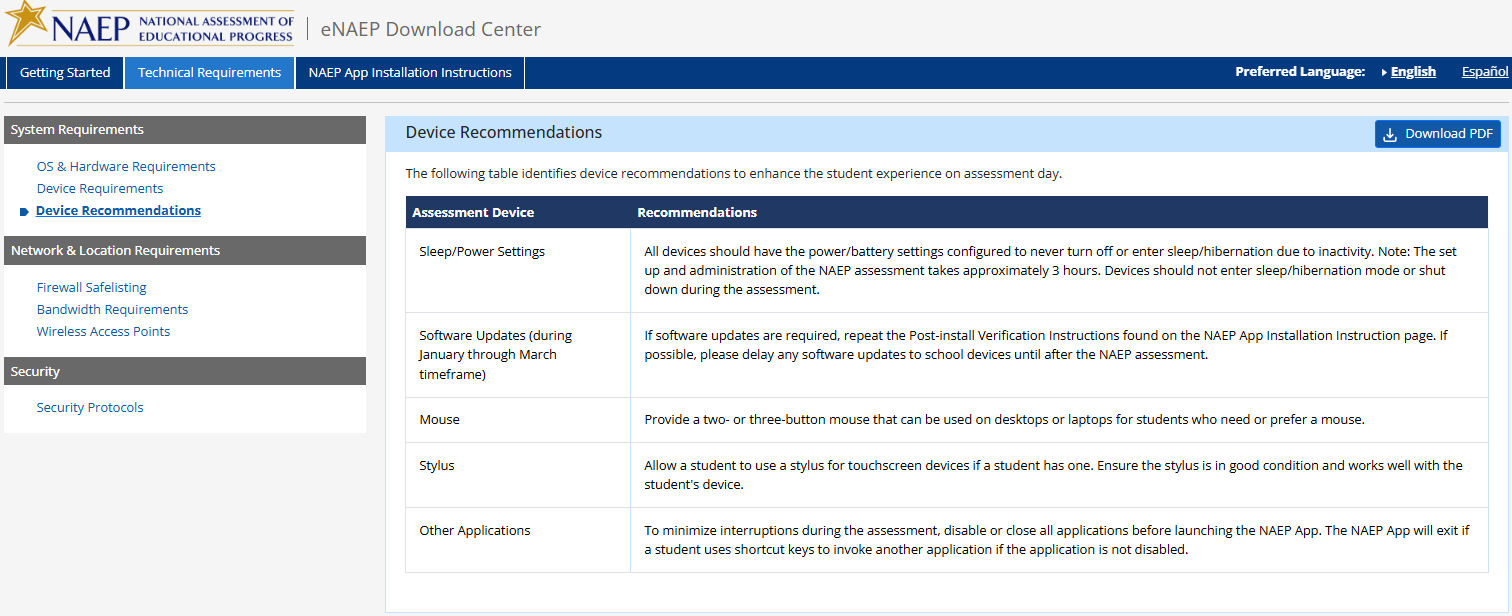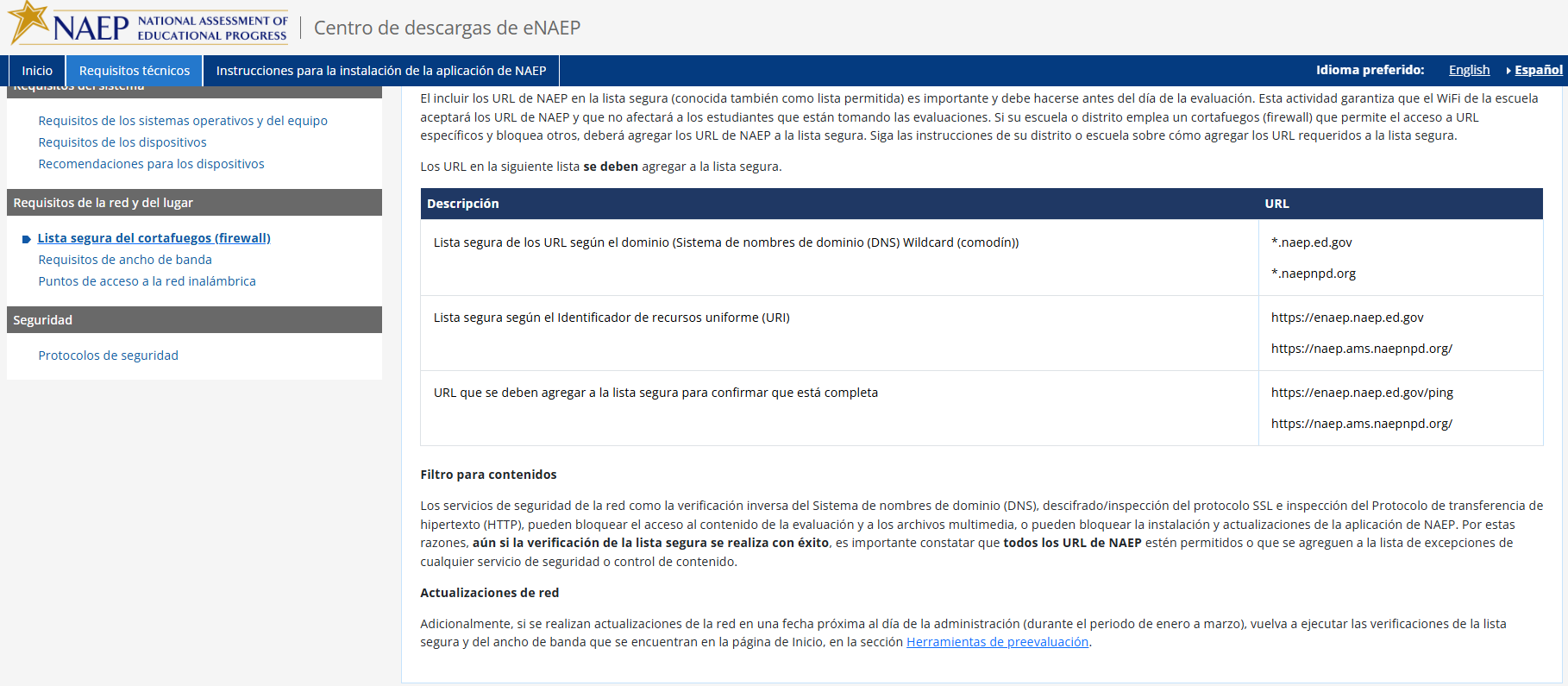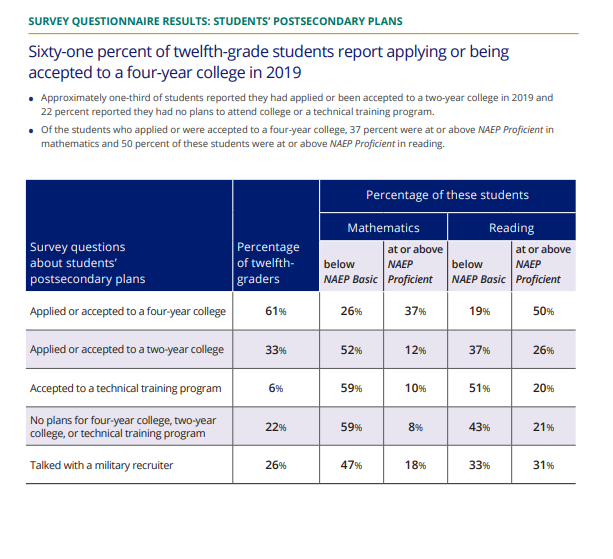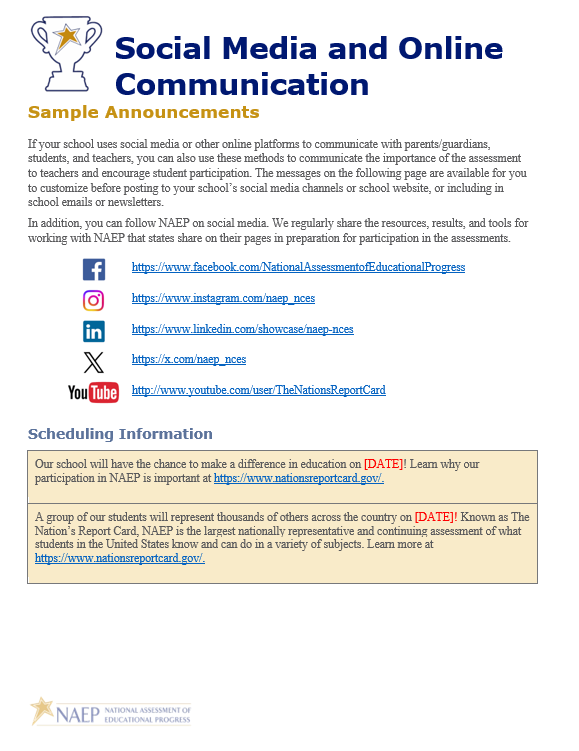Appendix D - NAEP Communications and Recruitment Materials
NAEP 2026 Appendix D v37.docx
National Assessment of Educational Progress (NAEP) 2026 Amendment 1
Appendix D - NAEP Communications and Recruitment Materials
OMB: 1850-0928
NATIONAL CENTER FOR EDUCATION STATISTICS
NATIONAL ASSESSMENT OF EDUCATIONAL PROGRESS
National Assessment of Education Progress (NAEP) 2026
Appendix D
NAEP Communications and Recruitment Materials
OMB# 1850-0928 v.37

July 2025
All communication and recruitment materials included in this Appendix will be used in 2026 Main NAEP Operational and Pilot Administrations. The table below shows the administration window and subjects.
-
Activity
Window
Grade
Subjects
Main NAEP and Pilot Administration
January-March 2026
4, 8, 12
Math, Reading, U.S. History/Civics
Important changes in how we collect demographic information are reflected in the 2026 instruments that are ready for publication and review. In March 2024, the Office of Management and Budget (OMB) announced revisions to Statistical Policy Directive No. 15: Standards for Maintaining, Collecting, and Presenting Federal Data on Race and Ethnicity (SPD 15) and published the revised SPD15 standard in the Federal Register (89 FR 22182). See Part A.7 of this package to see how NCES plans to incorporate these revisions into NAEP 2026.
Additionally, materials in this Amendment are in compliance with the White House’s Executive Orders “Defending Women from Gender Ideology Extremism and Restoring Biological Truth to the Federal Government,” (January 20, 2025) and “Ending Radical and Wasteful Government DEI Programs and Preferencing,” (January 20, 2025).
Amendment #1 Appendix D represents materials for NAEP 2026. The 2026 communications that are included for the first time are marked as “(NEW)”. A few materials previously submitted in the Clearance package were updated and are marked as “(Revised).” Amendment #2 is scheduled for late Summer 2025 and may include remaining materials for the 2026 Main NAEP Operational and Pilot administrations.
Table of Contents
Appendix D-1: NAEP 2026 Save-the-Date (NEW) 10
Appendix D-2: NAEP 2026 Save-the-Date, Puerto Rico (NEW) 12
Appendix D-3: NAEP 2026 Initial School Technology Survey Notification (Approved v.36) 14
Appendix D-4: NAEP 2026 Initial School Technology Survey Notification, Puerto Rico (NEW) 17
Appendix D-5: NAEP 2026 Parent-Guardian Notification Letter, Public School (NEW) 19
Appendix D-6: NAEP 2026 Parent-Guardian Notification Letter, Private Schools (NEW) 21
Appendix D-7: NAEP 2026 Parent-Guardian Notification Letter, Puerto Rico (NEW) 23
Appendix D-10: NAEP 2026 Assessment Details Letter to Principal, School Device Model (NEW) 29
Appendix D-14: NAEP 2026 Assessment Details Letter to Principal, NAEP Device Model (NEW) 45
Appendix D-20: NAEP 2026 Assessment Details Letter to School Coordinator NAEP Device Model (NEW) 68
Appendix D-23: NAEP 2026 NAEP in your School-School Device, School Device-Puerto Rico (NEW) 80
Appendix D-25: NAEP 2026 NAEP in your School-NAEP Device, Puerto Rico (NEW) 88
Appendix D-28: NAEP 2026 NAEP in your School, Grade 8 Civics and U.S. History (NEW) 98
Appendix D-29: NAEP 2026 NAEP in your School-NAEP Device, Pilot (NEW) 102
Appendix D-30: NAEP 2026 NAEP in your School-NAEP Device, Pilot, Puerto Rico (NEW) 105
Appendix D-31: NAEP 2026 NAEP in your School-School Device, Pilot (NEW) 109
Appendix D-32: NAEP 2026 NAEP in your School-School Device, Pilot, Puerto Rico (NEW) 113
Appendix D-33: NAEP 2026 Facts for Teachers (NEW) 117
Appendix D-34: NAEP 2026 Facts for Teachers, Private Schools (NEW) 124
Appendix D-35: NAEP 2026 Facts for Teachers, Puerto Rico (NEW) 131
Appendix D-36: NAEP 2026 Preassessment Responsibilities Guide, School Device Model (NEW) 136
Appendix D-39: NAEP 2026 Preassessment Responsibilities Guide, NAEP Device Model (NEW) 150
Appendix D-42: NAEP 2026 Preassessment Notification, School Device Model (NEW) 162
Appendix D-43: NAEP 2026 Preassessment Notification-Private School, School Device Model (NEW) 164
Appendix D-44: NAEP 2026 Preassessment Notification, School Device Model, Puerto Rico (NEW) 166
Appendix D-45: NAEP 2026 Preassessment Notification, NAEP Device Model (NEW) 169
Appendix D-46: NAEP 2026 Preassessment Notification-Private School, NAEP Device Model (NEW) 171
Appendix D-47: NAEP 2026 Preassessment Email, NAEP Device Model, Puerto Rico (NEW) 173
Appendix D-48: NAEP 2026 eNAEP Download Center Notification (Approved v.36) 175
Appendix D-49: NAEP 2026 eNAEP Download Center Notification, Puerto Rico (NEW) 178
Appendix D-50: NAEP 2026 School Staff Assistance email templates (NEW) 181
Appendix D-51: NAEP 2026 School Staff Assistance email template, Puerto Rico (NEW) 189
Appendix D-52: NAEP 2026 School staff Assistance Guidelines (NEW) 194
Appendix D-53: NAEP 2026 School staff Assistance Guidelines, Puerto Rico (NEW) 198
Appendix D-54: NAEP 2026 Inclusion Guidelines for English Learners (NEW) 203
Appendix D-55: NAEP 2026 Inclusion Guidelines for English Learners, Pilot (NEW) 208
Appendix D-56: NAEP 2026 Inclusion Guidelines for English Learners, Puerto Rico (NEW) 213
Appendix D-57: NAEP 2026 Inclusion Guidelines for English Learners, Pilot, Puerto Rico (NEW) 219
Appendix D-58: NAEP 2026 Inclusion Guidelines for Students with Disabilities (NEW) 225
Appendix D-59: NAEP 2026 Inclusion Guidelines for Students with Disabilities, Pilot (NEW) 230
Appendix D-60: NAEP 2026 Inclusion Guidelines for Students with Disabilities, Puerto Rico (NEW) 236
Appendix D-62: NAEP 2026 eNAEP Download Center (Revised) 246
Appendix D-63: NAEP 2026 eNAEP Download Center, Spanish (Revised) 301
Appendix D-64: NAEP 2026 eNAEP Download Center – Maintenance Page in English (Revised) 354
Appendix D-65: NAEP 2026 eNAEP Download Center – Maintenance Page in Spanish (Revised) 356
Appendix D-66: NAEP 2026 eNAEP Download Center – Page Not Found Error Page in English (Revised) 358
Appendix D-67: NAEP 2026 eNAEP Download Center – Page Not Found Error Page in Spanish (Revised) 359
Appendix D-68: NAEP 2026 Best Practices Introduction (NEW) 360
Appendix D-69: NAEP 2026 Best Practices Notification (NEW) 362
Appendix D-70: NAEP 2026 Best Practices Storyboard for Introduction Video (NEW) 364
Appendix D-71: NAEP 2026 Best Practices Storyboard for Introduction Video, Private Schools (NEW) 366
Appendix D-72: NAEP 2026 Best Practices HTML Email 1 (NEW) 370
Appendix D-73: NAEP 2026 Best Practices HTML Email 2 (NEW) 372
Appendix D-74: NAEP 2026 Best Practices HTML Email 3 (NEW) 374
Appendix D-76: NAEP 2026 Best Practices PowerPoint Slide TV Monitor Announcement (NEW) 382
Appendix D-77: NAEP 2026 Best Practices PowerPoint Slides: Introducing NAEP to Parents (NEW) 384
Appendix D-78: NAEP 2026 Best Practices PowerPoint Slides: Introducing NAEP to Students (NEW) 394
Appendix D-79: NAEP 2026 Best Practices PowerPoint Slides: Introducing NAEP to Teachers (NEW) 403
Appendix D-80: NAEP 2026 Best Practices Talking Points Principals and Teachers to Parents (NEW) 412
Appendix D-81: NAEP 2026 Best Practices Talking Points Principals and Teachers to Students (NEW) 414
Appendix D-82: NAEP 2026 Best Practices Talking Points Principals to Teachers (NEW) 416
Appendix D-83: NAEP 2026 Best Practices School Announcement Templates (NEW) 418
Appendix D-84: NAEP 2026 Best Practices High School Incentive Ideas (NEW) 420
Appendix D-86: NAEP 2026 Best Practices NAEP Data, Tools, and Resources (NEW) 426
Appendix D-87: NAEP 2026 Facts for Districts (Approved v.36) 430
Appendix D-88: NAEP 2026 Facts for Districts, Puerto Rico (NEW) 434
Appendix D-89: NAEP 2026 Facts for Principals (Approved v.36) 438
Appendix D-90: NAEP 2026 Facts for Principals, Puerto Rico (NEW) 448
Appendix D-96: NAEP 2026 State Guide (Approved v.36) 471
Appendix D-97: NAEP 2026 TUDA Guide to NAEP Participation (Approved v.36) 476
Appendix D-98: NAEP 2026 Endorsement Letters to Private School Administrator (Approved v.36) 481
Appendix D-99: NAEP 2026 District Model Assignment Notification (NEW) 485
Appendix D-100: NAEP 2026 District Model Assignment Notification, Puerto Rico (NEW) 487
Appendix D-1: NAEP 2026 Save-the-Date (NEW)
NAEP 2026 Save-the-Date Letter From
NAEP STATE COORDINATOR TO SCHOOL PRINCIPAL – For All Sampled Schools
Red text should be customized before mail merge; highlighted text represents mail merge fields
Save the date! NAEP is coming.
Dear Principal:
I previously notified you that school name was selected to participate in the 2026 administration of the National Assessment of Educational Progress (NAEP), and now we have your assessment date.
When is your assessment date?
Your school’s grade (4 or 8 or 12) students will take the assessment on (assessment date). Please place the NAEP assessment date on your 2025–2026 school calendar.
What else do I need to know?
About (estimated student sample) students from your school will be selected to participate, but that number will vary depending on actual fall 2025 student enrollment numbers.
The assessment will take about 120 minutes for most students, including transition time, directions, and completion of survey questions.
NAEP representatives will provide significant support to your school.
If you have questions about the scheduled assessment date, please contact me at telephone number or email address by date.
Sincerely,
NAEP State Coordinator
CC: District Assessment Coordinator
School Coordinator
The National Center for Education Statistics (NCES) conducts the National Assessment of Educational Progress to evaluate federally supported education programs. All of the information you provide may only be used for the purposes of research, statistics, and evaluation under the Education Sciences Reform Act of 2002 (ESRA; 20 U.S.C. § 9543) and may not be disclosed, or used, in identifiable form for any other purpose except as required by law. Every NCES employee as well as every NCES agent, such as contractors and NAEP coordinators, has taken an oath and is subject to a jail term of up to 5 years, a fine of $250,000, or both if he or she willfully discloses ANY identifiable information about you in any unauthorized manner. Electronic submission of your information will be monitored for viruses, malware, and other threats by Federal employees and contractors in accordance with the Cybersecurity Enhancement Act of 2015.
Appendix D-2: NAEP 2026 Save-the-Date, Puerto Rico (NEW)
Carta de NAEP 2026 para reservar la fecha
DEL(DE LA) COORDINADOR(A) ESTATAL DE NAEP AL(A LA) DIRECTOR(A) ESCOLAR – Para todas las escuelas en la muestra
Se debe personalizar el texto en rojo antes de combinar la correspondencia, el texto resaltado representa los campos que se deben combinar.
¡Reserve la fecha! NAEP está por llegar.
Estimado(a) director(a):
Anteriormente le notifiqué que nombre de la escuela fue seleccionada para participar en la administración de la Evaluación Nacional del Progreso Educativo (NAEP) de 2026, y ahora tenemos su fecha de evaluación.
¿Cuándo es su fecha de evaluación?
Los estudiantes de (4.º u 8.º) grado de su escuela tomarán la evaluación el (fecha de evaluación). Por favor, coloque la fecha de la evaluación de NAEP en su calendario escolar 2025-2026.
¿Qué más necesito saber?
Se seleccionarán a (muestra estimada de estudiantes) estudiantes de su escuela para participar, pero ese número cambiará dependiendo de la matrícula real de estudiantes en el otoño de 2025.
A la mayoría de los estudiantes les tomará alrededor de 120 minutos completar la evaluación, incluyendo el tiempo de transición, las instrucciones y completar las preguntas de contexto.
Los representantes de NAEP le proporcionarán bastante apoyo a su escuela.
Si tiene alguna pregunta sobre la fecha programada para la evaluación, comuníquese conmigo al número de teléfono o escribiendo a dirección de correo electrónico antes de fecha.
Atentamente,
Coordinador(a) estatal de NAEP
CC: Coordinador(a) distrital de evaluación
Coordinador(a) escolar
El Centro Nacional para Estadísticas de la Educación (NCES, por sus siglas en inglés) administra la Evaluación Nacional del Progreso Educativo para evaluar programas de educación apoyados por el Gobierno federal. Toda la información que proporcione podrá usarse únicamente con fines de investigación, estadísticas y evaluación en virtud de la Ley de Reforma de las Ciencias Educativas de 2002 (ERSA; 20 U.S.C §9573) y no podrá darse a conocer para identificarlo ni para cualquier otro propósito salvo aquel requerido legalmente. Todos los empleados de NCES al igual que todos los representantes del mismo, como contratistas y coordinadores de NAEP, han hecho un juramento y están sujetos a una pena de prisión de hasta 5 años, una multa de hasta $250,000 o ambas cosas, si dan a conocer intencionalmente CUALQUIER información que lo identifique de manera no autorizada. El envío de su información por vía electrónica será monitoreado por empleados y contratistas federales para detectar virus, programas maliciosos (malware) y otras amenazas conforme a la Ley de Mejoramiento de la Seguridad Cibernética de 2015.
Appendix D-3: NAEP 2026 Initial School Technology Survey Notification (Approved v.36)
NAEP 2026 – Initial School Technology Survey Notification Letter
NAEP STATE COORDINATOR TO SCHOOL TECHNOLOGY SURVEY RECIPIENT
Red text should be customized before mail merge, highlighted text represents mail merge fields.
::Do not distribute until notified that the AMS is ready for school and district user access::
Dear [District Technology Director / District Assessment Coordinator/Principal]:
Thank you for all you do to support education in state name. I am writing to notify you that one or more schools in your district have been sampled for the 2026 administration of the National Assessment of Educational Progress (NAEP). NAEP will be administered on Chromebooks provided by NAEP or school devices.
To
determine each school’s ability to support the administration
of NAEP using school devices, we need to understand the technical
specifications of the devices used for testing at [School
Name].
/ the following schools:
School 1
School 2
School 3, etc.
Your role will be to do the following:
Register for the NAEP Assessment Management System using the link provided in the registration email from [email domain]
Complete the School Technology Survey in the Assessment Management System for each school listed above by [date], which requires knowledge of
the device operating system and available hardware for each sampled school,
district or school device management and security policies, and
any device sharing across schools.
Identify an Application Installer for each sampled school assigned to administer NAEP on school devices after the completion of the School Technology Survey. This individual will be responsible for
deploying the NAEP Assessment Application to school devices, and
running a verification check on at least one of the devices that will be used to administer the NAEP assessment. .
*Note, if you would like to designate someone to complete the survey on your behalf, please send their name and email address to [NSC/NTC name] at [NSC/NTC email address].
The NAEP Assessment Application is COPPA and FERPA compliant and does not collect any student education records or personally identifiable information (PII) from students. The application and additional technical details about taking NAEP assessments on school or district devices are posted on the eNAEP Download Center at [eNAEP Download Center URL].
You will receive more details on how each school will be assessed and information on the next steps after completing the School Technology Survey.
What is NAEP?
NAEP is the largest nationally representative and continuing assessment of what our nation’s students know and can do in various subjects. NAEP is administered by the National Center for Education Statistics (NCES), within the U.S. Department of Education.
What will NAEP assess in 2026?
In 2026, NAEP will assess students in mathematics and reading at grades 4, 8, and 12, and in civics and U.S. history at grade 8. The mathematics and reading assessments will be administered on Chromebooks provided by NAEP or school devices. The civics and U.S. history assessments will be administered on Chromebooks provided by NAEP.
What if I have questions?
If you have questions about the School Technology Survey, please contact the NAEP help desk at [help desk phone number] or [help desk email]. If you have other questions about NAEP, please contact me at NSC/NTC telephone number or NSC/NTC email address.
Again, thank you for your assistance with this very important assessment.
Sincerely,
NAEP State/TUDA Coordinator
Attachments:
School Technology Survey questions PDF (optional)
The National Center for Education Statistics (NCES) conducts the National Assessment of Educational Progress to evaluate federally supported education programs. All of the information you provide may only be used for the purposes of research, statistics, and evaluation under the Education Sciences Reform Act of 2002 (ESRA; 20 U.S.C. § 9543) and may not be disclosed, or used, in identifiable form for any other purpose except as required by law. Every NCES employee as well as every NCES agent, such as contractors and NAEP coordinators, has taken an oath and is subject to a jail term of up to 5 years, a fine of $250,000, or both if he or she willfully discloses ANY identifiable information about you in any unauthorized manner. Electronic submission of your information will be monitored for viruses, malware, and other threats by Federal employees and contractors in accordance with the Cybersecurity Enhancement Act of 2015.
Appendix D-4: NAEP 2026 Initial School Technology Survey Notification, Puerto Rico (NEW)
NAEP de 2026 - Carta de notificación inicial de la encuesta sobre la tecnología de la escuela
DEL(DE LA) COORDINADOR(A) ESTATAL DE NAEP AL(A LA) DESTINATARIO(A) DE LA ENCUESTA SOBRE LA TECNOLOGÍA DE LA ESCUELA
Se debe personalizar el texto en rojo antes de combinar la correspondencia: El texto resaltado representa los campos que se deben combinar
::No distribuir hasta que se le notifique que el AMS está listo para que los usuarios de la escuela y del distrito puedan acceder al mismo::
Estimado(a) [director(a) de tecnología distrital / coordinador(a) de evaluación distrital / director(a)]:
Gracias por todo lo que hace para apoyar la educación en Puerto Rico. Le escribo para notificarle que una o más escuelas de su distrito han sido incluidas en la muestra para la administración de la Evaluación Nacional del Progreso Educativo (NAEP, por sus siglas en inglés) de 2026. NAEP será administrada en dispositivos Chromebook proporcionados por NAEP o en dispositivos de la escuela.
Para
determinar si cada escuela puede facilitar la administración
de NAEP utilizando los dispositivos de la escuela, necesitamos
conocer las especificaciones técnicas de los dispositivos que
se utilizarán para realizar las pruebas en [Nombre
de la escuela].
/ las siguientes escuelas.
Escuela 1
Escuela 2
Escuela 3, etc.
Su función será hacer lo siguiente:
Registrarse en el Sistema de Administración de la Evaluación de NAEP utilizando el enlace que se proporciona en el correo electrónico de registro de [dominio de correo electrónico].
Completar la Encuesta sobre la tecnología de la escuela en el Sistema de Administración de la Evaluación para cada escuela en la lista anterior antes del [fecha], lo cual requiere conocimiento sobre:
el sistema operativo de los dispositivos y el hardware disponible para cada escuela de la muestra;
las políticas de gestión y seguridad de los dispositivos del distrito o de la escuela; y
dispositivos que sean compartidos entre escuelas.
Identificar a un instalador de la aplicación para cada escuela en la muestra que haya sido asignada para administrar NAEP en los dispositivos de la escuela después de haber completado la Encuesta sobre la tecnología de la escuela. Esta persona estará a cargo de:
distribuir la aplicación de evaluación de NAEP en los dispositivos de la escuela, y
realizar una verificación en al menos uno de los dispositivos que se utilizarán para administrar la evaluación NAEP.
*Nota, si desea designar a alguien para que complete la encuesta en su nombre, envíe el nombre y dirección de correo electrónico a [nombre del(de la) coordinador(a)] escribiendo a [correo electrónico del(de la) coordinador(a)].
La aplicación de evaluación de NAEP cumple con las leyes COPPA y FERPA y no recopila ningún registro educativo de los estudiantes ni información de identificación personal (PII) de los estudiantes. La aplicación y los detalles técnicos adicionales sobre cómo tomar las evaluaciones de NAEP en los dispositivos de la escuela o del distrito se publican en el Centro de descargas de eNAEP en [URL del Centro de descargas de eNAEP].
Recibirá más detalles sobre cómo se evaluará a cada escuela e información sobre los siguientes pasos tras completar la Encuesta sobre la tecnología de la escuela.
¿Qué es NAEP?
NAEP es la evaluación continua más grande y representativa a nivel nacional de lo que los estudiantes de nuestra nación saben y pueden hacer en varias materias. NAEP es administrada por el Centro Nacional de Estadísticas de la Educación (NCES), parte del Departamento de Educación de Estados Unidos.
¿Qué evaluará NAEP en Puerto Rico en 2026?
En 2026, NAEP evaluará a los estudiantes en matemáticas en los grados 4.º y 8.º. Las evaluaciones de matemáticas se administrarán en dispositivos Chromebook proporcionados por NAEP o dispositivos de la escuela.
¿Qué debo hacer si tengo preguntas?
Si tiene alguna pregunta sobre la Encuesta sobre la tecnología de la escuela, por favor comuníquese con el Centro de Ayuda de NAEP (Help Desk) llamando al [número de teléfono de la oficina de ayuda] o escribiendo a [dirección de correo electrónico de la oficina de ayuda]. Si tiene otras preguntas sobre NAEP, comuníquese conmigo llamando al [número de teléfono del(de la) coordinador(a)] o escribiendo a [dirección de correo electrónico del(de la) coordinador(a)].
Una vez más, gracias por su ayuda en esta evaluación tan importante.
Atentamente,
Coordinador(a) estatal de NAEP
Adjuntos:
Preguntas de la encuesta sobre la tecnología de la escuela PDF (opcional)
El Centro Nacional para Estadísticas de la Educación (NCES, por sus siglas en inglés) administra la Evaluación Nacional del Progreso Educativo para evaluar programas de educación apoyados por el Gobierno federal. Toda la información que proporcione podrá usarse únicamente con fines de investigación, estadísticas y evaluación en virtud de la Ley de Reforma de las Ciencias Educativas de 2002 (ERSA; 20 U.S.C §9573) y no podrá darse a conocer para identificarlo ni para cualquier otro propósito salvo aquel requerido legalmente. Todos los empleados de NCES al igual que todos los representantes del mismo, como contratistas y coordinadores de NAEP, han hecho un juramento y están sujetos a una pena de prisión de hasta 5 años, una multa de hasta $250,000 o ambas cosas, si dan a conocer intencionalmente CUALQUIER información que lo identifique de manera no autorizada. El envío de su información por vía electrónica será monitoreado por empleados y contratistas federales para detectar virus, programas maliciosos (malware) y otras amenazas conforme a la Ley de Mejoramiento de la Seguridad Cibernética de 2015.
Appendix D-5: NAEP 2026 Parent-Guardian Notification Letter, Public School (NEW)
NAEP 2026 PARENT-GUARDIAN NOTIFICATION LETTER
Grades 4, 8, and 12 Civics, Mathematics, Reading, or U.S. History
(School Letterhead)
(Insert Date Here)
Dear Parent or Guardian:
(School name) will participate in the National Assessment of Educational Progress (NAEP) on (date). NAEP is the largest nationally representative and continuing assessment of what students know and can do in various subjects. NAEP is administered by the National Center for Education Statistics, within the U.S. Department of Education. NAEP is different from our state assessments because it is a common measure of achievement across the country.
Your child (will/may) take a civics, mathematics, reading, or U.S. history assessment. In addition to subject-area questions, students voluntarily complete NAEP survey questions. These questions provide valuable information about participating students’ educational experiences and opportunities to learn both in and outside of the classroom. More information about NAEP survey questions is available at https://nces.ed.gov/nationsreportcard/parents under the section “Survey Questionnaires & Your Student: What You Need to Know.”
The assessment takes about 120 minutes for most students, which includes transition time, directions, and completion of survey questions.
The information collected is used for statistical purposes only.
Your child’s grades will not be affected.
Students may be excused for any reason, are not required to complete the assessment, and may skip any question.
While the assessment is voluntary, NAEP depends on student participation to help policymakers improve education. If you do not want your child to participate, please notify me in writing by (date).
There is no need to study in preparation for NAEP, but please encourage your child to do their best. Contact (name) at (telephone number) or at (email address) if you have any questions.
We are excited that our school is participating in NAEP. We know that (school name)’s students will show what our nation’s students know and can do.
Sincerely,
(School Principal’s Name)
The National Center for Education Statistics (NCES) conducts the National Assessment of Educational Progress to evaluate federally supported education programs. All of the information you provide may only be used for the purposes of research, statistics, and evaluation under the Education Sciences Reform Act of 2002 (ESRA; 20 U.S.C. § 9543) and may not be disclosed, or used, in identifiable form for any other purpose except as required by law. Every NCES employee as well as every NCES agent, such as contractors and NAEP coordinators, has taken an oath and is subject to a jail term of up to 5 years, a fine of $250,000, or both if he or she willfully discloses ANY identifiable information about you in any unauthorized manner. Electronic submission of your information will be monitored for viruses, malware, and other threats by Federal employees and contractors in accordance with the Cybersecurity Enhancement Act of 2015.
Appendix D-6: NAEP 2026 Parent-Guardian Notification Letter, Private Schools (NEW)
NAEP 2026 PARENT/GUARDIAN NOTIFICATION LETTER PRIVATE SCHOOL
Grades 4 and 8 Civics, Mathematics, Reading, or U.S. History
(School Letterhead)
(Insert Date Here)
Dear Parent or Guardian:
We are pleased to notify you that (school name) has been selected to represent private schools across the nation by participating in the National Assessment of Educational Progress (NAEP) on (date). NAEP is the largest nationally representative and continuing assessment of what students in public and private schools know and can do in various subjects. NAEP is different from state and school assessments because it provides a common measure of student achievement across the country. NAEP is administered by the National Center for Education Statistics, within the U.S. Department of Education. The results are released as The Nation’s Report Card, which provides information about student achievement to educators, parents, policymakers, and the public.
Your child (will/may) take a civics, mathematics, reading, or U.S. history assessment. In addition to subject-area questions, students voluntarily complete NAEP survey questions. The questions provide valuable information about participating students’ educational experiences and opportunities to learn both in and outside of the classroom. More information is available at https://nces.ed.gov/nationsreportcard/parents under the section “Survey Questionnaires & Your Student: What You Need to Know.”
The assessment takes about 120 minutes for most students, including transition time, directions, and completion of the survey questions.
The information collected is used for statistical purposes only.
Your child’s grades will not be affected.
Students may be excused for any reason, are not required to complete the assessment, and may skip any question.
While the assessment is voluntary, NAEP depends on student participation to help policymakers improve education. If you do not want your child to participate, please notify me in writing by (date).
There is no need to study in preparation for NAEP, but please encourage your child to do their best. Contact (name) at (telephone number) or at (email address) if you have any questions. To learn more about private school participation in NAEP, visit https://nces.ed.gov/nationsreportcard/participating/private_nonpublic.aspx.
We are excited that our school is participating in NAEP. We know that (school name)’s students will show what our nation’s private school students know and can do.
Sincerely,
(School Principal’s Name)
The National Center for Education Statistics (NCES) conducts the National Assessment of Educational Progress to evaluate federally supported education programs. All of the information you provide may only be used for the purposes of research, statistics, and evaluation under the Education Sciences Reform Act of 2002 (ESRA; 20 U.S.C. § 9543) and may not be disclosed, or used, in identifiable form for any other purpose except as required by law. Every NCES employee as well as every NCES agent, such as contractors and NAEP coordinators, has taken an oath and is subject to a jail term of up to 5 years, a fine of $250,000, or both if he or she willfully discloses ANY identifiable information about you in any unauthorized manner. Electronic submission of your information will be monitored for viruses, malware, and other threats by Federal employees and contractors in accordance with the Cybersecurity Enhancement Act of 2015.
Appendix D-7: NAEP 2026 Parent-Guardian Notification Letter, Puerto Rico (NEW)
CARTA DE NOTIFICACIÓN A LOS PADRES O TUTORES SOBRE NAEP DE 2026
Puerto Rico
(Membrete de la escuela)
(Coloque la fecha aquí)
Estimado(a) padre, madre o tutor:
(Nombre de la escuela) participará en la Evaluación Nacional del Progreso Educativo (NAEP, por sus siglas en inglés) el (fecha). NAEP es la evaluación continua y nacionalmente representativa más grande acerca de lo que los estudiantes saben y pueden hacer en diferentes materias. NAEP es administrada por el Centro Nacional de Estadísticas de la Educación (NCES, por sus siglas en inglés), parte del Departamento de Educación de Estados Unidos. NAEP es diferente de nuestras evaluaciones estatales ya que ofrece una medida común de los logros en todo el país.
Su hijo(a) (tomará/posiblemente tome) una evaluación de matemáticas. Además de las preguntas sobre matemáticas, los estudiantes contestan preguntas de contexto de NAEP de manera voluntaria. Las preguntas proporcionan información valiosa acerca de las experiencias y oportunidades de aprendizaje dentro y fuera del salón de clases de los estudiantes participantes. Puede encontrar más información acerca de las preguntas de NAEP en https://nces.ed.gov/nationsreportcard/parents/spanish.aspx en la sección “Cuestionarios de contexto y su estudiante: Lo que debe saber.”
La evaluación toma unos 120 minutos para la mayoría de los estudiantes, incluyendo el tiempo de transición, instrucciones y el contestar las preguntas de contexto.
La información recolectada se utiliza únicamente con fines estadísticos.
Las calificaciones de su hijo(a) no se verán afectadas.
Los estudiantes pueden ser excusados por cualquier motivo, no están obligados a completar la evaluación y pueden dejar de responder cualquier pregunta.
Aunque la evaluación es voluntaria, NAEP depende de la participación de los estudiantes para ayudarles a los legisladores a mejorar la educación. Si no desea que su hijo(a) participe, por favor, notifíqueme por escrito antes de (fecha).
No es necesario estudiar en preparación para NAEP, pero anime a su hijo(a) a que haga su mejor esfuerzo. Si tiene alguna pregunta, comuníquese con (nombre) llamando al (número de teléfono) o por correo electrónico escribiendo a (correo electrónico).
Nos entusiasma que nuestra escuela participe en NAEP. Sabemos que los estudiantes de (nombre de la escuela) mostrarán lo que los estudiantes de nuestro país saben y pueden hacer.
Atentamente,
(Nombre del director(a) de la escuela)
El Centro Nacional para Estadísticas de la Educación (NCES, por sus siglas en inglés) administra la Evaluación Nacional del Progreso Educativo para evaluar programas de educación apoyados por el Gobierno federal. Toda la información que proporcione podrá usarse únicamente con fines de investigación, estadísticas y evaluación en virtud de la Ley de Reforma de las Ciencias Educativas de 2002 (ERSA; 20 U.S.C §9573) y no podrá darse a conocer para identificarlo ni para cualquier otro propósito salvo aquel requerido legalmente. Todos los empleados de NCES al igual que todos los representantes del mismo, como contratistas y coordinadores de NAEP, han hecho un juramento y están sujetos a una pena de prisión de hasta 5 años, una multa de hasta $250,000 o ambas cosas, si dan a conocer intencionalmente CUALQUIER información que lo identifique de manera no autorizada. El envío de su información por vía electrónica será monitoreado por empleados y contratistas federales para detectar virus, programas maliciosos (malware) y otras amenazas conforme a la Ley de Mejoramiento de la Seguridad Cibernética de 2015.
Appendix D-8: NAEP 2026 Parent-Guardian Notification Letter, Bilingual Spanish Public Schools (NEW)
CARTA DE NOTIFICACIÓN A LOS PADRES O TUTORES SOBRE NAEP DE 2026
Evaluaciones de Educación Cívica, Matemáticas, Lectura e Historia de Estados Unidos para 4.º, 8.º y 12.º grado
(Membrete de la escuela)
(Coloque la fecha aquí)
Estimado(a) padre, madre o tutor:
(Nombre de la escuela) participará en la Evaluación Nacional del Progreso Educativo (NAEP, por sus siglas en inglés) el (fecha). NAEP es la evaluación continua y nacionalmente representativa más grande acerca de lo que los estudiantes saben y pueden hacer en diferentes materias. NAEP es administrada por el Centro Nacional de Estadísticas de la Educación (NCES, por sus siglas en inglés), parte del Departamento de Educación de Estados Unidos. NAEP es diferente de nuestras evaluaciones estatales ya que ofrece una medida común de los logros en todo el país.
Su hijo(a) (tomará/posiblemente tome) una evaluación de educación cívica, matemáticas, lectura o historia de Estados Unidos. Además de las preguntas sobre la materia, los estudiantes contestan preguntas de contexto de NAEP de manera voluntaria. Las preguntas proporcionan información valiosa acerca de las experiencias y oportunidades de aprendizaje dentro y fuera del salón de clases de los estudiantes participantes. Puede encontrar más información acerca de las preguntas de NAEP en https://nces.ed.gov/nationsreportcard/parents/spanish.aspx en la sección “Cuestionarios de contexto y su estudiante: Lo que debe saber.”
La evaluación toma unos 120 minutos para la mayoría de los estudiantes, incluyendo el tiempo de transición, instrucciones y el contestar las preguntas de contexto.
La información recolectada se utiliza únicamente con fines estadísticos.
Las calificaciones de su hijo(a) no se verán afectadas.
Los estudiantes pueden ser excusados por cualquier motivo, no están obligados a completar la evaluación y pueden dejar de responder cualquier pregunta.
Aunque la evaluación es voluntaria, NAEP depende de la participación de los estudiantes para ayudarles a los legisladores a mejorar la educación. Si no desea que su hijo(a) participe, por favor, notifíqueme por escrito antes de (fecha).
No es necesario estudiar en preparación para NAEP, pero anime a su hijo(a) a que haga su mejor esfuerzo. Si tiene alguna pregunta, comuníquese con (nombre) llamando al (número de teléfono) o por correo electrónico escribiendo a (correo electrónico).
Nos entusiasma que nuestra escuela participe en NAEP. Sabemos que los estudiantes de (nombre de la escuela) mostrarán lo que los estudiantes de nuestro país saben y pueden hacer.
Atentamente,
(Nombre del director(a) de la escuela)
El Centro Nacional para Estadísticas de la Educación (NCES, por sus siglas en inglés) administra la Evaluación Nacional del Progreso Educativo para evaluar programas de educación apoyados por el Gobierno federal. Toda la información que proporcione podrá usarse únicamente con fines de investigación, estadísticas y evaluación en virtud de la Ley de Reforma de las Ciencias Educativas de 2002 (ERSA; 20 U.S.C §9573) y no podrá darse a conocer para identificarlo ni para cualquier otro propósito salvo aquel requerido legalmente. Todos los empleados de NCES al igual que todos los representantes del mismo, como contratistas y coordinadores de NAEP, han hecho un juramento y están sujetos a una pena de prisión de hasta 5 años, una multa de hasta $250,000 o ambas cosas, si dan a conocer intencionalmente CUALQUIER información que lo identifique de manera no autorizada. El envío de su información por vía electrónica será monitoreado por empleados y contratistas federales para detectar virus, programas maliciosos (malware) y otras amenazas conforme a la Ley de Mejoramiento de la Seguridad Cibernética de 2015.
Appendix D-9: NAEP 2026 Parent-Guardian Notification Letter, Bilingual Spanish Private Schools (NEW)
CARTA DE NOTIFICACIÓN A LOS PADRES O TUTORES SOBRE NAEP DE 2026
ESCUELAS PRIVADAS
Evaluaciones de Educación Cívica, Matemáticas, Lectura o Historia de Estados Unidos para 4.º y 8.º grado
(Membrete de la escuela)
(Coloque la fecha aquí)
Estimado(a) padre, madre o tutor:
Nos complace notificarle que (nombre de la escuela) ha sido seleccionada para representar a las escuelas privadas de todo el país en la Evaluación Nacional del Progreso Educativo (NAEP, por sus siglas en inglés) el (fecha). NAEP es la evaluación continua y nacionalmente representativa más grande acerca de lo que los estudiantes en las escuelas públicas y privadas saben y pueden hacer en diferentes materias. NAEP es diferente de nuestras evaluaciones estatales ya que ofrece una medida común de los logros en todo el país. NAEP es administrada por el Centro Nacional de Estadísticas de la Educación (NCES, por sus siglas en inglés), parte del Departamento de Educación de Estados Unidos. Los resultados se dan a conocer como La Libreta de Calificaciones de la Nación, que proporciona información sobre el rendimiento de los estudiantes a educadores, padres, legisladores y al público en general.
Su hijo(a) (tomará/posiblemente tome) una evaluación de educación cívica, matemáticas, lectura o historia de Estados Unidos. Además de las preguntas sobre la materia, los estudiantes contestan preguntas de contexto de NAEP de manera voluntaria. Las preguntas proporcionan información valiosa acerca de las experiencias educativas y oportunidades de aprendizaje dentro y fuera del salón de clases de los estudiantes participantes. Puede encontrar más información en https://nces.ed.gov/nationsreportcard/parents/spanish.aspx en la sección “Cuestionarios de contexto y su estudiante: Lo que debe saber.”
La evaluación toma unos 120 minutos para la mayoría de los estudiantes, incluyendo el tiempo de transición, instrucciones y el contestar las preguntas de contexto.
La información recolectada se utiliza únicamente con fines estadísticos.
Las calificaciones de su hijo(a) no se verán afectadas.
Los estudiantes pueden ser excusador por cualquier motivo, no están obligados a completar la evaluación y pueden dejar de responder cualquier pregunta.
Aunque la evaluación es voluntaria, NAEP depende de la participación de los estudiantes para ayudarles a los legisladores a mejorar la educación. Si no desea que su hijo(a) participe, por favor, notifíqueme por escrito antes de (fecha).
No es necesario estudiar en preparación para NAEP, pero anime a su hijo(a) a que haga su mejor esfuerzo. Si tiene alguna pregunta, comuníquese con (nombre) llamando al (número de teléfono) o por correo electrónico escribiendo a (correo electrónico). Para saber más sobre la participación de las escuelas privadas en NAEP, visite https://nces.ed.gov/nationsreportcard/participating/private_nonpublic.aspx (en inglés).
Nos entusiasma que nuestra escuela participe en NAEP. Sabemos que los estudiantes de (nombre de la escuela) mostrarán lo que los estudiantes de las escuelas privadas de nuestro país saben y pueden hacer.
Atentamente,
(Nombre del director(a) de la escuela)
El Centro Nacional para Estadísticas de la Educación (NCES, por sus siglas en inglés) administra la Evaluación Nacional del Progreso Educativo para evaluar programas de educación apoyados por el Gobierno federal. Toda la información que proporcione podrá usarse únicamente con fines de investigación, estadísticas y evaluación en virtud de la Ley de Reforma de las Ciencias Educativas de 2002 (ERSA; 20 U.S.C §9573) y no podrá darse a conocer para identificarlo ni para cualquier otro propósito salvo aquel requerido legalmente. Todos los empleados de NCES al igual que todos los representantes del mismo, como contratistas y coordinadores de NAEP, han hecho un juramento y están sujetos a una pena de prisión de hasta 5 años, una multa de hasta $250,000 o ambas cosas, si dan a conocer intencionalmente CUALQUIER información que lo identifique de manera no autorizada. El envío de su información por vía electrónica será monitoreado por empleados y contratistas federales para detectar virus, programas maliciosos (malware) y otras amenazas conforme a la Ley de Mejoramiento de la Seguridad Cibernética de 2015.
Appendix D-10: NAEP 2026 Assessment Details Letter to Principal, School Device Model (NEW)
NAEP 2026 Assessment Details Notification Letter (School Device) From
NAEP STATE COORDINATOR TO SCHOOL PRINCIPAL
Red text should be customized before mail merge; highlighted text represents mail merge fields
Dear Principal,
Thank you for all that you do to support education in state name. This [Time of Year], I notified [school name] of its selection to participate in the 2026 administration of the National Assessment of Educational Progress (NAEP). I am following up to provide additional information about preparing for the upcoming assessment, which begins with designating a school coordinator.
NAEP is the largest nationally representative and continuing assessment of what students in the United States know and can do in various subjects and is administered by the National Center for Education Statistics (NCES), within the U.S. Department of Education.
Assessment Overview for Your School
|
Subject (mathematics and reading or civics and U.S. history) |
|
Grade (4 or 8 or 12) |
|
January 26–March 20, 2026 |
|
Two groups of up to 25 students each, or one group of up to 50 students in one or two rooms. |
|
Approximately 2 hours (including transition time, directions, and completion of a survey questionnaire) |
|
NAEP representatives |
What do I need to know?
Students will complete the assessment using school devices.
A school or district staff member should be available on the day of the assessment in case challenges arise using the school’s devices for NAEP.
NAEP representatives will administer the assessment and provide significant support to your school.
A staff member’s presence throughout the assessment can have a positive impact on students’ motivation and performance. If assessing all students at the same time in one or two locations, the presence of a school staff member is required at each assessment location to help support classroom management.
Students will respond to questions in [subjects], and each student will answer questions in only one subject. In addition to answering subject-area questions, students will complete NAEP survey questions that provide valuable information about students’ educational experiences and opportunities to learn in and outside the classroom.
What are the next steps?
Designate a NAEP school coordinator to serve as the main point of contact, provide a student list, and submit additional information.
Review the school coordinator responsibilities and give the enclosed folder/attached documents to your designated NAEP school coordinator.
Your school coordinator should
know how to access student information, such as birth date, demographic information, and enrollment status;
be comfortable using a computer because all assessment preparation activities will be completed online;
be familiar with how students participate in statewide assessments; and
have access to the school devices and Internet that will be used on assessment day to help ensure your school is prepared to administer NAEP on school devices.
Your school coordinator should review the technology requirements for administering NAEP on school devices.
You or the school coordinator may designate a technology coordinator to help complete the technical tasks leading up to the assessment.
To help ensure receipt of important email messages, work with school or district technology staff as necessary to add the domain [domain name] to the safe senders list.
{Use this bullet if following Option 1: principal registers and invites school coordinator} Log in and set up your Assessment Management System (AMS) account for NAEP using the link provided in the registration email from [AMSRegistrationEmail].
{Use this bullet if following Option 1: principal registers and invites school coordinator} Enter the school coordinator’s name and contact information in the AMS, select their role as School Coordinator, and select Send Invite.
{Use this bullet if following Option 2: NSC invites the school coordinator, principal not expected to register} Send the designated school coordinator’s name and email address to me using the email address provided below.
In October, I will send your assessment date to you and your designated NAEP school coordinator. If necessary, we will work together to identify an alternate date.
Again,
I would like to express my appreciation for your assistance with this
very important assessment
of
our nation’s students. Our chief state school officer, name,
supports NAEP and encourages your students’ participation.
Additional information about NAEP can be found in the enclosed documents/attachments and at http://nces.ed.gov/nationsreportcard. If you have questions, please contact me at telephone number or via email at email address.
Sincerely,
NAEP State Coordinator
Enclosure/Attachment (or link for electronic mailing):
NAEP in Your School
NAEP folder for your NAEP school coordinator, including the following:
Letter to your school coordinator
Student List Submission Instructions
Parent/Guardian Notification Letter
The National Center for Education Statistics (NCES) conducts the National Assessment of Educational Progress to evaluate federally supported education programs. All of the information you provide may only be used for the purposes of research, statistics, and evaluation under the Education Sciences Reform Act of 2002 (ESRA; 20 U.S.C. § 9543) and may not be disclosed, or used, in identifiable form for any other purpose except as required by law. Every NCES employee as well as every NCES agent, such as contractors and NAEP coordinators, has taken an oath and is subject to a jail term of up to 5 years, a fine of $250,000, or both if he or she willfully discloses ANY identifiable information about you in any unauthorized manner. Electronic submission of your information will be monitored for viruses, malware, and other threats by Federal employees and contractors in accordance with the Cybersecurity Enhancement Act of 2015.
Appendix D-11: NAEP 2026 Assessment Details Letter to Principal, School Device Model, Puerto Rico (NEW)
Carta de notificación con detalles acerca de la evaluación NAEP de 2026 (Dispositivo de la escuela)
DE PARTE DEL(DE LA) COORDINADOR(A) ESTATAL DE NAEP PARA EL(LA) DIRECTOR(A) – PUERTO RICO
Se debe personalizar el texto en rojo antes de combinar la correspondencia, el texto resaltado representa los campos que se deben combinar.
Estimado(a) director(a),
Gracias por todo lo que hace para apoyar la educación en Puerto Rico. Durante [época del año], notifiqué a [nombre de la escuela] sobre su selección para participar en la administración de la Evaluación Nacional del Progreso Educativo (NAEP, por sus siglas en inglés) de 2026. Estoy haciendo un seguimiento para proporcionar información adicional sobre la preparación para la próxima evaluación, que comienza con la designación de un(a) coordinador(a) escolar.
NAEP es la evaluación continua y nacionalmente representativa más grande que mide lo que los estudiantes en Estados Unidos y Puerto Rico saben y pueden hacer en diferentes materias. NAEP es administrada por el Centro Nacional para Estadísticas de la Educación (NCES), que forma parte del Departamento de Educación de Estados Unidos.
Visión general de la evaluación en su escuela
|
Matemáticas |
|
Grado (4.° u 8.°) |
|
26 de enero al 20 de marzo de 2026 |
|
Una sesión de aproximadamente 25 estudiantes. |
|
Aproximadamente 2 horas (incluyendo el tiempo de transición, las instrucciones y tiempo para contestar las preguntas del cuestionario de contexto). |
|
Representantes de NAEP |
¿Qué debo saber?
Los estudiantes completarán la evaluación utilizando dispositivos de la escuela.
Un miembro del personal de la escuela o del distrito debe estar disponible el día de la evaluación en caso de que surjan dificultades al utilizar los dispositivos de la escuela para NAEP.
Los representantes de la NAEP administrarán la evaluación y proporcionarán un apoyo significativo a su escuela.
La presencia de un miembro del personal durante toda la evaluación puede tener un impacto positivo en la motivación y el rendimiento de los estudiantes.
Los estudiantes responderán a preguntas sobre matemáticas. Además de responder a las preguntas sobre la materia, los estudiantes completarán un cuestionario de contexto de NAEP que proporciona información valiosa sobre las experiencias educativas de los estudiantes y las oportunidades de aprendizaje dentro y fuera del salón de clase.
¿Cuáles son los próximos pasos?
Designe a un(a) coordinador(a) escolar de NAEP para que sea la persona de contacto, y para que envíe información adicional.
Revise las responsabilidades del(de la) coordinador(a) escolar y entréguele la carpeta adjunta/los documentos adjuntos a su coordinador(a) escolar designado(a) para NAEP.
Su coordinador(a) escolar debe:
saber cómo acceder a la información de los estudiantes, tales como fecha de nacimiento, información demográfica y estado de matrícula;
saber usar una computadora, ya que todas las actividades en preparación para la evaluación se completarán en línea;
estar familiarizado(a) con la manera en que los estudiantes participan en evaluaciones a nivel estatal; y
tener acceso a los dispositivos e Internet de la escuela que se utilizarán el día de la evaluación para ayudar a garantizar que su escuela esté preparada para administrar NAEP en los dispositivos de la escuela.
Usted o el(la) coordinador(a) de la escuela pueden designar a un(a) coordinador(a) de tecnología para ayudar a completar las tareas técnicas previas a la evaluación.
Para garantizar que se reciban los mensajes de correo electrónico importantes, colabore con el personal de tecnología de su escuela o distrito según sea necesario para añadir el dominio [dominio] a la lista segura de remitentes.
{Utilice este punto si eligió la opción 1: el(la) director(a) se registra e invita al(a la) coordinador(a) escolar} Ingrese y configure su cuenta del Sistema de Administración de la Evaluación (AMS) para NAEP utilizando el enlace proporcionado en el correo electrónico de registro de [AMSRegistrationEmail].
{Utilice este punto si eligió la opción 1: el(la) director(a) se registra e invita al(a la) coordinador(a) escolar} Ingrese el nombre y la información de contacto del(de la) coordinador(a) escolar en el AMS, seleccione coordinador(a) escolar como su función y seleccione Enviar invitación.
{Utilice este punto si eligió la opción 2: el(la) NSC invita al(a la) coordinador(a) escolar, no se espera que el(la) directora(a) se registre} Envíeme el nombre y la dirección de correo electrónico del(de la) coordinador(a) escolar designado(a) utilizando la dirección de correo electrónico que se proporciona al final.
En octubre, enviaré la fecha de la evaluación a usted y a su coordinador(a) escolar designado(a) para NAEP. De ser necesario, trabajaremos juntos para identificar una fecha alterna.
Nuevamente, quisiera expresarle mi agradecimiento por su ayuda con esta evaluación tan importante de nuestros estudiantes. Nuestro(a) secretario(a) de educación, nombre, apoya NAEP y anima la participación de sus estudiantes.
Puede encontrar información adicional sobre NAEP en los documentos adjuntos y en https://nces.ed.gov/nationsreportcard/puertorico/.
Si tiene preguntas, por favor, comuníquese conmigo llamando al número de teléfono o por correo electrónico escribiendo a correo electrónico.
Atentamente,
Coordinador(a) estatal de NAEP
Adjuntos (o enlace para envío electrónico):
NAEP en su escuela
Carpeta de NAEP para el(la) coordinador(a) escolar de su escuela, incluyendo lo siguiente:
Carta a su coordinador(a) escolar
Carta de notificación para los padres, madres o tutores
El Centro Nacional para Estadísticas de la Educación (NCES, por sus siglas en inglés) administra la Evaluación Nacional del Progreso Educativo para evaluar programas de educación apoyados por el Gobierno federal. Toda la información que proporcione podrá usarse únicamente con fines de investigación, estadísticas y evaluación en virtud de la Ley de Reforma de las Ciencias Educativas de 2002 (ERSA; 20 U.S.C §9573) y no podrá darse a conocer para identificarlo ni para cualquier otro propósito salvo aquel requerido legalmente. Todos los empleados de NCES al igual que todos los representantes del mismo, como contratistas y coordinadores de NAEP, han hecho un juramento y están sujetos a una pena de prisión de hasta 5 años, una multa de hasta $250,000 o ambas cosas, si dan a conocer intencionalmente CUALQUIER información que lo identifique de manera no autorizada. El envío de su información por vía electrónica será monitoreado por empleados y contratistas federales para detectar virus, programas maliciosos (malware) y otras amenazas conforme a la Ley de Mejoramiento de la Seguridad Cibernética de 2015.
Appendix D-12: NAEP 2026 Assessment Details Letter to Principal, School Device Model, No Application Installer (NEW)
NAEP 2026 Assessment Details Notification Letter (School Device) From
NAEP STATE COORDINATOR TO SCHOOL PRINCIPAL
Red text should be customized before mail merge; highlighted text represents mail merge fields
Dear Principal,
Thank you for all that you do to support education in state name. This [Time of Year], I notified [school name] of its selection to participate in the 2026 administration of the National Assessment of Educational Progress (NAEP). I am following up to provide additional information about preparing for the upcoming assessment, which begins with identifying a NAEP Application Installer and designating a school coordinator.
NAEP is the largest nationally representative and continuing assessment of what students in the United States know and can do in various subjects and is administered by the National Center for Education Statistics (NCES), within the U.S. Department of Education.
Assessment Overview for Your School
|
Subject (mathematics and reading or civics and U.S. history) |
|
Grade (4 or 8 or 12) |
|
January 26–March 20, 2026 |
|
Two groups of up to 25 students each, or one group of up to 50 students in one or two rooms |
|
Approximately 2 hours (including transition time, directions, and completion of a survey questionnaire) |
|
NAEP representatives |
What do I need to know?
Students will complete the assessment using school devices.
A school or district staff member should be available on the day of the assessment in case challenges arise using the school’s devices for NAEP.
NAEP representatives will administer the assessment and provide significant support to your school.
A staff member’s presence throughout the assessment can have a positive impact on students’ motivation and performance. If assessing all students at the same time in one or two locations, the presence of a school staff member is required at each assessment location to help support classroom management.
Students will respond to questions in [subjects], and each student will answer questions in only one subject. In addition to answering subject-area questions, students will complete NAEP survey questions that provide valuable information about students’ educational experiences and opportunities to learn in and outside the classroom.
What are the next steps?
To help ensure receipt of important email messages, work with school or district technology staff as necessary to add the domain [domain name] to the safe senders list.
Identify a NAEP Application Installer to coordinate the deployment of the NAEP Assessment application to school devices.
The NAEP Application Installer must have administrative permissions for your school’s devices to install the NAEP application.
{Use this bullet if following Option 1: principal registers and saves NAEP Application Installer} Register for your Assessment Management System (AMS) account for NAEP using the link provided in the registration email from [AMSRegistrationEmail].
{Use this bullet if following Option 1: principal registers and invites NAEP Application Installer} Enter the NAEP Application Installer’s name and contact information in the AMS, select their role as NAEP Application Installer, and select Save.
{Use this bullet if following Option 2: NSC invites the NAEP Application Installer, principal not expected to register} Send the designated NAEP Application Installer’s name and email address to me using the email address provided below.
Designate a NAEP school coordinator to serve as the main point of contact, provide a student list, and submit additional information.
Review the school coordinator responsibilities and give the enclosed folder/attached documents to your designated NAEP school coordinator.
Your school coordinator should
know how to access student information, such as birth date, demographic information, and enrollment status;
be comfortable using a computer because all assessment preparation activities will be completed online;
be familiar with how students participate in statewide assessments; and
have access to the school devices and Internet that will be used on assessment day to help ensure your school is prepared to administer NAEP on school devices.
Your school coordinator should review the technology requirements for administering NAEP on school devices.
You or the school coordinator may designate a technology coordinator to help complete the technical tasks leading up to the assessment.
{Use this bullet if following Option 1: principal registers and invites school coordinator} Log in and set up your Assessment Management System (AMS) account for NAEP using the link provided in the registration email from [AMSRegistrationEmail].
{Use this bullet if following Option 1: principal registers and invites school coordinator} Enter the school coordinator’s name and contact information in the AMS, select their role as School Coordinator, and select Send Invite.
{Use this bullet if following Option 2: NSC invites the school coordinator, principal not expected to register} Send the designated school coordinator’s name and email address to me using the email address provided below.
In October, I will send your assessment date to you and your designated NAEP school coordinator. If necessary, we will work together to identify an alternate date.
Again,
I would like to express my appreciation for your assistance with this
very important assessment
of
our nation’s students. Our chief state school officer, name,
supports NAEP and encourages your students’ participation.
Additional information about NAEP can be found in the enclosed documents/attachments and at http://nces.ed.gov/nationsreportcard. If you have questions, please contact me at telephone number or via email at email address.
Sincerely,
NAEP State Coordinator
Enclosure/Attachment (or link for electronic mailing):
NAEP in Your School
NAEP folder for your NAEP school coordinator, including the following:
Letter to your school coordinator
Student List Submission Instructions
Parent/Guardian Notification Letter
The National Center for Education Statistics (NCES) conducts the National Assessment of Educational Progress to evaluate federally supported education programs. All of the information you provide may only be used for the purposes of research, statistics, and evaluation under the Education Sciences Reform Act of 2002 (ESRA; 20 U.S.C. § 9543) and may not be disclosed, or used, in identifiable form for any other purpose except as required by law. Every NCES employee as well as every NCES agent, such as contractors and NAEP coordinators, has taken an oath and is subject to a jail term of up to 5 years, a fine of $250,000, or both if he or she willfully discloses ANY identifiable information about you in any unauthorized manner. Electronic submission of your information will be monitored for viruses, malware, and other threats by Federal employees and contractors in accordance with the Cybersecurity Enhancement Act of 2015.
Appendix D-13: NAEP 2026 Assessment Details Letter to Principal, School Device Model, No Application Installer, Puerto Rico (NEW)
Carta de notificación con detalles acerca de la evaluación NAEP de 2026 (Dispositivo de la escuela)
DE PARTE DEL(DE LA) COORDINADOR(A) ESTATAL DE NAEP PARA EL(LA) DIRECTOR(A) – PUERTO RICO
Se debe personalizar el texto en rojo antes de combinar la correspondencia, el texto resaltado representa los campos que se deben combinar.
Estimado(a) director(a),
Gracias por todo lo que hace para apoyar la educación en Puerto Rico. Durante [época del año], notifiqué a [nombre de la escuela] sobre su selección para participar en la administración de la Evaluación Nacional del Progreso Educativo (NAEP, por sus siglas en inglés) de 2026. Estoy haciendo un seguimiento para proporcionar información adicional sobre la preparación para la próxima evaluación, que comienza con la identificación de un(a) instalador(a) de la aplicación NAEP y la designación de un(a) coordinador(a) escolar.
NAEP es la evaluación continua y nacionalmente representativa más grande que mide lo que los estudiantes en Estados Unidos y Puerto Rico saben y pueden hacer en diferentes materias. NAEP es administrada por el Centro Nacional para Estadísticas de la Educación (NCES), que forma parte del Departamento de Educación de Estados Unidos.
Visión general de la evaluación en su escuela
|
Matemáticas |
|
Grado (4.° u 8.°) |
|
26 de enero al 20 de marzo de 2026 |
|
Una sesión de aproximadamente 25 estudiantes. |
|
Aproximadamente 2 horas (incluyendo el tiempo de transición, las instrucciones y tiempo para contestar las preguntas del cuestionario de contexto). |
|
Representantes de NAEP |
¿Qué debo saber?
Los estudiantes completarán la evaluación utilizando dispositivos de la escuela.
Un miembro del personal de la escuela o del distrito debe estar disponible el día de la evaluación en caso de que surjan dificultades al utilizar los dispositivos de la escuela para NAEP.
Los representantes de la NAEP administrarán la evaluación y proporcionarán un apoyo significativo a su escuela.
La presencia de un miembro del personal durante toda la evaluación puede tener un impacto positivo en la motivación y el rendimiento de los estudiantes.
Los estudiantes responderán a preguntas sobre matemáticas. Además de responder a las preguntas sobre la materia, los estudiantes completarán un cuestionario de contexto de NAEP que proporciona información valiosa sobre las experiencias educativas de los estudiantes y las oportunidades de aprendizaje dentro y fuera del salón de clase.
¿Cuáles son los próximos pasos?
Para garantizar que se reciban los mensajes de correo electrónico importantes, colabore con el personal de tecnología de su escuela o distrito según sea necesario para añadir el dominio [dominio] a la lista segura de remitentes.
Identifique a un(a) instalador(a) de la aplicación NAEP para coordinar el despliegue de la aplicación de evaluación de NAEP en los dispositivos de la escuela.
El(la) instalador(a) de la aplicación de NAEP debe tener privilegios de administrador en los dispositivos de su escuela para instalar la aplicación de NAEP.
{Utilice este punto si eligió la opción 1: el(la) director(a) se registra e invita al(a la) instalador(a) de la aplicación de NAEP} Ingrese y configure su cuenta del Sistema de Administración de la Evaluación (AMS) para NAEP utilizando el enlace proporcionado en el correo electrónico de registro de [AMSRegistrationEmail].
{Utilice este punto si eligió la opción 1: el(la) director(a) se registra e invita al(a la) instalador(a) de la aplicación de NAEP} Ingrese el nombre y la información de contacto del(de la) coordinador(a) escolar en el AMS, seleccione coordinador(a) escolar como su función y seleccione Enviar invitación.
{Utilice este punto si eligió la opción 2: el(la) NSC invita al(a la) instalador(a) de la aplicación de NAEP, no se espera que el(la) directora(a) se registre} Envíeme el nombre y la dirección de correo electrónico del(de la) coordinador(a) escolar designado(a) utilizando la dirección de correo electrónico que se proporciona al final.
Designe a un(a) coordinador(a) escolar de NAEP para que sea la persona de contacto, y para que envíe información adicional.
Revise las responsabilidades del(de la) coordinador(a) escolar y entréguele la carpeta adjunta/los documentos adjuntos a su coordinador(a) escolar designado(a) para NAEP.
Su coordinador(a) escolar debe:
saber cómo acceder a la información de los estudiantes, tales como fecha de nacimiento, información demográfica y estado de matrícula;
saber usar una computadora, ya que todas las actividades en preparación para la evaluación se completarán en línea;
estar familiarizado(a) con la manera en que los estudiantes participan en evaluaciones a nivel estatal; y
tener acceso a los dispositivos e Internet de la escuela que se utilizarán el día de la evaluación para ayudar a garantizar que su escuela esté preparada para administrar NAEP en los dispositivos de la escuela.
Usted o el(la) coordinador(a) de la escuela pueden designar a un(a) coordinador(a) de tecnología para ayudar a completar las tareas técnicas previas a la evaluación.
{Utilice este punto si eligió la opción 1: el(la) director(a) se registra e invita al(a la) coordinador(a) escolar} Ingrese y configure su cuenta del Sistema de Administración de la Evaluación (AMS) para NAEP utilizando el enlace proporcionado en el correo electrónico de registro de [AMSRegistrationEmail].
{Utilice este punto si eligió la opción 1: el(la) director(a) se registra e invita al(a la) coordinador(a) escolar} Ingrese el nombre y la información de contacto del(de la) coordinador(a) escolar en el AMS, seleccione coordinador(a) escolar como su función y seleccione Enviar invitación.
{Utilice este punto si eligió la opción 2: el(la) NSC invita al(a la) coordinador(a) escolar, no se espera que el(la) directora(a) se registre} Envíeme el nombre y la dirección de correo electrónico del(de la) coordinador(a) escolar designado(a) utilizando la dirección de correo electrónico que se proporciona al final.
En octubre, enviaré la fecha de la evaluación a usted y a su coordinador(a) escolar designado(a) para NAEP. De ser necesario, trabajaremos juntos para identificar una fecha alterna.
Nuevamente, quisiera expresarle mi agradecimiento por su ayuda con esta evaluación tan importante de nuestros estudiantes. Nuestro(a) secretario(a) de educación, nombre, apoya NAEP y anima la participación de sus estudiantes.
Puede encontrar información adicional sobre NAEP en los documentos adjuntos y en https://nces.ed.gov/nationsreportcard/puertorico/.
Si tiene preguntas, por favor, comuníquese conmigo llamando al número de teléfono o por correo electrónico escribiendo a correo electrónico.
Atentamente,
Coordinador(a) estatal de NAEP
Adjuntos (o enlace para envío electrónico):
NAEP en su escuela
Carpeta de NAEP para el(la) coordinador(a) escolar de su escuela, incluyendo lo siguiente:
Carta a su coordinador(a) escolar
Carta de notificación para los padres, madres o tutores
El Centro Nacional para Estadísticas de la Educación (NCES, por sus siglas en inglés) administra la Evaluación Nacional del Progreso Educativo para evaluar programas de educación apoyados por el Gobierno federal. Toda la información que proporcione podrá usarse únicamente con fines de investigación, estadísticas y evaluación en virtud de la Ley de Reforma de las Ciencias Educativas de 2002 (ERSA; 20 U.S.C §9573) y no podrá darse a conocer para identificarlo ni para cualquier otro propósito salvo aquel requerido legalmente. Todos los empleados de NCES al igual que todos los representantes del mismo, como contratistas y coordinadores de NAEP, han hecho un juramento y están sujetos a una pena de prisión de hasta 5 años, una multa de hasta $250,000 o ambas cosas, si dan a conocer intencionalmente CUALQUIER información que lo identifique de manera no autorizada. El envío de su información por vía electrónica será monitoreado por empleados y contratistas federales para detectar virus, programas maliciosos (malware) y otras amenazas conforme a la Ley de Mejoramiento de la Seguridad Cibernética de 2015.
Appendix D-14: NAEP 2026 Assessment Details Letter to Principal, NAEP Device Model (NEW)
NAEP 2026 Assessment Details Notification Letter (NAEP Device) From
NAEP STATE COORDINATOR TO SCHOOL PRINCIPAL
Red text should be customized before mail merge; highlighted text represents mail merge fields
Dear Principal,
Thank you for all that you do to support education in state name. This [Time of Year], I notified [school name] of its selection to participate in the 2026 administration of the National Assessment of Educational Progress (NAEP). I am following up to provide additional information about preparing for the upcoming assessment, which begins with designating a school coordinator.
NAEP is the largest nationally representative and continuing assessment of what students in the United States know and can do in various subjects and is administered by the National Center for Education Statistics (NCES), within the U.S. Department of Education.
Assessment Overview for Your School
|
Subjects (mathematics and reading or Civics and US history) |
|
Grade (4 or 8 or 12) |
|
January 26–March 6, 2025 |
|
Up to two sequential sessions of about 25 students each. |
|
Approximately 2 hours (including transition time, directions, and completion of a survey questionnaire) |
|
NAEP representatives |
What do I need to know?
Students will respond to questions in [subjects] and each student will answer questions in only one subject. In addition to answering subject-area questions, students will complete NAEP survey questions that provide valuable information about students’ educational experiences and opportunities to learn in and outside the classroom.
NAEP representatives will provide significant support to your school. They will administer the assessment and bring all necessary materials and equipment.
The presence of a school staff member as an observer during each assessment session is appreciated. It can have a positive impact on students’ motivation and performance.
Students will complete the assessment using Chromebooks provided by NAEP.
What are the next steps?
Designate a NAEP school coordinator to serve as the main point of contact, provide a student list, and submit additional information.
Review the school coordinator responsibilities and give the enclosed folder/attached documents to your designated NAEP school coordinator.
Your school coordinator should
know how to access student information, such as birth date, demographic information, and enrollment status;
be comfortable using a computer, because all assessment preparation activities will be completed online; and
be familiar with how students participate in statewide assessments.
To help ensure receipt of important email messages, work with school or district technology staff as necessary to add the domain westatstudies.com to the safe senders list.
{Use this bullet if following Option 1: principal registers and invites school coordinator} Log in and set up your Assessment Management System (AMS) account for NAEP using the link provided in the registration email from [AMSRegistrationEmail].
{Use this bullet if following Option 1: principal registers and invites school coordinator} Enter the school coordinator’s name and contact information in the AMS, select their role as School Coordinator, and select Send Invite.
{Use this bullet if following Option 2: NSC invites the school coordinator, principal not expected to register} Send the designated school coordinator’s name and email address to me using the email address provided below.
In October, I will send your assessment date to your designated NAEP school coordinator. If the date necessary, we will work together to identify an alternate date.
Again,
I would like to express my appreciation for your assistance with this
very important assessment
of
our nation’s students. Our chief state school officer, name,
supports NAEP and encourages your students’ participation.
Additional information about NAEP can be found in the enclosed documents/attachment and at http://nces.ed.gov/nationsreportcard. If you have questions, please contact me at telephone number or via email at email address.
Sincerely,
NAEP State Coordinator
Enclosure/Attachment (or link for electronic mailing):
NAEP in Your School
NAEP folder for your NAEP school coordinator, including the following:
Letter to your school coordinator
Student List Submission Instructions
Parent/Guardian Notification Letter
The National Center for Education Statistics (NCES) conducts the National Assessment of Educational Progress to evaluate federally supported education programs. All of the information you provide may only be used for the purposes of research, statistics, and evaluation under the Education Sciences Reform Act of 2002 (ESRA; 20 U.S.C. § 9543) and may not be disclosed, or used, in identifiable form for any other purpose except as required by law. Every NCES employee as well as every NCES agent, such as contractors and NAEP coordinators, has taken an oath and is subject to a jail term of up to 5 years, a fine of $250,000, or both if he or she willfully discloses ANY identifiable information about you in any unauthorized manner. Electronic submission of your information will be monitored for viruses, malware, and other threats by Federal employees and contractors in accordance with the Cybersecurity Enhancement Act of 2015.
Appendix D-15: NAEP 2026 Assessment Details Letter to Principal, NAEP Device Model, Puerto Rico (NEW)
Carta de notificación con detalles acerca de la evaluación NAEP de 2026 (Dispositivo de NAEP)
DE PARTE DEL(DE LA) COORDINADOR(A) ESTATAL DE NAEP PARA EL(LA) DIRECTOR(A) – PUERTO RICO
Se debe personalizar el texto en rojo antes de combinar la correspondencia, el texto resaltado representa los campos que se deben combinar.
Estimado(a) director(a),
Gracias por todo lo que hace para apoyar la educación en Puerto Rico. Durante [época del año], notifiqué a [nombre de la escuela] sobre su selección para participar en la administración de la Evaluación Nacional del Progreso Educativo (NAEP, por sus siglas en inglés) de 2026. Estoy haciendo un seguimiento para proporcionar información adicional sobre la preparación para la próxima evaluación, que comienza con la designación de un(a) coordinador(a) escolar.
NAEP es la evaluación continua y nacionalmente representativa más grande que mide lo que los estudiantes en Estados Unidos y Puerto Rico saben y pueden hacer en diferentes materias. NAEP es administrada por el Centro Nacional para Estadísticas de la Educación (NCES), que forma parte del Departamento de Educación de Estados Unidos.
Visión general de la evaluación en su escuela
|
Matemáticas |
|
Grado (4.° u 8.°) |
|
26 de enero al 20 de marzo de 2026 |
|
Una sesión de aproximadamente 25 estudiantes. |
|
Aproximadamente 2 horas (incluyendo el tiempo de transición, las instrucciones y tiempo para contestar las preguntas del cuestionario de contexto). |
|
Representantes de NAEP |
¿Qué debo saber?
Los estudiantes responderán a preguntas sobre matemáticas. Además de responder a las preguntas sobre la materia, los estudiantes completarán un cuestionario de contexto de NAEP que proporciona información valiosa sobre las experiencias educativas de los estudiantes y las oportunidades de aprendizaje dentro y fuera del salón de clase.
Los representantes de NAEP le proporcionarán bastante apoyo a su escuela, administrarán la evaluación, y llevarán todos los materiales y equipos necesarios.
Se agradece la presencia de un miembro del personal de la escuela como observador durante la sesión de evaluación, ya que puede tener un impacto positivo en la motivación y el desempeño de los estudiantes.
Los estudiantes completarán la evaluación usando los Chromebook proporcionados por NAEP.
¿Cuáles son los próximos pasos?
Designe a un(a) coordinador(a) escolar de NAEP para que sea la persona de contacto, y para que envíe información adicional.
Revise las responsabilidades del(de la) coordinador(a) escolar y entréguele la carpeta adjunta/los documentos adjuntos a su coordinador(a) escolar designado(a) para NAEP.
Su coordinador(a) escolar debe:
saber cómo acceder a la información de los estudiantes, tales como fecha de nacimiento, información demográfica y estado de matrícula;
saber usar una computadora, ya que todas las actividades en preparación para la evaluación se completarán en línea; y
estar familiarizado(a) con la manera en que los estudiantes participan en evaluaciones a nivel estatal.
Para garantizar que se reciban los mensajes de correo electrónico importantes, colabore con el personal de tecnología de su escuela o distrito según sea necesario para añadir el dominio [dominio] a la lista segura de remitentes.
{Utilice este punto si eligió la opción 1: el(la) director(a) se registra e invita al(a la) coordinador(a) escolar} Ingrese y configure su cuenta del Sistema de Administración de la Evaluación (AMS) para NAEP utilizando el enlace proporcionado en el correo electrónico de registro de [AMSRegistrationEmail].
{Utilice este punto si eligió la opción 1: el(la) director(a) se registra e invita al(a la) coordinador(a) escolar} Ingrese el nombre y la información de contacto del(de la) coordinador(a) escolar en el AMS, seleccione coordinador(a) escolar como su función y seleccione Enviar invitación.
{Utilice este punto si eligió la opción 2: el(la) NSC invita al(a la) coordinador(a) escolar, no se espera que el(la) directora(a) se registre} Envíeme el nombre y la dirección de correo electrónico del(de la) coordinador(a) escolar designado(a) utilizando la dirección de correo electrónico que se proporciona al final.
En octubre, enviaré la fecha de la evaluación a su coordinador(a) escolar designado(a) para NAEP. De ser necesario, trabajaremos juntos para identificar una fecha alterna.
Nuevamente, quisiera expresarle mi agradecimiento por su ayuda con esta evaluación tan importante de nuestros estudiantes. Nuestro(a) secretario(a) de educación, nombre, apoya NAEP y anima la participación de sus estudiantes.
Puede encontrar información adicional sobre NAEP en los documentos adjuntos y en https://nces.ed.gov/nationsreportcard/puertorico/.
Si tiene preguntas, por favor, comuníquese conmigo llamando al número de teléfono o por correo electrónico escribiendo a correo electrónico.
Atentamente,
Coordinador(a) estatal de NAEP
Adjuntos (o enlace para envío electrónico):
NAEP en su escuela
Carpeta de NAEP para el(la) coordinador(a) escolar de su escuela, incluyendo lo siguiente:
Carta a su coordinador(a) escolar
Carta de notificación para los padres, madres o tutores
El Centro Nacional para Estadísticas de la Educación (NCES, por sus siglas en inglés) administra la Evaluación Nacional del Progreso Educativo para evaluar programas de educación apoyados por el Gobierno federal. Toda la información que proporcione podrá usarse únicamente con fines de investigación, estadísticas y evaluación en virtud de la Ley de Reforma de las Ciencias Educativas de 2002 (ERSA; 20 U.S.C §9573) y no podrá darse a conocer para identificarlo ni para cualquier otro propósito salvo aquel requerido legalmente. Todos los empleados de NCES al igual que todos los representantes del mismo, como contratistas y coordinadores de NAEP, han hecho un juramento y están sujetos a una pena de prisión de hasta 5 años, una multa de hasta $250,000 o ambas cosas, si dan a conocer intencionalmente CUALQUIER información que lo identifique de manera no autorizada. El envío de su información por vía electrónica será monitoreado por empleados y contratistas federales para detectar virus, programas maliciosos (malware) y otras amenazas conforme a la Ley de Mejoramiento de la Seguridad Cibernética de 2015.
Appendix D-16: NAEP 2026 Assessment Details Letter to School Coordinator School Device Model (NEW)
NAEP 2026 Assessment Details Notification Letter (School Device) From
NAEP STATE COORDINATOR TO SCHOOL COORDINATOR: Grades 4, 8 and 12
Red text should be customized before mail merge; highlighted text represents mail merge fields
Dear School Coordinator,
Welcome to the 2026 administration of the National Assessment of Educational Progress (NAEP). I look forward to working with you to coordinate NAEP in your school. NAEP is the largest nationally representative and continuing assessment of what students in the United States know and can do in various subjects. NAEP is administered by the National Center for Education Statistics (NCES), within the U.S. Department of Education.
Assessment Overview for Your School
|
Mathematics and reading |
|
Grade [4 or 8 or 12] |
|
January 26–March 20, 2025 |
|
Two groups of up to 25 students each, or one group of up to 50 students in one or two rooms |
|
Approximately 2 hours (including transition time, directions, and completion of a survey questionnaire) |
|
NAEP representatives |
As the school coordinator, you will have several responsibilities critical to making NAEP successful. The Assessment Management System (AMS) will be your primary resource for completing assessment planning tasks online for the upcoming assessment. The timeline below indicates when you will need to complete specific assessment planning tasks in the AMS.
September: Work with school or district technology staff as necessary to add the domain westatstudies.com to the safe senders list to help ensure receipt of important email messages. Register for your AMS account for NAEP using the link provided in the registration email from [AMSRegistrationEmail].
Students will complete the assessment using school devices. Review your school’s responses for accuracy in the School Technology Survey section. If you have any questions about using your school’s devices to administer NAEP, please contact me. My information is provided below.
Answer the questions in the Provide School Characteristics section by [date].
Early October: I will send you an assessment date. If necessary, we will work together to identify an alternate date.
October 6–November 21: Prepare a list of all grade [4 or 8 or 12] students and submit the list electronically by [date]. Please see the enclosed instructions.
Early December: An assigned NAEP representative responsible for administering the assessment will contact you to introduce themselves and coordinate the scheduling of an Assessment Planning Meeting. The NAEP representative can review how to complete the NAEP planning tasks outlined below upon request.
Review the student sample and identify students who cannot take the assessment. Provide or update any demographic information that is missing or inaccurate.
Provide information about students with disabilities (SD) and English learners (EL) so NAEP representatives can plan appropriate testing accommodations. If needed, invite your school’s SD/EL specialists to register for the AMS to assist with this task. Please note that school staff may need to assist with certain accommodations (e.g., cueing to stay on task, scribing).
Notify parents/guardians that their children were selected for the assessment. A sample parent/guardian notification letter is enclosed and will be available on the AMS for you to download and print.
{Do not include the first sentence of this bullet for grade 12 schools} Identify and provide email addresses for the [subjects] teachers of sampled students so they can access and complete the teacher questionnaire. Manage the completion of questionnaires by school staff.
Schedule the assessment sessions and reserve space at your school.
Students may be assessed in two sequential sessions of up to 25 students each or all students at one time in one or two locations. If you select to assess all students at the same time in one or two locations, school staff presence is required at each location to help support classroom management.
Provide technical logistics to ensure school devices are ready for the assessment day. You can invite a technology coordinator to register for the AMS to assist with these tasks.
Review responses to the School Technology Survey that was completed on behalf of your school over the summer,
run safelist and bandwidth checks,
complete device verification checks on all devices to be used on assessment day after the NAEP Assessment Application has been added to school devices by the identified application installer, and
identify a school or district staff member who can be available on assessment day to resolve any technical issues that may arise with launching the NAEP assessment on school devices.
Update the student list by adding any new students who have enrolled since the fall. NAEP will draw a random sample from this group to ensure that all students have an opportunity to be selected for NAEP.
Participate in the Assessment Planning Meeting with your assigned NAEP representative. During this virtual meeting, school coordinators will be asked to review and confirm assessment details and information entered into the AMS.
One week before the assessment: Print student appointment cards and notify teachers in advance so they will know when to release students.
During the assessment:
A school or district staff member will need to be available on assessment day at the beginning of the testing session to resolve any technical issues that may arise with launching the NAEP assessment on school devices.
A school staff member’s presence throughout the assessment can have a positive impact on students’ motivation and performance. If assessing all students at the same time in one or two locations, the presence of a school staff member is required at each location to help support classroom management.
After the assessment: Destroy any hardcopy documents containing student names according to school protocol. Complete a short email survey on your experience with NAEP.
What do I need to know?
Students will complete the assessment on school devices.
NAEP representatives will provide significant support to your school and administer the assessment.
Students will respond to questions in [subjects] and each student will answer questions in only one subject. In addition to answering subject-area questions, students will complete NAEP survey questions that provide valuable information about students’ educational experiences and opportunities to learn in and outside the classroom.
Additional information about NAEP can be found at http://nces.ed.gov/nationsreportcard.
Thank you in advance for your cooperation and effort in helping to coordinate this important assessment. If you have any questions, please contact me at telephone number or email address.
Sincerely,
NAEP State Coordinator
Enclosure/Attachment: NAEP folder, including the following:
NAEP
in Your School
Student
List Submission Instructions
Parent/Guardian Notification Letter
The National Center for Education Statistics (NCES) conducts the National Assessment of Educational Progress to evaluate federally supported education programs. All of the information you provide may only be used for the purposes of research, statistics, and evaluation under the Education Sciences Reform Act of 2002 (ESRA; 20 U.S.C. § 9543) and may not be disclosed, or used, in identifiable form for any other purpose except as required by law. Every NCES employee as well as every NCES agent, such as contractors and NAEP coordinators, has taken an oath and is subject to a jail term of up to 5 years, a fine of $250,000, or both if he or she willfully discloses ANY identifiable information about you in any unauthorized manner. Electronic submission of your information will be monitored for viruses, malware, and other threats by Federal employees and contractors in accordance with the Cybersecurity Enhancement Act of 2015.
Appendix D-17: NAEP 2026 Assessment Details Letter to School Coordinator School Device Model, Puerto Rico (NEW)
Carta de notificación con detalles acerca de la evaluación NAEP de 2026 (Dispositivo de la escuela)
DE PARTE DEL(DE LA) COORDINADOR(A) ESTATAL DE NAEP PARA EL(LA) COORDINADOR(A) ESCOLAR – PUERTO RICO
Se debe personalizar el texto en rojo antes de combinar la correspondencia, el texto resaltado representa los campos que se deben combinar.
Estimado(a) coordinador(a) escolar,
Bienvenido(a) a la administración de la Evaluación Nacional del Progreso Educativo (NAEP, por sus siglas en inglés) de 2026. Me alegrará trabajar con usted para coordinar NAEP en su escuela. NAEP es la evaluación continua y nacionalmente representativa más grande que mide lo que los estudiantes en Estados Unidos y Puerto Rico saben y pueden hacer en diferentes materias. NAEP es administrada por el Centro Nacional para Estadísticas de la Educación (NCES), que forma parte del Departamento de Educación de Estados Unidos.
Visión general de la evaluación en su escuela
|
Matemáticas |
|
Grado (4.° u 8.°) |
|
26 de enero al 20 de marzo de 2026 |
|
Una sesión de aproximadamente 25 estudiantes. Se recomienda la presencia de personal de la escuela en el lugar de la evaluación para ayudar a administrar el salón de clase. |
|
Aproximadamente 2 horas (incluyendo el tiempo de transición, las instrucciones y tiempo para contestar las preguntas del cuestionario de contexto). |
|
Representantes de NAEP |
Como coordinador(a) escolar, usted tendrá varias responsabilidades esenciales para que NAEP sea un éxito. El Sistema de Administración de la Evaluación (AMS, por sus siglas en inglés) será su principal recurso para completar las tareas en línea de planificación para la próxima evaluación. El siguiente cronograma indica cuándo deberá completar las tareas específicas de planificación para la evaluación en el AMS.
Septiembre: Para garantizar que se reciban los mensajes de correo electrónico importantes, colabore con el personal de tecnología de su escuela o distrito según sea necesario para añadir el dominio westatstudies.com a la lista segura de remitentes. Registre su cuenta del AMS para NAEP utilizando el enlace proporcionado en el correo electrónico de registro de DoNotReply-NAEP@westatstudies.com.
Los estudiantes completarán la evaluación utilizando los dispositivos de la escuela. Revise las respuestas de su escuela para verificar que sean correctas en la sección Encuesta sobre la tecnología de la escuela. Si tiene alguna pregunta sobre el uso de los dispositivos de su escuela para administrar NAEP, comuníquese conmigo. Mi información se proporciona más abajo.
Responda a las preguntas de la sección Proporcionar características de la escuela antes del [fecha].
Principios de octubre: Le enviaré una fecha para la evaluación. De ser necesario, trabajaremos juntos para identificar una fecha alterna.
Principios de diciembre: Un(a) representante de NAEP responsable de administrar la evaluación se comunicará con usted para presentarse y coordinar la programación de una reunión de planificación de la evaluación. Si lo solicita, el(la) representante de NAEP puede explicarle cómo completar las tareas de planificación de NAEP que se resumen a continuación.
Revise la muestra de estudiantes e identifique a los estudiantes que no pueden tomar la evaluación. Proporcione o actualice cualquier información demográfica que falte o no sea correcta.
Proporcione información sobre los estudiantes con impedimentos (EI) y estudiantes aprendices del español (AE) para que los representantes de NAEP puedan planificar los acomodos adecuados para las pruebas. De ser necesario, invite a los especialistas EI/AE de su escuela a registrarse en el AMS para que lo ayuden con esta tarea. Tenga en cuenta que es posible que el personal de la escuela tenga que ayudar con ciertos acomodos (p. ej., señas para que los estudiantes se mantengan enfocados, escribiente).
Notifique a los padres o tutores que sus hijos fueron seleccionados para la evaluación. Se adjunta un modelo de carta de notificación a los padres o tutores, que estará disponible en el AMS para que la descargue e imprima.
Identifique y proporcione las direcciones de correo electrónico de los maestros de matemáticas de los estudiantes incluidos en la muestra para que puedan acceder al cuestionario del maestro y lo puedan completar.
Programe las sesiones de evaluación y reserve espacio en su escuela.
Proporcione la logística técnica para garantizar que los dispositivos de la escuela estén listos para el día de la evaluación.
Revise las respuestas a la Encuesta sobre la tecnología de la escuela que se completó en nombre de su escuela durante el verano;
ejecute las verificaciones de lista segura y ancho de banda;
complete las verificaciones de dispositivos en todos los dispositivos que se utilizarán el día de la evaluación después de que la aplicación de evaluación NAEP haya sido agregada a los dispositivos de la escuela por el instalador de la aplicación identificado; e
identifique a un miembro del personal de la escuela o del distrito que pueda estar disponible el día de la evaluación para resolver cualquier problema técnico que pueda surgir con el inicio de la evaluación NAEP en los dispositivos de la escuela.
Actualice la lista de estudiantes para añadir cualquier estudiante nuevo que se haya matriculado desde el otoño. NAEP tomará una muestra aleatoria de este grupo para asegurar que todos los estudiantes tengan la oportunidad de ser seleccionados para NAEP.
Participe en la reunión de planificación de la evaluación con su representante de NAEP asignado. Durante esta reunión virtual, se les pedirá a los coordinadores escolares que revisen y confirmen los detalles de la evaluación y la información ingresada en el AMS.
Una semana antes de la evaluación: Imprima las tarjetas de recordatorio para los estudiantes y avise a los maestros con antelación para que sepan cuándo deben dejar salir a los estudiantes.
Durante la evaluación:
Un miembro del personal de la escuela o del distrito deberá estar disponible al comienzo de la sesión de la evaluación para resolver cualquier problema técnico que pueda surgir con la ejecución de la evaluación NAEP en los dispositivos de la escuela.
La presencia de un miembro del personal de la escuela durante la evaluación puede tener un impacto positivo en la motivación y el desempeño de los estudiantes.
Después de la evaluación: Destruya cualquier documento impreso que contenga nombres de estudiantes de acuerdo con el protocolo de la escuela. Complete una breve encuesta sobre su experiencia con NAEP.
¿Qué debo saber?
Los estudiantes completarán la evaluación en los dispositivos de la escuela.
Los representantes de NAEP le proporcionarán bastante apoyo a su escuela y administrarán la evaluación.
Los estudiantes responderán a preguntas sobre matemáticas. Además de responder a las preguntas sobre la materia, los estudiantes completarán un cuestionario de contexto de NAEP que proporciona información valiosa sobre las experiencias educativas de los estudiantes y las oportunidades de aprendizaje dentro y fuera del salón de clase.
Puede encontrar información adicional sobre NAEP en https://nces.ed.gov/nationsreportcard/puertorico/.
Gracias de antemano por su cooperación y esfuerzo para ayudar a coordinar esta importante evaluación. Si tiene preguntas, por favor, comuníquese conmigo llamando al número de teléfono o por correo electrónico escribiendo a correo electrónico.
Atentamente,
Coordinador(a) estatal de NAEP
Adjuntos: Carpeta de NAEP, incluyendo lo siguiente:
NAEP
en su escuela
Carta
de notificación para los padres, madres o tutores
El Centro Nacional para Estadísticas de la Educación (NCES, por sus siglas en inglés) administra la Evaluación Nacional del Progreso Educativo para evaluar programas de educación apoyados por el Gobierno federal. Toda la información que proporcione podrá usarse únicamente con fines de investigación, estadísticas y evaluación en virtud de la Ley de Reforma de las Ciencias Educativas de 2002 (ERSA; 20 U.S.C §9573) y no podrá darse a conocer para identificarlo ni para cualquier otro propósito salvo aquel requerido legalmente. Todos los empleados de NCES al igual que todos los representantes del mismo, como contratistas y coordinadores de NAEP, han hecho un juramento y están sujetos a una pena de prisión de hasta 5 años, una multa de hasta $250,000 o ambas cosas, si dan a conocer intencionalmente CUALQUIER información que lo identifique de manera no autorizada. El envío de su información por vía electrónica será monitoreado por empleados y contratistas federales para detectar virus, programas maliciosos (malware) y otras amenazas conforme a la Ley de Mejoramiento de la Seguridad Cibernética de 2015.
Appendix D-18: NAEP 2026 Assessment Details Letter to School Coordinator School Device Model, No STS Completed (NEW)
NAEP 2026 Assessment Details Notification Letter (School Device) From
NAEP STATE COORDINATOR TO SCHOOL COORDINATOR: Grades 4, 8 and 12
Red text should be customized before mail merge; highlighted text represents mail merge fields
Dear School Coordinator,
Welcome to the 2026 administration of the National Assessment of Educational Progress (NAEP). I look forward to working with you to coordinate NAEP in your school. NAEP is the largest nationally representative and continuing assessment of what students in the United States know and can do in various subjects. NAEP is administered by the National Center for Education Statistics (NCES), within the U.S. Department of Education.
Assessment Overview for Your School
|
Mathematics and reading |
|
Grade [4 or 8 or 12] |
|
January 26–March 20, 2025 |
|
Two groups of up to 25 students each, or one group of up to 50 students in one or two rooms |
|
Approximately 2 hours (including transition time, directions, and completion of a survey questionnaire) |
|
NAEP representatives |
As the school coordinator, you will have several responsibilities critical to making NAEP successful. The Assessment Management System (AMS) will be your primary resource for completing assessment planning tasks online for the upcoming assessment. The timeline below indicates when you will need to complete specific assessment planning tasks in the AMS.
September: Work with school or district technology staff as necessary to add the domain westatstudies.com to the safe senders list to help ensure receipt of important email messages. Register for your AMS account for NAEP using the link provided in the registration email from [AMSRegistrationEmail].
Students will complete the assessment using school devices. Review the technical requirements at the eNAEP Download Center. If you have any questions about using your school’s devices to administer NAEP, please contact me. My information is provided below.
Answer the questions in the Provide School Characteristics section by [date].
Early October: I will send you an assessment date. If necessary, we will work together to identify an alternate date.
October 6–November 21: Prepare a list of all grade [4 or 8 or 12] students and submit the list electronically by [date]. Please see the enclosed instructions.
Early December: An assigned NAEP representative responsible for administering the assessment will contact you to introduce themselves and coordinate the scheduling of an Assessment Planning Meeting. The NAEP representative can review how to complete the NAEP planning tasks outlined below upon request.
Review the student sample and identify students who cannot take the assessment. Provide or update any demographic information that is missing or inaccurate.
Provide information about students with disabilities (SD) and English learners (EL) so NAEP representatives can plan appropriate testing accommodations. If needed, invite your school’s SD/EL specialists to register for the AMS to assist with this task. Please note that school staff may need to assist with certain accommodations (e.g., cueing to stay on task, scribing).
Notify parents/guardians that their children were selected for the assessment. A sample parent/guardian notification letter is enclosed and will be available on the AMS for you to download and print.
{Do not include the first sentence of this bullet for grade 12 schools} Identify and provide email addresses for the [subjects] teachers of sampled students so they can access and complete the teacher questionnaire. Manage the completion of questionnaires by school staff.
Schedule the assessment sessions and reserve space at your school.
Students may be assessed in two sequential sessions of up to 25 students each or all students at one time in one or two locations. If you select to assess all students at the same time in one or two locations, school staff presence is required at each location to help support classroom management.
Provide technical logistics to ensure school devices are ready for the assessment day. You can invite a technology coordinator to register for the AMS to assist with these tasks.
Review responses to the School Technology Survey that was completed on behalf of your school over the summer,
run safelist and bandwidth checks,
complete device verification checks on all devices to be used on assessment day after the NAEP Assessment Application has been added to school devices by the identified application installer, and
identify a school or district staff member who can be available on assessment day to resolve any technical issues that may arise with launching the NAEP assessment on school devices.
Update the student list by adding any new students who have enrolled since the fall. NAEP will draw a random sample from this group to ensure that all students have an opportunity to be selected for NAEP.
Participate in the Assessment Planning Meeting with your assigned NAEP representative. During this virtual meeting, school coordinators will be asked to review and confirm assessment details and information entered into the AMS.
One week before the assessment: Print student appointment cards and notify teachers in advance so they will know when to release students.
During the assessment:
A school or district staff member will need to be available on assessment day at the beginning of the testing session to resolve any technical issues that may arise with launching the NAEP assessment on school devices.
A school staff member’s presence throughout the assessment can have a positive impact on students’ motivation and performance. If assessing all students at the same time in one or two locations, the presence of a school staff member is required at each location to help support classroom management.
After the assessment: Destroy any hardcopy documents containing student names according to school protocol. Complete a short email survey on your experience with NAEP.
What do I need to know?
Students will complete the assessment on school devices.
NAEP representatives will provide significant support to your school and administer the assessment.
Students will respond to questions in [subjects] and each student will answer questions in only one subject. In addition to answering subject-area questions, students will complete NAEP survey questions that provide valuable information about students’ educational experiences and opportunities to learn in and outside the classroom.
Additional information about NAEP can be found at http://nces.ed.gov/nationsreportcard.
Thank you in advance for your cooperation and effort in helping to coordinate this important assessment. If you have any questions, please contact me at telephone number or email address.
Sincerely,
NAEP State Coordinator
Enclosure/Attachment: NAEP folder, including the following:
NAEP
in Your School
Student
List Submission Instructions
Parent/Guardian Notification Letter
The National Center for Education Statistics (NCES) conducts the National Assessment of Educational Progress to evaluate federally supported education programs. All of the information you provide may only be used for the purposes of research, statistics, and evaluation under the Education Sciences Reform Act of 2002 (ESRA; 20 U.S.C. § 9543) and may not be disclosed, or used, in identifiable form for any other purpose except as required by law. Every NCES employee as well as every NCES agent, such as contractors and NAEP coordinators, has taken an oath and is subject to a jail term of up to 5 years, a fine of $250,000, or both if he or she willfully discloses ANY identifiable information about you in any unauthorized manner. Electronic submission of your information will be monitored for viruses, malware, and other threats by Federal employees and contractors in accordance with the Cybersecurity Enhancement Act of 2015.
Appendix D-19: NAEP 2026 Assessment Details Letter to School Coordinator School Device Model, No STS Completed, Puerto Rico (NEW)
Carta de notificación con detalles acerca de la evaluación NAEP de 2026 (Dispositivo de la escuela)
DE PARTE DEL(DE LA) COORDINADOR(A) ESTATAL DE NAEP PARA EL(LA) COORDINADOR(A) ESCOLAR – PUERTO RICO
Se debe personalizar el texto en rojo antes de combinar la correspondencia, el texto resaltado representa los campos que se deben combinar.
Estimado(a) coordinador(a) escolar,
Bienvenido(a) a la administración de la Evaluación Nacional del Progreso Educativo (NAEP, por sus siglas en inglés) de 2026. Me alegrará trabajar con usted para coordinar NAEP en su escuela. NAEP es la evaluación continua y nacionalmente representativa más grande que mide lo que los estudiantes en Estados Unidos y Puerto Rico saben y pueden hacer en diferentes materias. NAEP es administrada por el Centro Nacional para Estadísticas de la Educación (NCES), que forma parte del Departamento de Educación de Estados Unidos.
Visión general de la evaluación en su escuela
|
Matemáticas |
|
Grado (4.° u 8.°) |
|
26 de enero al 20 de marzo de 2026 |
|
Una sesión de aproximadamente 25 estudiantes. Se recomienda la presencia de personal de la escuela en el lugar de la evaluación para ayudar a administrar el salón de clase. |
|
Aproximadamente 2 horas (incluyendo el tiempo de transición, las instrucciones y tiempo para contestar las preguntas del cuestionario de contexto). |
|
Representantes de NAEP |
Como coordinador(a) escolar, usted tendrá varias responsabilidades esenciales para que NAEP sea un éxito. El Sistema de Administración de la Evaluación (AMS, por sus siglas en inglés) será su principal recurso para completar las tareas en línea de planificación para la próxima evaluación. El siguiente cronograma indica cuándo deberá completar las tareas específicas de planificación para la evaluación en el AMS.
Septiembre: Para garantizar que se reciban los mensajes de correo electrónico importantes, colabore con el personal de tecnología de su escuela o distrito según sea necesario para añadir el dominio westatstudies.com a la lista segura de remitentes. Registre su cuenta del AMS para NAEP utilizando el enlace proporcionado en el correo electrónico de registro de DoNotReply-NAEP@westatstudies.com.
Los estudiantes completarán la evaluación utilizando los dispositivos de la escuela. Revise los requisitos técnicos en el Centro de descargas de eNAEP. Si tiene alguna pregunta sobre el uso de los dispositivos de su escuela para administrar NAEP, comuníquese conmigo. Mi información se encuentra más abajo.
Responda a las preguntas de la sección Proporcionar características de la escuela antes del [fecha].
Principios de octubre: Le enviaré una fecha para la evaluación. De ser necesario, trabajaremos juntos para identificar una fecha alterna.
Principios de diciembre: Un(a) representante de NAEP responsable de administrar la evaluación se comunicará con usted para presentarse y coordinar la programación de una reunión de planificación de la evaluación. Si lo solicita, el(la) representante de NAEP puede explicarle cómo completar las tareas de planificación de NAEP que se resumen a continuación.
Revise la muestra de estudiantes e identifique a los estudiantes que no pueden tomar la evaluación. Proporcione o actualice cualquier información demográfica que falte o no sea correcta.
Proporcione información sobre los estudiantes con impedimentos (EI) y estudiantes aprendices del español (AE) para que los representantes de NAEP puedan planificar los acomodos adecuados para las pruebas. De ser necesario, invite a los especialistas EI/AE de su escuela a registrarse en el AMS para que lo ayuden con esta tarea. Tenga en cuenta que es posible que el personal de la escuela tenga que ayudar con ciertos acomodos (p. ej., señas para que los estudiantes se mantengan enfocados, escribiente).
Notifique a los padres o tutores que sus hijos fueron seleccionados para la evaluación. Se adjunta un modelo de carta de notificación a los padres o tutores, que estará disponible en el AMS para que la descargue e imprima.
Identifique y proporcione las direcciones de correo electrónico de los maestros de matemáticas de los estudiantes incluidos en la muestra para que puedan acceder al cuestionario del maestro y lo puedan completar.
Programe las sesiones de evaluación y reserve espacio en su escuela.
Proporcione la logística técnica para garantizar que los dispositivos de la escuela estén listos para el día de la evaluación.
Revise las respuestas a la Encuesta sobre la tecnología de la escuela que se completó en nombre de su escuela durante el verano;
ejecute las verificaciones de lista segura y ancho de banda;
complete las verificaciones de dispositivos en todos los dispositivos que se utilizarán el día de la evaluación después de que la aplicación de evaluación NAEP haya sido agregada a los dispositivos de la escuela por el instalador de la aplicación identificado; e
identifique a un miembro del personal de la escuela o del distrito que pueda estar disponible el día de la evaluación para resolver cualquier problema técnico que pueda surgir con el inicio de la evaluación NAEP en los dispositivos de la escuela.
Actualice la lista de estudiantes para añadir cualquier estudiante nuevo que se haya matriculado desde el otoño. NAEP tomará una muestra aleatoria de este grupo para asegurar que todos los estudiantes tengan la oportunidad de ser seleccionados para NAEP.
Participe en la reunión de planificación de la evaluación con su representante de NAEP asignado. Durante esta reunión virtual, se les pedirá a los coordinadores escolares que revisen y confirmen los detalles de la evaluación y la información ingresada en el AMS.
Una semana antes de la evaluación: Imprima las tarjetas de recordatorio para los estudiantes y avise a los maestros con antelación para que sepan cuándo deben dejar salir a los estudiantes.
Durante la evaluación:
Un miembro del personal de la escuela o del distrito deberá estar disponible al comienzo de la sesión de la evaluación para resolver cualquier problema técnico que pueda surgir con la ejecución de la evaluación NAEP en los dispositivos de la escuela.
La presencia de un miembro del personal de la escuela durante la evaluación puede tener un impacto positivo en la motivación y el desempeño de los estudiantes.
Después de la evaluación: Destruya cualquier documento impreso que contenga nombres de estudiantes de acuerdo con el protocolo de la escuela. Complete una breve encuesta sobre su experiencia con NAEP.
¿Qué debo saber?
Los estudiantes completarán la evaluación en los dispositivos de la escuela.
Los representantes de NAEP le proporcionarán bastante apoyo a su escuela y administrarán la evaluación.
Los estudiantes responderán a preguntas sobre matemáticas. Además de responder a las preguntas sobre la materia, los estudiantes completarán un cuestionario de contexto de NAEP que proporciona información valiosa sobre las experiencias educativas de los estudiantes y las oportunidades de aprendizaje dentro y fuera del salón de clase.
Puede encontrar información adicional sobre NAEP en https://nces.ed.gov/nationsreportcard/puertorico/.
Gracias de antemano por su cooperación y esfuerzo para ayudar a coordinar esta importante evaluación. Si tiene preguntas, por favor, comuníquese conmigo llamando al número de teléfono o por correo electrónico escribiendo a correo electrónico.
Atentamente,
Coordinador(a) estatal de NAEP
Adjuntos: Carpeta de NAEP, incluyendo lo siguiente:
NAEP
en su escuela
Carta
de notificación para los padres, madres o tutores
El Centro Nacional para Estadísticas de la Educación (NCES, por sus siglas en inglés) administra la Evaluación Nacional del Progreso Educativo para evaluar programas de educación apoyados por el Gobierno federal. Toda la información que proporcione podrá usarse únicamente con fines de investigación, estadísticas y evaluación en virtud de la Ley de Reforma de las Ciencias Educativas de 2002 (ERSA; 20 U.S.C §9573) y no podrá darse a conocer para identificarlo ni para cualquier otro propósito salvo aquel requerido legalmente. Todos los empleados de NCES al igual que todos los representantes del mismo, como contratistas y coordinadores de NAEP, han hecho un juramento y están sujetos a una pena de prisión de hasta 5 años, una multa de hasta $250,000 o ambas cosas, si dan a conocer intencionalmente CUALQUIER información que lo identifique de manera no autorizada. El envío de su información por vía electrónica será monitoreado por empleados y contratistas federales para detectar virus, programas maliciosos (malware) y otras amenazas conforme a la Ley de Mejoramiento de la Seguridad Cibernética de 2015.
Appendix D-20: NAEP 2026 Assessment Details Letter to School Coordinator NAEP Device Model (NEW)
NAEP 2026 Assessment Details Notification Letter (NAEP Device) From
NAEP STATE COORDINATOR TO SCHOOL COORDINATOR
Red text should be customized before mail merge; highlighted text represents mail merge fields
Dear School Coordinator,
Welcome to the 2026 administration of the National Assessment of Educational Progress (NAEP). I look forward to working with you to coordinate NAEP in your school. NAEP is the largest nationally representative and continuing assessment of what students in the United States know and can do in various subjects. NAEP is administered by the National Center for Education Statistics (NCES), within the U.S. Department of Education.
Assessment Overview for Your School
|
Subject [mathematics and reading or Civics and US history] |
|
Grade [4 or 8 or 12] |
|
January 26–March 6, 2025 |
|
Up to two sequential sessions of about 25 students each. |
|
Approximately 2 hours (including transition time, directions, and completion of a survey questionnaire) |
|
NAEP representatives |
As the school coordinator, you will have several responsibilities critical to making NAEP a success. The Assessment Management System (AMS) will be your primary resource for completing assessment planning tasks online for the upcoming assessment. The timeline below indicates when you will need to complete specific assessment planning tasks in the AMS.
September: Work with school or district technology staff as necessary to add the domain [westatstudies.com] to the safe senders list to help ensure receipt of important email messages. Log in and set up your NAEP AMS account using the link provided in the registration email from DoNotReply-NAEP@westatstudies.com. Answer the questions in the School Information section by [date].
Early October: I will send you an assessment date. If necessary, we will work together to identify an alternate date.
October 6–November 21: Prepare and submit a list of all grade [4 or 8 or 12] students electronically by [date]. Please see the enclosed instructions.
Early December: An assigned NAEP representative responsible for administering the assessment will contact you to introduce themselves and coordinate the scheduling of an Assessment Planning Meeting. The NAEP representative can review how to complete the preassessment activities in the AMS. Major tasks are outlined below.
Review the student sample and identify any students who cannot take the assessment. Provide or update any demographic information that is missing or inaccurate.
Provide information about students with disabilities and English learners (SD/EL) so NAEP representatives can plan appropriate testing accommodations. You can invite your school’s SD/EL specialists to register for the AMS to assist with this task. Please note that school staff may need to assist with certain accommodations (e.g., cueing to stay on task, scribing).
Notify parents/guardians that their children were selected for the assessment. A sample parent/guardian notification letter is enclosed and will be available on the AMS for you to download and print.
Provide assessment logistics and reserve space at your school. The NAEP team will transport heavy cases of devices and other materials; please select a location that is on the first floor or accessible by elevator.
Identify the [subjects] teachers of sampled students so they can access and complete the teacher questionnaire. Manage the completion of questionnaires by school staff.
Update the student list to add any new students who have enrolled since the fall. NAEP will draw a random sample from this group to ensure that all students have an opportunity to be selected for NAEP.
Participate in a virtual Assessment Planning Meeting with your NAEP representative. During this virtual meeting, school coordinators will review and confirm assessment details and information entered into the AMS.
One week before the assessment: Print student appointment cards and notify teachers in advance so they will know when to release students.
During the assessment: A school staff observer is appreciated during each assessment session. It can positively impact students’ motivation and performance.
After the assessment: Destroy any hardcopy documents containing student names according to school protocol. Complete a short survey on your experience with NAEP.
What do I need to know?
Students will complete the assessment on Chromebooks provided by NAEP.
NAEP representatives will provide significant support to your school. They will administer the assessment and bring all necessary materials and equipment.
Students will respond to questions in [subjects] and each student will answer questions in only one subject. In addition to answering subject-area questions, students will complete NAEP survey questions that provide valuable information about students’ educational experiences and opportunities to learn in and outside the classroom.
Additional information about NAEP can be found at http://nces.ed.gov/nationsreportcard.
Thank you in advance for your cooperation and effort in helping to coordinate this important assessment. If you have any questions, please contact me at telephone number or email address.
Sincerely,
NAEP State Coordinator
Enclosure/Attachment: NAEP folder, including the following:
NAEP
in Your School
Student
List Submission Instructions
Parent/Guardian Notification Letter
The National Center for Education Statistics (NCES) conducts the National Assessment of Educational Progress to evaluate federally supported education programs. All of the information you provide may only be used for the purposes of research, statistics, and evaluation under the Education Sciences Reform Act of 2002 (ESRA; 20 U.S.C. § 9543) and may not be disclosed, or used, in identifiable form for any other purpose except as required by law. Every NCES employee as well as every NCES agent, such as contractors and NAEP coordinators, has taken an oath and is subject to a jail term of up to 5 years, a fine of $250,000, or both if he or she willfully discloses ANY identifiable information about you in any unauthorized manner. Electronic submission of your information will be monitored for viruses, malware, and other threats by Federal employees and contractors in accordance with the Cybersecurity Enhancement Act of 2015.
Appendix D-21: NAEP 2026 Assessment Details Letter to School Coordinator NAEP Device Model, Puerto Rico (NEW)
Carta de notificación con detalles acerca de la evaluación NAEP de 2026 (Dispositivo de la escuela)
DE PARTE DEL(DE LA) COORDINADOR(A) ESTATAL DE NAEP PARA EL(LA) COORDINADOR(A) ESCOLAR – PUERTO RICO
Se debe personalizar el texto en rojo antes de combinar la correspondencia, el texto resaltado representa los campos que se deben combinar.
Estimado(a) coordinador(a) escolar,
Bienvenido(a) a la administración de la Evaluación Nacional del Progreso Educativo (NAEP, por sus siglas en inglés) de 2026. Me alegrará trabajar con usted para coordinar NAEP en su escuela. NAEP es la evaluación continua y nacionalmente representativa más grande que mide lo que los estudiantes en Estados Unidos y Puerto Rico saben y pueden hacer en diferentes materias. NAEP es administrada por el Centro Nacional para Estadísticas de la Educación (NCES), que forma parte del Departamento de Educación de Estados Unidos.
Visión general de la evaluación en su escuela
|
Matemáticas |
|
Grado (4.° u 8.°) |
|
26 de enero al 20 de marzo de 2026 |
|
Una sesión de aproximadamente 25 estudiantes. |
|
Aproximadamente 2 horas (incluyendo el tiempo de transición, las instrucciones y tiempo para contestar las preguntas del cuestionario de contexto). |
|
Representantes de NAEP |
Como coordinador(a) escolar, usted tendrá varias responsabilidades esenciales para que NAEP sea un éxito. El Sistema de Administración de la Evaluación (AMS, por sus siglas en inglés) será su principal recurso para completar las tareas en línea de planificación para la próxima evaluación. El siguiente cronograma indica cuándo deberá completar las tareas específicas de planificación para la evaluación en el AMS.
Septiembre: Para garantizar que se reciban los mensajes de correo electrónico importantes, colabore con el personal de tecnología de su escuela o distrito según sea necesario para añadir el dominio westatstudies.com a la lista segura de remitentes. Ingrese y configure su cuenta del AMS de NAEP utilizando el enlace proporcionado en el correo electrónico de registro de DoNotReply-NAEP@westatstudies.com. Responda a las preguntas de la sección Información de la escuela antes del [fecha].
Principios de octubre: Le enviaré una fecha para la evaluación. De ser necesario, trabajaremos juntos para identificar una fecha alterna.
Principios de diciembre: Un(a) representante de NAEP responsable de administrar la evaluación se comunicará con usted para presentarse y coordinar la programación de una reunión de planificación de la evaluación. El(la) representante de NAEP puede explicarle cómo completar las actividades de preevaluación en el AMS. Las tareas principales se describen a continuación.
Revise la muestra de estudiantes e identifique a los estudiantes que no pueden tomar la evaluación. Proporcione o actualice cualquier información demográfica que falte o no sea correcta.
Proporcione información sobre los estudiantes con impedimentos (EI) y estudiantes aprendices del español (AE) para que los representantes de NAEP puedan planificar los acomodos adecuados para las pruebas. De ser necesario, invite a los especialistas EI/AE de su escuela a registrarse en el AMS para que lo ayuden con esta tarea. Tenga en cuenta que es posible que el personal de la escuela tenga que ayudar con ciertos acomodos (p. ej., señas para que los estudiantes se mantengan enfocados, escribiente).
Notifique a los padres o tutores que sus hijos fueron seleccionados para la evaluación. Se adjunta un modelo de carta de notificación a los padres o tutores, que estará disponible en el AMS para que la descargue e imprima.
Proporcione la logística de la evaluación y reserve espacio en su escuela. El equipo de NAEP transportará cajas pesadas de dispositivos y otros materiales; por favor seleccione un lugar que esté en el primer piso o accesible por ascensor.
Identifique a los maestros de matemáticas de los estudiantes incluidos en la muestra para que puedan acceder al cuestionario del maestro y lo puedan completar. Supervise que el personal de la escuela complete los cuestionarios.
Actualice la lista de estudiantes para añadir cualquier estudiante nuevo que se haya matriculado desde el otoño. NAEP tomará una muestra aleatoria de este grupo para asegurar que todos los estudiantes tengan la oportunidad de ser seleccionados para NAEP.
Participe en una reunión virtual de planificación de la evaluación con su representante de NAEP asignado. Durante esta reunión virtual, se les pedirá a los coordinadores escolares que revisen y confirmen los detalles de la evaluación y la información ingresada en el AMS.
Una semana antes de la evaluación: Imprima las tarjetas de recordatorio para los estudiantes y avise a los maestros con antelación para que sepan cuándo deben dejar salir a los estudiantes.
Durante la evaluación: Se agradece la presencia de un observador del personal de la escuela en cada sesión de evaluación. Esto puede tener un impacto positivo en la motivación y el desempeño de los estudiantes.
Después de la evaluación: Destruya cualquier documento impreso que contenga nombres de estudiantes de acuerdo con el protocolo de la escuela. Complete una breve encuesta sobre su experiencia con NAEP.
¿Qué debo saber?
Los estudiantes completarán la evaluación en los Chromebook proporcionados por NAEP.
Los representantes de NAEP le proporcionarán bastante apoyo a su escuela y administrarán la evaluación.
Los estudiantes responderán a preguntas sobre matemáticas. Además de responder a las preguntas sobre la materia, los estudiantes completarán un cuestionario de contexto de NAEP que proporciona información valiosa sobre las experiencias educativas de los estudiantes y las oportunidades de aprendizaje dentro y fuera del salón de clase.
Puede encontrar información adicional sobre NAEP en https://nces.ed.gov/nationsreportcard/puertorico/.
Gracias de antemano por su cooperación y esfuerzo para ayudar a coordinar esta importante evaluación. Si tiene preguntas, por favor, comuníquese conmigo llamando al número de teléfono o por correo electrónico escribiendo a correo electrónico.
Atentamente,
Coordinador(a) estatal de NAEP
Adjuntos: Carpeta de NAEP, incluyendo lo siguiente:
NAEP
en su escuela
Carta
de notificación para los padres, madres o tutores
El Centro Nacional para Estadísticas de la Educación (NCES, por sus siglas en inglés) administra la Evaluación Nacional del Progreso Educativo para evaluar programas de educación apoyados por el Gobierno federal. Toda la información que proporcione podrá usarse únicamente con fines de investigación, estadísticas y evaluación en virtud de la Ley de Reforma de las Ciencias Educativas de 2002 (ERSA; 20 U.S.C §9573) y no podrá darse a conocer para identificarlo ni para cualquier otro propósito salvo aquel requerido legalmente. Todos los empleados de NCES al igual que todos los representantes del mismo, como contratistas y coordinadores de NAEP, han hecho un juramento y están sujetos a una pena de prisión de hasta 5 años, una multa de hasta $250,000 o ambas cosas, si dan a conocer intencionalmente CUALQUIER información que lo identifique de manera no autorizada. El envío de su información por vía electrónica será monitoreado por empleados y contratistas federales para detectar virus, programas maliciosos (malware) y otras amenazas conforme a la Ley de Mejoramiento de la Seguridad Cibernética de 2015.
Appendix D-22: NAEP 2026 NAEP in your School, School Device-Grades 4 and 8 Mathematics and Reading (NEW)
NAEP 2026 in Your School
Grades 4 and 8 Mathematics and Reading
Sidebar Page One
What is NAEP?
The National Assessment of Educational Progress (NAEP) is an essential measurement of student achievement in the United States.
First administered in 1969, NAEP is the largest continuing and nationally representative assessment of what our nation’s students know and can do in various subjects such as civics, mathematics, reading, science, and U.S. history.
The schools and students participating in NAEP represent schools and students across the country.
NAEP is considered the gold standard of assessments because of its high technical quality. From developing frameworks and questions to the reporting of results, NAEP represents the best thinking of assessment and content specialists, state education staff, and teachers from around the nation.
NAEP is a common measure of academic progress across the nation and over time. The results are released as The Nation's Report Card.
Body Page One
NAEP will be administered to a sample of fourth- and eighth-grade students in mathematics and reading between January 26 and March 20, 2026.
Under the Elementary and Secondary Education Act, districts and states receiving Title I funding are required to participate in the biennial NAEP mathematics and reading assessments in grades 4 and 8.
Results for the 2026 mathematics and reading assessments will be reported for the nation, states, and select urban districts. NAEP results are used by teachers, principals, parents, policymakers, and researchers to assess students’ progress in various subject areas and develop ways to improve education in the United States.
What is involved?
NAEP representatives will administer the assessment in your school, using school devices and Internet.
Each student will be assessed in one subject only. It takes approximately 2 hours for students to complete the assessment, including transition time, directions, and completion of survey questions. NAEP survey questionnaires aim to get a better understanding of students’ educational experiences and opportunities to learn both inside and outside of the classroom.
The school principal and grade 4 and 8 teachers of the subjects being assessed will also complete a questionnaire. These questionnaires are designed to provide contextual information for the assessment results, as well as information about factors that may be related to students’ learning.
Additional information will be collected about how students with disabilities and English learners will participate in the assessment and the accommodations they will receive.
For more information about NAEP, visit www.nces.ed.gov/nationsreportcard.
Body Page Two
Roles and Responsibilities for Coordinating and Administering NAEP
Who will be responsible for coordinating and administering NAEP?
Your NAEP State Coordinator, NAEP representatives, and school staff will work together to coordinate and administer the assessment. You will need to assign a member of your school’s staff to serve as the school coordinator and be the primary contact for the assessment.
The NAEP State Coordinator works at your state department of education and will be responsible for
working with schools to confirm the assessment date;
communicating with principals about the importance of NAEP and student participation;
providing schools with instructions for preparing a list of fourth- and eighth-grade students and information about notifying parents of participating students;
providing guidance for including students with disabilities and English learners; and
responding to questions from the school community throughout the assessment period.
NAEP representatives employed by a U.S. Department of Education contractor to work directly with schools will be responsible for
verifying information that the school coordinator has provided;
working with the school coordinator to finalize assessment logistics;
participating in a virtual Assessment Planning Meeting with the school coordinator; and
administering the assessment.
Each principal will be responsible for
assigning a school staff member to serve as school coordinator;
including the NAEP assessment date on the school calendar;
empowering the designated school coordinator to work with the NAEP representative and NAEP State Coordinator to prepare for the assessment; and
informing school staff and students about NAEP and why student participation is critically important.
The school coordinator will be responsible for
confirming the scheduled assessment date with the NAEP State Coordinator;
registering for the Assessment Management System (AMS) website, which will serve as the primary resource and action center throughout the NAEP assessment process;
providing information about the school;
if requested, overseeing the submission of an electronic list of all students in the selected grade;
being familiar with how students participate in statewide assessments;
being familiar with the devices students will use to take the NAEP assessment to complete technical tasks before and during the administration, including confirming that the NAEP Assessment application has been successfully installed on school devices before assessment day;
using the AMS website to collect and enter student information;
notifying parents of the assessment (more information will be provided on how to complete this task);
communicating with NAEP representatives and participating in a virtual Assessment Planning Meeting to finalize assessment preparations;
reserving space for the assessment, including room(s), desks or tables, and an adequate number of electrical outlets in the assessment location;
ensuring the availability of a school or district staff member on assessment day to address any technical issues; and
collaborating with school staff to ensure a high rate of student participation.
Detailed information about the school coordinator’s responsibilities will be sent at the beginning of the school year.
The National Center for Education Statistics (NCES) conducts the National Assessment of Educational Progress to evaluate federally supported education programs. All of the information you provide may only be used for the purposes of research, statistics, and evaluation under the Education Sciences Reform Act of 2002 (ESRA; 20 U.S.C. § 9543) and may not be disclosed, or used, in identifiable form for any other purpose except as required by law. Every NCES employee as well as every NCES agent, such as contractors and NAEP coordinators, has taken an oath and is subject to a jail term of up to 5 years, a fine of $250,000, or both if he or she willfully discloses ANY identifiable information about you in any unauthorized manner. Electronic submission of your information will be monitored for viruses, malware, and other threats by Federal employees and contractors in accordance with the Cybersecurity Enhancement Act of 2015.
Page Two Footer
Find us on: [insert social media icons]
This publication was prepared for the National Assessment of Educational Progress by Manhattan Strategy Group under contract 91990018C0001 to the National Center for Education Statistics, U.S. Department of Education.
Appendix D-23: NAEP 2026 NAEP in your School-School Device, School Device-Puerto Rico (NEW)
NAEP de 2026 en su escuela
Matemáticas de 4.° y 8.° grado
Barra lateral Página uno
¿Qué es NAEP?
La Evaluación Nacional del Progreso Educativo (NAEP, por sus siglas en inglés) es una medida esencial del rendimiento de los estudiantes en Estados Unidos.
Administrada por primera vez en 1969, NAEP es la evaluación continua más grande y representativa a nivel nacional de lo que los estudiantes de nuestra nación saben y pueden hacer en varias materias tales como educación cívica, matemáticas, lectura, ciencias e historia de Estados Unidos.
Las escuelas y estudiantes que participan en NAEP representan a escuelas y estudiantes de todo el país.
NAEP es reconocida como el estándar de oro de las evaluaciones a gran escala debido a su alta calidad técnica. Desde el desarrollo de marcos teóricos y preguntas, hasta el informe de resultados, NAEP representa las mejores ideas de especialistas en evaluación y contenido, personal educativo estatal y maestros de todo el país.
NAEP es una medida común del progreso educativo en todo el país y a lo largo del tiempo. Los resultados se publican en un informe llamado La Libreta de Calificaciones de la Nación.
Cuerpo Página uno
En Puerto Rico, NAEP será administrada a una muestra de estudiantes de cuarto y octavo grado en matemáticas entre el 26 de enero y el 20 de marzo de 2026.
Según la Ley de Educación Primaria y Secundaria, los distritos y estados que reciben fondos del Título I están obligados a participar en las evaluaciones bienales de NAEP para 4.° y 8.° grado.
Los resultados de las evaluaciones de 2026 se darán a conocer para la nación, los estados y determinados distritos urbanos. Los resultados de NAEP son utilizados por maestros, directores, padres, legisladores e investigadores para evaluar el progreso de los estudiantes en diversas materias y desarrollar formas de mejorar la educación en los Estados Unidos.
¿De qué se trata?
Los representantes de NAEP administrarán la evaluación en su escuela, utilizando dispositivos y el Internet de la escuela.
A los estudiantes les toma aproximadamente 2 horas completar la evaluación, incluyendo el tiempo de transición, las instrucciones y el tiempo que toma contestar un cuestionario de contexto. Los cuestionarios de contexto de NAEP tienen como objetivo conocer mejor las experiencias educativas de los estudiantes y sus oportunidades de aprendizaje tanto dentro como fuera del salón de clase.
El(la) director(a) de la escuela y los maestros de matemáticas de 4.° y 8.° grado también completarán un cuestionario. Estos cuestionarios están diseñados para proporcionar información contextual sobre los resultados de la evaluación, así como información sobre los factores que pueden estar relacionados con el aprendizaje de los estudiantes.
Se recopilará información adicional sobre la forma en que los estudiantes con impedimentos y los estudiantes aprendices del español participarán en la evaluación y los acomodos que recibirán.
Para más información sobre NAEP, visite www.nces.ed.gov/nationsreportcard/puertorico
Cuerpo Página dos
Funciones y responsabilidades en la coordinación y administración de NAEP
¿Quién estará a cargo de coordinar y administrar NAEP?
Su coordinador(a) estatal de NAEP, los representantes de NAEP y el personal de su escuela trabajarán juntos para coordinar y administrar la evaluación. Deberá designar a un miembro del personal de su escuela para que se desempeñe como el(la) coordinador(a) escolar y sea el(la) contacto principal para la evaluación.
El(la) coordinador(a) estatal de NAEP trabaja en el departamento de educación de su estado y estará a cargo de:
trabajar con las escuelas para confirmar la fecha de la evaluación;
comunicar a los directores la importancia de NAEP y de la participación de los estudiantes;
proporcionar a las escuelas instrucciones para notificar a los padres de los estudiantes participantes;
proporcionar instrucciones para incluir a los estudiantes con impedimentos y los estudiantes aprendices del español; y
responder a las preguntas de la comunidad escolar a lo largo del periodo de evaluación.
Los representantes de NAEP, empleados por un contratista del Departamento de Educación de EE. UU. para trabajar directamente con las escuelas, estarán a cargo de:
verificar la información que ha proporcionado el(la) coordinador(a) escolar;
trabajar con el(la) coordinador(a) escolar para finalizar la logística de la evaluación;
participar en una reunión virtual de planificación de la evaluación con el(la) coordinador(a) escolar; y
administrar la evaluación.
Cada director estará a cargo de:
asignar a un miembro del personal de la escuela como coordinador(a) escolar;
incluir la fecha de la evaluación de NAEP en el calendario escolar;
facultar al(a la) coordinador(a) escolar designado(a) para trabajar con el(la) representante de NAEP y el(la) coordinador(a) estatal de NAEP en la preparación de la evaluación; e
informar al personal de la escuela y a los estudiantes sobre NAEP y por qué es tan importante la participación de los estudiantes.
El(la) coordinador(a) escolar estará a cargo de:
confirmar la fecha programada para la evaluación con el(la) coordinador(a) estatal de NAEP;
registrarse en el sitio web del Sistema de Administración de la Evaluación (AMS), que servirá como principal recurso y centro de acción durante todo el proceso de evaluación de NAEP;
proporcionar información sobre la escuela;
estar familiarizado(a) con el modo en que los estudiantes participan en las evaluaciones estatales;
estar familiarizado(a) con los dispositivos que los estudiantes utilizarán para tomar la evaluación de NAEP y así poder completar las tareas técnicas antes y durante la administración, incluyendo la confirmación de que la aplicación de evaluación de NAEP se ha instalado correctamente en los dispositivos de la escuela antes del día de la evaluación;
utilizar el sitio web del AMS para recopilar y proveer información sobre los estudiantes;
notificar a los padres acerca de la evaluación (se proporcionará más información acerca de cómo completar esta tarea);
comunicarse con el(la) representante de NAEP y participar en una reunión virtual de planificación de la evaluación para finalizar las tareas de planificación para la evaluación;
reservar un espacio para la evaluación, que incluya salón(es), pupitres o mesas y un número adecuado de tomas de corriente en el lugar de la evaluación;
garantizar la disponibilidad de un miembro del personal de la escuela o del distrito el día de la evaluación para resolver cualquier problema técnico; y
colaborar con el personal de la escuela para asegurar una tasa alta de participación estudiantil.
Al principio del año escolar se enviará información detallada sobre las responsabilidades del coordinador(a) escolar.
El Centro Nacional para Estadísticas de la Educación (NCES, por sus siglas en inglés) administra la Evaluación Nacional del Progreso Educativo para evaluar programas de educación apoyados por el Gobierno federal. Toda la información que proporcione podrá usarse únicamente con fines de investigación, estadísticas y evaluación en virtud de la Ley de Reforma de las Ciencias Educativas de 2002 (ERSA; 20 U.S.C §9573) y no podrá darse a conocer para identificarlo ni para cualquier otro propósito salvo aquel requerido legalmente. Todos los empleados de NCES al igual que todos los representantes del mismo, como contratistas y coordinadores de NAEP, han hecho un juramento y están sujetos a una pena de prisión de hasta 5 años, una multa de hasta $250,000 o ambas cosas, si dan a conocer intencionalmente CUALQUIER información que lo identifique de manera no autorizada. El envío de su información por vía electrónica será monitoreado por empleados y contratistas federales para detectar virus, programas maliciosos (malware) y otras amenazas conforme a la Ley de Mejoramiento de la Seguridad Cibernética de 2015.
Pie de página de la página dos
Encuéntrenos en: [insertar iconos de redes sociales].
Esta publicación fue preparada para la Evaluación Nacional del Progreso Educativo por Manhattan Strategy Group bajo el contrato 91990018C0001 para el Centro Nacional de Estadísticas de la Educación, Departamento de Educación de Estados Unidos.
Appendix D-24: NAEP 2026 NAEP in your School-NAEP Device, Grades 4 and 8 Mathematics and Reading (NEW)
Grades 4 and 8 Mathematics and Reading
Sidebar Page One
What is NAEP?
The National Assessment of Educational Progress (NAEP) is an essential measurement of student achievement in the United States.
First administered in 1969, NAEP is the largest continuing and nationally representative assessment of what our nation’s students know and can do in various subjects such as civics, mathematics, reading, science, and U.S. history.
The schools and students participating in NAEP represent schools and students across the country.
NAEP is considered the gold standard of assessments because of its high technical quality. From developing frameworks and questions to the reporting of results, NAEP represents the best thinking of assessment and content specialists, state education staff, and teachers from around the nation.
NAEP is a common measure of academic progress across the nation and over time. The results are released as The Nation's Report Card.
Body Page One
NAEP will be administered to a sample of fourth- and eighth-grade students in mathematics and reading between January 26 and March 20, 2026.
Under the Elementary and Secondary Education Act, districts and states receiving Title I funding are required to participate in the biennial NAEP mathematics and reading assessments in grades 4 and 8.
Results for the 2026 math and reading assessments will be reported for the nation, states, and select urban districts. NAEP results are used by teachers, principals, parents, policymakers, and researchers to assess students’ progress in various subject areas and develop ways to improve education in the United States.
What is involved?
Each student will be assessed in one subject only. It takes approximately 2 hours for students to complete the assessment, including transition time, directions, and completion of survey questions. NAEP survey questionnaires aim to get a better understanding of students’ educational experiences and opportunities to learn both inside and outside of the classroom.
The school principal and grade 4 and 8 teachers of the subjects being assessed will also complete a questionnaire. These questionnaires are designed to provide contextual information for the assessment results, as well as information about factors that may be related to students’ learning.
Additional information will be collected about how students with disabilities and English learners will participate in the assessment and the accommodations they will receive.
For more information about NAEP, visit www.nces.ed.gov/nationsreportcard.
Body Page Two
Roles and Responsibilities for Coordinating and Administering NAEP
Who will be responsible for coordinating and administering NAEP?
Your NAEP State Coordinator, NAEP representatives, and school staff will work together to coordinate and administer the assessment. You will need to assign a member of your school’s staff to serve as the school coordinator and be the primary contact for the assessment.
The NAEP State Coordinator works at your state department of education and will be responsible for
working with schools to confirm the assessment date;
communicating with principals about the importance of NAEP and student participation;
providing schools with instructions for preparing a list of fourth- and eighth-grade students and information about notifying parents of participating students;
providing guidance for including students with disabilities and English learners; and
responding to questions from the school community throughout the assessment period.
NAEP representatives employed by a U.S. Department of Education contractor to work directly with schools will be responsible for
working with the school coordinator to finalize assessment logistics;
participating in a virtual Assessment Planning Meeting with the school coordinator;
bringing all assessment materials to the school on the scheduled day; and
administering the assessment.
Each principal will be responsible for
assigning a school staff member to serve as school coordinator;
including the NAEP assessment date on the school calendar;
empowering the designated school coordinator to work with the NAEP representative and NAEP State Coordinator to prepare for the assessment; and
informing school staff and students about NAEP and why student participation is critically important.
The school coordinator will be responsible for
confirming the scheduled assessment date with the NAEP State Coordinator;
registering for the Assessment Management System (AMS) website, which will serve as the primary resource and action center throughout the NAEP assessment process;
providing information about the school;
if requested, overseeing the submission of an electronic list of all students in the selected grade;
being familiar with how students participate in statewide assessments;
using the AMS website to collect and enter student information;
notifying parents of the assessment (more information will be provided on how to complete this task);
communicating with the NAEP representative and participating in a virtual Assessment Planning Meeting to finalize assessment preparations;
reserving space for the assessment, including room(s), desks or tables, and an adequate number of electrical outlets in the assessment location; and
collaborating with school staff to ensure a high rate of student participation.
Detailed information about the school coordinator’s responsibilities will be sent at the beginning of the school year.
The National Center for Education Statistics (NCES) conducts the National Assessment of Educational Progress to evaluate federally supported education programs. All of the information you provide may only be used for the purposes of research, statistics, and evaluation under the Education Sciences Reform Act of 2002 (ESRA; 20 U.S.C. § 9543) and may not be disclosed, or used, in identifiable form for any other purpose except as required by law. Every NCES employee as well as every NCES agent, such as contractors and NAEP coordinators, has taken an oath and is subject to a jail term of up to 5 years, a fine of $250,000, or both if he or she willfully discloses ANY identifiable information about you in any unauthorized manner. Electronic submission of your information will be monitored for viruses, malware, and other threats by Federal employees and contractors in accordance with the Cybersecurity Enhancement Act of 2015.
Page Two Footer
Find us on: [insert social media icons]
This publication was prepared for the National Assessment of Educational Progress by Manhattan Strategy Group under contract 91990018C0001 to the National Center for Education Statistics, U.S. Department of Education.
Appendix D-25: NAEP 2026 NAEP in your School-NAEP Device, Puerto Rico (NEW)
NAEP de 2026 en su escuela
Matemáticas de 4.° y 8.° grado
Barra lateral Página uno
¿Qué es NAEP?
La Evaluación Nacional del Progreso Educativo (NAEP, por sus siglas en inglés) es una medida esencial del rendimiento de los estudiantes en Estados Unidos.
Administrada por primera vez en 1969, NAEP es la evaluación continua más grande y representativa a nivel nacional de lo que los estudiantes de nuestra nación saben y pueden hacer en varias materias tales como educación cívica, matemáticas, lectura, ciencias e historia de Estados Unidos.
Las escuelas y estudiantes que participan en NAEP representan a escuelas y estudiantes de todo el país.
NAEP es reconocida como el estándar de oro de las evaluaciones a gran escala debido a su alta calidad técnica. Desde el desarrollo de marcos teóricos y preguntas, hasta el informe de resultados, NAEP representa las mejores ideas de especialistas en evaluación y contenido, personal educativo estatal y maestros de todo el país.
NAEP es una medida común del progreso educativo en todo el país y a lo largo del tiempo. Los resultados se publican en un informe llamado La Libreta de Calificaciones de la Nación.
Cuerpo Página uno
En Puerto Rico, NAEP será administrada a una muestra de estudiantes de cuarto y octavo grado en matemáticas entre el 26 de enero y el 20 de marzo de 2026.
Según la Ley de Educación Primaria y Secundaria, los distritos y estados que reciben fondos del Título I están obligados a participar en las evaluaciones bienales de NAEP para 4.° y 8.° grado.
Los resultados de las evaluaciones de 2026 se darán a conocer para la nación, los estados y determinados distritos urbanos. Los resultados de NAEP son utilizados por maestros, directores, padres, legisladores e investigadores para evaluar el progreso de los estudiantes en diversas materias y desarrollar formas de mejorar la educación en los Estados Unidos.
¿De qué se trata?
A los estudiantes les toma aproximadamente 2 horas completar la evaluación, incluyendo el tiempo de transición, las instrucciones y el tiempo que toma contestar un cuestionario de contexto. Los cuestionarios de contexto de NAEP tienen como objetivo conocer mejor las experiencias educativas de los estudiantes y sus oportunidades de aprendizaje tanto dentro como fuera del salón de clase.
El(la) director(a) de la escuela y los maestros de matemáticas de 4.° y 8.° grado también completarán un cuestionario. Estos cuestionarios están diseñados para proporcionar información contextual sobre los resultados de la evaluación, así como información sobre los factores que pueden estar relacionados con el aprendizaje de los estudiantes.
Se recopilará información adicional sobre la forma en que los estudiantes con impedimentos y los estudiantes aprendices del español participarán en la evaluación y los acomodos que recibirán.
Para más información sobre NAEP, visite www.nces.ed.gov/nationsreportcard/puertorico
Cuerpo Página dos
Funciones y responsabilidades en la coordinación y administración de NAEP
¿Quién estará a cargo de coordinar y administrar NAEP?
Su coordinador(a) estatal de NAEP, los representantes de NAEP y el personal de su escuela trabajarán juntos para coordinar y administrar la evaluación. Deberá designar a un miembro del personal de su escuela para que se desempeñe como el(la) coordinador(a) escolar y sea el(la) contacto principal para la evaluación.
El(la) coordinador(a) estatal de NAEP trabaja en el departamento de educación de su estado y estará a cargo de:
trabajar con las escuelas para confirmar la fecha de la evaluación;
comunicar a los directores la importancia de NAEP y de la participación de los estudiantes;
proporcionar a las escuelas instrucciones para notificar a los padres de los estudiantes participantes;
proporcionar instrucciones para incluir a los estudiantes con impedimentos y los estudiantes aprendices del español; y
responder a las preguntas de la comunidad escolar a lo largo del periodo de evaluación.
Los representantes de NAEP, empleados por un contratista del Departamento de Educación de EE. UU. para trabajar directamente con las escuelas, estarán a cargo de:
trabajar con el(la) coordinador(a) escolar para finalizar la logística de la evaluación;
participar en una reunión virtual de planificación de la evaluación con el(la) coordinador(a) escolar;
llevar todos los materiales de le evaluación a la escuela el día previsto; y
administrar la evaluación.
Cada director estará a cargo de:
asignar a un miembro del personal de la escuela como coordinador(a) escolar;
incluir la fecha de la evaluación de NAEP en el calendario escolar;
facultar al(a la) coordinador(a) escolar designado(a) para trabajar con el(la) representante de NAEP y el(la) coordinador(a) estatal de NAEP en la preparación de la evaluación; e
informar al personal de la escuela y a los estudiantes sobre NAEP y por qué es tan importante la participación de los estudiantes.
El(la) coordinador(a) escolar estará a cargo de:
confirmar la fecha programada para la evaluación con el(la) coordinador(a) estatal de NAEP;
registrarse en el sitio web del Sistema de Administración de la Evaluación (AMS), que servirá como principal recurso y centro de acción durante todo el proceso de evaluación de NAEP;
proporcionar información sobre la escuela;
estar familiarizado(a) con el modo en que los estudiantes participan en las evaluaciones estatales;
utilizar el sitio web del AMS para recopilar y proveer información sobre los estudiantes;
notificar a los padres acerca de la evaluación (se proporcionará más información acerca de cómo completar esta tarea);
comunicarse con el(la) representante de NAEP y participar en una reunión virtual de planificación de la evaluación para finalizar las tareas de planificación para la evaluación;
reservar un espacio para la evaluación, que incluya salón(es), pupitres o mesas y un número adecuado de tomas de corriente en el lugar de la evaluación; y
colaborar con el personal de la escuela para asegurar una tasa alta de participación estudiantil.
Al principio del año escolar se enviará información detallada sobre las responsabilidades del coordinador(a) escolar.
El Centro Nacional para Estadísticas de la Educación (NCES, por sus siglas en inglés) administra la Evaluación Nacional del Progreso Educativo para evaluar programas de educación apoyados por el Gobierno federal. Toda la información que proporcione podrá usarse únicamente con fines de investigación, estadísticas y evaluación en virtud de la Ley de Reforma de las Ciencias Educativas de 2002 (ERSA; 20 U.S.C §9573) y no podrá darse a conocer para identificarlo ni para cualquier otro propósito salvo aquel requerido legalmente. Todos los empleados de NCES al igual que todos los representantes del mismo, como contratistas y coordinadores de NAEP, han hecho un juramento y están sujetos a una pena de prisión de hasta 5 años, una multa de hasta $250,000 o ambas cosas, si dan a conocer intencionalmente CUALQUIER información que lo identifique de manera no autorizada. El envío de su información por vía electrónica será monitoreado por empleados y contratistas federales para detectar virus, programas maliciosos (malware) y otras amenazas conforme a la Ley de Mejoramiento de la Seguridad Cibernética de 2015.
Pie de página de la página dos
Encuéntrenos en: [insertar iconos de redes sociales].
Esta publicación fue preparada para la Evaluación Nacional del Progreso Educativo por Manhattan Strategy Group bajo el contrato 91990018C0001 para el Centro Nacional de Estadísticas de la Educación, Departamento de Educación de Estados Unidos.
Appendix D-26: NAEP 2026 NAEP in your Private School, School Device-Grades 4 and 8 Mathematics and Reading (NEW)
NAEP 2026 in Your School
Grades 4 and 8 Mathematics and Reading
Sidebar Page One
What is NAEP?
The National Assessment of Educational Progress (NAEP) is an essential measurement of student achievement in the United States.
First administered in 1969, NAEP is the largest continuing and nationally representative assessment of what our nation’s students know and can do in various subjects such as civics, mathematics, reading, science, and U.S. history.
The schools and students participating in NAEP represent schools and students across the country.
NAEP is considered the gold standard of assessments because of its high technical quality. From developing frameworks and questions to the reporting of results, NAEP represents the best thinking of assessment and content specialists, schools, and teachers from around the nation.
NAEP is a common measure of academic progress across the nation and over time. The results are released as The Nation's Report Card.
Body Page One
NAEP will be administered to a sample of fourth- and eighth-grade students in mathematics and reading between January 26 and March 20, 2026.
Results for the 2026 mathematics and reading assessments will be reported for the nation, states, and select urban districts. NAEP results are used by teachers, principals, parents, policymakers, and researchers to assess students’ progress in various subject areas and develop ways to improve education in the United States. Results will be released at the national, state, and select urban district levels for the mathematics and reading assessments at grades 4 and 8. National results will be released for the civics and U.S. history assessments at grade 8. Assuming participation standards for reporting are met, results will also be reported for overall private schools, Catholic, and other (non-Catholic) private schools.
What is involved?
NAEP representatives will administer the assessment in your school, using school devices and Internet.
Each student will be assessed in one subject only. It takes approximately 2 hours for students to complete the assessment, including transition time, directions, and completion of survey questions. NAEP survey questionnaires aim to get a better understanding of students’ educational experiences and opportunities to learn both inside and outside of the classroom.
The school principal and grade 4 and 8 teachers of the subjects being assessed will also complete a questionnaire. These questionnaires are designed to provide contextual information for the assessment results, as well as information about factors that may be related to students’ learning.
To ensure that student achievement is accurately reported, students with disabilities (SD) and English learners (EL) are encouraged to participate in NAEP assessments. Many accommodations are allowed during the assessment, such as extended time, breaks during the test, and a separate setting. SD and EL teachers who work with the students selected for the assessment are asked to provide information to determine how these students will be assessed on NAEP.
Learn more about the NAEP program at https://nces.ed.gov/nationsreportcard/participating/private_nonpublic.aspx and explore the latest NAEP results at nationsreportcard.gov.
Body Page Two
Roles and Responsibilities for Coordinating and Administering NAEP
Who will be responsible for coordinating and administering NAEP?
Your NAEP representatives and school staff will work together to coordinate and administer the assessment. You will need to assign a member of your school’s staff to serve as the school coordinator and be the primary contact for the assessment.
Each principal will be responsible for
assigning a school staff member to serve as school coordinator;
including the NAEP assessment date on the school calendar;
empowering the designated school coordinator to work with the NAEP representatives to prepare for the assessment; and
informing school staff and students about NAEP and why student participation is critically important.
The school coordinator will be responsible for
confirming the suggested assessment date works with the school calendar ;
registering for the Assessment Management System (AMS) website, which will serve as the primary resource and action center throughout the NAEP assessment process;
Providing a list of eligible students from which a random sample will be selected for participation in the assessment (student and school names will not be included in any reports)*;
being familiar with the devices students will use to take the NAEP assessment to complete technical tasks before and during the administration, including confirming that the NAEP Assessment application has been successfully installed on school devices before assessment day;
notifying parents of the assessment (more information will be provided on how to complete this task);
communicating with NAEP representatives and participating in a virtual Assessment Planning Meeting to finalize assessment preparations;
reserving space for the assessment, including room(s), desks or tables, and an adequate number of electrical outlets in the assessment location;
ensuring the availability of a school or district staff member on assessment day to address any technical issues; and
collaborating with school staff to ensure a high rate of student participation.
The National Center for Education Statistics (NCES) conducts the National Assessment of Educational Progress to evaluate federally supported education programs. All of the information you provide may only be used for the purposes of research, statistics, and evaluation under the Education Sciences Reform Act of 2002 (ESRA; 20 U.S.C. § 9543) and may not be disclosed, or used, in identifiable form for any other purpose except as required by law. Every NCES employee as well as every NCES agent, such as contractors and NAEP coordinators, has taken an oath and is subject to a jail term of up to 5 years, a fine of $250,000, or both if he or she willfully discloses ANY identifiable information about you in any unauthorized manner. Electronic submission of your information will be monitored for viruses, malware, and other threats by Federal employees and contractors in accordance with the Cybersecurity Enhancement Act of 2015.
Page Two Footer
Find us on: [insert social media icons]
Appendix D-27: NAEP 2026 NAEP in your Private School, NAEP Device-Grades 4 and 8 Mathematics and Reading (NEW)
NAEP 2026 in Your School
Grades 4 and 8 Mathematics and Reading
Sidebar Page One
What is NAEP?
The National Assessment of Educational Progress (NAEP) is an essential measurement of student achievement in the United States.
First administered in 1969, NAEP is the largest continuing and nationally representative assessment of what our nation’s students know and can do in various subjects such as civics, mathematics, reading, science, and U.S. history.
The schools and students participating in NAEP represent schools and students across the country.
NAEP is considered the gold standard of assessments because of its high technical quality. From developing frameworks and questions to the reporting of results, NAEP represents the best thinking of assessment and content specialists, state education staff, and teachers from around the nation.
NAEP is a common measure of academic progress across the nation and over time. The results are released as The Nation's Report Card.
Body Page One
NAEP will be administered to a sample of fourth- and eighth-grade students in mathematics and reading between January 26 and March 20, 2026.
Results for the 2026 math and reading assessments will be reported for the nation, states, and select urban districts. NAEP results are used by teachers, principals, parents, policymakers, and researchers to assess students’ progress in various subject areas and develop ways to improve education in the United States.
What is involved?
Each student will be assessed in one subject only. It takes approximately 2 hours for students to complete the assessment, including transition time, directions, and completion of survey questions. NAEP survey questionnaires aim to get a better understanding of students’ educational experiences and opportunities to learn both inside and outside of the classroom.
The school principal and grade 4 and 8 teachers of the subjects being assessed will also complete a questionnaire. These questionnaires are designed to provide contextual information for the assessment results, as well as information about factors that may be related to students’ learning.
Additional information will be collected about how students with disabilities and English learners will participate in the assessment and the accommodations they will receive.
Learn more about the NAEP program at https://nces.ed.gov/nationsreportcard/participating/private_nonpublic.aspx and explore the latest NAEP results at nationsreportcard.gov.
Body Page Two
Roles and Responsibilities for Coordinating and Administering NAEP
Who will be responsible for coordinating and administering NAEP?
Your NAEP representatives and school staff will work together to coordinate and administer the assessment. You will need to assign a member of your school’s staff to serve as the school coordinator and be the primary contact for the assessment.
Each principal will be responsible for
assigning a school staff member to serve as school coordinator;
including the NAEP assessment date on the school calendar;
empowering the designated school coordinator to work with the NAEP representativesto prepare for the assessment; and
informing school staff and students about NAEP and why student participation is critically important.
The school coordinator will be responsible for
confirming the suggested assessment date works with the school calendar ;
registering for the Assessment Management System (AMS) website, which will serve as the primary resource and action center throughout the NAEP assessment process;
Providing a list of eligible students from which a random sample will be selected for participation in the assessment (student and school names will not be included in any reports)*;
completing preassessment activities with the guidance and support from NAEP representatives;
notifying parents of the assessment (more information will be provided on how to complete this task);
communicating with the NAEP representative and participating in a virtual Assessment Planning Meeting to finalize assessment preparations;
reserving space for the assessment, including room(s), desks or tables, and an adequate number of electrical outlets in the assessment location; and
collaborating with school staff to ensure a high rate of student participation.
Detailed information about the school coordinator’s responsibilities will be sent at the beginning of the school year.
The National Center for Education Statistics (NCES) conducts the National Assessment of Educational Progress to evaluate federally supported education programs. All of the information you provide may only be used for the purposes of research, statistics, and evaluation under the Education Sciences Reform Act of 2002 (ESRA; 20 U.S.C. § 9543) and may not be disclosed, or used, in identifiable form for any other purpose except as required by law. Every NCES employee as well as every NCES agent, such as contractors and NAEP coordinators, has taken an oath and is subject to a jail term of up to 5 years, a fine of $250,000, or both if he or she willfully discloses ANY identifiable information about you in any unauthorized manner. Electronic submission of your information will be monitored for viruses, malware, and other threats by Federal employees and contractors in accordance with the Cybersecurity Enhancement Act of 2015.
Page Two Footer
Find us on: [insert social media icons]
Appendix D-28: NAEP 2026 NAEP in your School, Grade 8 Civics and U.S. History (NEW)
NAEP 2026 in Your School
Grade 8 Civics and U.S. History
Sidebar Page One
What is NAEP?
The National Assessment of Educational Progress (NAEP) is an essential measurement of student achievement in the United States.
First administered in 1969, NAEP is the largest continuing and nationally representative assessment of what our nation’s students know and can do in various subjects such as civics, mathematics, reading, science, and U.S. history.
The schools and students participating in NAEP represent schools and students across the country.
NAEP is considered the gold standard of assessments because of its high technical quality. From developing frameworks and questions to the reporting of results, NAEP represents the best thinking of assessment and content specialists, state education staff, and teachers from around the nation.
NAEP is a common measure of academic progress across the nation and over time. The results are released as The Nation's Report Card.
Body Page One
NAEP will be administered to a sample of eighth-grade students in civics or U.S. history between January 26 and March 20, 2026.
Results for the 2026 civics and U.S. history assessments will be reported for the nation. NAEP results are used by teachers, principals, parents, policymakers, and researchers to assess students’ progress in various subject areas and develop ways to improve education in the United States.
What is involved?
Each student will be assessed in one subject only, either civics or U.S. history. It takes approximately 2 hours for students to complete the assessment, including transition time, directions, and completion of survey questions. NAEP survey questionnaires aim to get a better understanding of students’ educational experiences and opportunities to learn both inside and outside of the classroom.
The school principal and grade 8 teachers of the subjects being assessed will also complete a questionnaire. These questionnaires are designed to provide contextual information for the assessment results, as well as information about factors that may be related to students’ learning.
Additional information will be collected about how students with disabilities and English learners will participate in the assessment and the accommodations they will receive.
For more information about NAEP, visit www.nces.ed.gov/nationsreportcard.
Body Page Two
Roles and Responsibilities for Coordinating and Administering NAEP
Who will be responsible for coordinating and administering NAEP?
Your NAEP State Coordinator, NAEP representatives, and school staff will work together to coordinate and administer the assessment. You will need to assign a member of your school’s staff to serve as the school coordinator and be the primary contact for the assessment.
The NAEP State Coordinator works at your state department of education and will be responsible for
working with schools to confirm the assessment date;
communicating with principals about the importance of NAEP and student participation;
providing schools with instructions for preparing a list of eighth-grade students and information about notifying parents of participating students;
providing guidance for including students with disabilities and English learners; and
responding to questions from the school community throughout the assessment period.
NAEP representatives employed by a U.S. Department of Education contractor to work directly with schools will be responsible for
working with the school coordinator to finalize assessment logistics;
participating in a virtual Assessment Planning Meeting with the school coordinator;
bringing all assessment materials to the school on the scheduled day; and
administering the assessment.
Each principal will be responsible for
assigning a school staff member to serve as school coordinator;
including the NAEP assessment date on the school calendar;
empowering the designated school coordinator to work with the NAEP representative and NAEP State Coordinator to prepare for the assessment; and
informing school staff and students about NAEP and why student participation is critically important.
The school coordinator will be responsible for
confirming the scheduled assessment date with the NAEP State Coordinator;
registering for the Assessment Management System (AMS) website, which will serve as the primary resource and action center throughout the NAEP assessment process;
providing information about the school;
if requested, overseeing the submission of an electronic list of all students in the selected grade;
being familiar with how students participate in statewide assessments;
using the AMS website to collect and enter student information;
notifying parents of the assessment (more information will be provided on how to complete this task);
communicating with the NAEP representative and participating in a virtual Assessment Planning Meeting to finalize assessment preparations;
reserving space for the assessment, including room(s), desks or tables, and an adequate number of electrical outlets in the assessment location; and
collaborating with school staff to ensure a high rate of student participation.
Detailed information about the school coordinator’s responsibilities will be sent at the beginning of the school year.
The National Center for Education Statistics (NCES) conducts the National Assessment of Educational Progress to evaluate federally supported education programs. All of the information you provide may only be used for the purposes of research, statistics, and evaluation under the Education Sciences Reform Act of 2002 (ESRA; 20 U.S.C. § 9543) and may not be disclosed, or used, in identifiable form for any other purpose except as required by law. Every NCES employee as well as every NCES agent, such as contractors and NAEP coordinators, has taken an oath and is subject to a jail term of up to 5 years, a fine of $250,000, or both if he or she willfully discloses ANY identifiable information about you in any unauthorized manner. Electronic submission of your information will be monitored for viruses, malware, and other threats by Federal employees and contractors in accordance with the Cybersecurity Enhancement Act of 2015.
Page Two Footer
Find us on: [insert social media icons]
This publication was prepared for the National Assessment of Educational Progress by Manhattan Strategy Group under contract 91990018C0001 to the National Center for Education Statistics, U.S. Department of Education.
Appendix D-29: NAEP 2026 NAEP in your School-NAEP Device, Pilot (NEW)
NAEP 2026 in Your School
Pilot
Sidebar Page One
What is NAEP?
The National Assessment of Educational Progress (NAEP) is an essential measurement of student achievement in the United States.
First administered in 1969, NAEP is the largest continuing and nationally representative assessment of what our nation’s students know and can do in various subjects such as civics, mathematics, reading, science, and U.S. history.
The schools and students participating in NAEP represent schools and students across the country.
NAEP is considered the gold standard of assessments because of its high technical quality. From developing frameworks and questions to the reporting of results, NAEP represents the best thinking of assessment and content specialists, state education staff, and teachers from around the nation.
NAEP is a common measure of academic progress across the nation and over time. The results are released as The Nation's Report Card.
Body Page One
NAEP will be administered to a sample of fourth-, eighth-, and twelfth-grade students in mathematics and reading between January 26 and March 20, 2026.
Results from the pilot test will not be released but will be used to inform future NAEP assessments.
What is involved?
Each student will be assessed in one subject only. It takes approximately 2 hours for students to complete the assessment, including transition time, directions, and completion of survey questions. NAEP survey questionnaires aim to get a better understanding of students’ educational experiences and opportunities to learn both inside and outside of the classroom.
The school principal and grade 4 and 8 teachers of the subjects being assessed will also complete a questionnaire. These questionnaires are designed to provide contextual information for the assessment results, as well as information about factors that may be related to students’ learning. There are no teacher questionnaires at grade 12.
Additional information will be collected about how students with disabilities and English learners will participate in the assessment and the accommodations they will receive.
For more information about NAEP, visit www.nces.ed.gov/nationsreportcard.
Body Page Two
Roles and Responsibilities for Coordinating and Administering NAEP
Who will be responsible for coordinating and administering NAEP?
Your NAEP State Coordinator, NAEP representatives, and school staff will work together to coordinate and administer the assessment. You will need to assign a member of your school’s staff to serve as the school coordinator and be the primary contact for the assessment.
The NAEP State Coordinator works at your state department of education and will be responsible for
working with schools to confirm the assessment date;
communicating with principals about the importance of NAEP and student participation;
providing schools with instructions for preparing a list of fourth-, eighth-, and twelfth-grade students and information about notifying parents of participating students;
providing guidance for including students with disabilities and English learners; and
responding to questions from the school community throughout the assessment period.
NAEP representatives employed by a U.S. Department of Education contractor to work directly with schools will be responsible for
working with the school coordinator to finalize assessment logistics;
participating in a virtual Assessment Planning Meeting with the school coordinator;
bringing all assessment materials to the school on the scheduled day; and
administering the assessment.
Each principal will be responsible for
assigning a school staff member to serve as school coordinator;
including the NAEP assessment date on the school calendar;
empowering the designated school coordinator to work with the NAEP representative and NAEP State Coordinator to prepare for the assessment; and
informing school staff and students about NAEP and why student participation is critically important.
The school coordinator will be responsible for
confirming the scheduled assessment date with the NAEP State Coordinator;
registering for the Assessment Management System (AMS) website, which will serve as the primary resource and action center throughout the NAEP assessment process;
providing information about the school;
if requested, overseeing the submission of an electronic list of all students in the selected grade;
being familiar with how students participate in statewide assessments;
using the AMS website to collect and enter student information;
notifying parents of the assessment (more information will be provided on how to complete this task);
communicating with the NAEP representative and participating in a virtual Assessment Planning Meeting to finalize assessment preparations;
reserving space for the assessment, including room(s), desks or tables, and an adequate number of electrical outlets in the assessment location; and
collaborating with school staff to ensure a high rate of student participation.
Detailed information about the school coordinator’s responsibilities will be sent at the beginning of the school year.
The National Center for Education Statistics (NCES) conducts the National Assessment of Educational Progress to evaluate federally supported education programs. All of the information you provide may only be used for the purposes of research, statistics, and evaluation under the Education Sciences Reform Act of 2002 (ESRA; 20 U.S.C. § 9543) and may not be disclosed, or used, in identifiable form for any other purpose except as required by law. Every NCES employee as well as every NCES agent, such as contractors and NAEP coordinators, has taken an oath and is subject to a jail term of up to 5 years, a fine of $250,000, or both if he or she willfully discloses ANY identifiable information about you in any unauthorized manner. Electronic submission of your information will be monitored for viruses, malware, and other threats by Federal employees and contractors in accordance with the Cybersecurity Enhancement Act of 2015.
Page Two Footer
Find us on: [insert social media icons]
This publication was prepared for the National Assessment of Educational Progress by Manhattan Strategy Group under contract 91990018C0001 to the National Center for Education Statistics, U.S. Department of Education.
Appendix D-30: NAEP 2026 NAEP in your School-NAEP Device, Pilot, Puerto Rico (NEW)
NAEP de 2026 en su escuela
Piloto
Barra lateral Página uno
¿Qué es NAEP?
La Evaluación Nacional del Progreso Educativo (NAEP, por sus siglas en inglés) es una medida esencial del rendimiento de los estudiantes en Estados Unidos.
Administrada por primera vez en 1969, NAEP es la evaluación continua más grande y representativa a nivel nacional de lo que los estudiantes de nuestra nación saben y pueden hacer en varias materias tales como educación cívica, matemáticas, lectura, ciencias e historia de Estados Unidos.
Las escuelas y estudiantes que participan en NAEP representan a escuelas y estudiantes de todo el país.
NAEP es reconocida como el estándar de oro de las evaluaciones a gran escala debido a su alta calidad técnica. Desde el desarrollo de marcos teóricos y preguntas, hasta el informe de resultados, NAEP representa las mejores ideas de especialistas en evaluación y contenido, personal educativo estatal y maestros de todo el país.
NAEP es una medida común del progreso educativo en todo el país y a lo largo del tiempo. Los resultados se publican en un informe llamado La Libreta de Calificaciones de la Nación.
Cuerpo Página uno
En Puerto Rico, NAEP será administrada a una muestra de estudiantes de cuarto y octavo grado en matemáticas entre el 26 de enero y el 20 de marzo de 2026.
Los resultados de la prueba piloto no se darán a conocer, pero se utilizarán para informar futuras evaluaciones de NAEP.
¿De qué se trata?
A los estudiantes les toma aproximadamente 2 horas completar la evaluación, incluyendo el tiempo de transición, las instrucciones y el tiempo que toma contestar un cuestionario de contexto. Los cuestionarios de contexto de NAEP tienen como objetivo conocer mejor las experiencias educativas de los estudiantes y sus oportunidades de aprendizaje tanto dentro como fuera del salón de clase.
El(la) director(a) de la escuela y los maestros de matemáticas de 4.° y 8.° grado también completarán un cuestionario. Estos cuestionarios están diseñados para proporcionar información contextual sobre los resultados de la evaluación, así como información sobre los factores que pueden estar relacionados con el aprendizaje de los estudiantes.
Se recopilará información adicional sobre la forma en que los estudiantes con impedimentos y los estudiantes aprendices del español participarán en la evaluación y los acomodos que recibirán.
Para más información sobre NAEP, visite www.nces.ed.gov/nationsreportcard/puertorico
Cuerpo Página dos
Funciones y responsabilidades en la coordinación y administración de NAEP
¿Quién estará a cargo de coordinar y administrar NAEP?
Su coordinador(a) estatal de NAEP, los representantes de NAEP y el personal de su escuela trabajarán juntos para coordinar y administrar la evaluación. Deberá designar a un miembro del personal de su escuela para que se desempeñe como el(la) coordinador(a) escolar y sea el(la) contacto principal para la evaluación.
El(la) coordinador(a) estatal de NAEP trabaja en el departamento de educación de su estado y estará a cargo de:
trabajar con las escuelas para confirmar la fecha de la evaluación;
comunicar a los directores la importancia de NAEP y de la participación de los estudiantes;
proporcionar a las escuelas instrucciones para notificar a los padres de los estudiantes participantes;
proporcionar instrucciones para incluir a los estudiantes con impedimentos y los estudiantes aprendices del español; y
responder a las preguntas de la comunidad escolar a lo largo del periodo de evaluación.
Los representantes de NAEP, empleados por un contratista del Departamento de Educación de EE.UU. para trabajar directamente con las escuelas, estarán a cargo de:
trabajar con el(la) coordinador(a) escolar para finalizar la logística de la evaluación;
participar en una reunión virtual de planificación de la evaluación con el(la) coordinador(a) escolar;
llevar todos los materiales de le evaluación a la escuela el día previsto; y
administrar la evaluación.
Cada director estará a cargo de:
asignar a un miembro del personal de la escuela como coordinador(a) escolar;
incluir la fecha de la evaluación de NAEP en el calendario escolar;
facultar al(a la) coordinador(a) escolar designado(a) para trabajar con el(la) representante de NAEP y el(la) coordinador(a) estatal de NAEP en la preparación de la evaluación; e
informar al personal de la escuela y a los estudiantes sobre NAEP y por qué es tan importante la participación de los estudiantes.
El(la) coordinador(a) escolar estará a cargo de:
confirmar la fecha programada para la evaluación con el(la) coordinador(a) estatal de NAEP;
registrarse en el sitio web del Sistema de Administración de la Evaluación (AMS), que servirá como principal recurso y centro de acción durante todo el proceso de evaluación de NAEP;
proporcionar información sobre la escuela;
estar familiarizado(a) con el modo en que los estudiantes participan en las evaluaciones estatales;
utilizar el sitio web del AMS para recopilar y proveer información sobre los estudiantes;
notificar a los padres acerca de la evaluación (se proporcionará más información acerca de cómo completar esta tarea);
comunicarse con el(la) representante de NAEP y participar en una reunión virtual de planificación de la evaluación para finalizar las tareas de planificación para la evaluación;
reservar un espacio para la evaluación, que incluya salón(es), pupitres o mesas y un número adecuado de tomas de corriente en el lugar de la evaluación; y
colaborar con el personal de la escuela para asegurar una tasa alta de participación estudiantil.
Al principio del año escolar se enviará información detallada sobre las responsabilidades del coordinador(a) escolar.
El Centro Nacional para Estadísticas de la Educación (NCES, por sus siglas en inglés) administra la Evaluación Nacional del Progreso Educativo para evaluar programas de educación apoyados por el Gobierno federal. Toda la información que proporcione podrá usarse únicamente con fines de investigación, estadísticas y evaluación en virtud de la Ley de Reforma de las Ciencias Educativas de 2002 (ERSA; 20 U.S.C §9573) y no podrá darse a conocer para identificarlo ni para cualquier otro propósito salvo aquel requerido legalmente. Todos los empleados de NCES al igual que todos los representantes del mismo, como contratistas y coordinadores de NAEP, han hecho un juramento y están sujetos a una pena de prisión de hasta 5 años, una multa de hasta $250,000 o ambas cosas, si dan a conocer intencionalmente CUALQUIER información que lo identifique de manera no autorizada. El envío de su información por vía electrónica será monitoreado por empleados y contratistas federales para detectar virus, programas maliciosos (malware) y otras amenazas conforme a la Ley de Mejoramiento de la Seguridad Cibernética de 2015.
Pie de página de la página dos
Encuéntrenos en: [insertar iconos de redes sociales].
Esta publicación fue preparada para la Evaluación Nacional del Progreso Educativo por Manhattan Strategy Group bajo el contrato 91990018C0001 para el Centro Nacional de Estadísticas de la Educación, Departamento de Educación de Estados Unidos.
Appendix D-31: NAEP 2026 NAEP in your School-School Device, Pilot (NEW)
NAEP 2026 in Your School
Pilot
Sidebar Page One
What is NAEP?
The National Assessment of Educational Progress (NAEP) is an essential measurement of student achievement in the United States.
First administered in 1969, NAEP is the largest continuing and nationally representative assessment of what our nation’s students know and can do in various subjects such as civics, mathematics, reading, science, and U.S. history.
The schools and students participating in NAEP represent schools and students across the country.
NAEP is considered the gold standard of assessments because of its high technical quality. From developing frameworks and questions to the reporting of results, NAEP represents the best thinking of assessment and content specialists, state education staff, and teachers from around the nation.
NAEP is a common measure of academic progress across the nation and over time. The results are released as The Nation's Report Card.
Body Page One
NAEP will be administered to a sample of fourth-, eighth-, and twelfth-grade students in mathematics and reading between January 26 and March 20, 2026.
Results from the pilot test will not be released but will be used to inform future NAEP assessments.
What is involved?
NAEP representatives will administer the assessment in your school, using school devices and Internet.
Each student will be assessed in one subject only. It takes approximately 2 hours for students to complete the assessment, including transition time, directions, and completion of survey questions. NAEP survey questionnaires aim to get a better understanding of students’ educational experiences and opportunities to learn both inside and outside of the classroom.
The school principal and grade 4 and 8 teachers of the subjects being assessed will also complete a questionnaire. These questionnaires are designed to provide contextual information for the assessment results, as well as information about factors that may be related to students’ learning. There are no teacher questionnaires at grade 12.
Additional information will be collected about how students with disabilities and English learners will participate in the assessment and the accommodations they will receive.
For more information about NAEP, visit www.nces.ed.gov/nationsreportcard.
Body Page Two
Roles and Responsibilities for Coordinating and Administering NAEP
Who will be responsible for coordinating and administering NAEP?
Your NAEP State Coordinator, NAEP representatives, and school staff will work together to coordinate and administer the assessment. You will need to assign a member of your school’s staff to serve as the school coordinator and be the primary contact for the assessment.
The NAEP State Coordinator works at your state department of education and will be responsible for
working with schools to confirm the assessment date;
communicating with principals about the importance of NAEP and student participation;
providing schools with instructions for preparing a list of fourth-, eighth-, and twelfth-grade students and information about notifying parents of participating students;
providing guidance for including students with disabilities and English learners; and
responding to questions from the school community throughout the assessment period.
NAEP representatives employed by a U.S. Department of Education contractor to work directly with schools will be responsible for
verifying information that the school coordinator has provided;
working with the school coordinator to finalize assessment logistics;
participating in a virtual Assessment Planning Meeting with the school coordinator; and
administering the assessment.
Each principal will be responsible for
assigning a school staff member to serve as school coordinator;
including the NAEP assessment date on the school calendar;
empowering the designated school coordinator to work with the NAEP representative and NAEP State Coordinator to prepare for the assessment; and
informing school staff and students about NAEP and why student participation is critically important.
The school coordinator will be responsible for
confirming the scheduled assessment date with the NAEP State Coordinator;
registering for the Assessment Management System (AMS) website, which will serve as the primary resource and action center throughout the NAEP assessment process;
providing information about the school;
if requested, overseeing the submission of an electronic list of all students in the selected grade;
being familiar with how students participate in statewide assessments;
being familiar with the devices students will use to take the NAEP assessment to complete technical tasks before and during the administration, including confirming that the NAEP Assessment application has been successfully installed on school devices before assessment day;
using the AMS website to collect and enter student information;
notifying parents of the assessment (more information will be provided on how to complete this task);
communicating with NAEP representatives and participating in a virtual Assessment Planning Meeting to finalize assessment preparations;
reserving space for the assessment, including room(s), desks or tables, and an adequate number of electrical outlets in the assessment location;
ensuring the availability of a school or district staff member on assessment day to address any technical issues; and
collaborating with school staff to ensure a high rate of student participation.
Detailed information about the school coordinator’s responsibilities will be sent at the beginning of the school year.
The National Center for Education Statistics (NCES) conducts the National Assessment of Educational Progress to evaluate federally supported education programs. All of the information you provide may only be used for the purposes of research, statistics, and evaluation under the Education Sciences Reform Act of 2002 (ESRA; 20 U.S.C. § 9543) and may not be disclosed, or The National Center for Education Statistics (NCES) conducts the National Assessment of Educational Progress to evaluate federally supported education programs. All of the information you provide may only be used for the purposes of research, statistics, and evaluation under the Education Sciences Reform Act of 2002 (ESRA; 20 U.S.C. § 9543) and may not be disclosed, or used, in identifiable form for any other purpose except as required by law. Every NCES employee as well as every NCES agent, such as contractors and NAEP coordinators, has taken an oath and is subject to a jail term of up to 5 years, a fine of $250,000, or both if he or she willfully discloses ANY identifiable information about you in any unauthorized manner. Electronic submission of your information will be monitored for viruses, malware, and other threats by Federal employees and contractors in accordance with the Cybersecurity Enhancement Act of 2015.
Page Two Footer
Find us on: [insert social media icons]
This publication was prepared for the National Assessment of Educational Progress by Manhattan Strategy Group under contract 91990018C0001 to the National Center for Education Statistics, U.S. Department of Education.
Appendix D-32: NAEP 2026 NAEP in your School-School Device, Pilot, Puerto Rico (NEW)
NAEP de 2026 en su escuela
Piloto
Barra lateral Página uno
¿Qué es NAEP?
La Evaluación Nacional del Progreso Educativo (NAEP, por sus siglas en inglés) es una medida esencial del rendimiento de los estudiantes en Estados Unidos.
Administrada por primera vez en 1969, NAEP es la evaluación continua más grande y representativa a nivel nacional de lo que los estudiantes de nuestra nación saben y pueden hacer en varias materias tales como educación cívica, matemáticas, lectura, ciencias e historia de Estados Unidos.
Las escuelas y estudiantes que participan en NAEP representan a escuelas y estudiantes de todo el país.
NAEP es reconocida como el estándar de oro de las evaluaciones a gran escala debido a su alta calidad técnica. Desde el desarrollo de marcos teóricos y preguntas, hasta el informe de resultados, NAEP representa las mejores ideas de especialistas en evaluación y contenido, personal educativo estatal y maestros de todo el país.
NAEP es una medida común del progreso educativo en todo el país y a lo largo del tiempo. Los resultados se publican en un informe llamado La Libreta de Calificaciones de la Nación.
Cuerpo Página uno
En Puerto Rico, NAEP será administrada a una muestra de estudiantes de cuarto y octavo grado en matemáticas entre el 26 de enero y el 20 de marzo de 2026.
Los resultados de la prueba piloto no se darán a conocer, pero se utilizarán para informar futuras evaluaciones de NAEP.
¿De qué se trata?
Los representantes de NAEP administrarán la evaluación en su escuela, utilizando dispositivos e Internet de la escuela.
A los estudiantes les toma aproximadamente 2 horas completar la evaluación, incluyendo el tiempo de transición, las instrucciones y el tiempo que toma contestar un cuestionario de contexto. Los cuestionarios de contexto de NAEP tienen como objetivo conocer mejor las experiencias educativas de los estudiantes y sus oportunidades de aprendizaje tanto dentro como fuera del salón de clase.
El(la) director(a) de la escuela y los maestros de matemáticas de 4.° y 8.° grado también completarán un cuestionario. Estos cuestionarios están diseñados para proporcionar información contextual sobre los resultados de la evaluación, así como información sobre los factores que pueden estar relacionados con el aprendizaje de los estudiantes.
Se recopilará información adicional sobre la forma en que los estudiantes con impedimentos y los estudiantes aprendices del español participarán en la evaluación y los acomodos que recibirán.
Para más información sobre NAEP, visite www.nces.ed.gov/nationsreportcard/puertorico
Cuerpo Página dos
Funciones y responsabilidades en la coordinación y administración de NAEP
¿Quién estará a cargo de coordinar y administrar NAEP?
Su coordinador(a) estatal de NAEP, los representantes de NAEP y el personal de su escuela trabajarán juntos para coordinar y administrar la evaluación. Deberá designar a un miembro del personal de su escuela para que se desempeñe como el(la) coordinador(a) escolar y sea el(la) contacto principal para la evaluación.
El(la) coordinador(a) estatal de NAEP trabaja en el departamento de educación de su estado y estará a cargo de:
trabajar con las escuelas para confirmar la fecha de la evaluación;
comunicar a los directores la importancia de NAEP y de la participación de los estudiantes;
proporcionar a las escuelas instrucciones para notificar a los padres de los estudiantes participantes;
proporcionar instrucciones para incluir a los estudiantes con impedimentos y los estudiantes aprendices del español; y
responder a las preguntas de la comunidad escolar a lo largo del periodo de evaluación.
Los representantes de NAEP, empleados por un contratista del Departamento de Educación de EE.UU. para trabajar directamente con las escuelas, estarán a cargo de:
verificar la información que ha proporcionado el(la) coordinador(a) escolar;
trabajar con el(la) coordinador(a) escolar para finalizar la logística de la evaluación;
participar en una reunión virtual de planificación de la evaluación con el(la) coordinador(a) escolar; y
administrar la evaluación.
Cada director estará a cargo de:
asignar a un miembro del personal de la escuela como coordinador(a) escolar;
incluir la fecha de la evaluación de NAEP en el calendario escolar;
facultar al(a la) coordinador(a) escolar designado(a) para trabajar con el(la) representante de NAEP y el(la) coordinador(a) estatal de NAEP en la preparación de la evaluación; e
informar al personal de la escuela y a los estudiantes sobre NAEP y por qué es tan importante la participación de los estudiantes.
El(la) coordinador(a) escolar estará a cargo de:
confirmar la fecha programada para la evaluación con el(la) coordinador(a) estatal de NAEP;
registrarse en el sitio web del Sistema de Administración de la Evaluación (AMS), que servirá como principal recurso y centro de acción durante todo el proceso de evaluación de NAEP;
proporcionar información sobre la escuela;
estar familiarizado(a) con el modo en que los estudiantes participan en las evaluaciones estatales;
estar familiarizado(a) con los dispositivos que los estudiantes utilizarán para tomar la evaluación de NAEP y así poder completar las tareas técnicas antes y durante la administración, incluyendo la confirmación de que la aplicación de evaluación de NAEP se ha instalado correctamente en los dispositivos de la escuela antes del día de la evaluación;
utilizar el sitio web del AMS para recopilar y proveer información sobre los estudiantes;
notificar a los padres acerca de la evaluación (se proporcionará más información acerca de cómo completar esta tarea);
comunicarse con el(la) representante de NAEP y participar en una reunión virtual de planificación de la evaluación para finalizar las tareas de planificación para la evaluación;
reservar un espacio para la evaluación, que incluya salón(es), pupitres o mesas y un número adecuado de tomas de corriente en el lugar de la evaluación;
garantizar la disponibilidad de un miembro del personal de la escuela o del distrito el día de la evaluación para resolver cualquier problema técnico; y
colaborar con el personal de la escuela para asegurar una tasa alta de participación estudiantil.
Al principio del año escolar se enviará información detallada sobre las responsabilidades del coordinador(a) escolar.
El Centro Nacional para Estadísticas de la Educación (NCES, por sus siglas en inglés) administra la Evaluación Nacional del Progreso Educativo para evaluar programas de educación apoyados por el Gobierno federal. Toda la información que proporcione podrá usarse únicamente con fines de investigación, estadísticas y evaluación en virtud de la Ley de Reforma de las Ciencias Educativas de 2002 (ERSA; 20 U.S.C §9573) y no podrá darse a conocer para identificarlo ni para cualquier otro propósito salvo aquel requerido legalmente. Todos los empleados de NCES al igual que todos los representantes del mismo, como contratistas y coordinadores de NAEP, han hecho un juramento y están sujetos a una pena de prisión de hasta 5 años, una multa de hasta $250,000 o ambas cosas, si dan a conocer intencionalmente CUALQUIER información que lo identifique de manera no autorizada. El envío de su información por vía electrónica será monitoreado por empleados y contratistas federales para detectar virus, programas maliciosos (malware) y otras amenazas conforme a la Ley de Mejoramiento de la Seguridad Cibernética de 2015.
Pie de página de la página dos
Encuéntrenos en: [insertar iconos de redes sociales].
Esta publicación fue preparada para la Evaluación Nacional del Progreso Educativo por Manhattan Strategy Group bajo el contrato 91990018C0001 para el Centro Nacional de Estadísticas de la Educación, Departamento de Educación de Estados Unidos.
Appendix D-33: NAEP 2026 Facts for Teachers (NEW)
What is NAEP?
The National Assessment of Educational Progress (NAEP) is an integral measure of academic progress across the nation and over time. It is the largest nationally representative and continuing assessment of what our nation’s students know and can do in various subjects, such as civics, mathematics, reading, science, and U.S. history. The program also provides valuable insights into students’ educational experiences and opportunities to learn in and outside of the classroom. Elected officials, policymakers, and educators use NAEP results to develop ways to improve education.
NAEP is a congressionally mandated program administered by the National Center for Education Statistics (NCES), within the U.S. Department of Education and the Institute of Education Sciences.
What NAEP assessments will be administered in 2026?
The 2026 program will include
assessments in mathematics and reading at grades 4 and 8;
assessments in civics and U.S. history at grade 8;
pilot testing in mathematics and reading at grades 4, 8, and 12, to help improve future NAEP assessments; and
survey questionnaires for participating students, teachers, and principals to provide a better understanding of factors that may be related to students’ learning.1
The assessments will be administered between January 26 and March 20, 2026.
National,
state, and select urban district results will be released for the
mathematics and reading assessments at grades 4 and 8. National
results will be released for the civics and U.S. history assessments
at grade 8. Results from the pilot testing will not be released but
will be used to inform future assessments.
“As a teacher, my constant focus is to help students make progress in the classroom. NAEP helps with this mission by creating a common measure of student achievement across the country.”
— Iris Garcia, Teacher, Biscayne Elementary Community School, Miami Beach, Florida
What can teachers and students expect?
Participating students will complete
assessment items in civics, mathematics, reading, or U.S. history; and, if applicable,
survey questionnaires that provide valuable information about their educational experiences and opportunities to learn both in and outside of the classroom.
Students are given approximately 2 hours to complete the assessments unless accommodations are provided. This includes transition time, directions, and completion of survey questionnaires. A broad range of accommodations are provided for students with disabilities and English learners.
Teachers do not need to prepare their students to take the assessment, but should encourage students to do their best.
Who will administer NAEP? What do schools need to provide on the day of the assessment?
NAEP representatives will administer the NAEP assessment and provide significant support to schools on assessment day. Schools will need to provide space for students to take the assessment, desks or tables, and an adequate number of electrical outlets in the assessment location.
In schools where the assessment will be administered using school devices, school and/or district staff who have experience with the devices and technology used by the school may be required to be available during the testing session(s).
In schools where the assessment will be administered using NAEP devices, NAEP representatives will bring all necessary materials and equipment to assess the students.
How are schools and students selected for NAEP?
Schools were selected as part of a carefully designed sampling process that ensures NAEP-selected schools and students are representative of your district, state, and the nation.
How is NAEP different from our state assessment?
NAEP serves a different role than state assessments. While states have their own unique assessments with different content standards, the same NAEP assessment is administered in every state, providing a common measure of student achievement.
NAEP and Teachers
How are teachers essential partners in NAEP?
Schools and students selected to participate in NAEP represent schools and students across the country. Teachers make an important contribution by encouraging their students to participate and to give their best effort; this helps ensure that NAEP results provide the most accurate measure possible of student achievement across the country. To learn more about NAEP and view FAQs for teachers, visit https://nces.ed.gov/nationsreportcard/educators/.
Why are students, teachers, and principals asked to complete survey questionnaires?
In addition to subject-area questions, students participating in NAEP are asked to complete a survey questionnaire. Results from the questionnaire help put student achievement results into context, allow for meaningful comparison between student groups, and offer important insights for educators, policymakers, and researchers to better understand students’ educational experiences in the United States.
Teachers of students participating in NAEP are also asked to complete a survey questionnaire. The NAEP teacher survey questionnaire gathers information on teacher training and instructional practices. The questionnaire will be delivered via an online format, but teachers can request a paper-and-pencil version. There is no teacher questionnaire for grade 12 assessments.
Principals or school administrators of students participating in NAEP are asked to complete a survey questionnaire that provides information about school policies and characteristics. The questionnaire will also be delivered via an online format, but a paper-and-pencil version is available upon request.
To learn more about NAEP survey questionnaires and view student, teacher, and school questionnaires from previous years, visit https://nces.ed.gov/nationsreportcard/survey_questionnaires.aspx.
How can teachers use NAEP resources and data to help students?
You can use the NAEP Questions Tool (https://nces.ed. gov/nationsreportcard/nqt) to view released NAEP items and create customized assessments for your classroom. You can compare your students’ performance with their peers in your state and across the nation. Teachers, students, and parents can access information and also compare results for various demographic groups. Most released items include a scoring guide, sample student responses, and performance data.
The NAEP Data Explorer (https://www.nationsreportcard.gov/ndecore) is a powerful tool that allows you to examine the relationships between student performance and factors like instructional practices, school resources, and more.
How do the NAEP online dashboards help teachers explore NAEP results and more?
The Achievement Gaps Dashboard lets users explore achievement gaps that reveal significant differences in assessment scores between two groups of students (e.g., male and female students or White and Black students). You can also examine the latest national results in all the NAEP subjects and students’ educational experiences by school type with the new Public, Private, and Charter Schools Dashboard.
View the Achievement Gaps Dashboard at https://www.nationsreportcard.gov/dashboards/achievement_gaps.aspx.
The Public, Private, and Charter Schools Dashboard is available at https://www.nationsreportcard.gov/dashboards/schools_dashboard.aspx.
How long has NAEP been around?
NAEP was first administered in 1969 to measure student achievement nationally. In 1990, NAEP was administered at the state level for the first time. The NAEP Trial Urban District Assessment (TUDA) program, which measures student achievement in some of the nation’s large urban districts, began in 2002. The program has come to be recognized as the gold standard of large-scale assessments due to its high technical quality and rigorous design and methodology.
NAEP Results
The results of NAEP are released as The Nation’s Report Card. Depending on the assessment, NAEP results are available for the nation, states, and select urban districts that participate in TUDA. Results are also available for different student groups based on factors such as race/ethnicity, sex, school location, and more. NAEP is not designed to collect or report results for individual students, classrooms, or schools. Within a school, just some of the student population participates, and student responses are combined with those from other participating students to produce the results.
You can access data from previous assessments at https://nces.ed.gov/nationsreportcard/naepdata and explore the most recent results at https://www.nationsreportcard.gov/.
As part of main NAEP, students in grades 4 and 8 are scheduled to be assessed at the national and state levels in mathematics and reading every 2 years. Under the Elementary and Secondary Education Act, districts and states that receive Title I funds are required to participate in these biennial assessments. Other subjects are assessed periodically. NAEP long-term trend assessments allow the performance of today’s students to be compared with students since the early 1970s and are administered periodically to 9-, 13-, and 17-year-olds.
Recent NAEP Results
Results from the NAEP assessments are released as they become available, following comprehensive scoring and analysis. Results from the 2024 Main NAEP results were released in January 2025. Below are highlights from the results, which are available at https://nces.ed.gov/nationsreportcard/.
2024 NAEP Reading and Math Assessment at Grades 4 and 8
In 2024, the average reading score at both fourth and eighth grade decreased by 2 points compared to 2022. In 2024, the average fourth-grade mathematics score increased by 2 points but was still 3 points lower compared to 2019. The average eighth-grade mathematics score did not significantly change from 2022 to 2024 but the 2024 score was still 8 points lower compared to 2019.

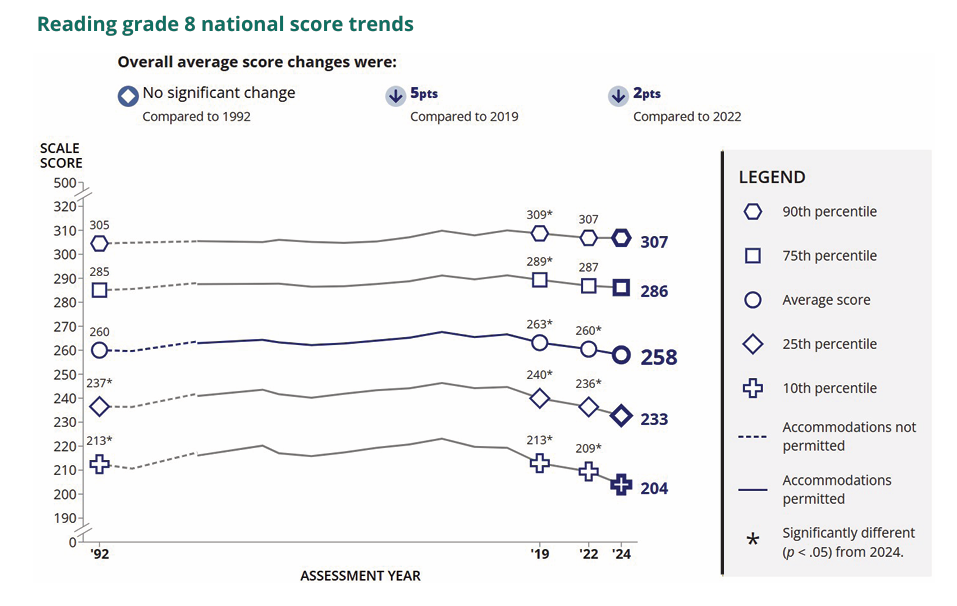


More About NAEP
To learn about upcoming NAEP assessments, download NAEP reports, and access sample questions, visit https://nces.ed.gov/nationsreportcard. Explore the latest NAEP results at https://nationsreportcard.gov.
Learn what NAEP means for schools that are selected to participate and get the latest NAEP news in Measure Up: NAEP News for the School Community, available online at https://nces.ed.gov/nationsreportcard/about/schools.aspx.
To hear teachers share their thoughts about why NAEP results are important, view the video Introducing NAEP to Teachers at https://nces.ed.gov/nationsreportcard/participating/schools.aspx.
To find your NAEP State Coordinator’s contact information, visit https://nces.ed.gov/nationsreportcard/states and select your state or jurisdiction from the drop-down menu.
For additional assistance, call the NAEP help desk at 800-283-6237.
“The NAEP team that arrived at our school made the assessment process painless. Everyone on the team previously worked as an educator and interacted well with all of our students.”
—Kimberly Wilborn, Guidance Counselor, Sandburg Middle School, Fairfax County Public Schools, Alexandria, Virginia
The National Center for Education Statistics (NCES) conducts the National Assessment of Educational Progress to evaluate federally supported education programs. All of the information you provide may only be used for the purposes of research, statistics, and evaluation under the Education Sciences Reform Act of 2002 (ESRA; 20 U.S.C. § 9543) and may not be disclosed, or used, in identifiable form for any other purpose except as required by law. Every NCES employee as well as every NCES agent, such as contractors and NAEP coordinators, has taken an oath and is subject to a jail term of up to 5 years, a fine of $250,000, or both if he or she willfully discloses ANY identifiable information about you in any unauthorized manner. Electronic submission of your information will be monitored for viruses, malware, and other threats by Federal employees and contractors in accordance with the Cybersecurity Enhancement Act of 2015..
This publication was prepared for the National Assessment of Educational Progress by Manhattan Strategy Group under contract 91990018C0001 to the National Center for Education Statistics, U.S. Department of Education.
Appendix D-34: NAEP 2026 Facts for Teachers, Private Schools (NEW)
NAEP 2026 Facts for Teachers in Private Schools
Page 1

The National Assessment of Educational Progress (NAEP) is the largest continuing and nationally representative assessment of what students in public and private schools know and can do in various subjects. First administered in 1969, NAEP collects and reports information on student trends and performance and compares the achievement of students in public schools with the achievement of students in private schools. Private schools represent about 23 percent of the schools in the nation, educate approximately 9 percent of the nation’s students, and are a critical component of the NAEP program. Private school data are essential to providing a complete and accurate picture of education in the United States and informing future policy decisions. The results of NAEP are released to the public as The Nation’s Report Card.
All About NAEP
As private school teachers, you are essential partners in NAEP. You make an important contribution by sharing your class time and encouraging your students to participate and do their best. When students take part in NAEP and give their best effort, we get the most accurate measure possible of student achievement across the country.
Teachers can use NAEP questions as a resource in the classroom. Teachers can use the NAEP Questions Tool at http://nces.ed.gov/nationsreportcard/nqt to create online self-scoring tests for students and see how the performance of students in private schools compares nationally with that of students in public schools on specific items. Released items generally come with a scoring guide, sample student responses, and performance data. Students can try NAEP questions by visiting https://www.nationsreportcard.gov/sample_questions.aspx.
Teachers can watch the NAEP teacher video. The video provides an overview of the assessment as well as tips on how to support students selected to participate. Watch the video at https://www.youtube.com/watch?v=zR1_pUdSlFg.
Teachers can also view the private school video. Teachers and heads of school describe their experiences with the NAEP assessment and the value of NAEP to private schools in an online video, Private Schools and NAEP: A National Conversation. Watch the video at https://www.youtube.com/watch?v=oLs7_L7pGgs.
Sidebar (Right)
I’m thankful for the opportunity for our school to participate in NAEP because I believe it leads to useful outcomes for individual schools, private schools specifically, and education generally in our country. I would strongly encourage all private schools to participate, if selected. — Dr. James A. Thomas President of Columbia Academy, Columbia, TN
Page 2

Highlights of the NAEP 2026 Program
From January 26 to March 20, 2026, NAEP field staff will administer assessments in public and private schools across the country. The assessments will be administered at grades 4 and 8 in mathematics and reading, and at grade 8 in civics and U.S. history. Students will take only one subject.
NAEP representatives will provide significant support to schools and will administer the assessment. Students will spend up to 120 minutes completing the assessment. This includes transition time, directions, and completion of a student questionnaire.
It’s important to know that...
No advance preparation is needed. No advance preparation for teachers or for students is necessary. Trained NAEP representatives, employed by a contractor to the National Center for Education Statistics, administer NAEP.
Inclusion is essential. To ensure that student achievement is accurately reported, students with disabilities (SD) and English learners (EL) are encouraged to participate in NAEP assessments. Many accommodations are allowed during the assessment, such as extended time, breaks during the test, and a separate setting. SD and EL teachers who work with the students selected for the assessment are asked to provide information to determine how these students will be assessed on NAEP.
NAEP data are used for statistical purposes only.† No one involved in administering NAEP keeps personal information on teachers or students after the assessments are completed. There are no results for individual students, classrooms, or schools.
Sidebar (Right)
How NAEP reports results
Since 1969, NAEP has produced many reports chronicling trends over time in student performance. Results for private schools are generally reported as overall private school results and for two groups of private schools, Catholic and other private schools.
NAEP also disseminates contextual information from data collected on student survey questionnaires. This information can be used to inform parents, the public, and education policymakers about our students’ educational experiences inside and outside the classroom. You can access data from previous assessments at https://www.nationsreportcard.gov/ndecore/xplore/nde and explore the most recent results at https://www.nationsreportcard.gov. For a quick, but detailed, look at results for private schools, explore the Public, Private, and Charter Schools Dashboard at https://www.nationsreportcard.gov/dashboards/schools_dashboard.aspx.
Highlights of NAEP 2024 Mathematics and Reading
The NAEP 2024 mathematics and reading results include both achievement and survey questionnaire data for students in grades 4 and 8 across the country. The national results combine data from students assessed in public and private schools. Some highlights of these results are included on the following pages.
Page 3
In 2024, the average fourth-grade mathematics score was higher compared to 2022, but was lower than in 2019. The score was higher in 2024 than in 1990. The average eighth-grade mathematics score was not different from 2022, but was lower than in 2019. The score was higher in 2024 than in 1990. Average scores are reported on NAEP mathematics scales at grades 4 and 8 that range from 0 to 500.
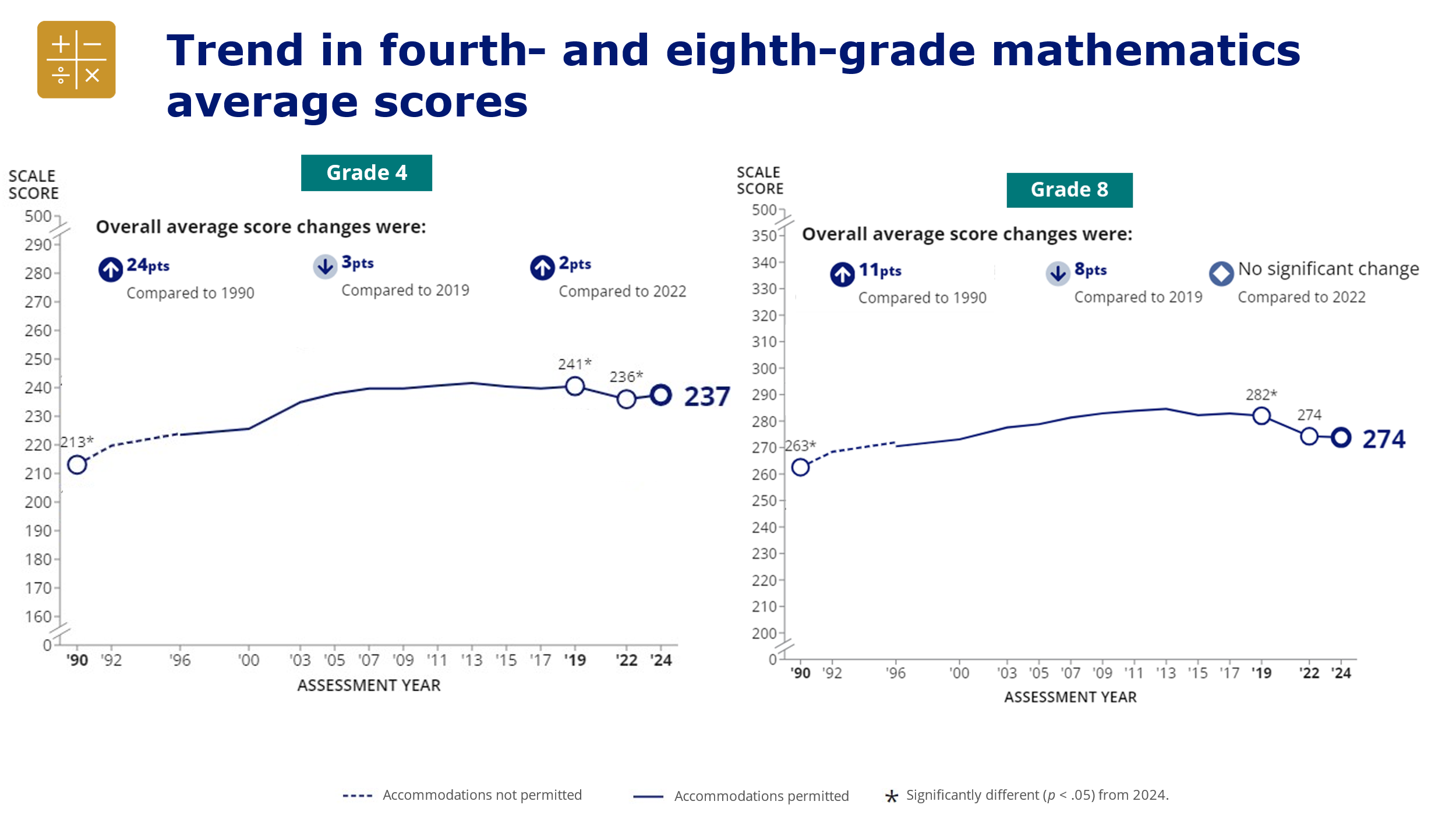
In 2024, the average fourth-grade reading score was lower compared to 2022 and 2019, but not different from 1992. The average eighth-grade mathematics score was lower compared to 2022 and 2019, but not different from 1992. Average scores are reported on NAEP reading scales at grades 4 and 8 that range from 0 to 500.
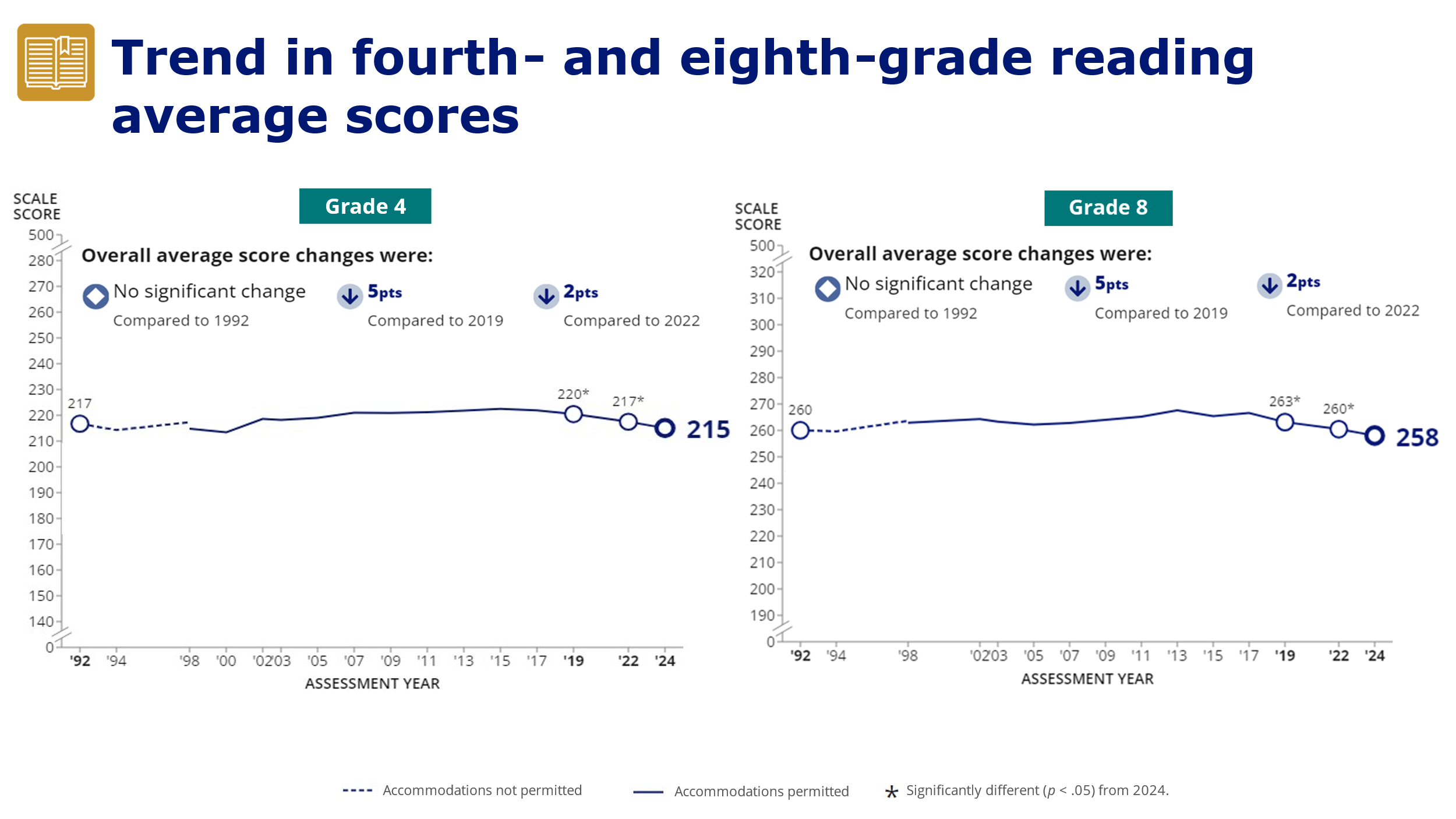
Page 4
When eighth-graders took the reading assessment January—March in 2019, 2022, and 2024, they were asked to indicate the number of days they had been absent from school in the previous month. The response options were none, 1 or 2 days, 3 or 4 days, 5 to 10 days, and more than 10 days.
For the top two response options, 5 to 10 days and more than 10 days, the percentage of eighth-graders who reported missing 5 or more days from school in the previous month (11 percent) was lower in 2024 than in 2022 (16 percent). However, in comparison to 2019, the percentages of eighth-grade students missing 5 to 10 days and more than 10 days were higher in 2024.

Accessing NAEP Data for Catholic and Private Schools
NAEP
Catholic and private school data are available online
at
https://www.nationsreportcard.gov
https://www.nationsreportcard.gov/ndecore
https://www.nationsreportcard.gov/dashboards/schools_dashboard.aspx.
NAEP and Catholic School Participation
More information about NAEP and private school participation, including a short video highlighting the value of participation, is available at https://nces.ed.gov/nationsreportcard/participating/private_nonpublic.aspx.
† The National Center for Education Statistics (NCES) conducts the National Assessment of Educational Progress to evaluate federally supported education programs. All of the information you provide may only be used for the purposes of research, statistics, and evaluation under the Education Sciences Reform Act of 2002 (ESRA; 20 U.S.C. § 9543) and may not be disclosed, or used, in identifiable form for any other purpose except as required by law. Every NCES employee as well as every NCES agent, such as contractors and NAEP coordinators, has taken an oath and is subject to a jail term of up to 5 years, a fine of $250,000, or both if he or she willfully discloses ANY identifiable information about you in any unauthorized manner. Electronic submission of your information will be monitored for viruses, malware, and other threats by Federal employees and contractors in accordance with the Cybersecurity Enhancement Act of 2015.
<Facebook, Instagram, LinkedIn, X, and YouTube Logos>
Appendix D-35: NAEP 2026 Facts for Teachers, Puerto Rico (NEW)
2026 Información para maestros
¿Qué es NAEP?
La Evaluación Nacional del Progreso Educativo (NAEP, por sus siglas en inglés) es una medida integral del progreso educativo en todo el país y a lo largo del tiempo. Es la evaluación continua y nacionalmente representativa más grande que mide lo que los estudiantes de nuestro país saben y pueden hacer en diferentes materias, tales como educación cívica, matemáticas, lectura, ciencias, e historia de Estados Unidos. El programa también proporciona información valiosa sobre las experiencias educativas de los estudiantes y las oportunidades de aprendizaje dentro y fuera del salón de clases. Los funcionarios electos, los legisladores y los educadores usan los resultados de NAEP para desarrollar maneras de mejorar la educación.
NAEP es un programa autorizado por el Congreso y administrado por el Centro Nacional para Estadísticas de la Educación (NCES, por sus siglas en inglés), parte del Departamento de Educación de Estados Unidos y el Instituto de Ciencias de la Educación.
¿Qué evaluaciones de NAEP se administrarán en Puerto Rico en 2026?
El programa de NAEP de 2026 incluye:
evaluaciones de matemáticas para los grados 4.° y 8.°;
prueba piloto de matemáticas para los grados 4.° y 8.°; y
cuestionarios de contexto para estudiantes, maestros y directores participantes, a fin de proporcionar una mejor comprensión de los factores que pueden estar relacionados con el aprendizaje de los estudiantes.
Las evaluaciones se administrarán entre el 26 de enero y el 20 de marzo de 2026.
Los resultados nacionales, estatales y de determinados distritos urbanos se publicarán para las evaluaciones de matemáticas y lectura de 4.° y 8.° grado. Los resultados de la prueba piloto no se darán a conocer, pero se utilizarán para orientar las futuras evaluaciones de NAEP.
“Como maestra, mi objetivo constante es ayudar a los estudiantes a progresar en el salón de clase. NAEP ayuda con esta misión al crear una medida común del rendimiento de los estudiantes en todo el país." - Iris García, maestra, Biscayne Elementary Community School, Miami Beach, Florida
¿Qué pueden esperar los maestros y los estudiantes?
Los estudiantes participantes completarán:
preguntas de matemáticas; y
cuestionarios de contexto que proporcionan información valiosa sobre sus experiencias educativas y oportunidades de aprendizaje dentro y fuera del salón de clase.
A los estudiantes se les dan aproximadamente 2 horas para completar la evaluación a menos que se les proporcionen acomodos. Esto incluye el tiempo de transición, las instrucciones y el tiempo que toma contestar un cuestionario de contexto. Se ofrece una amplia gama de acomodos para los estudiantes con impedimentos y para aprendices del español.
No es necesario que los maestros preparen a los estudiantes para la prueba de campo, pero sí deben motivarlos a que hagan su mejor esfuerzo.
¿Quién administrará NAEP? ¿Qué deben proporcionar las escuelas el día de la evaluación?
El personal de NAEP administrará la evaluación y proporcionará un importante apoyo a las escuelas el día de la evaluación. Las escuelas deberán proporcionar espacio para que los estudiantes tomen la evaluación, pupitres o mesas y un número adecuado de enchufes en el lugar donde se realice la evaluación.
En las escuelas en las que la evaluación se realice con dispositivos de la escuela, es posible que se requiera la presencia de personal de la escuela o del distrito que tenga experiencia con los dispositivos y la tecnología utilizados por la escuela durante la(s) sesión(es) de prueba.
En las escuelas en las que la evaluación se realice con dispositivos de NAEP, los representantes de NAEP llevarán todos los materiales y equipos necesarios para evaluar a los estudiantes.
¿Cómo se seleccionan las escuelas y los estudiantes para NAEP?
Las escuelas fueron seleccionadas como parte de un proceso de muestreo cuidadosamente diseñado que garantiza que las escuelas y los estudiantes seleccionados para NAEP representan a todas las escuelas y estudiantes en Puerto Rico y en Estados Unidos.
¿En qué se diferencia NAEP de nuestra evaluación estatal?
NAEP cumple una función diferente a la de las evaluaciones estatales. Si bien cada estado tiene su propia y única evaluación, con diferentes estándares de contenido, la misma evaluación NAEP se administra en todos los estados, proporcionando una medida común de los logros de los estudiantes.
NAEP y los maestros
¿De qué manera los maestros son aliados fundamentales para NAEP?
Las escuelas y los estudiantes seleccionados para participar en NAEP representan a las escuelas y a los estudiantes de todo el país. Los maestros contribuyen de manera importante al motivar a sus estudiantes a que participen y que hagan su mejor esfuerzo; esto contribuye a garantizar que los resultados de NAEP proporcionen la medida más exacta posible del rendimiento de los estudiantes de todo el país. Para más información acerca de NAEP y para ver las Preguntas Frecuentes para maestros (en inglés), visite la página https://nces.ed.gov/nationsreportcard/educators/.
¿Por qué se les pide a los estudiantes, maestros, y directores que completen los cuestionarios de contexto?
Además de las preguntas sobre la materia, a los estudiantes que participan en NAEP se les pide que completen un cuestionario de contexto. Los resultados del cuestionario ayudan a contextualizar los resultados del rendimiento de los estudiantes, permiten una comparación significativa entre grupos de estudiantes y ofrecen información importante para que los educadores, legisladores e investigadores comprendan mejor las experiencias educativas de los estudiantes en Estados Unidos y Puerto Rico.
También se les pide a los maestros de los estudiantes que participan en NAEP que completen un cuestionario de contexto. El cuestionario de la encuesta para maestros de NAEP recopila información sobre la capacitación de los maestros y sus prácticas de enseñanza. El cuestionario se distribuirá en formato electrónico, pero los maestros pueden solicitar una versión impresa.
A los directores o administradores de las escuelas de los estudiantes que participan en NAEP se les pide que completen un cuestionario de contexto que proporciona información sobre las políticas y características de la escuela. El cuestionario también se distribuirá en formato electrónico, pero se puede solicitar una versión impresa.
Para más información sobre los cuestionarios de contexto de NAEP y para ver los cuestionarios de estudiantes, maestros y escuelas de años anteriores (en inglés), visite la página
https://nces.ed.gov/nationsreportcard/survey_questionnaires.aspx.
¿Cómo pueden los maestros usar los recursos y los datos de NAEP para ayudar a los estudiantes?
Puede usar la herramienta NAEP Questions Tool (https://nces.ed.gov/nationsreportcard/nqt) para ver las preguntas de NAEP publicadas y para crear evaluaciones personalizadas para su salón de clases. Puede comparar el rendimiento de sus estudiantes con el de otros estudiantes en su estado y en todo el país. Los maestros, estudiantes y padres de familia pueden acceder a la información y comparar los resultados de varios grupos demográficos. La mayoría de las preguntas publicadas incluyen una guía de puntuación, ejemplos de respuestas de los estudiantes e información sobre el rendimiento (en inglés).
El explorador de datos, NAEP Data Explorer, (https://www.nationsreportcard.gov/ndecore) es una poderosa herramienta que permite examinar las relaciones entre el rendimiento de los estudiantes y factores tales como las prácticas de enseñanza y los recursos escolares, entre otros (en inglés).
¿Desde cuándo existe NAEP?
NAEP se administró por primera vez en 1969 para medir el rendimiento de los estudiantes a nivel nacional. En 1990, NAEP se administró por primera vez a nivel estatal. El programa TUDA de NAEP, que mide el rendimiento de los estudiantes en algunos de los grandes distritos urbanos del país, comenzó en 2002. NAEP es reconocida como el estándar de oro de las evaluaciones a gran escala debido a su alta calidad técnica y a su riguroso diseño y metodología.
Los resultados de NAEP
Los resultados de NAEP se publican en un informe llamado la Libreta de Calificaciones de la Nación. Dependiendo de la evaluación, los resultados de NAEP están disponibles para la nación, los estados y determinados distritos urbanos que participan en TUDA. También hay resultados disponibles para diferentes grupos de estudiantes con base en factores como la raza/grupo étnico, el género y la ubicación de la escuela, entre otros. NAEP no está diseñada para recopilar o informar los resultados individuales de estudiantes, salones de clase o escuelas. En una escuela, solamente algunos de los estudiantes participan y sus respuestas se combinan con las de otros estudiantes participantes para producir los resultados.
Puede acceder a datos de evaluaciones anteriores (en inglés) en la página
https://nces.ed.gov/nationsreportcard/naepdata y explorar los resultados más recientes https://www.nationsreportcard.gov/.
En Puerto Rico, los estudiantes de 4.° y 8.° grado están programados para ser evaluados en matemáticas cada dos años. Conforme a la Ley de Educación Primaria y Secundaria, los distritos y estados que reciben financiación del Título I deben participar en estas evaluaciones cada dos años.
Resultados recientes de NAEP
Los resultados de las evaluaciones de NAEP se dan a conocer a medida que están disponibles, tras una puntuación y un análisis exhaustivos. Los resultados principales de NAEP de 2024 se publicaron en enero de 2025 y están disponibles en https://nces.ed.gov/nationsreportcard/.
Más información sobre NAEP
Para más información sobre las próximas evaluaciones de NAEP, descargar informes y acceder a ejemplos de preguntas, visite https://nces.ed.gov/nationsreportcard/puertorico/. Explore los resultados de NAEP en https://nationsreportcard.gov.
Conozca lo que NAEP significa para las escuelas que son seleccionadas para participar y entérese de las últimas novedades de NAEP en Medición: Novedades de NAEP para la Comunidad Escolar, disponible en línea en https://nces.ed.gov/nationsreportcard/about/schools.aspx.
Para escuchar lo que piensan los maestros sobre por qué son importantes los resultados de NAEP, vea el video Introducing NAEP to Teachers (en inglés) visitando la página https://nces.ed.gov/nationsreportcard/participating/schools.aspx.
Para encontrar información de contacto del Coordinador Estatal de NAEP (en inglés), visite https://nces.ed.gov/nationsreportcard/states y seleccione su estado o jurisdicción en el menú desplegable.
Si necesita ayuda adicional, llame al Centro de Ayuda de NAEP (Help Desk) al 800-283-6237.
“El equipo de NAEP que vino a nuestra escuela hizo que el proceso de evaluación fuera fácil. Todos los miembros del equipo habían sido educadores e interactuaron bien con todos nuestros estudiantes”.
—Kimberly Wilborn, Orientadora, Sandburg Middle School, Fairfax County Public Schools, Alexandria, Virginia
El Centro Nacional para Estadísticas de la Educación (NCES, por sus siglas en inglés) administra la Evaluación Nacional del Progreso Educativo para evaluar programas de educación apoyados por el Gobierno federal. Toda la información que proporcione podrá usarse únicamente con fines de investigación, estadísticas y evaluación en virtud de la Ley de Reforma de las Ciencias Educativas de 2002 (ERSA; 20 U.S.C §9573) y no podrá darse a conocer para identificarlo ni para cualquier otro propósito salvo aquel requerido legalmente. Todos los empleados de NCES al igual que todos los representantes del mismo, como contratistas y coordinadores de NAEP, han hecho un juramento y están sujetos a una pena de prisión de hasta 5 años, una multa de hasta $250,000 o ambas cosas, si dan a conocer intencionalmente CUALQUIER información que lo identifique de manera no autorizada. El envío de su información por vía electrónica será monitoreado por empleados y contratistas federales para detectar virus, programas maliciosos (malware) y otras amenazas conforme a la Ley de Mejoramiento de la Seguridad Cibernética de 2015.
Esta publicación fue preparada para la Evaluación Nacional del Progreso Educativo por Manhattan Strategy Group bajo el contrato 91990018C0001 para el Centro Nacional de Estadísticas de la Educación, Departamento de Educación de Estados Unidos.
Appendix D-36: NAEP 2026 Preassessment Responsibilities Guide, School Device Model (NEW)
2026 Preassessment Responsibilities Guide (School Device)
Thank you for supporting the National Assessment of Educational Progress (NAEP). We look forward to working with you to make NAEP a positive experience at your school. The Assessment Management System (AMS) will be your primary resource for completing assessment planning tasks online for the upcoming assessment.
This guide outlines tasks you will complete along with available resources to make assessment day successful.
NAEP Activity Timeline
December–January:
Complete Preassessment Activities
January–February:
Add New Students
Attend Assessment Planning Meeting (APM) with NAEP representative
One week before the assessment:
Notify Parents and Guardians
Support Assessment Activities
January 26–March 20:
NAEP 2026 Assessment Window
After the assessment:
Wrap Up
You will need to complete the following activities:
Complete Preassessment Activities
When the student sample is released in December, the following preassessment activities should be completed in the AMS.
Schedule Assessment Planning Meeting (APM)
An assigned NAEP representative, responsible for administering the assessment, will contact you in December for initial introductions and coordinate the scheduling of a virtual APM. School coordinators will select a date and time (1-hour block) to schedule their APM in the AMS. The NAEP representative can review how to complete the planning tasks outlined below upon request.
Provide Student Information
Review the student sample and identify any students who cannot take the assessment.
Review demographic information and update any information that is missing or inaccurate.
Provide information about students with disabilities (SD) and English learners (EL) so NAEP assessment administrators can plan appropriate testing accommodations.
You can invite your school’s SD and EL specialists to register for the AMS to assist with this task.
Please note that school staff may need to assist with certain accommodations (e.g., cueing to stay on task, scribe). You will need to provide the contact information for the school staff that will assist with these accommodations.
Assessment Logistics
Record school start and end time
Select the desired assessment grouping option
Students can either be assessed in two sequential sessions of up to 25 students each or all students at one time in one or two locations.
If you select the option to assess all students at the same time in one or two locations, school staff presence is required at each location. If you select the option to assess students at different times, school staff presence in the assessment location is encouraged to help support classroom management.
Schedule the assessment groups and reserve space at your school.
Review the assigned assessment group for each sampled student and update students’ group assignments as needed.
Provide assessment day details, including
procedures for arriving and checking in on assessment day;
classroom protocols;
who to contact in case of emergency; and
how you would like students to be dismissed after the assessment.
Technical Logistics
Confirm the bandwidth, safelisting, and wireless access points.
Run a network check to confirm required URLs are safelisted.
Check the Wi-Fi at the school to confirm the network meets the technical requirements for assessment day.
Confirm that wireless access points can support the required number of device connections
Verify device readiness
A district or school staff member was identified to manage the installation of the NAEP Assessment application on identified devices for your school. It is important that all student and spare devices have the application installed and meet device requirements.
To ensure the devices are ready, a device check is required for 50% of the school devices that will be used on assessment day.
Complete the Device Readiness Check by launching the NAEP Assessment application on the device and entering the school device verification code. The verification code and instructions for completing this check are available in the Technical Logistics section of the AMS.
School staff or students may assist with completing the Device Readiness Check.
Record how the school devices and assessment location will be set up for the NAEP assessment.
Provide details about the available spare devices, charging, and the earbuds/headphones students will use during the assessment.
Identify a school staff member to provide technical support on assessment day.
Manage Questionnaires
Identify respondents and provide contact information for the school and teacher questionnaires.
Match students to the subject-specific teacher in the AMS.
Monitor the completion of the questionnaires by school staff.
Add New Students
To ensure all students have a chance to be selected for NAEP, you will be asked to update the student list in January (before the Assessment Planning Meeting) by adding any new students who have enrolled since the fall. A random sample will be drawn from this group of newly added students to be included in the assessment.
You can invite an additional staff member to register for the AMS as your school’s student information specialist to assist.
You will need to provide student information, manage questionnaires, and notify the parents and guardians of any newly added students after completing the Add New Students process.
Attend Assessment Planning Meeting (APM)
Participate in a 1-hour virtual planning meeting with your NAEP representative to review and confirm the information entered in the AMS.
An additional meeting can be scheduled with a technology coordinator to review and confirm technical logistics, if needed.
Notify Parents and Guardians
By law, parents and guardians of students selected to participate in NAEP must be notified in writing of their child’s selection prior to the administration of the assessment.
In the Notify Parents/Guardians section in the AMS, an electronic copy of the Parent/Guardian Notification Letter is available to download and distribute.
Certify in the AMS that these notifications have been sent.
Support Assessment Activities
Resources can be created and printed from the Support Assessment Activities section in the AMS to remind teachers and students about the assessment.
Share the Teacher Notification Letter and List of Participating Students.
Distribute the Student Appointment Cards.
List of Students for Device Application Installation.
Remind students to charge their devices and bring their headphones or earbuds on assessment day.
Assessment Day Responsibilities
A school or district staff member will need to be available on assessment day at the beginning of the assessment session in case any technical issues arise while launching the NAEP assessment on the school’s devices.
A staff member’s presence throughout the assessment can have a positive impact on students’ motivation and performance. If assessing all students at the same time in one or two locations, the presence of a school staff member is required at each assessment location to help support classroom management.
If the attendance of sampled students is less than 80 percent, a makeup session will be necessary, and the NAEP representative will schedule another date to administer the assessment to the absent students.
If the assessment cannot take place due to technical issues, the NAEP representative will work with your school to reschedule the assessment.
After the Assessment
Destroy any hardcopy documents containing student names according to school protocol.
Complete a short email survey on your experience with NAEP.
(Optional) Instructions for uninstalling the NAEP Assessment application can be found at the eNAEP Download Center.
Please follow your school or district procedures for uninstalling applications on school devices.
If your AMS password has expired, you can request to reset your password by selecting Reset Password. If you have any questions, please contact the NAEP help desk at 1-800-283-6237 or naephelp@westat.com.
Online Resources for Selected Schools
Information for Selected Schools |
http://nces.ed.gov/nationsreportcard/participating/schools.aspx |
Sample Questions Booklets |
|
NAEP Questions Tool |
|
Information for Parents and Guardians |
|
Assessment Frameworks |
https://www.nagb.gov/naep-frameworks/frameworks-overview.html |
Digitally Based Assessments |
|
eNAEP Download Center |
https://enaep.naep.ed.gov/download-center/resources/index.html |
For more information about NAEP, visit https://nces.ed.gov/nationsreportcard/.
Find us on: [Facebook, Instagram, Linked, X, and YouTube logos]
The National Center for Education Statistics (NCES) conducts the National Assessment of Educational Progress to evaluate federally supported education programs. All of the information you provide may only be used for the purposes of research, statistics, and evaluation under the Education Sciences Reform Act of 2002 (ESRA; 20 U.S.C. § 9543) and may not be disclosed, or used, in identifiable form for any other purpose except as required by law. Every NCES employee as well as every NCES agent, such as contractors and NAEP coordinators, has taken an oath and is subject to a jail term of up to 5 years, a fine of $250,000, or both if he or she willfully discloses ANY identifiable information about you in any unauthorized manner. Electronic submission of your information will be monitored for viruses, malware, and other threats by Federal employees and contractors in accordance with the Cybersecurity Enhancement Act of 2015.
Appendix D-37: NAEP 2026 Preassessment Responsibilities Guide-Private Schools, School Device Model (NEW)
2026 Field Test Preassessment Responsibilities Guide (School Device)
Thank you for supporting the National Assessment of Educational Progress (NAEP). We look forward to working with you to make NAEP a positive experience at your school. The Assessment Management System (AMS) will be your primary resource for completing assessment planning tasks online for the upcoming assessment.
This guide outlines tasks you will complete along with available resources to make assessment day successful.
NAEP Activity Timeline
December–January:
Complete Preassessment Activities
January–February:
Attend Assessment Planning Meeting (APM) with NAEP representative
One week before the assessment:
Notify Parents and Guardians
Support Assessment Activities
January 26–March 20:
NAEP 2026 Assessment Window
After the assessment:
Wrap Up
You will need to complete the following activities:
Complete Preassessment Activities
When the student sample is released in December, the following preassessment activities should be completed in the AMS.
Schedule Assessment Planning Meeting
An assigned NAEP representative, responsible for administering the assessment, will contact you in December for initial introductions and coordinate the scheduling of a virtual APM. School coordinators will select a date and time (1-hour block) to schedule their APM in the AMS. The NAEP representative can review how to complete the planning tasks outlined below upon request.
Provide Student Information
Review the student sample and identify any students who cannot take the assessment.
Review demographic information and update any information that is missing or inaccurate.
Provide information about students with disabilities (SD) and English learners (EL) so NAEP assessment administrators can plan appropriate testing accommodations.
You can invite your school’s SD and EL specialists to register for the AMS to assist with this task.
Please note that school staff may need to assist with certain accommodations (e.g., cueing to stay on task, scribe). You will need to provide the contact information for the school staff that will assist with these accommodations.
Assessment Logistics
Record school start and end times.
Select the desired assessment grouping option:
Students can either be assessed in two sequential sessions of up to 25 students each or all at one time in one or two locations.
If you select the option to assess all students at the same time in one or two locations, school staff presence is required at each location. If you select the option to assess students at different times, school staff presence in the assessment location is encouraged to help support classroom management.
Schedule the assessment groups and reserve space at your school.
Review the assigned assessment group for each sampled student and update students’ group assignments as needed.
Provide assessment day details, including
Technical Logistics
Confirm the bandwidth, safelisting, and wireless access points:
Verify device readiness:
A district or school staff member was identified to manage the installation of the NAEP Assessment application on identified devices for your school. It is important that all student and spare devices have the application installed and meet device requirements.
To ensure the devices are ready, a device check is required for 50% of the school devices that will be used on assessment day.
Complete the Device Readiness Check by launching the NAEP Assessment application on the device and entering the school device verification code. The verification code and instructions for completing this check are available in the Technical Logistics section of the AMS.
School staff or students may assist with completing the Device Readiness Check.
Record how the school devices and assessment location will be set up for the NAEP assessment.
Provide details about the available spare devices, charging, and the earbuds/headphones students will use during the assessment.
Identify a school staff member to provide technical support on assessment day.
Manage Questionnaires
Identify respondents and provide contact information for the school and teacher questionnaires.
Match students to the subject-specific teacher in the AMS.
Monitor the completion of the questionnaires by school staff.
Attend Assessment Planning Meeting (APM)
Participate in a 1-hour virtual planning meeting with your NAEP representative to review and confirm the information entered in the AMS.
An additional meeting can be scheduled with a technology coordinator to review and confirm technical logistics, if needed.
Notify Parents and Guardians
By law, parents and guardians of students selected to participate in NAEP must be notified in writing of their child’s selection prior to the administration of the assessment.
In the Notify Parents/Guardians section in the AMS, an electronic copy of the Parent/Guardian Notification Letter is available to download and distribute.
Verify these notifications have been sent in the AMS.
Support Assessment Day Activities
Resources can be created and printed from the Support Assessment Day section in the AMS to remind teachers and students about the assessment.
Share the Teacher Notification Letter and List of Participating Students.
Distribute the Student Appointment Cards.
Share List of Students for Device Application Installation.
Remind students to charge their devices and bring their headphones or earbuds on assessment day.
Assessment Day Responsibilities
A school or district staff member will need to be available on assessment day at the beginning of the assessment session in case any technical issues arise while launching the NAEP assessment on the school’s devices.
A staff member’s presence throughout the assessment can have a positive impact on students’ motivation and performance. If assessing all students at the same time in one or two locations, the presence of a school staff member is required at each assessment location to help support classroom management.
If less than 80 percent of the sampled students are assessed, a makeup session will be necessary, and the NAEP representative will work with you to schedule another date to administer the assessment to the absent students.
If the assessment cannot take place due to technical issues, the NAEP representative will work with your school to reschedule the assessment.
After the Assessment
Destroy any hardcopy documents containing student names according to school protocol.
Complete a short email survey on your experience with NAEP.
(Optional) Instructions for uninstalling the NAEP Assessment application can be found at the eNAEP Download Center.
Please follow your school or district procedures for uninstalling applications on school devices.
If your AMS password has expired, you can request to reset your password by selecting Reset Password. If you have any questions, please contact the NAEP help desk at 1-800-283-6237 or naephelp@westat.com.
Online Resources Information for selected schools
Information for Selected Schools |
https://nces.ed.gov/nationsreportcard/participating/private_nonpublic.aspx |
Sample Questions Booklets |
|
NAEP Questions Tool |
|
Information for Parents and Guardians |
|
Assessment Frameworks |
https://www.nagb.gov/naep-frameworks/frameworks-overview.html |
Digitally Based Assessments |
For more information about NAEP, visit https://nces.ed.gov/nationsreportcard/.
Find us on: [Facebook, Instagram, LinkedIn, X, and YouTube logos]
The National Center for Education Statistics (NCES) conducts the National Assessment of Educational Progress to evaluate federally supported education programs. All of the information you provide may only be used for the purposes of research, statistics, and evaluation under the Education Sciences Reform Act of 2002 (ESRA; 20 U.S.C. § 9543) and may not be disclosed, or used, in identifiable form for any other purpose except as required by law. Every NCES employee as well as every NCES agent, such as contractors and NAEP coordinators, has taken an oath and is subject to a jail term of up to 5 years, a fine of $250,000, or both if he or she willfully discloses ANY identifiable information about you in any unauthorized manner. Electronic submission of your information will be monitored for viruses, malware, and other threats by Federal employees and contractors in accordance with the Cybersecurity Enhancement Act of 2015.
Appendix D-38: NAEP 2026 Preassessment Responsibilities Guide, School Device Model, Puerto Rico (NEW)
Guía de responsabilidades de preevaluación de 2026 (Dispositivo escolar)
Gracias por apoyar la Evaluación Nacional del Progreso Educativo (NAEP, por sus siglas en inglés). Esperamos trabajar con usted para hacer de NAEP una experiencia positiva en su escuela. El Sistema de Administración de la Evaluación (AMS, por sus siglas en inglés) será su principal recurso para completar las tareas de planificación en línea para la próxima evaluación.
En esta guía se describen las tareas que deberá realizar y los recursos disponibles para que el día de la evaluación sea un éxito.
Calendario de actividades de NAEP
Diciembre–enero:
Complete las actividades de preevaluación
Enero–febrero:
Añada estudiantes nuevos
Asista a la reunión de planificación para la evaluación (APM, por sus siglas en inglés) con el(la) representante de NAEP.
Una semana antes de la evaluación:
Notifique a los padres o tutores
Apoye las actividades de evaluación
Del 26 de enero al 20 de marzo:
Periodo de evaluación de NAEP 2026
Después de la evaluación:
Finalización
Deberá completar las siguientes actividades:
Completar las actividades de preevaluación
Cuando se publique la muestra de estudiantes en diciembre, deberán completarse las siguientes actividades de preevaluación en el AMS.
Programe la reunión de planificación para la evaluación (APM)
Un(a) representante asignado(a) de NAEP, responsable de administrar la evaluación, se comunicará con usted en diciembre para realizar las presentaciones iniciales y coordinar la programación de una APM virtual. Los coordinadores escolares seleccionarán una fecha y hora (bloque de 1 hora) para programar su APM en el AMS. Si se solicita, el(la) representante de NAEP puede repasar cómo completar las tareas de planificación que se describen a continuación.
Proporcione información sobre los estudiantes
Revise la muestra de estudiantes e identificar a los que no pueden tomar la evaluación.
Revise la información demográfica y actualice cualquier dato que falte o que no sea correcto.
Proporcione información sobre los estudiantes con impedimentos (EI) y estudiantes aprendices del español (AE) para que los administradores de la evaluación de NAEP puedan planificar los acomodos adecuados para las pruebas.
Puede invitar a los especialistas en EI y AE de su escuela a registrarse en el AMS para que le ayuden con esta tarea.
Tenga en cuenta que es posible que el personal de la escuela tenga que ayudar con determinados acomodos (por ejemplo, señas para que se mantengan enfocados, escribiente). Deberá proporcionar la información de contacto del personal de la escuela que le ayudará con estos acomodos.
Logística de evaluación
Registre la hora de inicio y de salida de la escuela
Programe los grupos de evaluación y reserve espacio en su escuela.
Revise el grupo de evaluación asignado a cada estudiante de la muestra y actualice las asignaciones de grupo de los estudiantes según sea necesario.
Proporcione detalles sobre el día de la evaluación, incluyendo
procedimientos para llegar y registrarse el día de la evaluación;
protocolos del salón de clase;
a quién contactar en caso de emergencia; y
cómo desea que se dejen salir a los estudiantes después de la evaluación.
Logística técnica
Confirme el ancho de banda, la lista segura y los puntos de acceso inalámbricos.
Ejecute una verificación de red para confirmar que los URL requeridos están en la lista segura.
Verifique el WiFi de la escuela para confirmar que la red cumple los requisitos técnicos para el día de la evaluación.
Confirme que los puntos de acceso inalámbricos son compatibles con el número necesario de conexiones de dispositivos.
Verifique la disponibilidad del dispositivo
Identifique a un miembro del personal del estado, distrito o escuela para administrar la instalación de la aplicación de evaluación de NAEP en los dispositivos identificados para su escuela. Es importante que todos los dispositivos de los estudiantes y de repuesto tengan la aplicación instalada y cumplan con los requisitos del dispositivo.
Para garantizar que los dispositivos están listos, se requiere una verificación en el 50% de los dispositivos de la escuela que se utilizarán el día de la evaluación.
Complete la verificación de preparación del dispositivo iniciando la aplicación de evaluación de NAEP en el dispositivo e ingresando el código de verificación del dispositivo de la escuela. El código de verificación y las instrucciones para completar esta verificación están disponibles en la sección Logística técnica del AMS.
El personal de la escuela o los estudiantes pueden ayudar a completar la verificación de disponibilidad de dispositivos.
Registre cómo se configurarán los dispositivos de la escuela y el lugar de evaluación para la evaluación de NAEP.
Proporcione detalles sobre los dispositivos de repuesto disponibles, la carga y los audífonos que los estudiantes utilizarán durante la evaluación.
Designe a un miembro del personal de la escuela para que proporcione asistencia técnica el día de la evaluación.
Administre cuestionarios
Identifique a los encuestados y proporcione información de contacto para los cuestionarios para la escuela y para maestros.
Asigne a los estudiantes con el(la) maestro(a) de la asignatura específica en el AMS.
Supervise que el personal de la escuela complete los cuestionarios.
Añadir estudiantes nuevos
Para garantizar que todos los estudiantes tengan la oportunidad de ser seleccionados para NAEP, se le pedirá que actualice la lista de estudiantes en enero (antes de la reunión de planificación para la evaluación) añadiendo cualquier estudiante nuevo que se haya matriculado desde el otoño. Se obtendrá una muestra aleatoria de este grupo de estudiantes recién añadidos para que participen en la evaluación.
Puede invitar a otro miembro del personal a registrarse en el AMS como especialista en información de los estudiantes de su escuela para que le ayude.
Tendrá que proporcionar información sobre los estudiantes, administrar los cuestionarios y notificar a los padres o tutores de los estudiantes recién añadidos después de completar el proceso de Añadir estudiantes nuevos.
Asistir a la reunión de planificación para la evaluación (APM)
Participe en una reunión virtual de planificación de una hora con su representante de NAEP para revisar y confirmar la información ingresada en el AMS.
De ser necesario, se puede programar una reunión adicional con un(a) coordinador(a) de tecnología para revisar y confirmar la logística técnica.
Notificar a los padres o tutores
Por ley, los padres o tutores de los estudiantes seleccionados para participar en NAEP deben ser notificados por escrito sobre la selección de su hijo(a) antes de la administración de la evaluación.
En la sección Notificar a los padres o tutores del AMS, se puede descargar y distribuir una copia electrónica de la Carta de notificación a los padres o tutores.
Certificar en el AMS que se han enviado estas notificaciones.
Ayudar con las actividades de evaluación
Se pueden crear e imprimir recursos desde la sección Ayudar con las actividades de la evaluación en el AMS para recordarles a los maestros y a los estudiantes sobre la evaluación.
Comparta la carta de notificación para maestros y la lista de estudiantes participantes.
Distribuya las tarjetas de recordatorio para los estudiantes.
Lista de estudiantes para la instalación de la aplicación en los dispositivos.
Recuérdeles a los estudiantes que carguen sus dispositivos y que traigan sus audífonos el día de la evaluación.
Responsabilidades del día de la evaluación
Un miembro del personal de la escuela o del distrito deberá estar disponible el día de la evaluación al comienzo de la sesión de evaluación en caso de que surja algún problema técnico al iniciar la evaluación de NAEP en los dispositivos de la escuela.
La presencia de un miembro del personal a lo largo de la evaluación puede tener un impacto positivo en la motivación y el desempeño de los estudiantes.
Si la asistencia de los estudiantes de la muestra es inferior al 80%, será necesaria una sesión de reposición y el(la) representante de NAEP programará otra fecha para administrar la evaluación a los estudiantes ausentes.
Si la evaluación no puede llevarse a cabo debido a problemas técnicos, el(la) representante de NAEP trabajará con su escuela para reprogramar la evaluación.
Después de la evaluación
Destruya cualquier documento impreso que contenga nombres de estudiantes de acuerdo con el protocolo de la escuela.
Complete una breve encuesta por correo electrónico sobre su experiencia con NAEP.
(Opcional) Las instrucciones para desinstalar la aplicación de evaluación de NAEP pueden encontrarse en el Centro de descargas de eNAEP.
Siga los procedimientos de su escuela o distrito para desinstalar aplicaciones en dispositivos escolares.
Si su contraseña de AMS ha caducado, puede solicitar restablecerla seleccionando Restablecer contraseña. Si tiene alguna pregunta, comuníquese con la oficina de ayuda de NAEP (help desk) llamando al 1-800-283-6237 o escribiendo a naephelp@westat.com.
Recursos en línea para escuelas seleccionadas
Información para las escuelas seleccionadas (en inglés) |
http://nces.ed.gov/nationsreportcard/participating/schools.aspx |
Ejemplos de folletos de preguntas (en inglés) |
|
Herramienta de preguntas NAEP (en inglés) |
|
Información para padres o tutores (en inglés) |
|
Marcos de evaluación (en inglés) |
https://www.nagb.gov/naep-frameworks/frameworks-overview.html |
Evaluaciones digitales (en inglés) |
|
Centro de descargas eNAEP |
https://enaep.naep.ed.gov/download-center/resources/index.html |
Para más información sobre NAEP, visite https://nces.ed.gov/nationsreportcard/puertorico/.
Encuéntrenos en: [logotipos de Facebook, Instagram, Linked, X y YouTube].
El Centro Nacional para Estadísticas de la Educación (NCES, por sus siglas en inglés) administra la Evaluación Nacional del Progreso Educativo para evaluar programas de educación apoyados por el Gobierno federal. Toda la información que proporcione podrá usarse únicamente con fines de investigación, estadísticas y evaluación en virtud de la Ley de Reforma de las Ciencias Educativas de 2002 (ERSA; 20 U.S.C §9573) y no podrá darse a conocer para identificarlo ni para cualquier otro propósito salvo aquel requerido legalmente. Todos los empleados de NCES al igual que todos los representantes del mismo, como contratistas y coordinadores de NAEP, han hecho un juramento y están sujetos a una pena de prisión de hasta 5 años, una multa de hasta $250,000 o ambas cosas, si dan a conocer intencionalmente CUALQUIER información que lo identifique de manera no autorizada. El envío de su información por vía electrónica será monitoreado por empleados y contratistas federales para detectar virus, programas maliciosos (malware) y otras amenazas conforme a la Ley de Mejoramiento de la Seguridad Cibernética de 2015.
Appendix D-39: NAEP 2026 Preassessment Responsibilities Guide, NAEP Device Model (NEW)
NAEP 2026 Preassessment Responsibilities Guide (NAEP Device)
Thank you for supporting the National Assessment of Educational Progress (NAEP). We look forward to working with you to make NAEP a positive experience at your school. The Assessment Management System (AMS) will be your primary resource for completing assessment planning tasks online for the upcoming assessment.
This guide outlines tasks you will complete along with available resources to make assessment day successful.
NAEP Activity Timeline
December–January:
Complete Preassessment Activities
January–February:
Add New Students
Attend Assessment Planning Meeting (APM) with NAEP representative
One week before the scheduled assessment:
Notify Parents and Guardians
Support Assessment Activities
January 26–March 20:
NAEP 2026 Assessment Window
After the assessment:
Wrap Up
You will need to complete the following activities:
Complete Preassessment Activities
When the student sample is released in December, the following preassessment activities should be completed in the AMS.
Schedule Assessment Planning Meeting (APM)
An assigned NAEP representative, responsible for administering the assessment, will contact you in December to make initial introductions and coordinate the scheduling of a virtual APM. School coordinators will select a date and time (1-hour block) to schedule their APM in the AMS. Upon request, the NAEP representative can review how to complete the planning tasks outlined below.
Provide Student Information
Review the student sample and identify any students who cannot take the assessment.
Review demographic information and update any information that is missing or inaccurate.
Provide information about students with disabilities (SD) and English learners (EL) so assessment administrators can plan appropriate testing accommodations.
You can invite your school’s SD and EL specialists to the AMS to assist with this task.
Please note that school staff may need to assist with certain accommodations (e.g., cueing to stay on task, scribe). You will need to provide the names and contact information for school staff who will assist with these accommodations on assessment day.
Assessment Logistics
Record school start and end times.
Schedule the assessment groups and reserve space at your school.
School staff presence in the assessment location is encouraged to help support classroom management.
Review the assigned assessment group for each sampled student and update students’ group assignments as needed.
Provide assessment day details, including
procedures for arriving and checking in on assessment day;
classroom protocols;
who to contact in case of emergency; and
how you would like students to be dismissed after the assessment.
Manage Questionnaires
Identify respondents and provide the names and contact information for the school and teacher questionnaires.
Match students to the subject-specific teacher in the AMS.
Monitor school staff completion of the questionnaires.
Add New Students
To ensure all students have a chance to be selected for NAEP, you will be asked to update the student list in January (before the Assessment Planning Meeting) by adding any new students who have enrolled since the fall. A random sample will be drawn from this group of newly added students to be included in the assessment.
You can invite an additional staff member to serve as your school’s student information specialist to assist with this task.
You will need to provide student information, manage questionnaires, and notify the parents and guardians of any newly added students after completing the Add New Students process.
Attend Assessment Planning Meeting (APM)
The school coordinator will participate in a 1-hour virtual planning meeting with their NAEP representative to review and confirm student information and assessment details entered in the AMS.
Notify Parents and Guardians
By law, parents and guardians of students selected to participate in NAEP must be notified in writing of their child’s selection prior to the administration of the assessment.
In the Notify Parents/Guardians section of the AMS, an electronic copy of the Parent/Guardian Notification Letter is available to download and distribute.
Support Assessment Activities
Resources can be downloaded and printed from the Support Assessment Activities section in the AMS to remind teachers and students about the assessment.
Share the Teacher Notification Letter and List of Participating Students.
Distribute the Student Appointment Cards.
Assessment Day Responsibilities
The school coordinator and the teachers of selected students are encouraged to remain in the room during the assessment to support classroom management. Having a school staff member present during the assessment is appreciated and can positively impact students’ motivation and performance.
If the attendance of sampled students is less than 80 percent, a makeup session will be necessary, and the NAEP representative will schedule another date to administer the assessment to the absent students.
After the Assessment
Destroy any hardcopy documents containing student names according to school protocol.
Complete a short email survey on your experience with NAEP.
If your AMS password has expired, you can request to reset your password by selecting Reset Password. If you have any questions, please contact the NAEP help desk at 1-800-283-6237 or naephelp@westat.com.
Online Resources for Selected Schools
Information for Selected Schools |
http://nces.ed.gov/nationsreportcard/participating/schools.aspx |
Introducing NAEP to Teachers video |
|
Sample Questions Booklets |
|
NAEP Questions Tool |
|
Information for Parents and Guardians |
|
Assessment Frameworks |
https://www.nagb.gov/naep-frameworks/frameworks-overview.html |
Digitally Based Assessments |
For more information about NAEP, visit https://nces.ed.gov/nationsreportcard/.
Find us on: [Facebook, Instagram, LinkedIn, X, and YouTube logos]
The National Center for Education Statistics (NCES) conducts the National Assessment of Educational Progress to evaluate federally supported education programs. All of the information you provide may only be used for the purposes of research, statistics, and evaluation under the Education Sciences Reform Act of 2002 (ESRA; 20 U.S.C. § 9543) and may not be disclosed, or used, in identifiable form for any other purpose except as required by law. Every NCES employee as well as every NCES agent, such as contractors and NAEP coordinators, has taken an oath and is subject to a jail term of up to 5 years, a fine of $250,000, or both if he or she willfully discloses ANY identifiable information about you in any unauthorized manner. Electronic submission of your information will be monitored for viruses, malware, and other threats by Federal employees and contractors in accordance with the Cybersecurity Enhancement Act of 2015.
Appendix D-40: NAEP 2026 Preassessment Responsibilities Guide-Private Schools, NAEP Device Model (NEW)
NAEP 2026 Private School Preassessment Responsibilities Guide (NAEP Device)
Thank you for your support of the National Assessment of Educational Progress (NAEP). We look forward to working with you to make NAEP a positive experience at your school. The Assessment Management System (AMS) will be your primary resource for completing assessment planning tasks online for the upcoming assessment.
This guide outlines tasks you will complete along with available resources to make assessment day successful.
NAEP Activity Timeline
December–January:
Complete Preassessment Activities
January–February:
Attend Assessment Planning Meeting (APM) with NAEP representative
One week before the scheduled assessment:
Notify Parents and Guardians
Support Assessment Activities
January 26–March 20:
NAEP 2026 Assessment Window
After the assessment:
Wrap Up
You will need to complete the following activities:
Complete Preassessment Activities
When the student sample is released in December, the following preassessment activities should be completed in the AMS:
Schedule Assessment Planning Meeting
An assigned NAEP representative, responsible for administering the assessment, will contact you in December to introduce themself and coordinate the scheduling of a virtual APM. School coordinators will select a date and time (1-hour block) to schedule their APM in the AMS. The NAEP representative can review how to complete the planning tasks outlined below upon request.
Provide Student Information
Review the student sample and identify any students who cannot take the assessment.
Review demographic information and update any information that is missing or inaccurate.
Provide information about students with disabilities (SD) and English learners (EL) so NAEP assessment administrators can plan appropriate testing accommodations.
You can invite your school’s SD and EL specialists to register for the AMS to assist with this task.
Please note that school staff may need to assist with certain accommodations (e.g., cueing to stay on task, scribe). You will need to provide the names and contact information for school staff who will assist with these accommodations on assessment day.
Assessment Logistics
Record school start and end times.
Schedule the assessment groups and reserve space at your school.
School staff presence in the assessment location is encouraged to help support classroom management.
Review the assigned assessment group for each sampled student and update students’ group assignments as needed.
Provide assessment day details, including
procedures for arriving and checking in on assessment day;
classroom protocols;
who to contact in case of emergency; and
how you would like students to be dismissed after the assessment.
Manage Questionnaires
Identify respondents and provide the names and contact information for the school and teacher questionnaires.
Match students to their subject-specific teacher in the AMS.
Monitor school staff completion of the questionnaires.
Attend Assessment Planning Meeting
The school coordinator will participate in a 1-hour virtual planning meeting with their NAEP representative to review and confirm student information and assessment details entered in the AMS.
Notify Parents and Guardians
By law, parents and guardians of students selected to participate in NAEP must be notified in writing of their child’s selection prior to the administration of the assessment.
In the Notify Parents/Guardians section of the AMS, an electronic copy of the Parent/Guardian Notification Letter is available to download and distribute.
Verify in the AMS that these notifications were sent.
Support Assessment Day Activities.
Resources can be created and printed from the Support Assessment Day section in the AMS to remind teachers and students about the assessment.
Share the Teacher Notification Letter and List of Participating Students.
Distribute the Student Appointment Cards.
Assessment Day Responsibilities
The school coordinator and the teachers of selected students are encouraged to remain in the room during the assessment to support classroom management. Having a school staff member present during the assessment is appreciated and can positively impact students’ motivation and performance.
If the attendance of sampled students is less than 80 percent, a makeup session will be necessary, and the NAEP representative will work with you to schedule another date to administer the assessment to the absent students.
After the Assessment
Destroy any hardcopy documents containing student names according to school protocol.
Complete a short email survey on your experience with NAEP.
If your AMS password has expired, you can request to reset your password by selecting Reset Password. If you have any questions, please contact the NAEP help desk at 1-800-283-6237 or naephelp@westat.com.
Online Resources Information for selected schools
Information for Selected Schools |
https://nces.ed.gov/nationsreportcard/participating/private_nonpublic.aspx |
Sample Questions Booklets |
|
NAEP Questions Tool |
|
Information for Parents and Guardians |
|
Assessment Frameworks |
https://www.nagb.gov/naep-frameworks/frameworks-overview.html |
Digitally Based Assessments |
|
Information for Selected Schools |
https://nces.ed.gov/nationsreportcard/participating/private_nonpublic.aspx |
For more information about NAEP, visit https://nces.ed.gov/nationsreportcard/.
Find us on: [Facebook, Instagram, LinkedIn, X, and YouTube logos]
The National Center for Education Statistics (NCES) conducts the National Assessment of Educational Progress to evaluate federally supported education programs. All of the information you provide may only be used for the purposes of research, statistics, and evaluation under the Education Sciences Reform Act of 2002 (ESRA; 20 U.S.C. § 9543) and may not be disclosed, or used, in identifiable form for any other purpose except as required by law. Every NCES employee as well as every NCES agent, such as contractors and NAEP coordinators, has taken an oath and is subject to a jail term of up to 5 years, a fine of $250,000, or both if he or she willfully discloses ANY identifiable information about you in any unauthorized manner. Electronic submission of your information will be monitored for viruses, malware, and other threats by Federal employees and contractors in accordance with the Cybersecurity Enhancement Act of 2015.
Appendix D-41: NAEP 2026 Preassessment Responsibilities Guide, NAEP Device Model, Puerto Rico (NEW)
Guía de responsabilidades de preevaluación de 2026 (Dispositivo de NAEP)
Gracias por apoyar la Evaluación Nacional del Progreso Educativo (NAEP, por sus siglas en inglés). Esperamos trabajar con usted para hacer de NAEP una experiencia positiva en su escuela. El Sistema de Administración de la Evaluación (AMS, por sus siglas en inglés) será su principal recurso para completar las tareas de planificación en línea para la próxima evaluación.
En esta guía se describen las tareas que deberá realizar y los recursos disponibles para que el día de la evaluación sea un éxito.
Calendario de actividades de NAEP
Diciembre–enero:
Complete las actividades de preevaluación
Enero–febrero:
Añada estudiantes nuevos
Asistar a la reunión de planificación para la evaluación (APM, por sus siglas en inglés) con el(la) representante de NAEP.
Una semana antes de la evaluación programada:
Notifique a los padres o tutores
Apoye con las actividades de evaluación
Del 26 de enero al 20 de marzo:
Periodo de evaluación de NAEP 2026
Después de la evaluación:
Finalización
Deberá completar las siguientes actividades:
Completar las actividades de preevaluación
Cuando se publique la muestra de estudiantes en diciembre, deberán completarse las siguientes actividades de preevaluación en el AMS.
Programe la reunión de planificación para la evaluación (APM)
Un(a) representante asignado(a) de NAEP, responsable de administrar la evaluación, se comunicará con usted en diciembre para realizar las presentaciones iniciales y coordinar la programación de una APM virtual. Los coordinadores escolares seleccionarán una fecha y hora (bloque de 1 hora) para programar su APM en el AMS. Si lo solicita, el(la) representante de NAEP puede repasar cómo completar las tareas de planificación que se describen a continuación.
Proporcione información sobre los estudiantes
Revise la muestra de estudiantes e identifiqueindentificaridentifique a los que no pueden tomar la evaluación.
Revise la información demográfica y actualice cualquier dato que falte o que no sea correcto.
Proporcione información sobre los estudiantes con impedimentos (EI) y estudiantes aprendices del español (AE) para que los administradores de la evaluación de NAEP puedan planificar los acomodos adecuados para las pruebas.
Puede invitar a los especialistas en EI y AE de su escuela al AMS para que le ayuden con esta tarea.
Tenga en cuenta que es posible que el personal de la escuela tenga que ayudar con determinados acomodos (por ejemplo, señas para que se mantengan enfocados, escribiente). Deberá proporcionar los nombres y la información de contacto del personal de la escuela que le ayudará con estos acomodos.
Logística de evaluación
Registre las horas de inicio y de salida de la escuela
Programe los grupos de evaluación y reserve espacio en su escuela.
Se recomienda la presencia del personal de la escuela en el lugar de la evaluación para ayudar con el manejo del salón de clase.
Revise el grupo de evaluación asignado a cada estudiante de la muestra y actualice las asignaciones de grupo de los estudiantes según sea necesario.
Proporcione detalles sobre el día de la evaluación, incluyendo
procedimientos para llegar y registrarse el día de la evaluación;
protocolos del salón de clase;
a quién contactar en caso de emergencia; y
cómo desea que se dejen salir a los estudiantes después de la evaluación.
Administre cuestionarios
Identifique a los encuestados y proporcione los nombres y la información de contacto para los cuestionarios para la escuela y para maestros.
Identifique a los estudiantes con el(la) maestro(a) de la asignatura específica en el AMS.
Supervise que el personal de la escuela complete los cuestionarios.
Añadir estudiantes nuevos
Para garantizar que todos los estudiantes tengan la oportunidad de ser seleccionados para NAEP, se le pedirá que actualice la lista de estudiantes en enero (antes de la reunión de planificación de la evaluación) añadiendo cualquier estudiante nuevo que se haya matriculado desde el otoño. Se obtendrá una muestra aleatoria de este grupo de estudiantes recién añadidos para que participen en la evaluación.
Puede invitar a otro miembro del personal para que se desempeñe como especialista en información de los estudiantes de su escuela para que le ayude con esta tarea.
Tendrá que proporcionar información sobre los estudiantes, administrar los cuestionarios y notificar a los padres o tutores de los estudiantes recién añadidos después de completar el proceso de Añadir estudiantes nuevos.
Asistir a la reunión de planificación de la evaluación (APM)
El(la) coordinador(a) escolar participará en una reunión virtual de planificación de una hora con su representante de NAEP para revisar y confirmar la información de los estudiantes y los detalles sobre la evaluación ingresados en el AMS.
Notificar a los padres o tutores
Por ley, los padres o tutores de los estudiantes seleccionados para participar en NAEP deben ser notificados por escrito sobre la selección de su hijo(a) antes de la administración de la evaluación.
En la sección Notificar a los padres o tutores del AMS, se puede descargar y distribuir una copia electrónica de la Carta de notificación a los padres o tutores.
Certifique en el AMS que se han enviado estas notificaciones.
Ayudar con las actividades de evaluación
Se pueden descargar e imprimir recursos desde la sección Ayudar con las actividades de la evaluación en el AMS para recordarles a los maestros y a los estudiantes sobre la evaluación.
Comparta la carta de notificación para maestros y la lista de estudiantes participantes.
Distribuya las tarjetas de recordatorio para los estudiantes.
Responsabilidades del día de la evaluación
Se recomienda que el(la) coordinador(a) de la escuela y los maestros de los estudiantes seleccionados permanezcan en el salón durante la evaluación para ayudar con el manejo del salón de clase. La presencia de un miembro del personal de la escuela durante la evaluación es apreciada y puede impactar positivamente la motivación y el desempeño de los estudiantes.
Si la asistencia de los estudiantes de la muestra es inferior al 80%, será necesaria una sesión de reposición y el(la) representante de NAEP programará otra fecha para administrar la evaluación a los estudiantes ausentes.
Después de la evaluación
Destruya cualquier documento impreso que contenga nombres de estudiantes de acuerdo con el protocolo de la escuela.
Complete una breve encuesta por correo electrónico sobre su experiencia con NAEP.
Si su contraseña de AMS ha caducado, puede solicitar restablecerla seleccionando Restablecer contraseña. Si tiene alguna pregunta, comuníquese con la oficina de ayuda de NAEP (help desk) llamando al 1-800-283-6237 o escribiendo a naephelp@westat.com.
Recursos en línea para escuelas seleccionadas
Información para las escuelas seleccionadas (en inglés) |
http://nces.ed.gov/nationsreportcard/participating/schools.aspx |
Video introductorio sobre NAEP para maestros (en inglés) |
|
Ejemplos de folletos de preguntas (en inglés) |
|
Herramienta de preguntas NAEP (en inglés) |
|
Información para padres o tutores (en inglés) |
|
Marcos de evaluación (en inglés) |
https://www.nagb.gov/naep-frameworks/frameworks-overview.html |
Evaluaciones digitales (en inglés) |
Para más información sobre NAEP, visite https://nces.ed.gov/nationsreportcard/puertorico/.
Encuéntrenos en: [logotipos de Facebook, Instagram, Linked, X y YouTube].
El Centro Nacional para Estadísticas de la Educación (NCES, por sus siglas en inglés) administra la Evaluación Nacional del Progreso Educativo para evaluar programas de educación apoyados por el Gobierno federal. Toda la información que proporcione podrá usarse únicamente con fines de investigación, estadísticas y evaluación en virtud de la Ley de Reforma de las Ciencias Educativas de 2002 (ERSA; 20 U.S.C §9573) y no podrá darse a conocer para identificarlo ni para cualquier otro propósito salvo aquel requerido legalmente. Todos los empleados de NCES al igual que todos los representantes del mismo, como contratistas y coordinadores de NAEP, han hecho un juramento y están sujetos a una pena de prisión de hasta 5 años, una multa de hasta $250,000 o ambas cosas, si dan a conocer intencionalmente CUALQUIER información que lo identifique de manera no autorizada. El envío de su información por vía electrónica será monitoreado por empleados y contratistas federales para detectar virus, programas maliciosos (malware) y otras amenazas conforme a la Ley de Mejoramiento de la Seguridad Cibernética de 2015.
Appendix D-42: NAEP 2026 Preassessment Notification, School Device Model (NEW)
NAEP 2026 Preassessment Notification (School Device)
NAEP STATE COORDINATOR TO
SCHOOL COORDINATOR
Red text should be customized before mail merge; [highlighted text] represents mail merge fields.
Dear [school coordinator name] and [technology coordinator name]:
Thank you for supporting NAEP. I look forward to working with you to coordinate NAEP in your school. The timeline below indicates when you will need to complete specific assessment planning tasks.
December–January:
Complete preassessment activities in the Assessment Management System (AMS)
Schedule a virtual Assessment Planning Meeting with your NAEP representative.
Review the list of selected students and provide student information.
Provide assessment day details, schedule assessment groups and reserve space at your school.
Provide details about assessing on school devices and run a network check.
Verify that device readiness checks are completed on 50% of the school devices that will be used for the assessment.
January–February:
Update the student list by adding any new students who have enrolled since the fall.
Attend a virtual Assessment Planning Meeting with NAEP representatives.
One week before the scheduled assessment:
Notify parents and guardians of selected students.
Print and share resources to support assessment activities.
Remind students to charge their devices and bring their headphones or earbuds on assessment day.
On assessment day: assessment date
A school or district staff member will need to be available at the beginning of the assessment session in case any technical issues arise while launching the NAEP assessment on the school’s devices.
School staff presence in the assessment location is encouraged to help support classroom management. If you select the option to assess all students at the same time in one or two locations, school staff presence is required at each location.
I have enclosed a copy of the Preassessment Responsibilities Guide, which provides more information about the tasks you are responsible for completing to prepare for the assessment.
Thank you in advance for your cooperation and effort in helping to coordinate this important assessment.
Sincerely,
NAEP State Coordinator
Enclosures/Attachments: Preassessment Responsibilities Guide
The National Center for Education Statistics (NCES) conducts the National Assessment of Educational Progress to evaluate federally supported education programs. All of the information you provide may only be used for the purposes of research, statistics, and evaluation under the Education Sciences Reform Act of 2002 (ESRA; 20 U.S.C. § 9543) and may not be disclosed, or used, in identifiable form for any other purpose except as required by law. Every NCES employee as well as every NCES agent, such as contractors and NAEP coordinators, has taken an oath and is subject to a jail term of up to 5 years, a fine of $250,000, or both if he or she willfully discloses ANY identifiable information about you in any unauthorized manner. Electronic submission of your information will be monitored for viruses, malware, and other threats by Federal employees and contractors in accordance with the Cybersecurity Enhancement Act of 2015.
Appendix D-43: NAEP 2026 Preassessment Notification-Private School, School Device Model (NEW)
NAEP 2026 Private School Preassessment Notification (School Device)
GCR TO
SCHOOL COORDINATOR
Red text should be customized before mail merge; [highlighted text] represents mail merge fields.
Dear [school coordinator name] and [technology coordinator name]:
Thank you supporting NAEP. I look forward to working with you to coordinate NAEP in your school. The timeline below indicates when specific assessment planning tasks will need to be completed.
December–January:
Complete preassessment activities in the AMS.
Schedule a virtual Assessment Planning Meeting with your NAEP representative.
Review the list of selected students and provide student information.
Provide assessment day details, schedule assessment groups, and reserve space at your school.
Provide details about assessing on school devices and run a network check.
Verify that device readiness checks are completed on 50% of the school devices that will be used for the assessment.
January–February:
Attend a virtual Assessment Planning Meeting with NAEP representatives.
One week before the scheduled assessment:
Notify parents and guardians of selected students.
Print and share resources to support assessment activities.
Remind students to charge their devices and bring their headphones or earbuds on assessment day.
On Assessment Day: assessment date
A school or district staff member will need to be available at the beginning of the assessment session in case any technical issues arise while launching the NAEP assessment on the school’s devices.
School staff presence in the assessment location is encouraged to help support classroom management. If you choose the option to assess all students at the same time in one or two locations, school staff presence is required at each location.
I have provided more information about your responsibilities in the enclosed Preassessment Responsibilities Guide.
Thank you in advance for your cooperation and effort in helping to coordinate this important assessment.
Sincerely,
GCR
Enclosures/Attachments: Preassessment Responsibilities Guide
The National Center for Education Statistics (NCES) conducts the National Assessment of Educational Progress to evaluate federally supported education programs. All of the information you provide may only be used for the purposes of research, statistics, and evaluation under the Education Sciences Reform Act of 2002 (ESRA; 20 U.S.C. § 9543) and may not be disclosed, or used, in identifiable form for any other purpose except as required by law. Every NCES employee as well as every NCES agent, such as contractors and NAEP coordinators, has taken an oath and is subject to a jail term of up to 5 years, a fine of $250,000, or both if he or she willfully discloses ANY identifiable information about you in any unauthorized manner. Electronic submission of your information will be monitored for viruses, malware, and other threats by Federal employees and contractors in accordance with the Cybersecurity Enhancement Act of 2015.
Appendix D-44: NAEP 2026 Preassessment Notification, School Device Model, Puerto Rico (NEW)
Notificación de preevaluación de NAEP 2026 (dispositivo de NAEP)
DEL(DE LA) COORDINADOR(A) ESTATAL DE NAEP AL(A LA) COORDINADOR(A) ESCOLAR
Se debe personalizar el texto en rojo antes de combinar la correspondencia, el texto resaltado representa los campos que se deben combinar.
Estimado(a) [nombre del(de la) coordinador(a) escolar] y [nombre del(de la) coordinador(a) de tecnología]:
Gracias por apoyar a NAEP. Espero trabajar con usted para coordinar NAEP en su escuela. El programa que figura a continuación indica cuándo deberá completar tareas específicas de planificación de la evaluación.
Diciembre–enero:
Complete las actividades de preevaluación en el Sistema de Administración de la Evaluación (AMS, por sus siglas en inglés):
Programe una reunión virtual de planificación para la evaluación(APM, por sus siglas en inglés) con su representante de NAEP.
Revise la lista de estudiantes seleccionados y proporcione información sobre los estudiantes.
Proporcione los detalles del día de la evaluación, programe los grupos de evaluación y reserve espacio en su escuela.
Proporcione detalles sobre el uso de los dispositivos de la escuela para la evaluación y realice una verificación de la red.
Verifique que se hayan completado las verificaciones de preparación de los dispositivos en el 50 % de los dispositivos de la escuela que se utilizarán para la evaluación.
Enero–febrero:
Actualice la lista de estudiantes añadiendo cualquier estudiante nuevo que se haya matriculado desde el otoño.
Asista a una reunión virtual de planificación para la evaluación con representantes de NAEP.
Una semana antes de la evaluación programada:
Notifique a los padres o tutores de los estudiantes seleccionados.
Imprima y comparta los recursos para apoyar las actividades de evaluación.
Recuerde a los estudiantes que carguen sus dispositivos y traigan sus audífonos el día de la evaluación
El día de la evaluación: [fecha de la evaluación]
Un miembro del personal de la escuela o del distrito deberá estar disponible al comienzo de la sesión de evaluación en caso de que surja algún problema técnico al iniciar la evaluación de NAEP en los dispositivos de la escuela.
Se recomienda la presencia del personal de la escuela en el lugar de la evaluación para ayudar con el manejo delsalón de clase.
He adjuntado una copia de la Guía de responsabilidades de preevaluación, la cual proporciona más información acerca de las tareas que usted es responsable de completar para prepararse para la evaluación.
Gracias de antemano por su cooperación y esfuerzo para ayudar a coordinar esta importante evaluación.
Atentamente,
Coordinador(a) estatal de NAEP
Adjuntos/Anexos: Guía de responsabilidades de preevaluación
El Centro Nacional para Estadísticas de la Educación (NCES, por sus siglas en inglés) administra la Evaluación Nacional del Progreso Educativo para evaluar programas de educación apoyados por el Gobierno federal. Toda la información que proporcione podrá usarse únicamente con fines de investigación, estadísticas y evaluación en virtud de la Ley de Reforma de las Ciencias Educativas de 2002 (ERSA; 20 U.S.C §9573) y no podrá darse a conocer para identificarlo ni para cualquier otro propósito salvo aquel requerido legalmente. Todos los empleados de NCES al igual que todos los representantes del mismo, como contratistas y coordinadores de NAEP, han hecho un juramento y están sujetos a una pena de prisión de hasta 5 años, una multa de hasta $250,000 o ambas cosas, si dan a conocer intencionalmente CUALQUIER información que lo identifique de manera no autorizada. El envío de su información por vía electrónica será monitoreado por empleados y contratistas federales para detectar virus, programas maliciosos (malware) y otras amenazas conforme a la Ley de Mejoramiento de la Seguridad Cibernética de 2015.
Appendix D-45: NAEP 2026 Preassessment Notification, NAEP Device Model (NEW)
NAEP 2026 Preassessment Notification (NAEP Device)
NAEP STATE COORDINATOR TO SCHOOL COORDINATOR
Red text should be customized before mail merge; [highlighted text] represents mail merge fields.
Dear [school coordinator name]:
Thank you for your support of NAEP. I look forward to working with you to coordinate NAEP in your school. The timeline below indicates when you will need to complete specific assessment planning tasks.
December–January:
Complete preassessment activities in the Assessment Management System (AMS):
Schedule a virtual Assessment Planning Meeting (APM) with your NAEP representative.
Review the list of selected students and provide student information.
Provide assessment day details, schedule assessment groups, and reserve space at your school.
January–February:
Update the student list by adding any new students who have enrolled since the fall.
Attend a virtual Assessment Planning Meeting with NAEP representatives.
One week before the scheduled assessment:
Notify parents and guardians of selected students.
Print and share resources to support assessment activities.
On assessment day: [assessment date]
School staff presence in the assessment location is encouraged to help support classroom management.
I have enclosed a copy of the Preassessment Responsibilities Guide, which provides more information about the tasks you are responsible for completing to prepare for the assessment.
Thank you in advance for your cooperation and effort in helping to coordinate this important assessment.
Sincerely,
NAEP State Coordinator
Enclosures/Attachments: Preassessment Responsibilities Guide
The National Center for Education Statistics (NCES) conducts the National Assessment of Educational Progress to evaluate federally supported education programs. All of the information you provide may only be used for the purposes of research, statistics, and evaluation under the Education Sciences Reform Act of 2002 (ESRA; 20 U.S.C. § 9543) and may not be disclosed, or used, in identifiable form for any other purpose except as required by law. Every NCES employee as well as every NCES agent, such as contractors and NAEP coordinators, has taken an oath and is subject to a jail term of up to 5 years, a fine of $250,000, or both if he or she willfully discloses ANY identifiable information about you in any unauthorized manner. Electronic submission of your information will be monitored for viruses, malware, and other threats by Federal employees and contractors in accordance with the Cybersecurity Enhancement Act of 2015.
Appendix D-46: NAEP 2026 Preassessment Notification-Private School, NAEP Device Model (NEW)
NAEP 2026 Private School Preassessment Notification (NAEP Device)
GCR to School Coordinator
Red text should be customized before mail merge; [highlighted text] represents mail merge fields.
Dear [school coordinator name]:
Thank you for your support of NAEP. I look forward to working with you to coordinate NAEP in your school. The timeline below indicates when specific assessment planning tasks will need to be completed.
December–January:
Complete preassessment activities in the AMS.
Schedule a virtual Assessment Planning Meeting with your NAEP representative.
Review the list of selected students and provide student information.
Provide assessment day details, schedule assessment groups, and reserve space at your school.
January–February:
Attend a virtual Assessment Planning Meeting with your NAEP representative.
One week before the scheduled assessment:
Notify parents and guardians of selected students.
Print and share resources to support assessment activities.
On Assessment Day: [assessment date]
School staff presence in the assessment location is encouraged to help support classroom management.
I have provided more information about your responsibilities in the enclosed Preassessment Responsibilities Guide.
Thank you in advance for your cooperation and effort in helping to coordinate this important assessment.
Sincerely,
GCR
Enclosures/Attachments: Preassessment Responsibilities Guide
The National Center for Education Statistics (NCES) conducts the National Assessment of Educational Progress to evaluate federally supported education programs. All of the information you provide may only be used for the purposes of research, statistics, and evaluation under the Education Sciences Reform Act of 2002 (ESRA; 20 U.S.C. § 9543) and may not be disclosed, or used, in identifiable form for any other purpose except as required by law. Every NCES employee as well as every NCES agent, such as contractors and NAEP coordinators, has taken an oath and is subject to a jail term of up to 5 years, a fine of $250,000, or both if he or she willfully discloses ANY identifiable information about you in any unauthorized manner. Electronic submission of your information will be monitored for viruses, malware, and other threats by Federal employees and contractors in accordance with the Cybersecurity Enhancement Act of 2015.
Appendix D-47: NAEP 2026 Preassessment Email, NAEP Device Model, Puerto Rico (NEW)
Notificación de preevaluación de NAEP 2026 (dispositivo de NAEP)
DEL(DE LA) COORDINADOR(A) ESTATAL DE NAEP AL(A LA) COORDINADOR(A) ESCOLAR
Se debe personalizar el texto en rojo antes de combinar la correspondencia, el texto resaltado representa los campos que se deben combinar.
Estimado(a) [nombre del(de la) coordinador(a) escolar]:
Gracias por apoyar a NAEP. Espero trabajar con usted para coordinar NAEP en su escuela. El programa que figura a continuación indica cuándo deberá completar tareas específicas de planificación de la evaluación.
Diciembre–enero:
Complete las actividades de preevaluación en el Sistema de Administración de la Evaluación (AMS, por sus siglas en inglés):
Programe una reunión virtual de planificación para la evaluación (APM, por sus siglas en inglés) con su representante de NAEP.
Revise la lista de estudiantes seleccionados y proporcione información sobre los estudiantes.
Proporcione los detalles del día de la evaluación, programe los grupos de evaluación y reserve espacio en su escuela.
Enero–febrero:
Actualice la lista de estudiantes añadiendo cualquier estudiante nuevo que se haya matriculado desde el otoño.
Asista a una reunión virtual de planificación para la evaluación con representantes de NAEP.
Una semana antes de la evaluación programada:
Notifique a los padres o tutores de los estudiantes seleccionados.
Imprima y comparta los recursos para apoyar las actividades de evaluación.
El día de la evaluación: [fecha de la evaluación]
Se recomienda la presencia del personal de la escuela en el lugar de la evaluación para ayudar con el manejo del salón de clase.
He adjuntado una copia de la Guía de responsabilidades de preevaluación, la cual proporciona más información acerca de las tareas que usted es responsable de completar para prepararse para la evaluación.
Gracias de antemano por su cooperación y esfuerzo para ayudar a coordinar esta importante evaluación.
Atentamente,
Coordinador(a) estatal de NAEP
Adjuntos/Anexos: Guía de responsabilidades de preevaluación
El Centro Nacional para Estadísticas de la Educación (NCES, por sus siglas en inglés) administra la Evaluación Nacional del Progreso Educativo para evaluar programas de educación apoyados por el Gobierno federal. Toda la información que proporcione podrá usarse únicamente con fines de investigación, estadísticas y evaluación en virtud de la Ley de Reforma de las Ciencias Educativas de 2002 (ERSA; 20 U.S.C §9573) y no podrá darse a conocer para identificarlo ni para cualquier otro propósito salvo aquel requerido legalmente. Todos los empleados de NCES al igual que todos los representantes del mismo, como contratistas y coordinadores de NAEP, han hecho un juramento y están sujetos a una pena de prisión de hasta 5 años, una multa de hasta $250,000 o ambas cosas, si dan a conocer intencionalmente CUALQUIER información que lo identifique de manera no autorizada. El envío de su información por vía electrónica será monitoreado por empleados y contratistas federales para detectar virus, programas maliciosos (malware) y otras amenazas conforme a la Ley de Mejoramiento de la Seguridad Cibernética de 2015.
Appendix D-48: NAEP 2026 eNAEP Download Center Notification (Approved v.36)
NAEP 2026 – eNAEP Download Center Notification
AUTO EMAIL TO SCHOOL OR DISTRICT APPLICATION INSTALLER
Highlighted text represents merge fields.
Subject: Instructions for School or District NAEP Assessment Application Installer
To: [Application Installer Email]
Dear [Application Installer Firstname] [Application Installer Lastname]:
Your school or district has been selected for the 2026 National Assessment of Educational Progress (NAEP). You have been identified as the person best suited to prepare the school devices (e.g., desktops, laptops, tablets with keyboards).
You can find important information at the eNAEP Download Center, including the following:
detailed instructions on how to install and uninstall the NAEP Assessment application on one device or multiple devices operating on Windows or ChromeOS;
specifications on what types of devices can be used for the NAEP assessment and other technical requirements; and
tools that can be used to confirm the safe listing of provided NAEP assessment URLs or to conduct bandwidth checks.
Please complete the following activities by December 31, 2025.
Prepare for NAEP Assessment Application Installation
Review
the Getting Started and Technical Requirements tabs at the eNAEP
Download Center for more detailed instructions.
Confirm whether safelisting is completed using the Safelist Check tool. The check must be run on the school network.
Safelist the NAEP URLs provided under the Getting Started tab if they are not already safelisted.
(Optional) Confirm the school can support the required bandwidth on the network that will be used for the NAEP assessment using the Bandwidth Check tool. School coordinators will also conduct a bandwidth check closer to the assessment, so you may skip this step if you do not anticipate problems with upload and download speeds.
Identify devices that will be used for the NAEP assessment. System requirements for these devices are available at the eNAEP Download Center under the Technical Requirements tab.
If you plan to install the application only on devices used by students who will take NAEP, please contact your NAEP State or TUDA Coordinator at their email, below, to register for the Assessment Management System so you can access a secure list of sampled students in December.
Install and Verify the NAEP Assessment Application
The
table below lists the schools that need the NAEP Assessment
Application installed on school devices for the sampled grade level.
Review the NAEP App Installation Instructions tab at the eNAEP
Download Center for detailed instructions.
Deploy the NAEP Assessment Application to all school devices to be used on assessment day, and
Run a verification check by entering the eNAEP Verification Code from the table below on at least one of the devices to be used for the NAEP assessment.
District Name |
School Name |
Grade |
eNAEP Verification Code |
|
|
|
|
|
|
|
|
|
|
|
|
(Optional) Uninstall the NAEP Assessment Application
Once the NAEP assessment concludes, you may uninstall the NAEP Assessment application as directed by the detailed instructions found on the NAEP App Installation Instructions tab.
NAEP representatives will work with schools to complete a device readiness check on 50 percent of the total number of devices students will use to take the assessment, including spares. This will ensure that on assessment day each device meets requirements and has the NAEP Assessment application installed.
What if I have questions?
If you have questions about these tasks, please contact the NAEP help desk at [help desk phone number] or [help desk email]. If you have other questions about NAEP, please contact your NAEP State or TUDA Coordinator at [NSC or NTC email].
Thank you again for your assistance with this very important assessment.
Appendix D-49: NAEP 2026 eNAEP Download Center Notification, Puerto Rico (NEW)
NAEP 2026 - Notificación sobre el Centro de descargas de eNAEP
CORREO ELECTRÓNICO AUTOMÁTICO A LA PERSONA QUE INSTALARÁ LA APLICACIÓN EN LA ESCUELA O EL DISTRITO
El texto resaltado representa campos que se deben combinar.
Asunto: Instrucciones para la persona de su escuela o distrito que instalará la aplicación de evaluación de NAEP
Para: [Correo electrónico de la persona que instalará la aplicación]
Estimado(a) [Nombre de la persona que instalará la aplicación] [Apellido de la persona que instalará la aplicación]:
Su escuela o distrito ha sido seleccionado(a) para la Evaluación Nacional del Progreso Educativo (NAEP, por sus siglas en inglés) de 2026. Usted ha sido identificado(a) como la persona más adecuada para preparar los dispositivos de la escuela (p. ej., computadoras de escritorio, portátiles, tabletas con teclado).
En el Centro de descargas de eNAEP encontrará información importante, que incluye lo siguiente:
instrucciones detalladas sobre cómo instalar y desinstalar la aplicación de evaluación NAEP en uno o varios dispositivos que operen con Windows o ChromeOS;
especificaciones sobre los tipos de dispositivos que pueden utilizarse para la evaluación NAEP y otros requisitos técnicos; y
herramientas que pueden utilizarse para confirmar que los URL de la evaluación NAEP proporcionados están en la lista segura o para realizar verificaciones del ancho de banda.
Por favor, complete las siguientes actividades antes del 31 de diciembre de 2025.
Prepárese para la instalación de la aplicación de evaluación NAEP
Consulte
las pestañas "Inicio" y "Requisitos técnicos"
del Centro de descargas de eNAEP para obtener instrucciones más
detalladas.
Confirme si se ha completado la lista segura utilizando la herramienta de verificación de la lista segura. La verificación debe ejecutarse usando la red de la escuela.
Incluya los URL de NAEP que se proporcionan en la pestaña "Inicio" en la lista segura si aún no están incluidos.
(Opcional) Confirme que la escuela puede proporcionar el ancho de banda requerido en la red que se utilizará para la evaluación de NAEP utilizando la herramienta de verificación de ancho de banda. Los coordinadores escolares también realizarán una verificación de ancho de banda cuando se acerque la fecha de la evaluación, por lo que puede omitir este paso si no prevé problemas con las velocidades de carga y descarga.
Identifique los dispositivos que se utilizarán para la evaluación NAEP. Los requisitos del sistema para estos dispositivos están disponibles en el Centro de descargas de eNAEP, en la pestaña Requisitos técnicos.
Si tiene previsto instalar la aplicación sólo en los dispositivos utilizados por los estudiantes que tomarán NAEP, comuníquese con su coordinador(a) estatal de NAEP a su correo electrónico, que aparece abajo, para registrarse en el Sistema de Administración de la Evaluación y así poder acceder a una lista segura de estudiantes seleccionados en diciembre.
Instale y verifique la aplicación de evaluación de NAEP
La
tabla a continuación enumera las escuelas que necesitan la
aplicación de evaluación de NAEP instalada en los
dispositivos de la escuela para el nivel de grado en la muestra.
Revise la pestaña Instrucciones para la instalación de
la aplicación de NAEP en el Centro de Descargas de eNAEP para
obtener instrucciones detalladas.
Despliegue la aplicación de evaluación a NAEP en todos los dispositivos de la escuela que se utilizarán el día de la evaluación, y
Realice una verificación ingresando el Código de verificación de eNAEP de la siguiente tabla en al menos uno de los dispositivos que se utilizarán para la evaluación NAEP.
Las escuelas que comparten dispositivos reciben el mismo código de verificación de eNAEP, lo que requiere una sola verificación.
-
Nombre del distrito
Nombre y grado de la escuela
Dispositivos compartidos
Código de verificación de eNAEP
[Distrito 1]
[Escuela 1] , [Grado 1]
[Escuela 2] , [Grado 2]
S
[Código de verificación de eNAEP 1]
[Distrito 2]
[Escuela 3] , [Grado 3]
N
[Código de verificación de eNAEP 2]
(Opcional) Desinstale la aplicación de evaluación de NAEP
Una vez concluida la evaluación NAEP, puede desinstalar la aplicación de evaluación de NAEP siguiendo las instrucciones detalladas que se encuentran en la pestaña Instrucciones para la instalación de la aplicación de NAEP.
Los representantes de NAEP trabajarán con las escuelas para completar una verificación de la disponibilidad de los dispositivos en el 50% de los dispositivos que usarán los estudiantes, incluidos los de repuesto. Esto garantizará que, el día de la evaluación, cada dispositivo cumpla con los requisitos y tenga instalada la aplicación de evaluación de NAEP.
¿Qué debo hacer si tengo preguntas?
Si tiene preguntas sobre estas tareas, comuníquese con el Centro de Ayuda de NAEP (Help Desk) llamando al [número de teléfono del centro de ayuda] o escribiendo a [dirección de correo electrónico de la oficina de ayuda]. Si tiene otras preguntas sobre NAEP, comuníquese con su coordinador(a) estatal de NAEP escribiendo a [dirección de correo electrónico del NSC].
Gracias nuevamente por su ayuda con esta evaluación tan importante.
Appendix D-50: NAEP 2026 School Staff Assistance email templates (NEW)
Subject: NAEP Assessment School Staff Support (Technical Support)
To: School Staff person identified to assist with technology
CC: School Coordinator, Backup Technical Support person
Attachments: “NAEP 2026 School Staff Assistance Guidelines.pdf” and NAEP Non-Disclosure Agreement
Dear
[SCHOOL
STAFF PERSON FIRST NAME LAST NAME],
Your
school has selected you to support the NAEP assessment with school
technology because you are familiar with your school’s devices.
I look forward to seeing you on [ASSESSMENT
DAY OF WEEK],
[ASSESSMENT
DATE]
when
I conduct the assessment at your school. Thank you in advance for
your help to ensure the NAEP assessment goes smoothly. Attached are
the NAEP School Staff Assistance Guidelines detailing your role.
You will be asked to assist the NAEP team with the following:
Device Setup and Wi-Fi Details:
Assist with setting up the school devices (including spare devices) for the assessment.
Provide the school’s Wi-Fi network name and credentials.
Support Students as They Start the Assessment
Troubleshoot device and network issues for students as they launch the NAEP Assessment application.
Technical Support Availability
Be available in the room or on-call for device support throughout the assessment.
When I arrive at [ARRIVAL TIME] to set up for the assessment, I will need your assistance with the technology. You are encouraged to remain in the assessment location for the duration of the NAEP assessment. Fifteen minutes after students start the assessment, if you need to leave, please provide the NAEP representative with your contact information in case any technical support is needed after you leave the room.
Please keep in mind that once students are taking the assessment, we ask you to follow these important guidelines to ensure the validity of the assessment:
Please do not answer any questions that students ask you about their assessment.
Please refrain from having conversations with anyone during the assessment, including the NAEP representative.
Please do not look at students’ screens while they are taking the assessment.
Also attached to this email for your review is the NAEP Non-Disclosure Agreement. You will be asked to sign this document digitally on assessment day.
Your school also identified a backup support person, who is copied on this email, to assist in your absence.
Please
call or email me if you have any questions.
Thank
you,
[NAEP
Representative Name]
NAEP
Representative
[NAEP
Representative Email address]
[Phone]
[Classroom Management Support Only – 1 group of 50]
Subject: NAEP Assessment School Staff Support (Classroom Support)
To: School Staff person identified to assist with classroom support
CC: School Coordinator, Backup Classroom Management Support person
Attachments: “NAEP 2026 School Staff Assistance Guidelines.pdf” and NAEP Non-Disclosure Agreement
Dear
[SCHOOL
STAFF PERSON FIRST NAME LAST NAME],
Your
school has selected you as the classroom management support person
for the NAEP assessment. I look forward to seeing you on [ASSESSMENT
DAY OF WEEK],
[ASSESSMENT
DATE]
when
I arrive to conduct the assessment in your school. Attached is a file
detailing your role as a support person.
You are required to remain in the assessment location for the duration of the NAEP assessment to assist with classroom management. Please arrive at the same time as the students. If for some reason you need to leave, another staff member should be available to take your place.
Please keep in mind that once students are taking the assessment, we ask you to follow these important guidelines to ensure the validity of the assessment:
Please do not answer any questions that students ask you about their assessment.
Please refrain from having conversations with anyone during the assessment, including the NAEP representative.
Please do not look at students’ screens while they are taking the assessment.
Also attached to this email for your review is the NAEP Non-Disclosure Agreement. You will be asked to sign this document digitally on assessment day.
Your school also identified a backup support person, who is copied on this email, to assist in your absence.
Please
call or email me if you have any questions.
Thank
you,
[NAEP
Representative Name]
NAEP
Representative
[NAEP
Representative Email address]
[Phone]
[Classroom Management Support Only – 2 groups of 25 at the same time]
Subject: NAEP Assessment School Staff Support (Classroom Support)
To: School Staff person identified to assist with classroom support
CC: School Coordinator, Backup Classroom Management Support person
Attachments: “NAEP 2026 School Staff Assistance Guidelines.pdf” and NAEP Non-Disclosure Agreement
Dear
[SCHOOL
STAFF PERSON FIRST NAME LAST NAME],
Your
school has selected you as the classroom management support person
for the NAEP assessment. I look forward to seeing you on [ASSESSMENT
DAY OF WEEK],
[ASSESSMENT
DATE]
when
I arrive to conduct the assessment in your school. Attached is a file
detailing your role as a support person.
You are required to remain in the assessment location for the duration of the NAEP assessment to assist with classroom management. Please arrive at the same time as the students. If for some reason you need to leave, another staff member should be available to take your place.
Please keep in mind that once students are taking the assessment, we ask you to follow these important guidelines to ensure the validity of the assessment:
Please do not answer any questions that students ask you about their assessment.
Please refrain from having conversations with anyone during the assessment, including the NAEP representative.
Please do not look at students’ screens while they are taking the assessment.
Also attached to this email for your review is the NAEP Non-Disclosure Agreement. You will be asked to sign this document digitally on assessment day.
Your school also identified a backup support person, who is copied on this email, to assist in your absence.
Please
call or email me if you have any questions.
Thank
you,
[NAEP
Representative Name]
NAEP
Representative
[NAEP
Representative Email address]
[Phone]
[Classroom Management Support Only – 2 groups of 25 at different times]
Subject: NAEP Assessment School Staff Support (Classroom Support)
To: School Staff person identified to assist with classroom support
CC: School Coordinator, Backup Classroom Management Support person
Attachments: “NAEP 2026 School Staff Assistance Guidelines.pdf” and NAEP Non-Disclosure Agreement
Dear
[SCHOOL
STAFF PERSON FIRST NAME LAST NAME],
Your
school has selected you as the classroom management support person
for the NAEP assessment. I look forward to seeing you on [ASSESSMENT
DAY OF WEEK],
[ASSESSMENT
DATE]
when
I arrive to conduct the assessment in your school. Attached is a file
detailing your role as a support person.
You are encouraged to remain in the assessment location for the duration of the NAEP assessment to assist with classroom management. Please arrive at the same time students are scheduled to arrive.
Please keep in mind that once students are taking the assessment, we ask you to follow these important guidelines to ensure the validity of the assessment:
Please do not answer any questions that students ask you about their assessment.
Please refrain from having conversations with anyone during the assessment, including the NAEP representative.
Please do not look at students’ screens while they are taking the assessment.
Also attached to this email for your review is the NAEP Non-Disclosure Agreement. You will be asked to sign this document digitally on assessment day.
Your school also identified a backup support person, who is copied on this email, to assist in your absence.
Please
call or email me if you have any questions.
Thank
you,
[NAEP
Representative Name]
NAEP
Representative
[NAEP
Representative Email address]
[Phone]
[Technical Support and Classroom Management Support – 1 group of 50]
Subject: NAEP Assessment School Staff Support (Classroom and Technical Support)
To: School Staff person identified to assist with technology and classroom support
CC: School Coordinator, Backup School Staff person (for both technology and classroom support)
Attachments: “NAEP 2026 School Staff Assistance Guidelines.pdf” and NAEP Non-Disclosure Agreement
Dear
[SCHOOL
STAFF PERSON FIRST NAME LAST NAME],
Your
school has selected you to support the NAEP assessment with school
technology because you are familiar with your school’s devices.
You have also been selected to provide classroom management support
during the NAEP assessment.
I look forward to seeing you on [ASSESSMENT DAY OF WEEK], [ASSESSMENT DATE] when I arrive to conduct the assessment in your school. Thank you in advance for your help to ensure the NAEP assessment goes smoothly. Attached are the NAEP School Staff assistance guidelines detailing your role.
When I arrive at [ARRIVAL TIME] to set up for the assessment, I will need your assistance with the technology in your school.
You will be asked to assist the NAEP team with the following:
Device Setup and Wi-Fi Details:
Assist with setting up the school devices (including spare devices) for the assessment.
Provide the school’s Wi-Fi network name and credentials.
Support Students as They Start the Assessment
Troubleshoot device and network issues for students as they launch the NAEP Assessment application.
Technical Support Availability
Be available in the room or on-call for device support throughout the assessment.
You are required to remain in the assessment location for the duration of the NAEP assessment to assist with school technology and classroom management. If for some reason you need to leave, another staff member should be available to take your place.
Please keep in mind that once students are taking the assessment, we ask you to follow these important guidelines to ensure the validity of the assessment:
Please do not answer any questions that students ask you about their assessment.
Please refrain from having conversations with anyone during the assessment, including the NAEP representative.
Please do not look at students’ screens while they are taking the assessment.
Also attached to this email for your review is the NAEP Non-Disclosure Agreement. You will be asked to sign this document digitally on assessment day.
Your school also identified a backup support person, who is copied on this email, to assist in your absence.
Please
call or email me if you have any questions.
Thank
you,
[NAEP
Representative Name]
NAEP
Representative
[NAEP
Representative Email address]
[Phone]
[Technical Support and Classroom Management Support - 2 groups of 25 at the same time]
Subject: NAEP Assessment School Staff Support (Classroom and Technical Support)
To: School Staff person identified to assist with technology and classroom support
CC: School Coordinator, Backup School Staff person (for both technology and classroom support)
Attachments: “NAEP 2026 School Staff Assistance Guidelines.pdf” and NAEP Non-Disclosure Agreement
Dear
[SCHOOL
STAFF PERSON FIRST NAME LAST NAME],
Your
school has selected you to support the NAEP assessment with school
technology because you are familiar with your school’s devices.
You have also been selected to provide classroom management support
during the NAEP assessment.
I look forward to seeing you on [ASSESSMENT DAY OF WEEK], [ASSESSMENT DATE] when I arrive to conduct the assessment in your school. Thank you in advance for your help to ensure the NAEP assessment goes smoothly. Attached are the NAEP School Staff assistance guidelines detailing your role.
When I arrive at [ARRIVAL TIME] to set up for the assessment, I will need your assistance with the technology in your school.
You will be asked to assist the NAEP team with the following:
Device Setup and Wi-Fi Details:
Assist with setting up the school devices (including spare devices) for the assessment.
Provide the school’s Wi-Fi network name and credentials.
Support Students as They Start the Assessment
Troubleshoot device and network issues for students as they launch the NAEP Assessment application.
Technical Support Availability
Be available in the room or on-call for device support throughout the assessment.
You are required to remain in the assessment location for the duration of the NAEP assessment to assist with school technology and classroom management. If for some reason you need to leave, another staff member should be available to take your place.
Please keep in mind that once students are taking the assessment, we ask you to follow these important guidelines to ensure the validity of the assessment:
Please do not answer any questions that students ask you about their assessment.
Please refrain from having conversations with anyone during the assessment, including the NAEP representative.
Please do not look at students’ screens while they are taking the assessment.
Also attached to this email for your review is the NAEP Non-Disclosure Agreement. You will be asked to sign this document digitally on assessment day.
Your school also identified a backup support person, who is copied on this email, to assist in your absence.
Please
call or email me if you have any questions.
Thank
you,
[NAEP
Representative Name]
NAEP
Representative
[NAEP
Representative Email address]
[Phone]
[Technical Support and Classroom Management Support - 2 groups of 25 at different times]
Subject: NAEP Assessment School Staff Support (Classroom and Technical Support)
To: School Staff person identified to assist with technology and classroom support
CC: School Coordinator, Backup School Staff person (for both technology and classroom support)
Attachments: “NAEP 2026 School Staff Assistance Guidelines.pdf” and NAEP Non-Disclosure Agreement
Dear
[SCHOOL
STAFF PERSON FIRST NAME LAST NAME],
Your
school has selected you to support the NAEP assessment with school
technology because you are familiar with your school’s devices.
You have also been selected to provide classroom management support
during the NAEP assessment.
I look forward to seeing you on [ASSESSMENT DAY OF WEEK], [ASSESSMENT DATE] when I arrive to conduct the assessment in your school. Thank you in advance for your help to ensure the NAEP assessment goes smoothly. Attached are the NAEP School Staff assistance guidelines detailing your role.
When I arrive at [ARRIVAL TIME] to set up for the assessment, I will need your assistance with the technology in your school.
You will be asked to assist the NAEP team with the following:
Device Setup and Wi-Fi Details:
Assist with setting up the school devices (including spare devices) for the assessment.
Provide the school’s Wi-Fi network name and credentials.
Support Students as They Start the Assessment
Troubleshoot device and network issues for students as they launch the NAEP Assessment application.
Technical Support Availability
Be available in the room or on-call for device support throughout the assessment.
You are encouraged to remain in the assessment location for the duration of the NAEP assessment to assist with school technology and classroom management. Once students have been taking the assessment for 15 minutes, if you need to leave, please provide the NAEP representative with your contact information in case any technical support is needed after you leave the room.
Please keep in mind that once students are taking the assessment, we ask you to follow these important guidelines to ensure the validity of the assessment:
Please do not answer any questions that students ask you about their assessment.
Please refrain from having conversations with anyone during the assessment, including the NAEP representative.
Please do not look at students’ screens while they are taking the assessment.
Also attached to this email for your review is the NAEP Non-Disclosure Agreement. You will be asked to sign this document digitally on assessment day.
Your school also identified a backup support person, who is copied on this email, to assist in your absence.
Please
call or email me if you have any questions.
Thank
you,
[NAEP
Representative Name]
NAEP
Representative
[NAEP
Representative Email address]
[Phone]
Appendix D-51: NAEP 2026 School Staff Assistance email template, Puerto Rico (NEW)
[Asistencia Técnica Solamente]
Asunto: Asistencia del personal escolar para la evaluación de NAEP (Asistencia técnica)
Para: Miembro del personal de la escuela identificado para ayudar con la tecnología
CC: Coordinador(a) escolar, persona de respaldo para asistencia técnica
Adjuntos: «Pautas para la asistencia del personal de la escuela de NAEP 2026.pdf» y Acuerdo de confidencialidad de NAEP
Estimado(a)
[NOMBRE
Y APELLIDO DEL MIEMBRO DEL PERSONAL ESCOLAR]:
Su escuela lo(a) ha seleccionado para proporcionar asistencia con la tecnología escolar durante la evaluación de NAEP porque usted está familiarizado(a) con los dispositivos de su escuela. Espero verle el [DÍA DE LA EVALUACIÓN], [FECHA DE LA EVALUACIÓN], cuando llegue a su escuela para realizar la evaluación. Le agradezco de antemano su ayuda para garantizar que la evaluación de NAEP se desarrolle sin inconvenientes. Adjunto encontrará las pautas para la asistencia del personal de la escuela de NAEP, en las que se detalla su función.
Se le pedirá que ayude al equipo de NAEP con lo siguiente:
Configurar los dispositivos y detalles del WiFi
Ayude a configurar los dispositivos de la escuela (incluidos los dispositivos de repuesto) para la evaluación.
Proporcione el nombre y las credenciales de la red WiFi de la escuela.
Ayudar a los estudiantes a iniciar la evaluación
Resuelvar los problemas de los dispositivos y de la red que puedan tener los estudiantes al iniciar la aplicación de evaluación de NAEP.
Disponibilidad de asistencia técnica
Esté disponible en el salón o disponible por teléfono para brindar asistencia con los dispositivos durante toda la evaluación.
Cuando llegue a las [HORA DE LLEGADA] para preparar la evaluación, necesitaré su ayuda con la tecnología de su escuela. Se recomienda que permanezca en el lugar de la evaluación durante toda la evaluación de NAEP. Una vez transcurridos los primeros 15 minutos de la evaluación, si necesita irse, proporcione su información de contacto al(a la) representante de NAEP en caso de que se necesite asistencia técnica después de que usted salga del salón.
Tenga en cuenta que una vez que los estudiantes estén tomando la evaluación, le pedimos que siga estas importantes pautas para garantizar la validez de la evaluación:
No responda a ninguna pregunta que los estudiantes le hagan sobre su evaluación.
Absténgase de mantener conversaciones con cualquier persona durante la evaluación, incluido el(la) representante de NAEP.
No mire las pantallas de los estudiantes mientras están tomando la evaluación.
También se adjunta a este correo electrónico el Acuerdo de confidencialidad de NAEP para que lo revise. Se le pedirá que firme este documento digitalmente el día de la evaluación.
Su escuela también ha identificado a una persona de respaldo para asistencia técnica, quien está en copia en este correo electrónico, para ayudarle en su ausencia.
Por favor, llámeme o escríbame un correo electrónico si tiene alguna pregunta.
Gracias,
[Nombre del(de la) representante de NAEP]
Representante de NAEP
[Dirección de correo electrónico del(de la) representante de NAEP]
[Teléfono]
[Asistencia con el Manejo del Salón de Clase - 1 grupo de 25]
Asunto: Asistencia del personal escolar para la evaluación de NAEP (Asistencia en el salón de clase)
Para: Miembro del personal de la escuela identificado para ayudar en el salón de clase
CC: Coordinador(a) escolar, personal escolar de respaldo para asistencia con el salón de clase)
Adjuntos: «Pautas para la asistencia del personal de la escuela de NAEP 2026.pdf» y Acuerdo de confidencialidad de NAEP
Estimado(a) [NOMBRE Y APELLIDO DEL MIEMBRO DEL PERSONAL ESCOLAR]:
Su
escuela lo(a) ha seleccionado para proporcionar asistencia con el
manejo del salón de clase durante la evaluación de
NAEP. Espero
verle el [DÍA
DE LA EVALUACIÓN],
[FECHA
DE LA EVALUACIÓN],
cuando llegue a su escuela para realizar la evaluación.
Adjunto encontrará un archivo que detalla su función
como personal de asistencia.
Se recomienda que permanezca en el lugar de la evaluación durante toda la evaluación de NAEP para ayudar con el manejo del salón de clase. Por favor, llegue a la misma hora que los estudiantes.
Tenga en cuenta que una vez que los estudiantes estén tomando la evaluación, le pedimos que siga estas importantes pautas para garantizar la validez de la evaluación:
No responda a ninguna pregunta que los estudiantes le hagan sobre su evaluación.
Absténgase de mantener conversaciones con cualquier persona durante la evaluación, incluido el(la) representante de NAEP.
No mire las pantallas de los estudiantes mientras están tomando la evaluación.
También se adjunta a este correo electrónico el Acuerdo de confidencialidad de NAEP para que lo revise. Se le pedirá que firme este documento digitalmente el día de la evaluación.
Su escuela también ha identificado a una persona de asistencia de respaldo, quien está en copia en este correo electrónico, para ayudarle en su ausencia.
Por favor, llámeme o escríbame un correo electrónico si tiene alguna pregunta.
Gracias,
[Nombre del(de la) representante de NAEP]
Representante de NAEP
[Dirección de correo electrónico del(de la) representante de NAEP]
[Teléfono]
[Asistencia Técnica y Asistencia con el Manejo del Salón de Clase - 1 grupo de 25]
Asunto: Asistencia del personal escolar para la evaluación de NAEP (Asistencia técnica y en el salón de clase)
Para: Miembro del personal de la escuela identificado para ayudar con la tecnología y el salón de clase
CC: Coordinador(a) escolar, personal escolar de respaldo (para asistencia con la tecnología y el salón de clase)
Adjuntos: «Pautas para asistencia del personal de la escuela de NAEP 2026.pdf» y Acuerdo de confidencialidad de NAEP
Estimado(a) [NOMBRE Y APELLIDO DEL MIEMBRO DEL PERSONAL ESCOLAR]:
Su escuela lo(a) ha seleccionado para proporcionar asistencia con la tecnología escolar durante la evaluación de NAEP porque usted está familiarizado(a) con los dispositivos de su escuela. También ha sido seleccionado(a) para proporcionar asistencia con el manejo del salón de clase durante la evaluación de NAEP.
Espero verle el [DÍA DE LA EVALUACIÓN], [FECHA DE LA EVALUACIÓN], cuando llegue a su escuela para realizar la evaluación. Le agradezco de antemano su ayuda para garantizar que la evaluación de NAEP se desarrolle sin inconvenientes. Adjunto encontrará las pautas de asistencia para el personal escolar de NAEP, en las que se detalla su función.
Cuando llegue a las [HORA DE LLEGADA] para preparar la evaluación, necesitaré su ayuda con la tecnología de su escuela.
Se le pedirá que ayude al equipo de NAEP con lo siguiente:
Configurar los dispositivos y detalles del WiFi
Ayudar a configurar los dispositivos de la escuela (incluidos los dispositivos de repuesto) para la evaluación.
Proporcionar el nombre y las credenciales de la red WiFi de la escuela.
Ayudar a los estudiantes a iniciar la evaluación
Resolver los problemas de los dispositivos y de la red que puedan tener los estudiantes al iniciar la aplicación de evaluación de NAEP.
Disponibilidad de asistencia técnica
Estar disponible en el salón o disponible por teléfono para brindar asistencia con los dispositivos durante toda la evaluación.
Se recomienda que permanezca en el lugar de la evaluación durante toda la evaluación de NAEP para ayudar con la tecnología de la escuela y con el manejo del salón de clase. Una vez transcurridos los primeros 15 minutos de la evaluación, si necesita irse, proporcione su información de contacto al(a la) representante de NAEP en caso de que se necesite asistencia técnica después de que usted salga del salón.
Tenga en cuenta que una vez que los estudiantes estén tomando la evaluación, le pedimos que siga estas importantes pautas para garantizar la validez de la evaluación:
No responda a ninguna pregunta que los estudiantes le hagan sobre su evaluación.
Absténgase de mantener conversaciones con cualquier persona durante la evaluación, incluido el(la) representante de NAEP.
No mire las pantallas de los estudiantes mientras están tomando la evaluación.
También se adjunta a este correo electrónico el Acuerdo de confidencialidad de NAEP para que lo revise. Se le pedirá que firme este documento digitalmente el día de la evaluación.
Su escuela también ha identificado a una persona de asistencia de respaldo, quien está en copia en este correo electrónico, para ayudarle en su ausencia.
Por favor, llámeme o escríbame un correo electrónico si tiene alguna pregunta.
Gracias,
[Nombre del(de la) representante de NAEP]
Representante de NAEP
[Dirección de correo electrónico del(de la) representante de NAEP]
[Teléfono]
Appendix D-52: NAEP 2026 School staff Assistance Guidelines (NEW)
NAEP 2026 SCHOOL STAFF ASSISTANCE GUIDELINES
We welcome you to the NAEP assessment and thank you for your assistance!
Your support is vital to helping students understand the importance of the NAEP assessment. Your cooperation in following these important guidelines while participating in NAEP will ensure the validity of the assessment.
NAEP representatives are thoroughly trained to administer the assessment to students and handle any questions that may arise. As school staff, you are most familiar with your school. You may be asked to support your school in both school technology and classroom management roles or your school may ask different school staff to support each role.
Provide Technical Support for NAEP Assessment Setup
You will be asked to provide technical assistance with the following setup tasks.
Assist with setting up the devices (and spare devices):
Check to ensure devices are ready for the assessment (e.g., working screens and physical keyboards, required system updates are current, devices are charged).
Log in to the devices and verify an internet connection.
Locate the NAEP Assessment application (either prior to students’ arrival or when they arrive).
Set up spare devices (ideally, spare devices are available, charged and setup before the students arrive).
Provide the school’s Wi-Fi network name and credentials.
Troubleshoot device and network issues.
NAEP representatives are trained to work with you to set up the devices; locate the NAEP Assessment application; and launch the assessment.
They will defer any school equipment issues to you to resolve since you are more familiar with the devices.
Please be aware of the following:
Be present in the assessment location to assist the NAEP representatives with school equipment when they arrive at the school.
Stay in the assessment location until students are actively taking the assessment.
Provide the NAEP representative with your contact information in case you need to leave after students are taking the assessment and technical issues arise.
If you will be in the assessment room for the duration of the assessment, please also review the support guidelines below.
School Staff Support During the NAEP Assessment
While NAEP representatives are thoroughly trained to administer the assessment to students and handle any questions that may arise, you are most familiar with your students and school policies. Therefore, school staff are encouraged to remain in the assessment location to provide support with classroom management and help to ensure an optimal assessment experience.
Depending on how students will be assessed in your school, school staff support in the room may be required. Please use the guidelines below to discuss assessment support requirements in your school with your school coordinator.
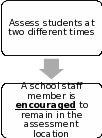
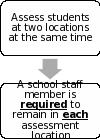
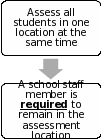
Once students are actively taking the assessment, we respectfully ask you to follow these important guidelines while participating in NAEP to ensure the validity of the assessment.
1. Please do not answer any questions that students ask you about their assessment.
NAEP representatives are highly trained staff who administer the assessments to students to ensure the highest level of validity of the assessment results. They have a script they must read verbatim to maintain the consistency of the instructions to students across the nation. NAEP representatives have been directed not to answer any questions students ask about their assessment. Instead, they should encourage students to do the best they can. By talking to a student about their assessment, you may inadvertently compromise the results.
2. Please refrain from having conversations with anyone during the assessment, including the NAEP representative.
Unnecessary conversations and other noise could be disruptive to students and affect their ability to concentrate on the assessment.
3. Please do not look at students’ screens while they are taking the assessment.
The security of the assessment items is a very important part of NAEP. No one other than the student is permitted to read the questions. NAEP representatives have signed a security affidavit and, since you have access to the assessment booklets, we ask the same of you. Any staff members who will be present during the NAEP assessment must sign an electronic Non-Disclosure Agreement before the assessment starts.
You may view sample questions at https://www.nationsreportcard.gov/nqt/searchquestions, which provides examples of assessment questions from previous years in all NAEP subjects. You may also download Sample Question Booklets that include assessment background, sample questions, and all questionnaire items, at https://nces.ed.gov/nationsreportcard/participating/.
About NAEP
The National Assessment of Educational Progress (NAEP), often referred to as The Nation’s Report Card, measures what U.S. students know and can do in key subject areas at the elementary, middle, and high school levels and provides reliable student achievement profiles to educators and the public. NAEP is the largest continuing and nationally representative assessment to chart trends in students’ achievement across our nation. Since 1969, NAEP has been successful because of the support of teachers and school staff whose students participated in the assessment.
Appendix D-53: NAEP 2026 School staff Assistance Guidelines, Puerto Rico (NEW)
[Asistencia Técnica Solamente]
Asunto: Asistencia del personal escolar para la evaluación de NAEP (Asistencia técnica)
Para: Miembro del personal de la escuela identificado para ayudar con la tecnología
CC: Coordinador(a) escolar, persona de respaldo para asistencia técnica
Adjuntos: «Pautas para la asistencia del personal de la escuela de NAEP 2026.pdf» y Acuerdo de confidencialidad de NAEP
Estimado(a)
[NOMBRE
Y APELLIDO DEL MIEMBRO DEL PERSONAL ESCOLAR]:
Su escuela lo(a) ha seleccionado para proporcionar asistencia con la tecnología escolar durante la evaluación de NAEP porque usted está familiarizado(a) con los dispositivos de su escuela. Espero verle el [DÍA DE LA EVALUACIÓN], [FECHA DE LA EVALUACIÓN], cuando llegue a su escuela para realizar la evaluación. Le agradezco de antemano su ayuda para garantizar que la evaluación de NAEP se desarrolle sin inconvenientes. Adjunto encontrará las pautas para la asistencia del personal de la escuela de NAEP, en las que se detalla su función.
Se le pedirá que ayude al equipo de NAEP con lo siguiente:
Configurar los dispositivos y detalles del WiFi
Ayude a configurar los dispositivos de la escuela (incluidos los dispositivos de repuesto) para la evaluación.
Proporcione el nombre y las credenciales de la red WiFi de la escuela.
Ayudar a los estudiantes a iniciar la evaluación
Resuelvar los problemas de los dispositivos y de la red que puedan tener los estudiantes al iniciar la aplicación de evaluación de NAEP.
Disponibilidad de asistencia técnica
Esté disponible en el salón o disponible por teléfono para brindar asistencia con los dispositivos durante toda la evaluación.
Cuando llegue a las [HORA DE LLEGADA] para preparar la evaluación, necesitaré su ayuda con la tecnología de su escuela. Se recomienda que permanezca en el lugar de la evaluación durante toda la evaluación de NAEP. Una vez transcurridos los primeros 15 minutos de la evaluación, si necesita irse, proporcione su información de contacto al(a la) representante de NAEP en caso de que se necesite asistencia técnica después de que usted salga del salón.
Tenga en cuenta que una vez que los estudiantes estén tomando la evaluación, le pedimos que siga estas importantes pautas para garantizar la validez de la evaluación:
No responda a ninguna pregunta que los estudiantes le hagan sobre su evaluación.
Absténgase de mantener conversaciones con cualquier persona durante la evaluación, incluido el(la) representante de NAEP.
No mire las pantallas de los estudiantes mientras están tomando la evaluación.
También se adjunta a este correo electrónico el Acuerdo de confidencialidad de NAEP para que lo revise. Se le pedirá que firme este documento digitalmente el día de la evaluación.
Su escuela también ha identificado a una persona de respaldo para asistencia técnica, quien está en copia en este correo electrónico, para ayudarle en su ausencia.
Por favor, llámeme o escríbame un correo electrónico si tiene alguna pregunta.
Gracias,
[Nombre del(de la) representante de NAEP]
Representante de NAEP
[Dirección de correo electrónico del(de la) representante de NAEP]
[Teléfono]
[Asistencia con el Manejo del Salón de Clase - 1 grupo de 25]
Asunto: Asistencia del personal escolar para la evaluación de NAEP (Asistencia en el salón de clase)
Para: Miembro del personal de la escuela identificado para ayudar en el salón de clase
CC: Coordinador(a) escolar, personal escolar de respaldo para asistencia con el salón de clase)
Adjuntos: «Pautas para la asistencia del personal de la escuela de NAEP 2026.pdf» y Acuerdo de confidencialidad de NAEP
Estimado(a) [NOMBRE Y APELLIDO DEL MIEMBRO DEL PERSONAL ESCOLAR]:
Su
escuela lo(a) ha seleccionado para proporcionar asistencia con el
manejo del salón de clase durante la evaluación de
NAEP. Espero
verle el [DÍA
DE LA EVALUACIÓN],
[FECHA
DE LA EVALUACIÓN],
cuando llegue a su escuela para realizar la evaluación.
Adjunto encontrará un archivo que detalla su función
como personal de asistencia.
Se recomienda que permanezca en el lugar de la evaluación durante toda la evaluación de NAEP para ayudar con el manejo del salón de clase. Por favor, llegue a la misma hora que los estudiantes.
Tenga en cuenta que una vez que los estudiantes estén tomando la evaluación, le pedimos que siga estas importantes pautas para garantizar la validez de la evaluación:
No responda a ninguna pregunta que los estudiantes le hagan sobre su evaluación.
Absténgase de mantener conversaciones con cualquier persona durante la evaluación, incluido el(la) representante de NAEP.
No mire las pantallas de los estudiantes mientras están tomando la evaluación.
También se adjunta a este correo electrónico el Acuerdo de confidencialidad de NAEP para que lo revise. Se le pedirá que firme este documento digitalmente el día de la evaluación.
Su escuela también ha identificado a una persona de asistencia de respaldo, quien está en copia en este correo electrónico, para ayudarle en su ausencia.
Por favor, llámeme o escríbame un correo electrónico si tiene alguna pregunta.
Gracias,
[Nombre del(de la) representante de NAEP]
Representante de NAEP
[Dirección de correo electrónico del(de la) representante de NAEP]
[Teléfono]
[Asistencia Técnica y Asistencia con el Manejo del Salón de Clase - 1 grupo de 25]
Asunto: Asistencia del personal escolar para la evaluación de NAEP (Asistencia técnica y en el salón de clase)
Para: Miembro del personal de la escuela identificado para ayudar con la tecnología y el salón de clase
CC: Coordinador(a) escolar, personal escolar de respaldo (para asistencia con la tecnología y el salón de clase)
Adjuntos: «Pautas para asistencia del personal de la escuela de NAEP 2026.pdf» y Acuerdo de confidencialidad de NAEP
Estimado(a) [NOMBRE Y APELLIDO DEL MIEMBRO DEL PERSONAL ESCOLAR]:
Su escuela lo(a) ha seleccionado para proporcionar asistencia con la tecnología escolar durante la evaluación de NAEP porque usted está familiarizado(a) con los dispositivos de su escuela. También ha sido seleccionado(a) para proporcionar asistencia con el manejo del salón de clase durante la evaluación de NAEP.
Espero verle el [DÍA DE LA EVALUACIÓN], [FECHA DE LA EVALUACIÓN], cuando llegue a su escuela para realizar la evaluación. Le agradezco de antemano su ayuda para garantizar que la evaluación de NAEP se desarrolle sin inconvenientes. Adjunto encontrará las pautas de asistencia para el personal escolar de NAEP, en las que se detalla su función.
Cuando llegue a las [HORA DE LLEGADA] para preparar la evaluación, necesitaré su ayuda con la tecnología de su escuela.
Se le pedirá que ayude al equipo de NAEP con lo siguiente:
Configurar los dispositivos y detalles del WiFi
Ayudar a configurar los dispositivos de la escuela (incluidos los dispositivos de repuesto) para la evaluación.
Proporcionar el nombre y las credenciales de la red WiFi de la escuela.
Ayudar a los estudiantes a iniciar la evaluación
Resolver los problemas de los dispositivos y de la red que puedan tener los estudiantes al iniciar la aplicación de evaluación de NAEP.
Disponibilidad de asistencia técnica
Estar disponible en el salón o disponible por teléfono para brindar asistencia con los dispositivos durante toda la evaluación.
Se recomienda que permanezca en el lugar de la evaluación durante toda la evaluación de NAEP para ayudar con la tecnología de la escuela y con el manejo del salón de clase. Una vez transcurridos los primeros 15 minutos de la evaluación, si necesita irse, proporcione su información de contacto al(a la) representante de NAEP en caso de que se necesite asistencia técnica después de que usted salga del salón.
Tenga en cuenta que una vez que los estudiantes estén tomando la evaluación, le pedimos que siga estas importantes pautas para garantizar la validez de la evaluación:
No responda a ninguna pregunta que los estudiantes le hagan sobre su evaluación.
Absténgase de mantener conversaciones con cualquier persona durante la evaluación, incluido el(la) representante de NAEP.
No mire las pantallas de los estudiantes mientras están tomando la evaluación.
También se adjunta a este correo electrónico el Acuerdo de confidencialidad de NAEP para que lo revise. Se le pedirá que firme este documento digitalmente el día de la evaluación.
Su escuela también ha identificado a una persona de asistencia de respaldo, quien está en copia en este correo electrónico, para ayudarle en su ausencia.
Por favor, llámeme o escríbame un correo electrónico si tiene alguna pregunta.
Gracias,
[Nombre del(de la) representante de NAEP]
Representante de NAEP
[Dirección de correo electrónico del(de la) representante de NAEP]
[Teléfono]
Appendix D-54: NAEP 2026 Inclusion Guidelines for English Learners (NEW)
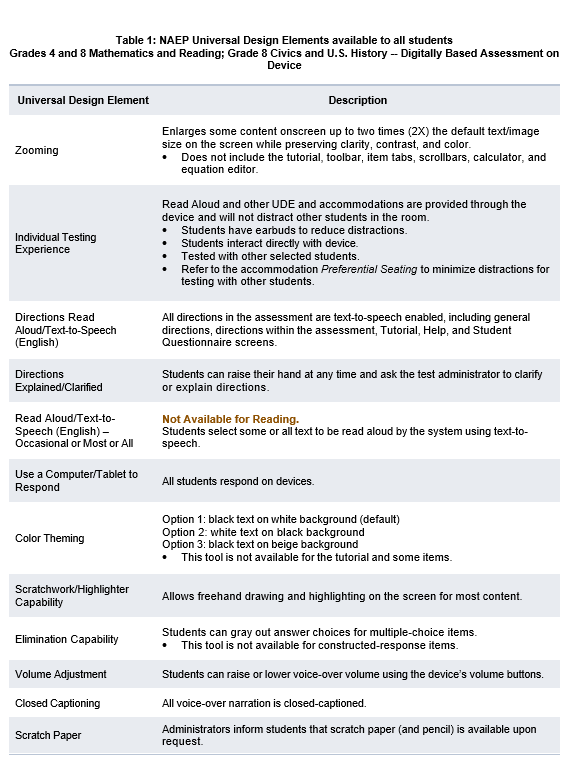
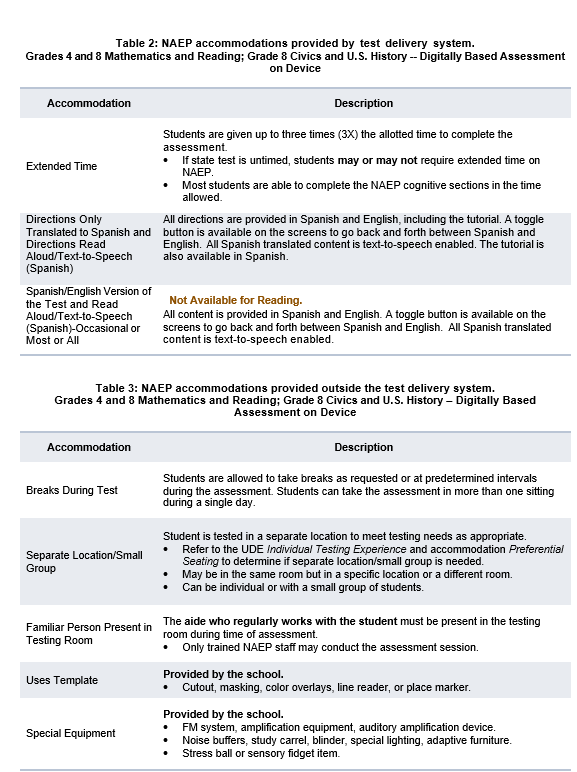
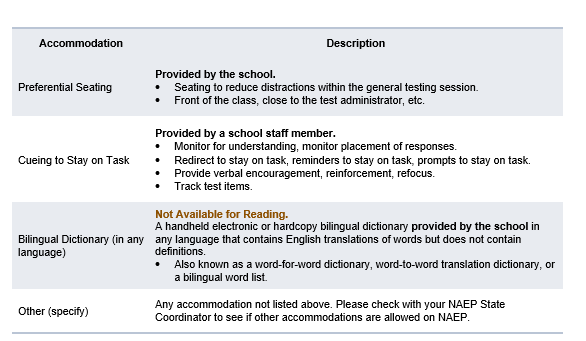
Appendix D-55: NAEP 2026 Inclusion Guidelines for English Learners, Pilot (NEW)
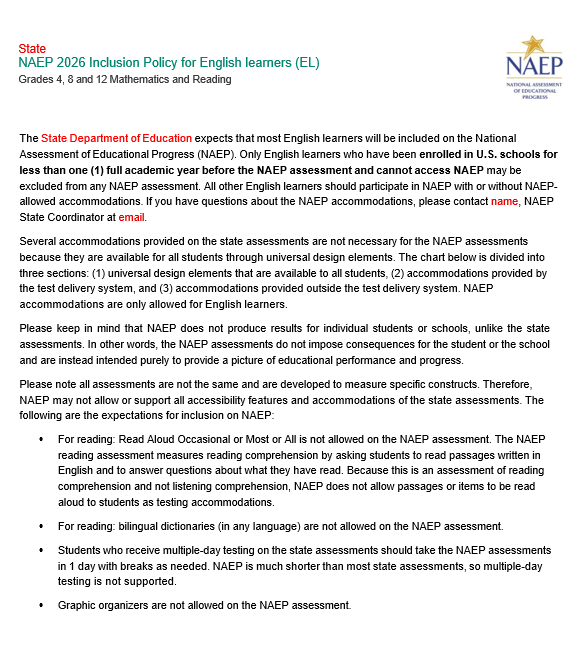
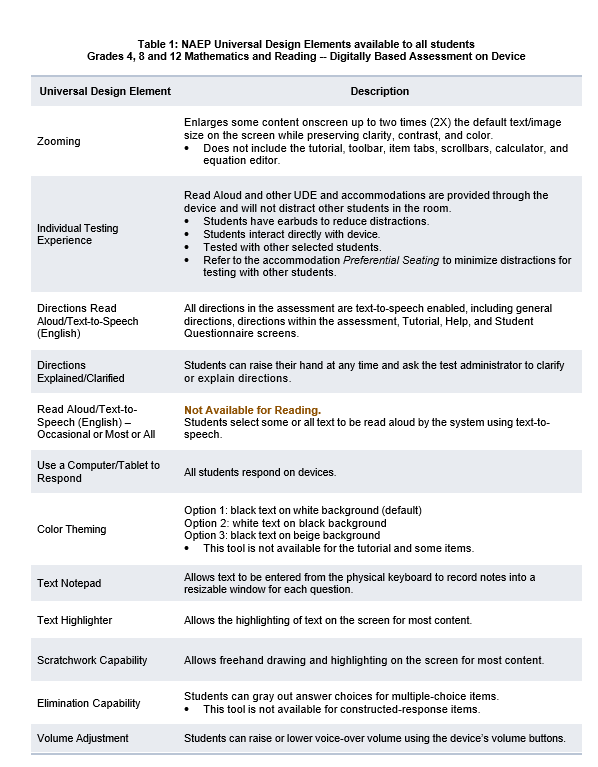
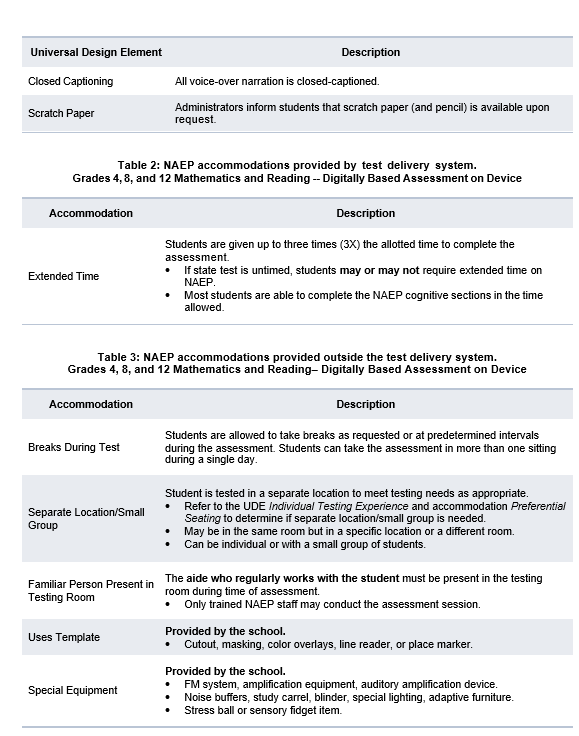
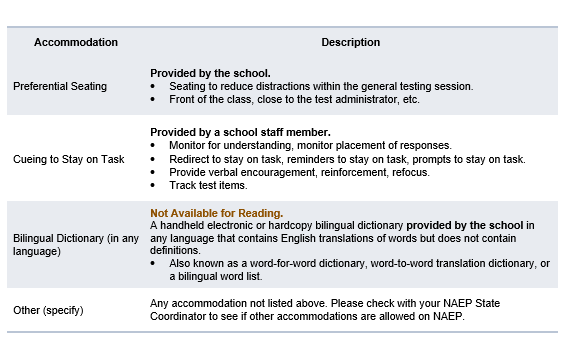
Appendix D-56: NAEP 2026 Inclusion Guidelines for English Learners, Puerto Rico (NEW)
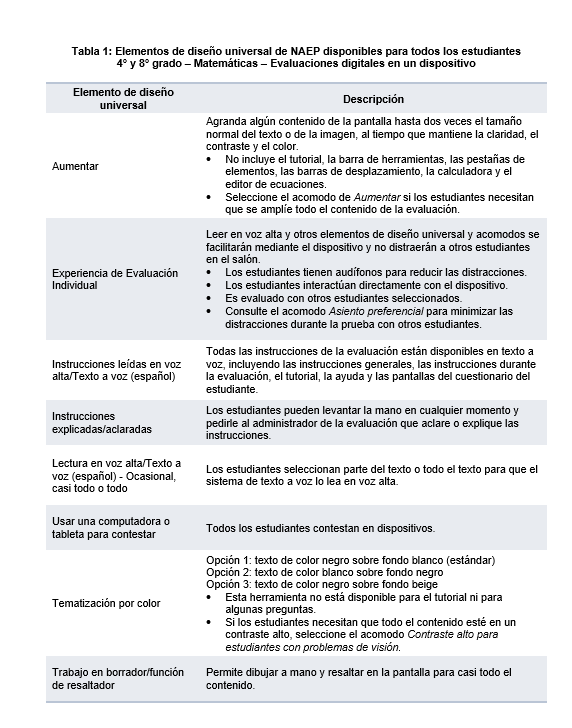

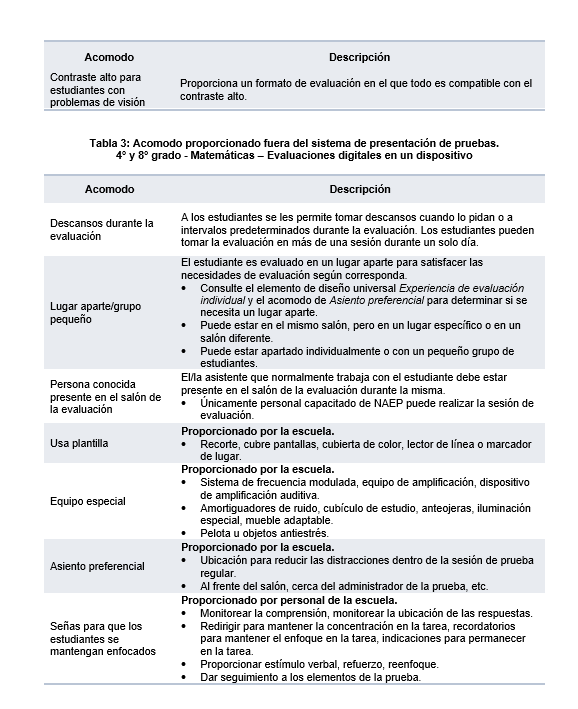
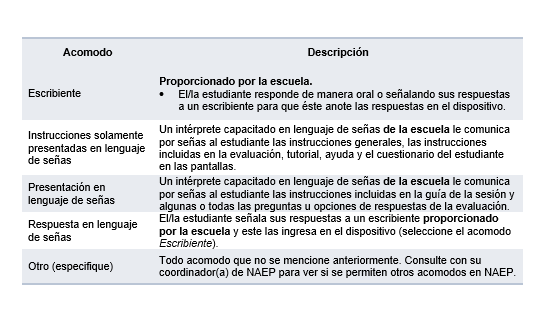
Appendix D-57: NAEP 2026 Inclusion Guidelines for English Learners, Pilot, Puerto Rico (NEW)
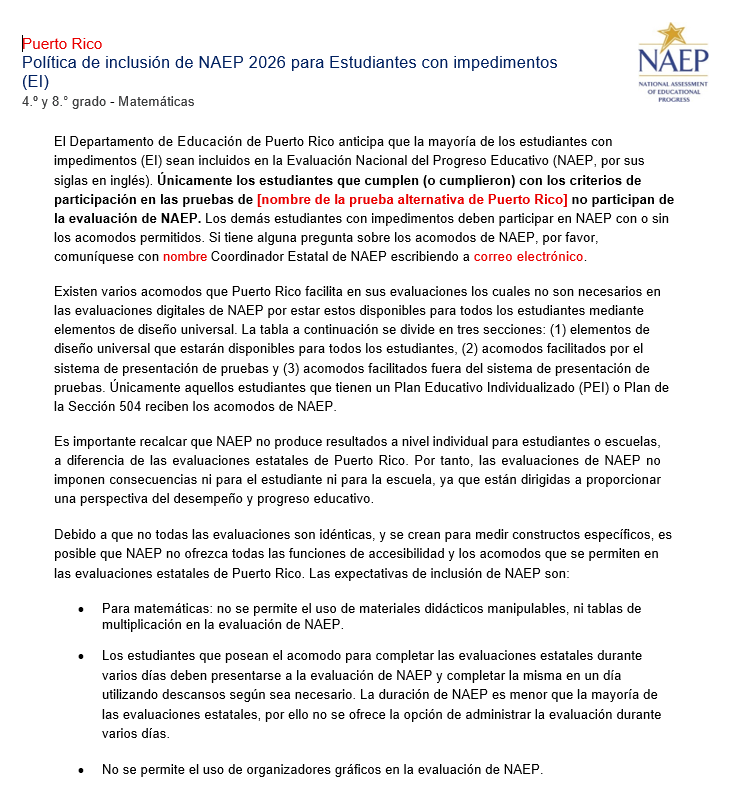
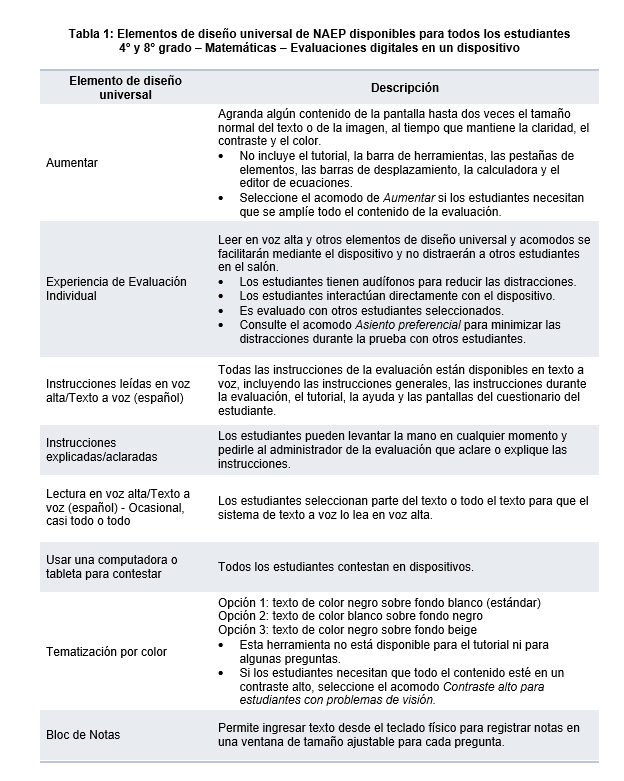
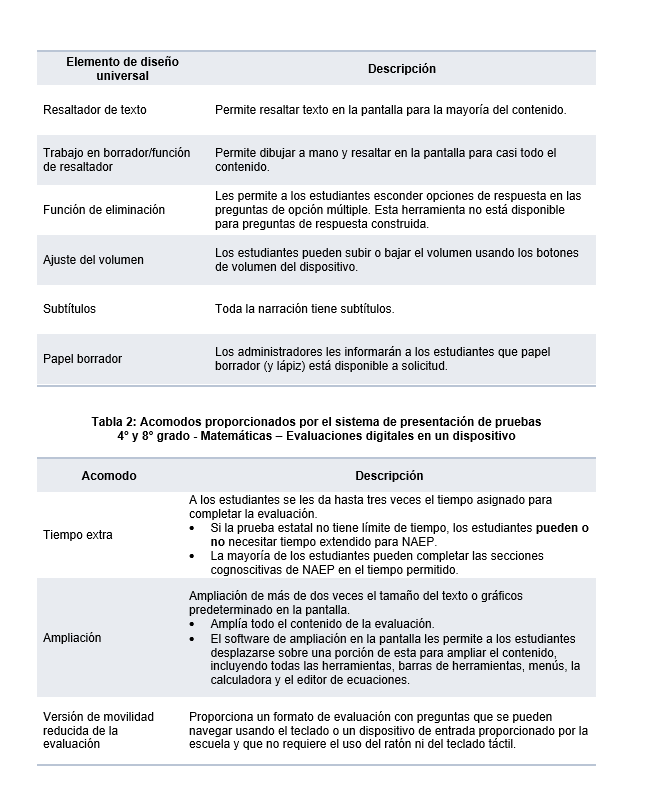

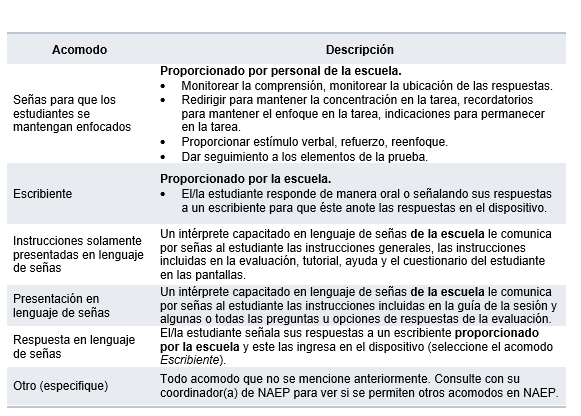
Appendix D-58: NAEP 2026 Inclusion Guidelines for Students with Disabilities (NEW)
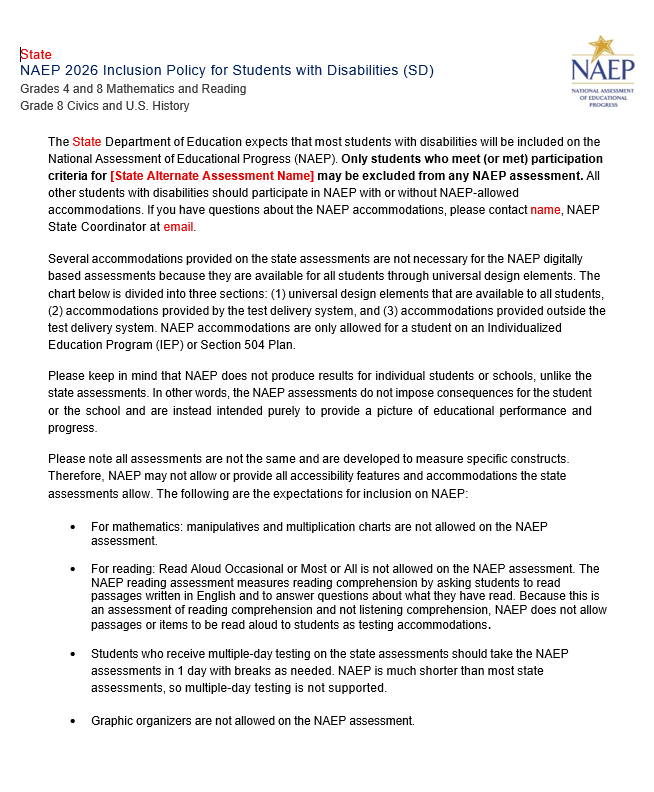

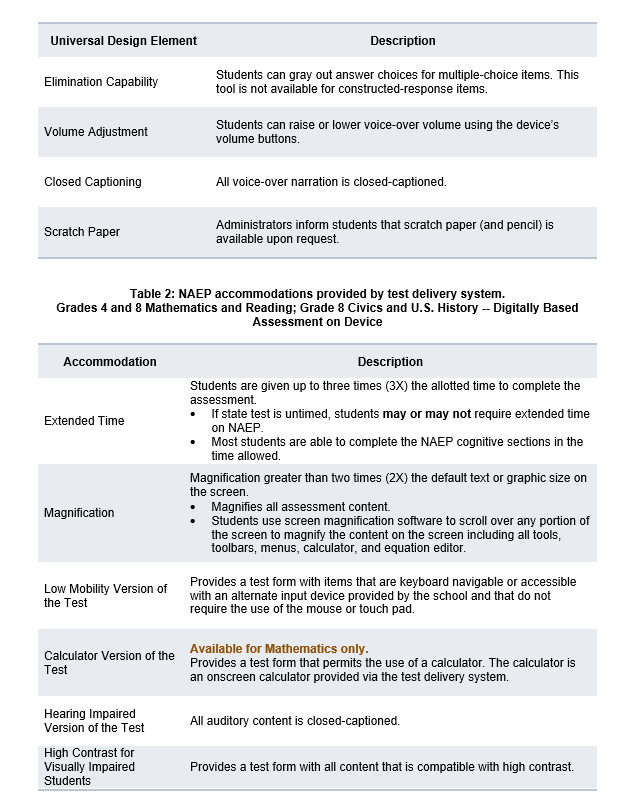
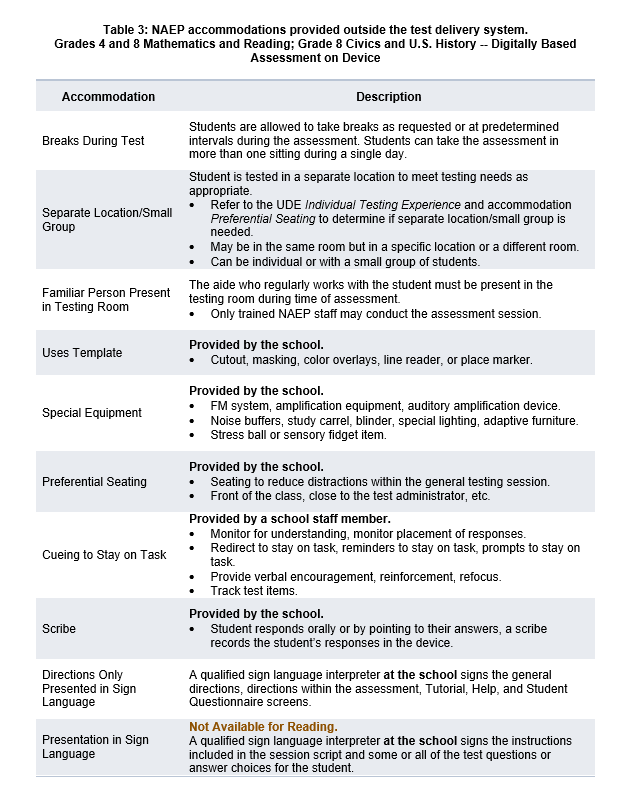
 Appendix
D-59: NAEP 2026 Inclusion
Guidelines for Students with Disabilities, Pilot (NEW)
Appendix
D-59: NAEP 2026 Inclusion
Guidelines for Students with Disabilities, Pilot (NEW)
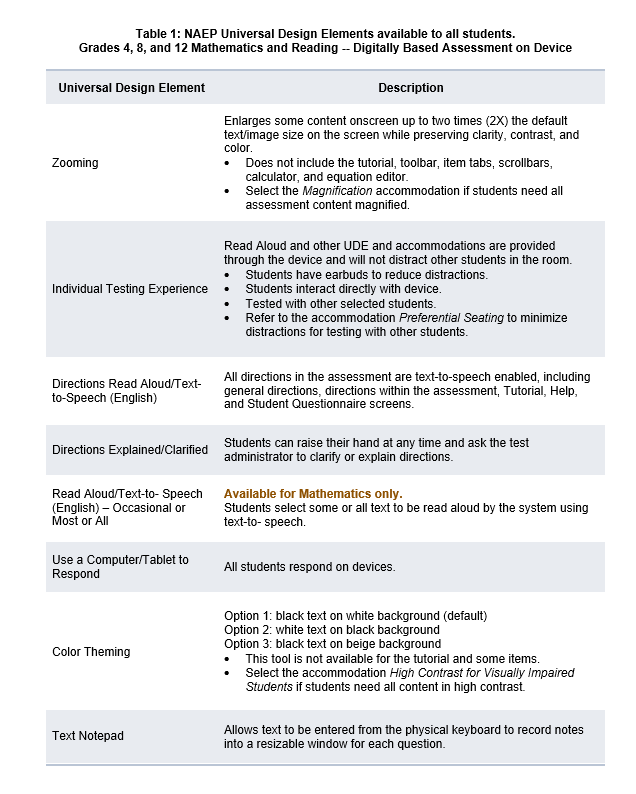
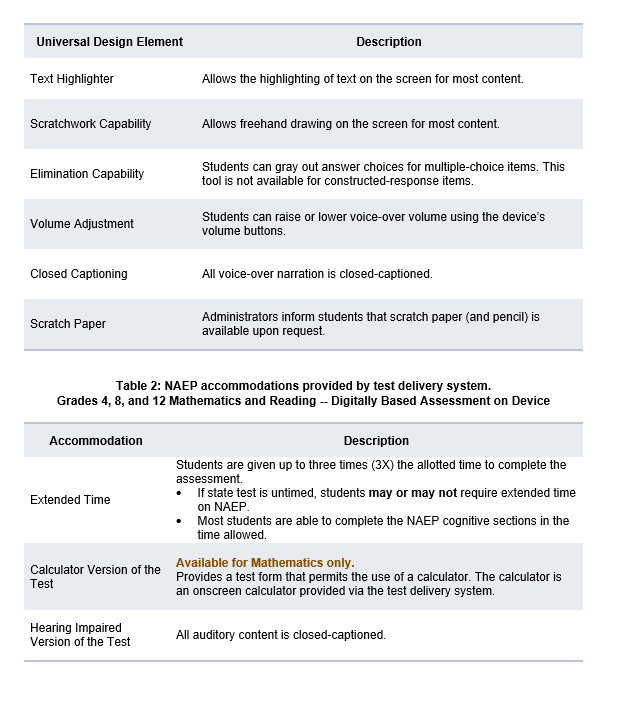

Appendix D-60: NAEP 2026 Inclusion Guidelines for Students with Disabilities, Puerto Rico (NEW)
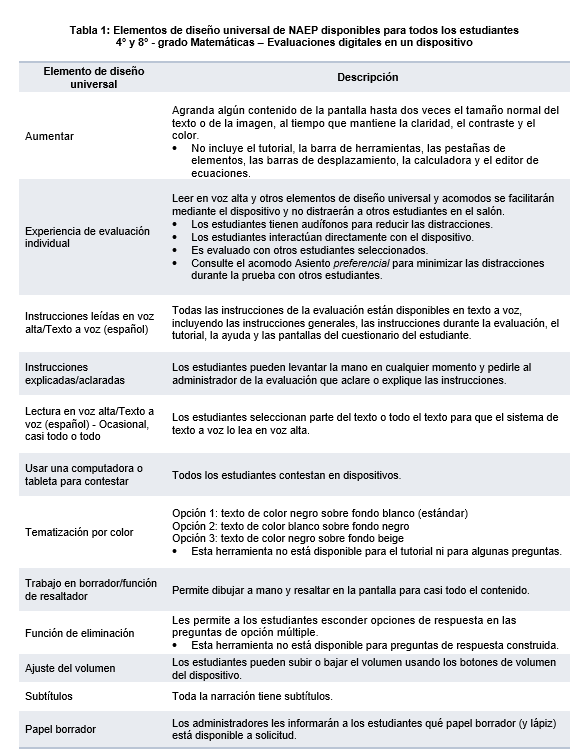
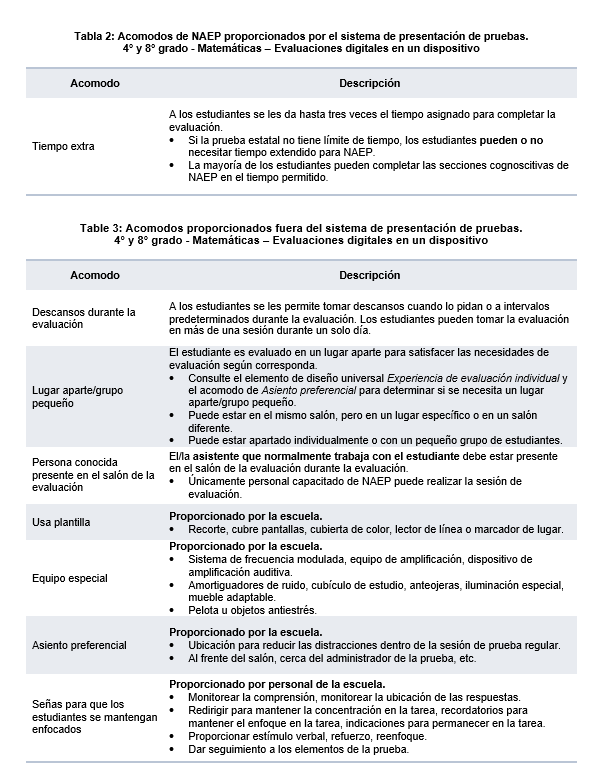

Appendix D-61: NAEP 2026 Inclusion Guidelines for Students with Disabilities, Pilot, Puerto Rico (NEW)
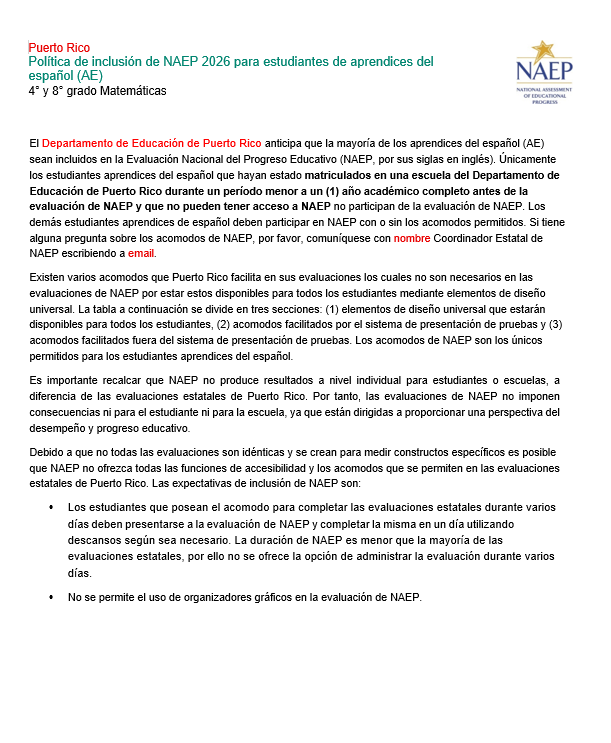
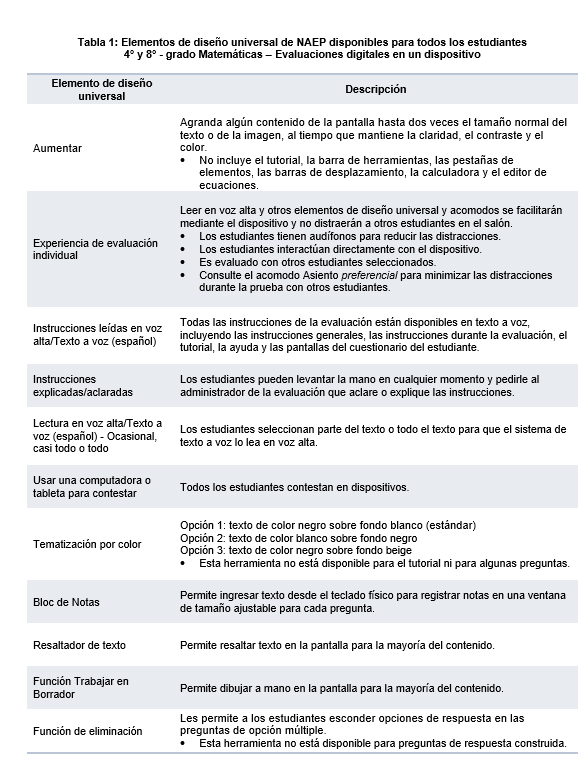
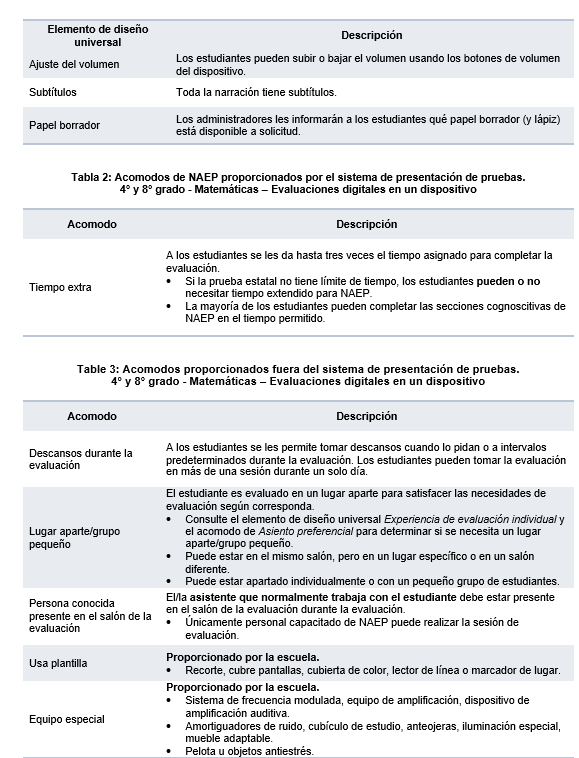
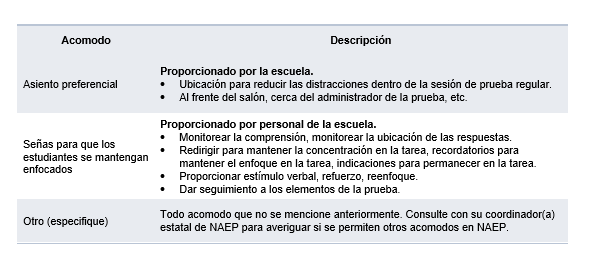
Appendix D-62: NAEP 2026 eNAEP Download Center (Revised)
Getting Started > Preparing for Assessment > Preassessment Tools (Landing Page)
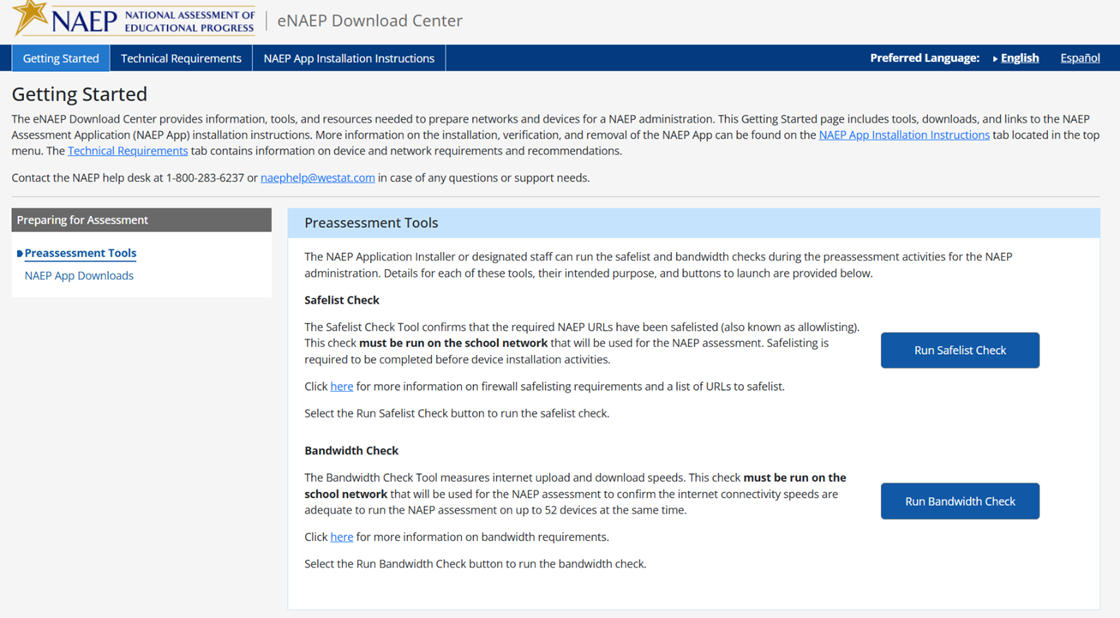
Getting Started > Preparing for Assessment > NAEP App Downloads
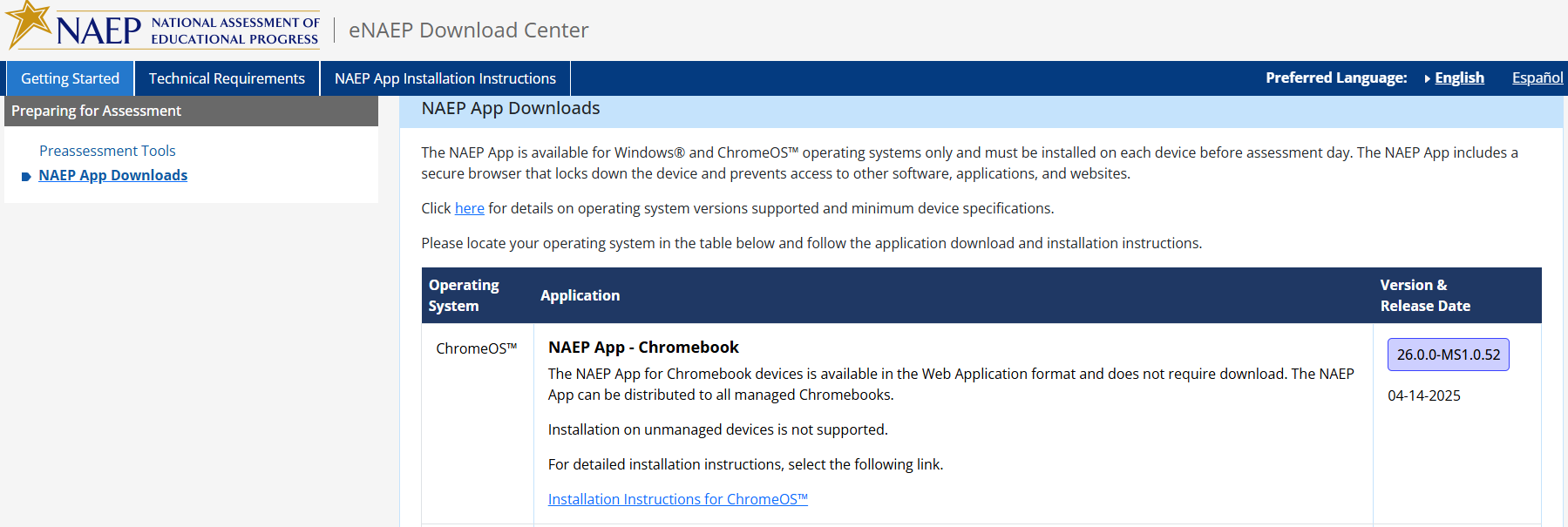
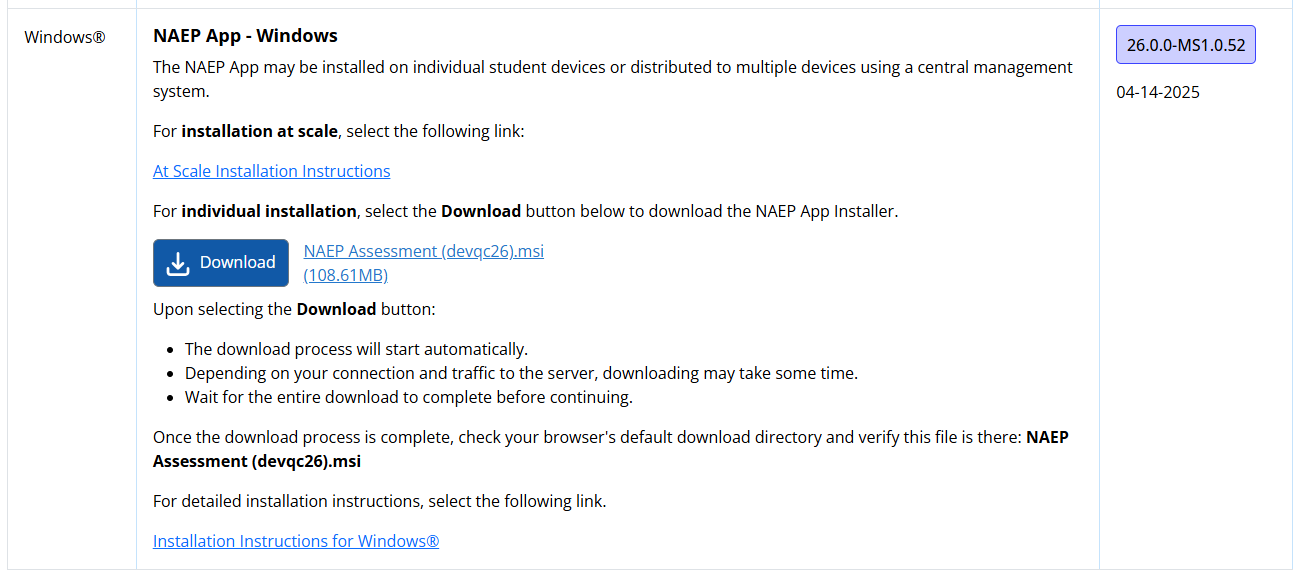
Technical Requirements > System Requirements > OS & Hardware Requirements

Technical Requirements > System Requirements > Device Requirements
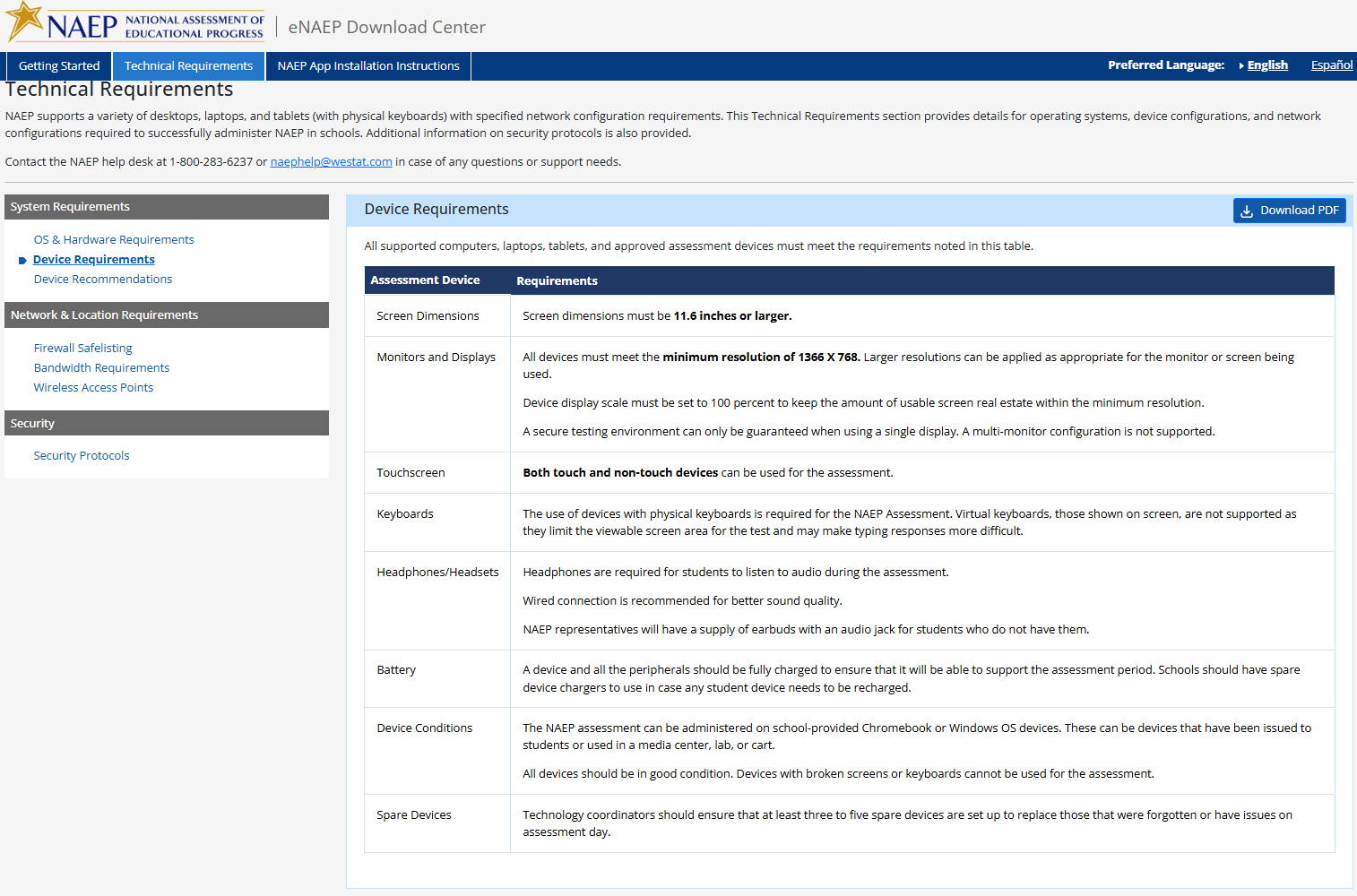
Technical Requirements > System Requirements > Device Recommendations
Technical Requirements > Network & Location Requirements > Firewall Safelisting
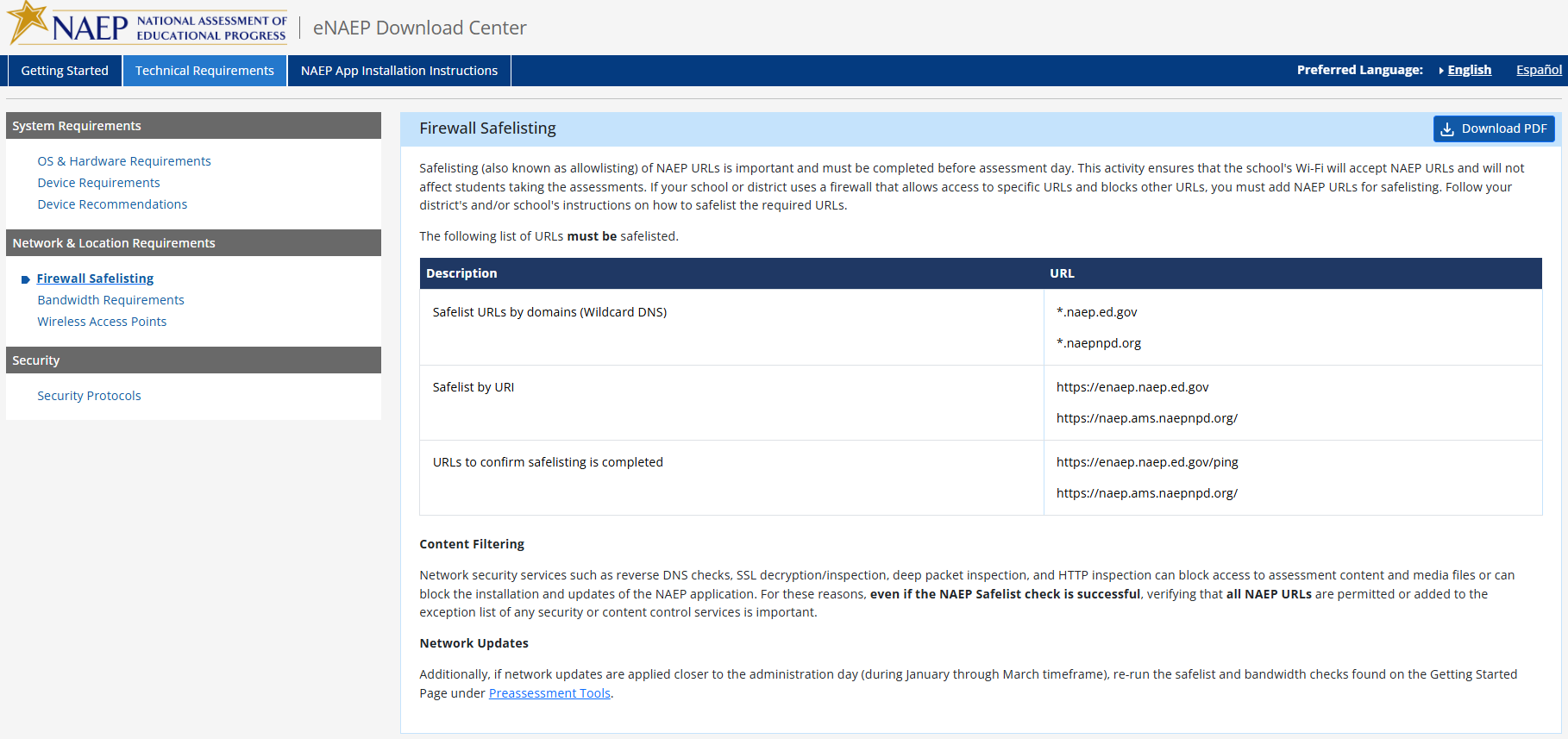
Technical
Requirements > Network & Location Requirements > Bandwidth
Requirements

Technical Requirements > Network & Location Requirements > Wireless Access Point

Technical Requirements > Security > Security Protocols

NAEP App Installation Instructions > ChromeOS > Installation Instructions

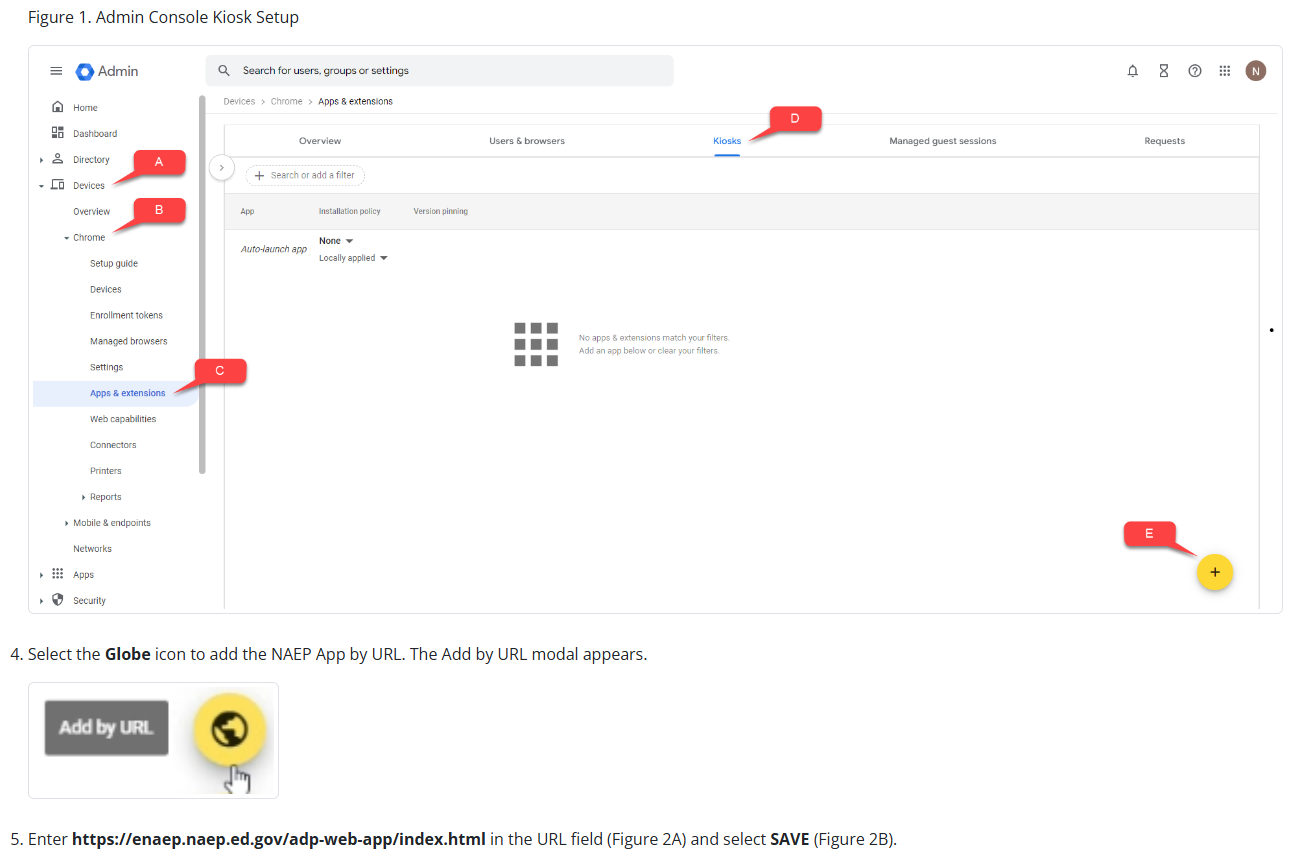
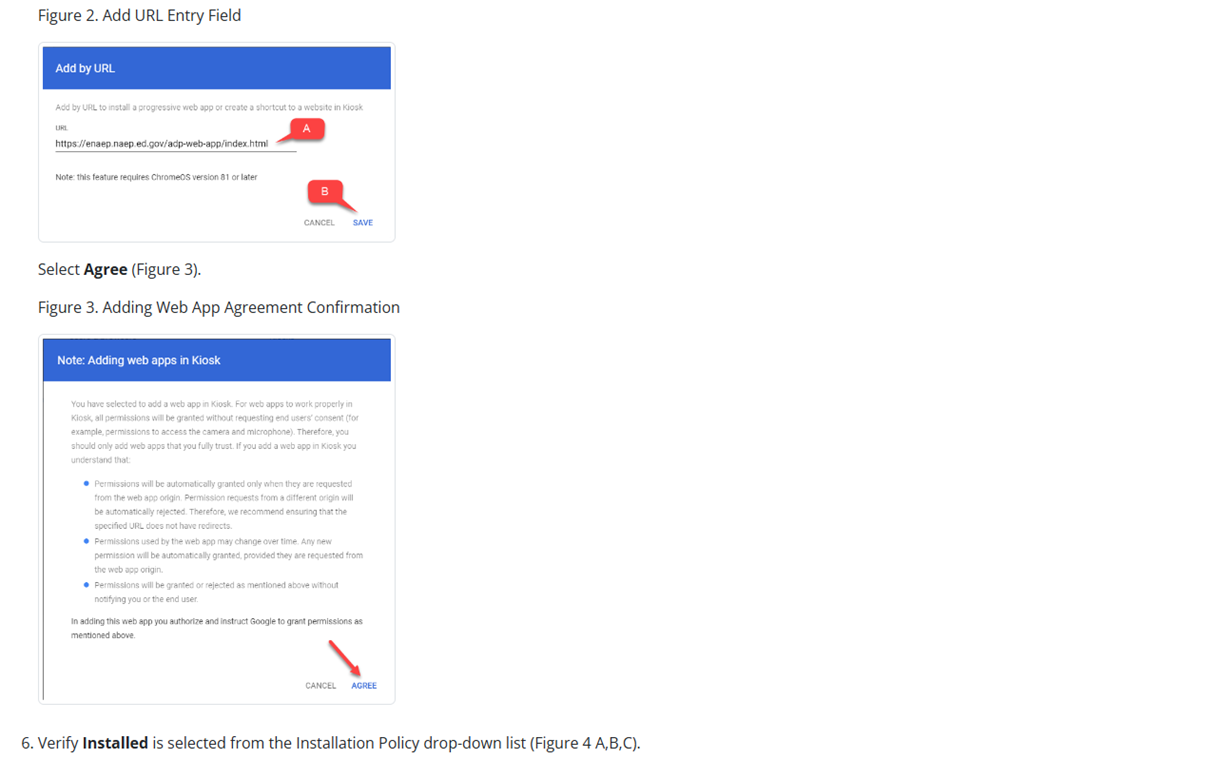
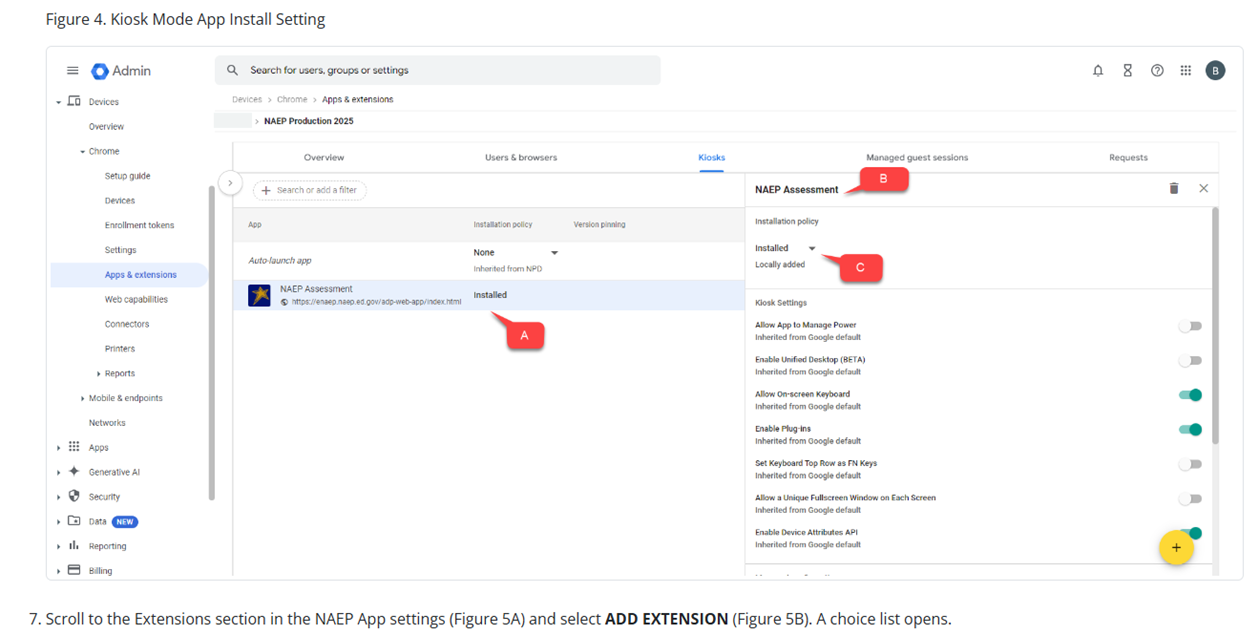
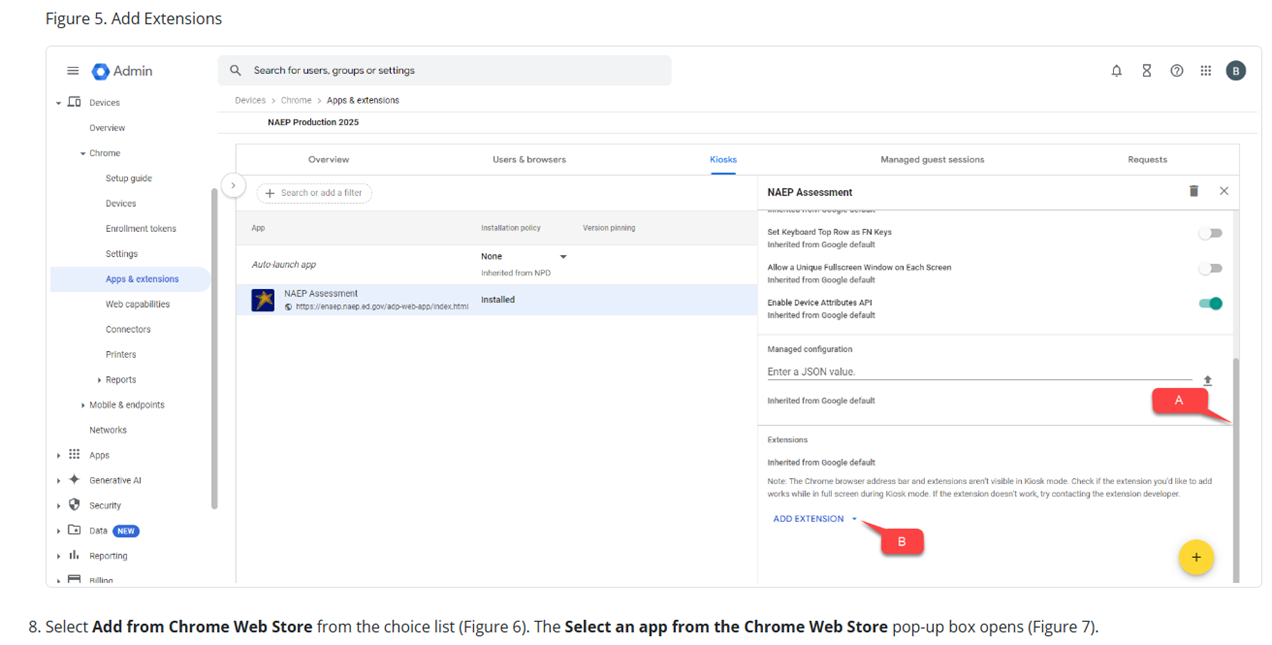
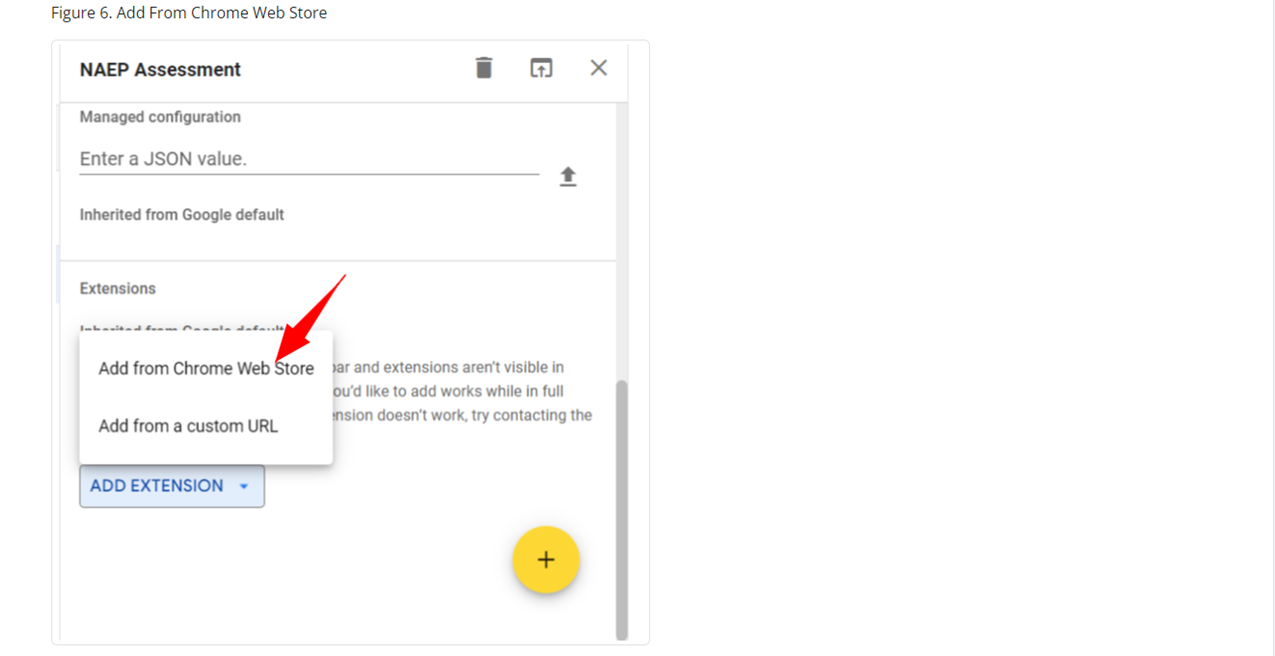


NAEP App Installation Instructions > ChromeOS > Post-install Verification Instructions

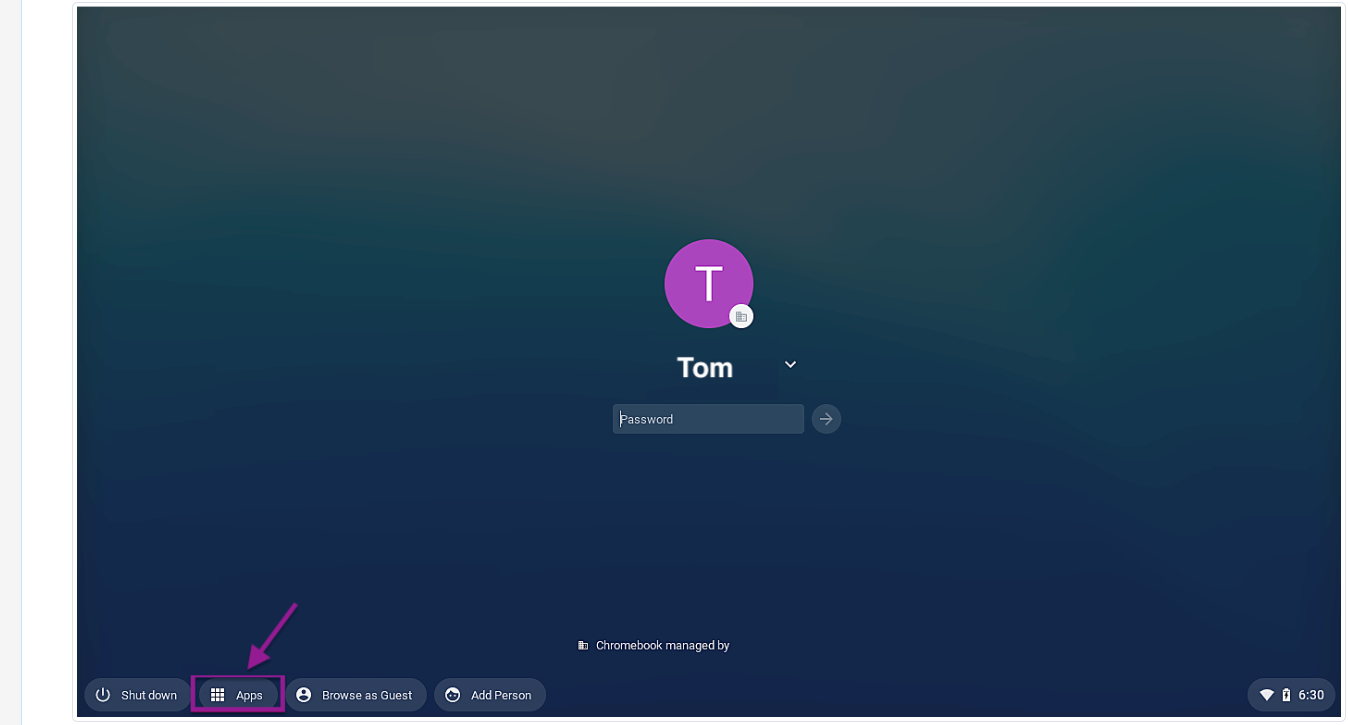
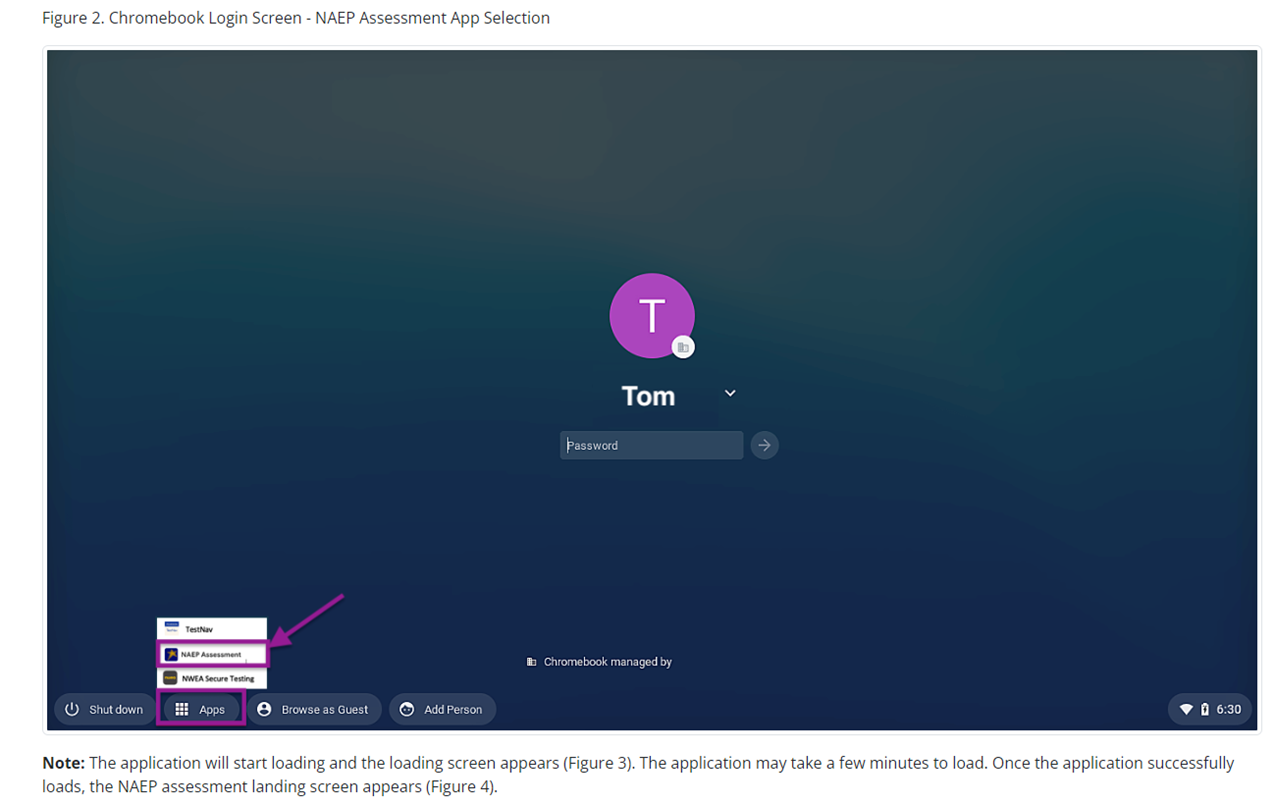
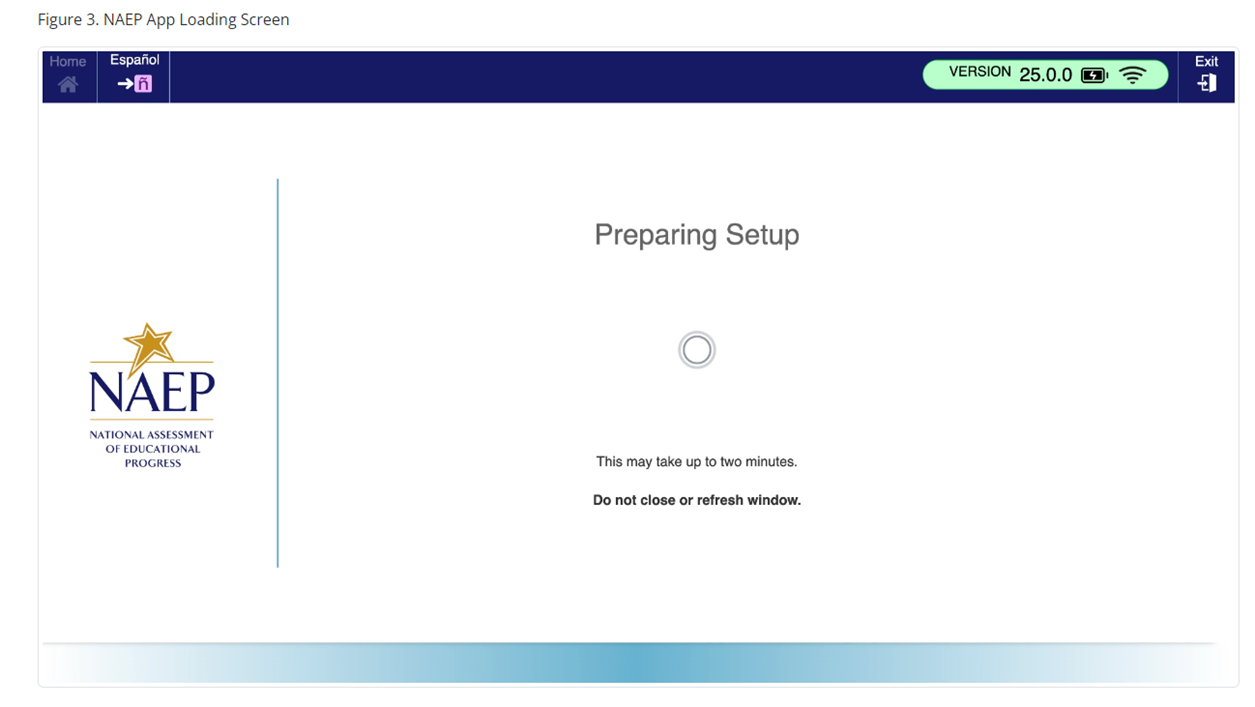
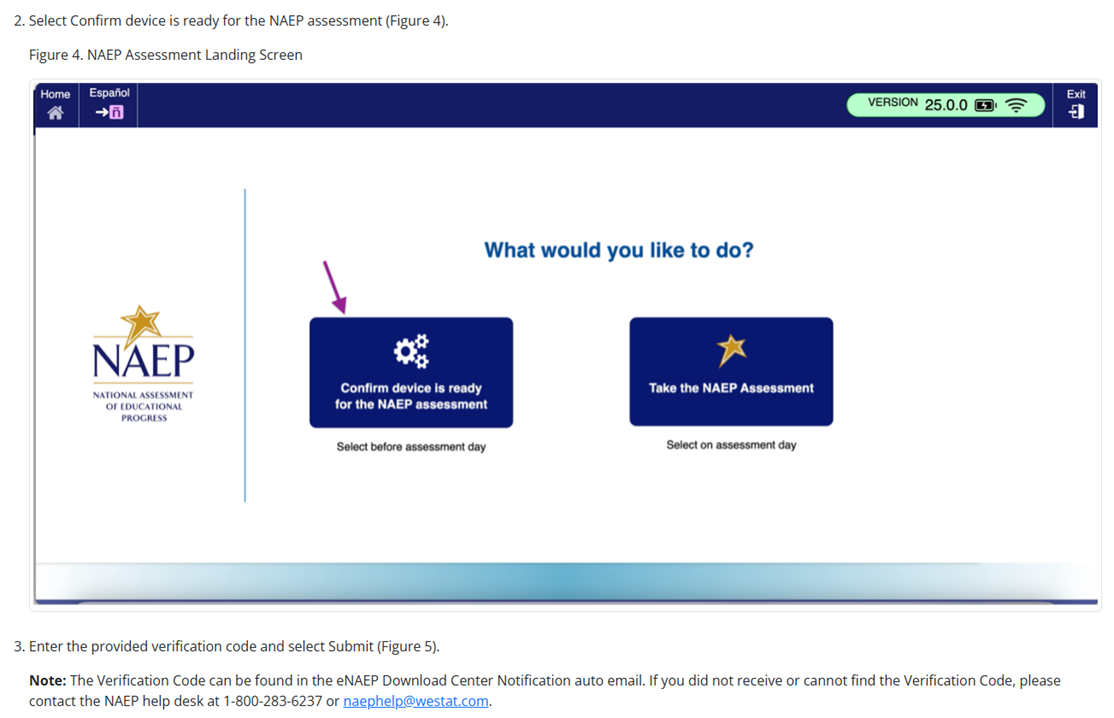


NAEP App Installation Instructions > ChromeOS > Application Removal Instructions

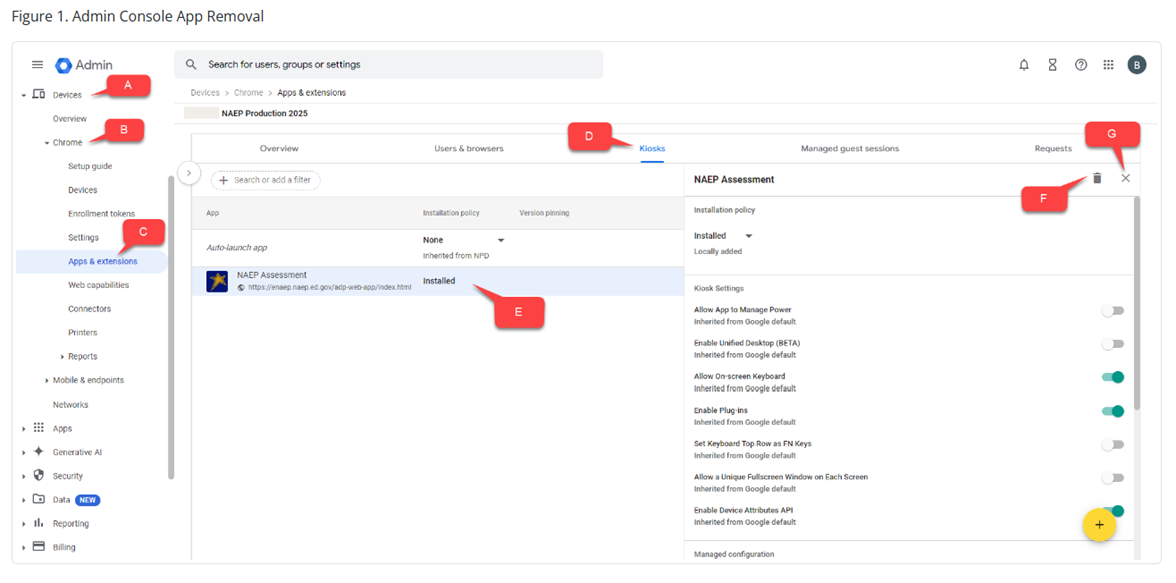
NAEP App Installation Instructions > Windows > Single Device Installation
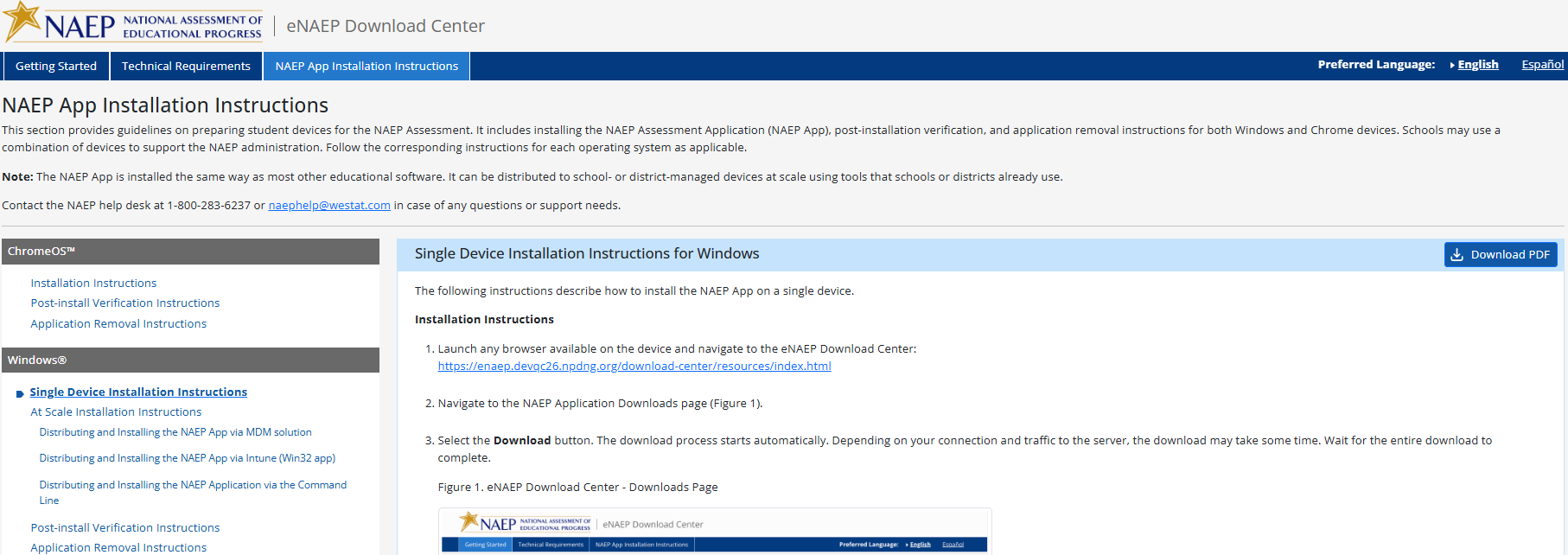
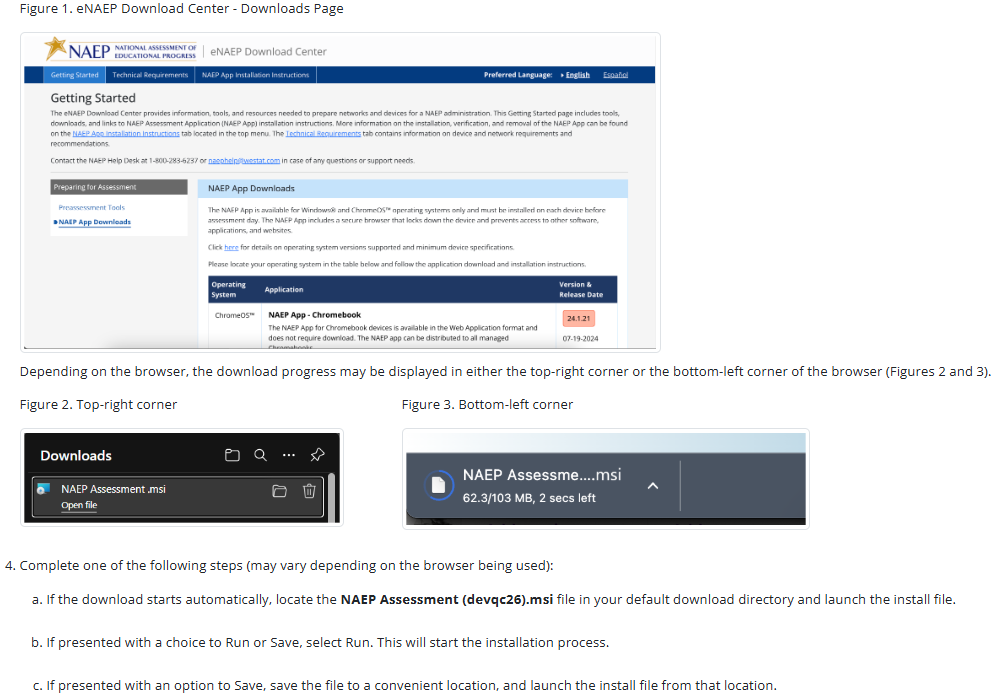

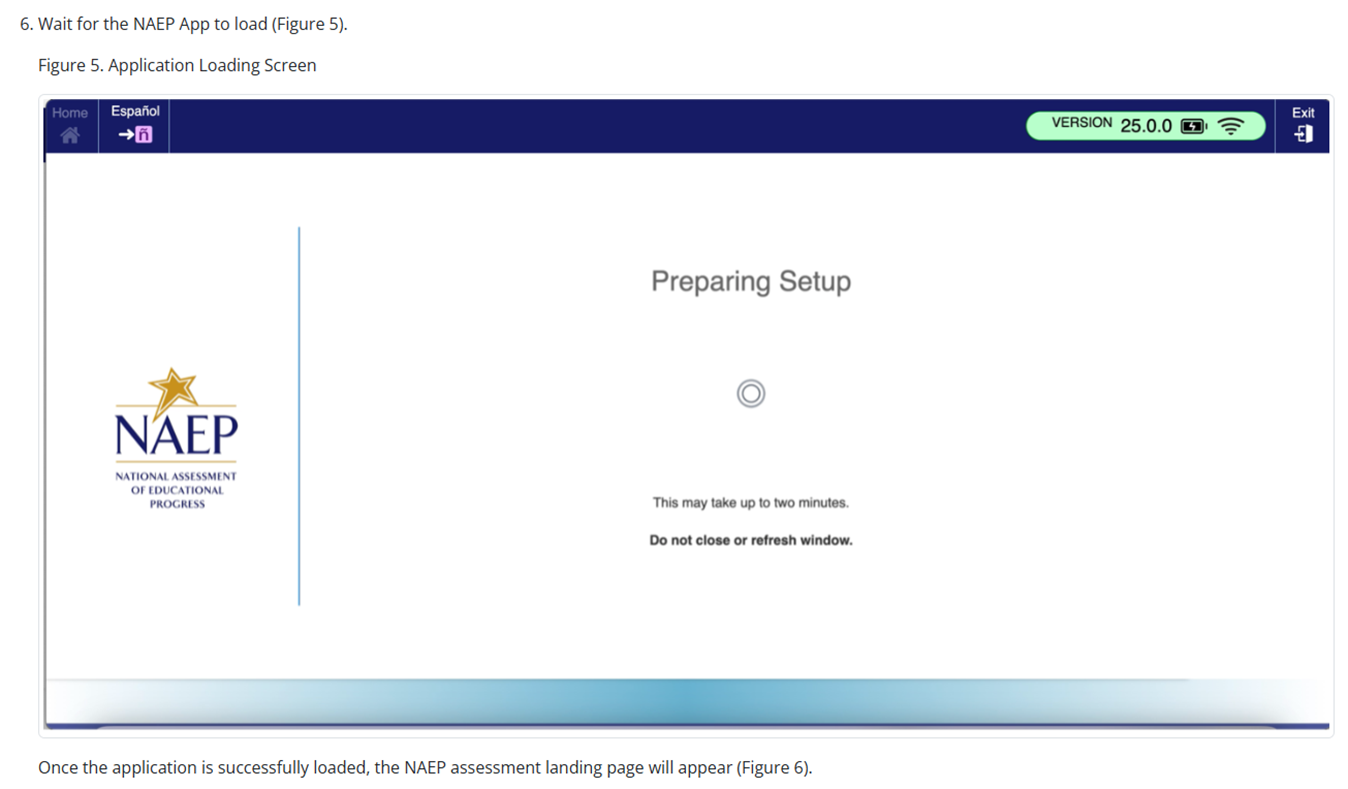

NAEP App Installation Instructions > Windows > At Scale Installation Instructions
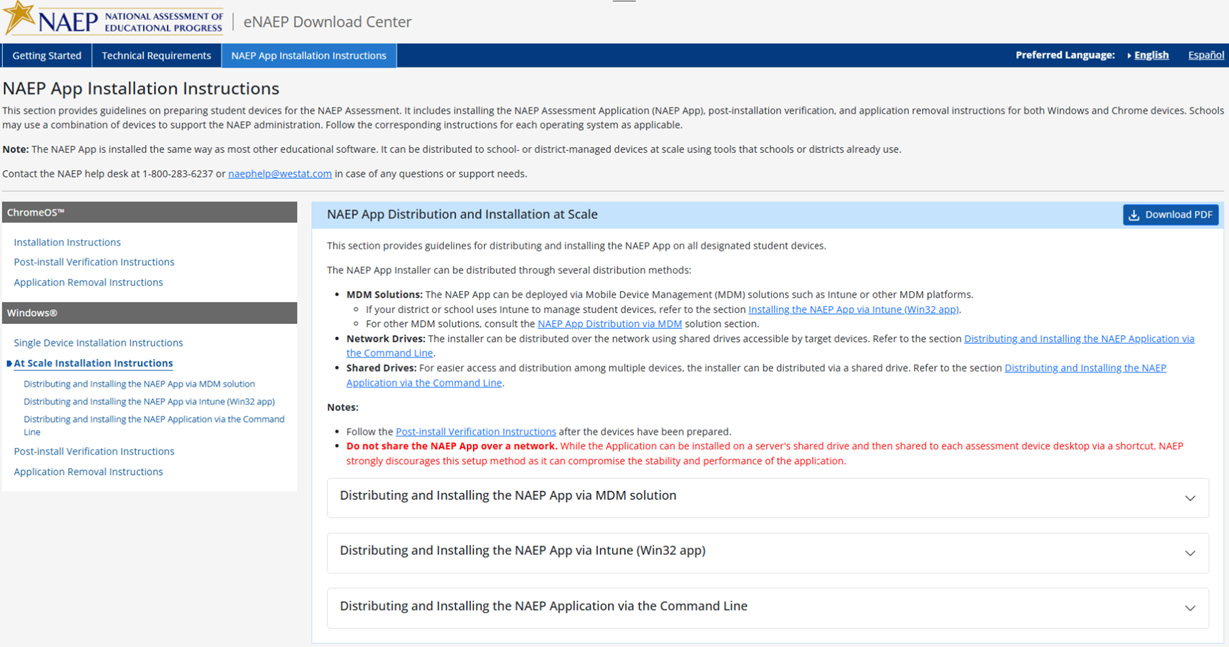
NAEP App Installation Instructions > Windows > At Scale Installation Instructions > Distributing and Installing the NAEP App via MDM Solution

NAEP App Installation Instructions > Windows > At Scale Installation Instructions > Distributing and Installing the NAEP App via Intune (Win32 app)
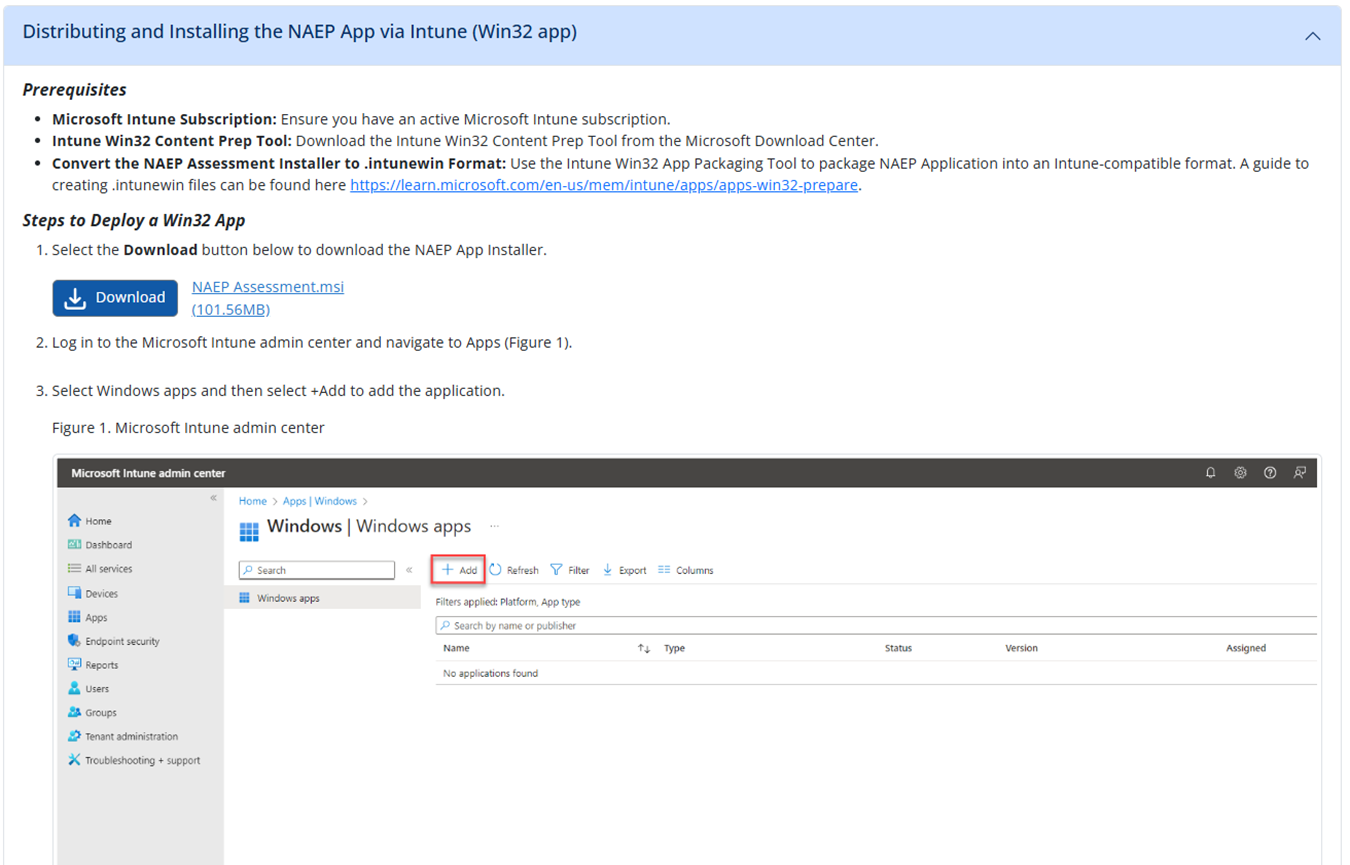
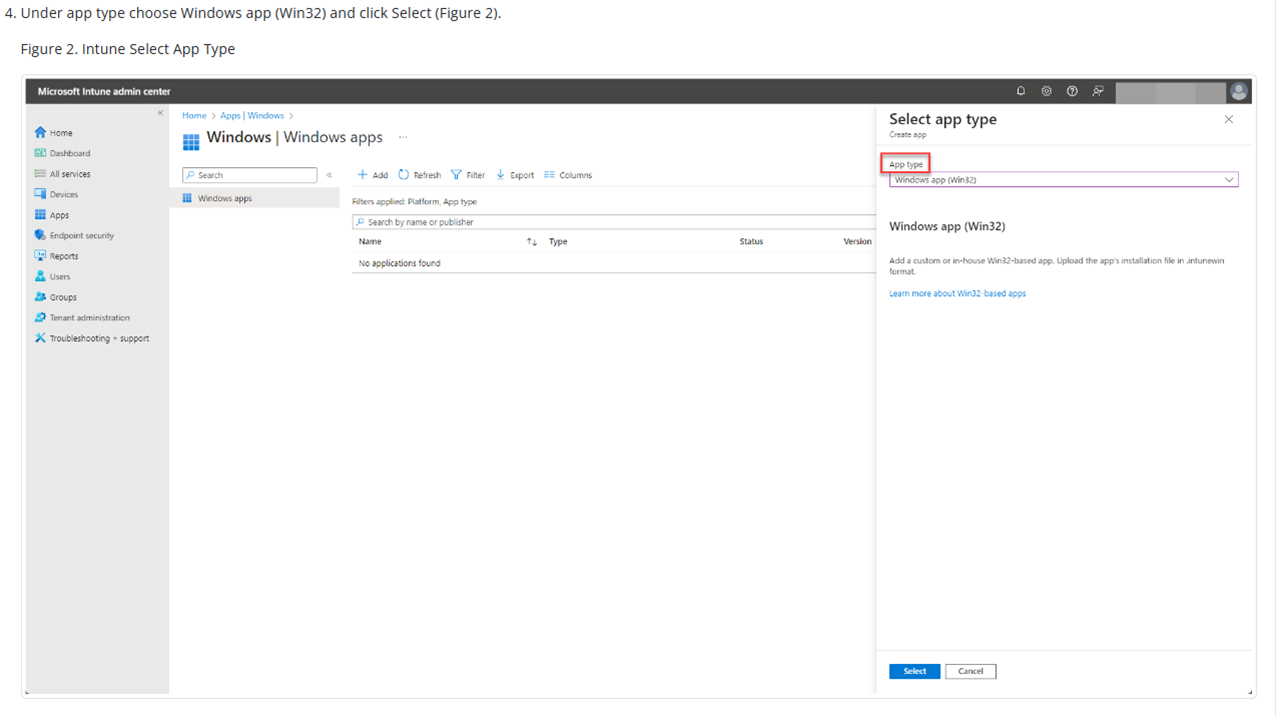
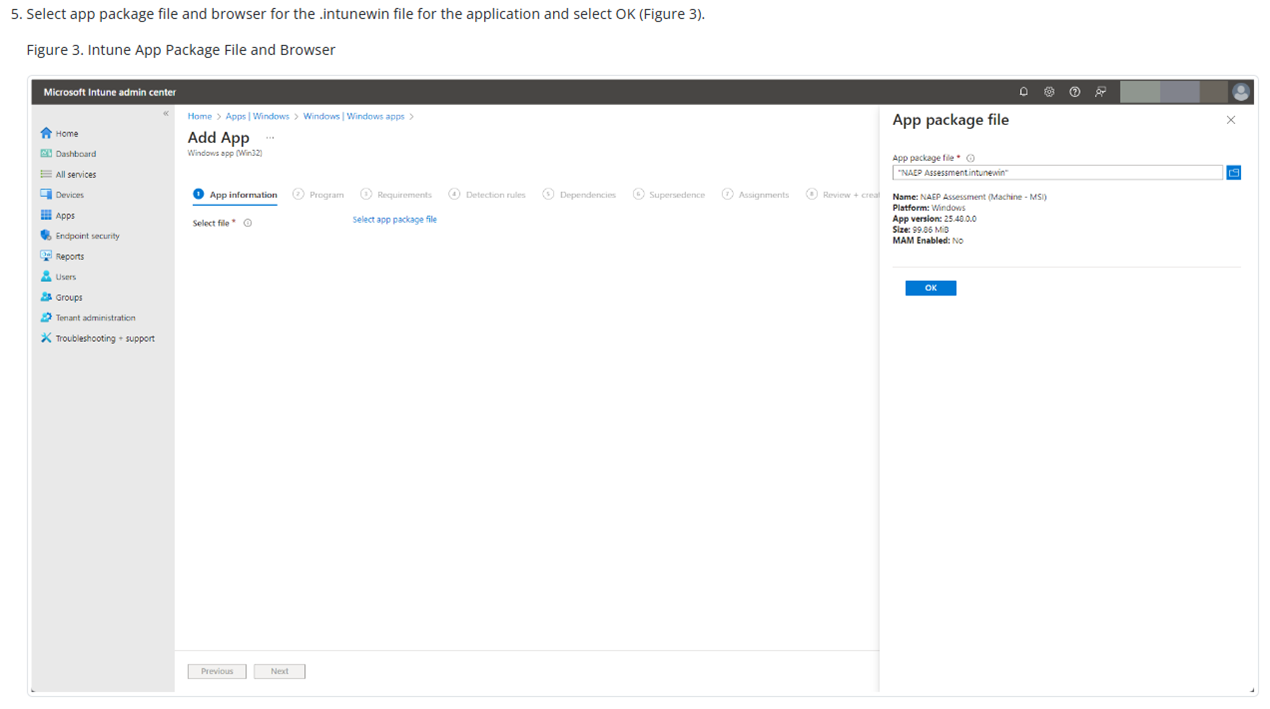

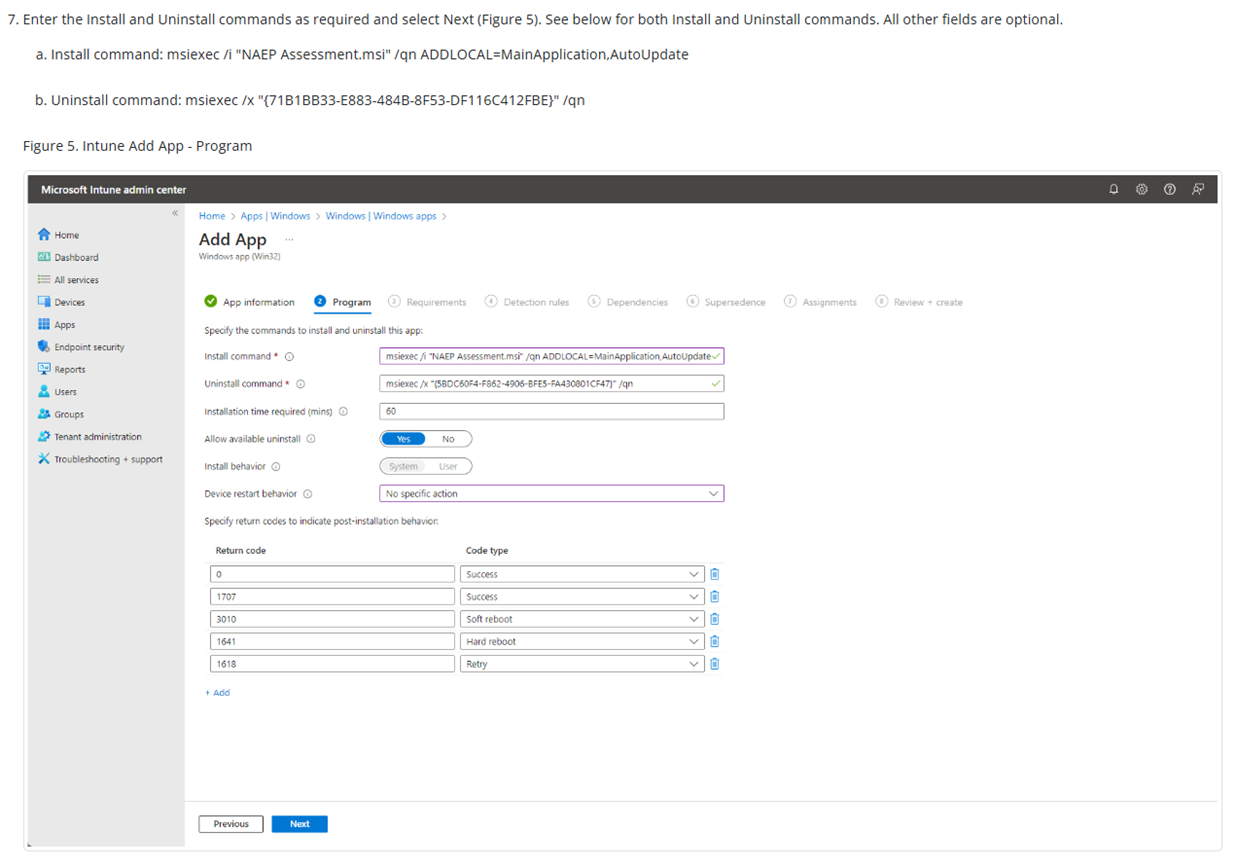
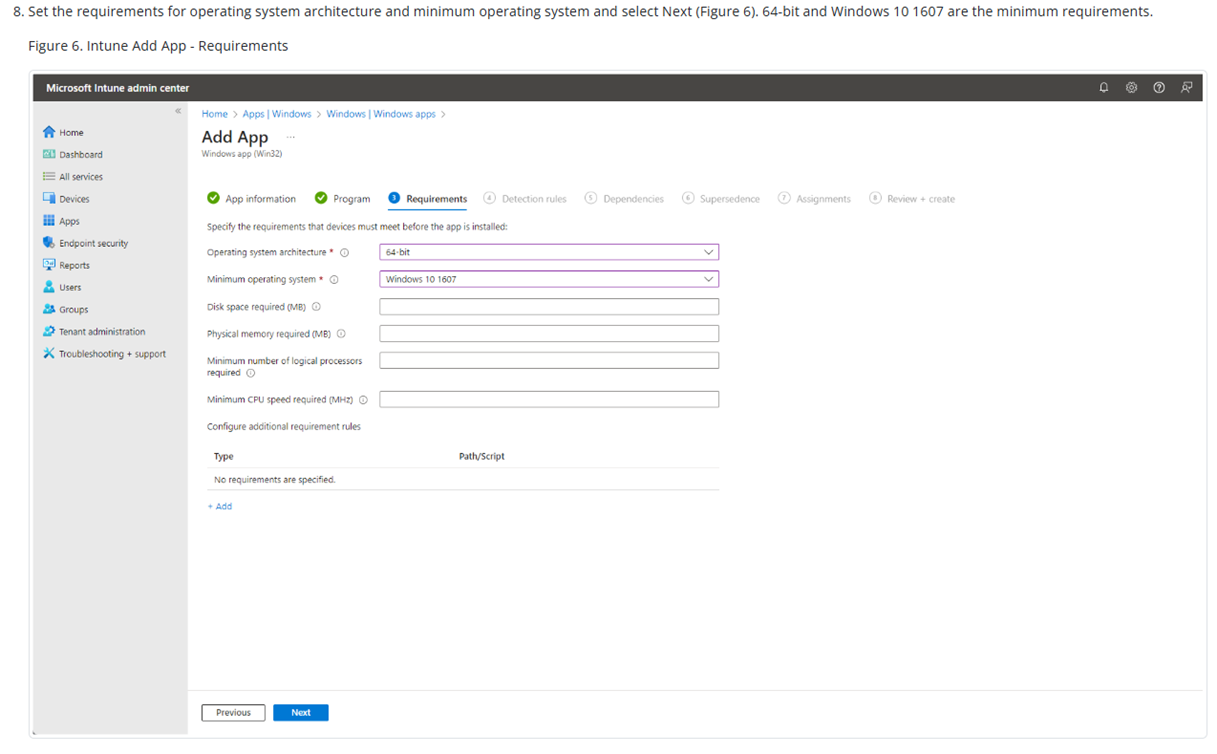


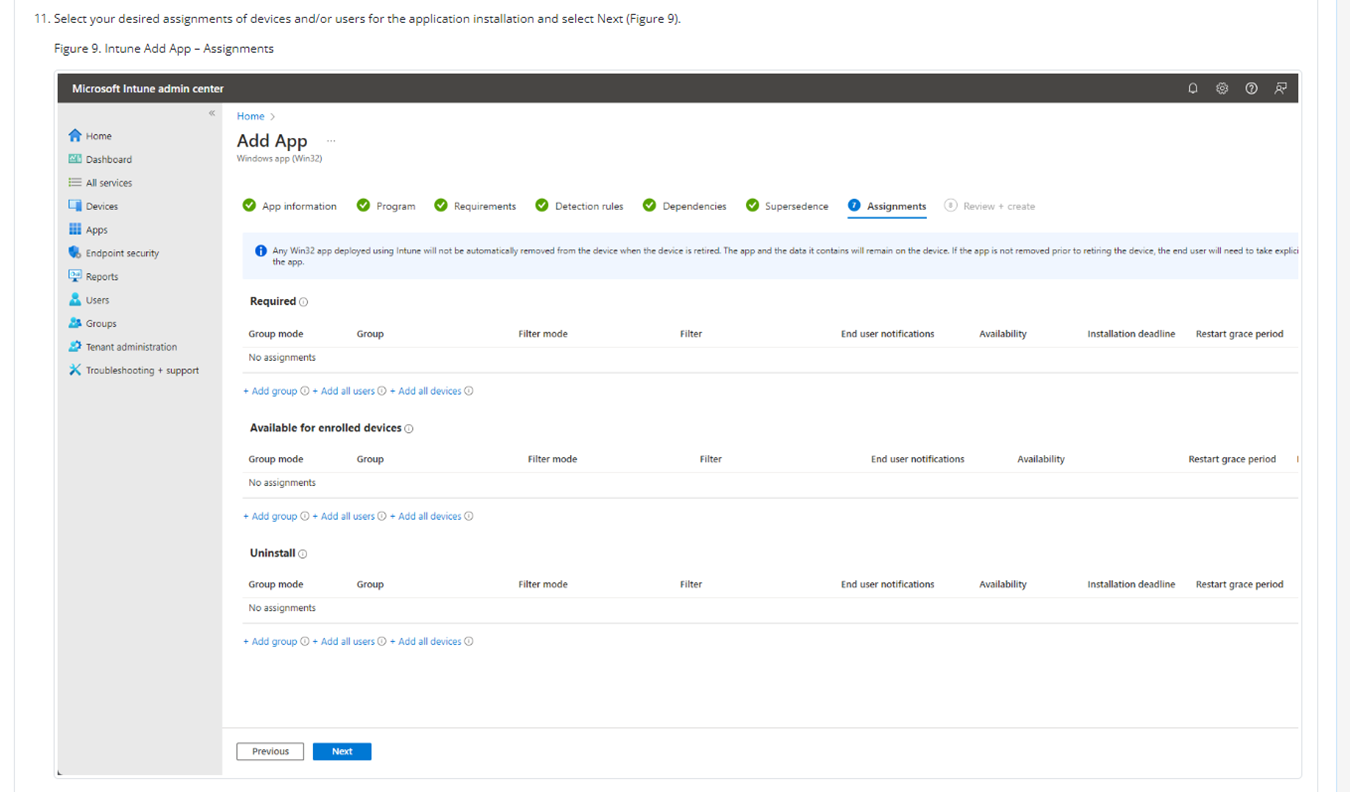
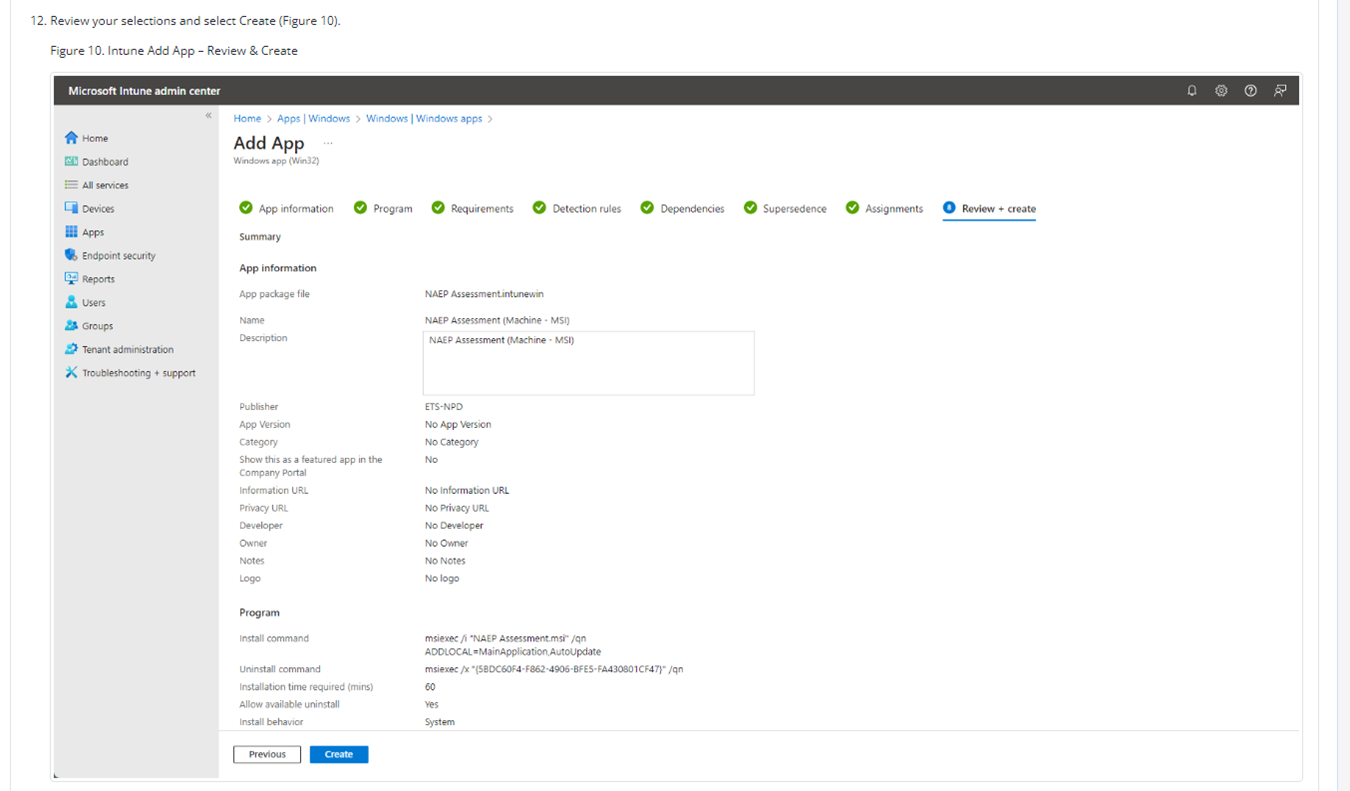
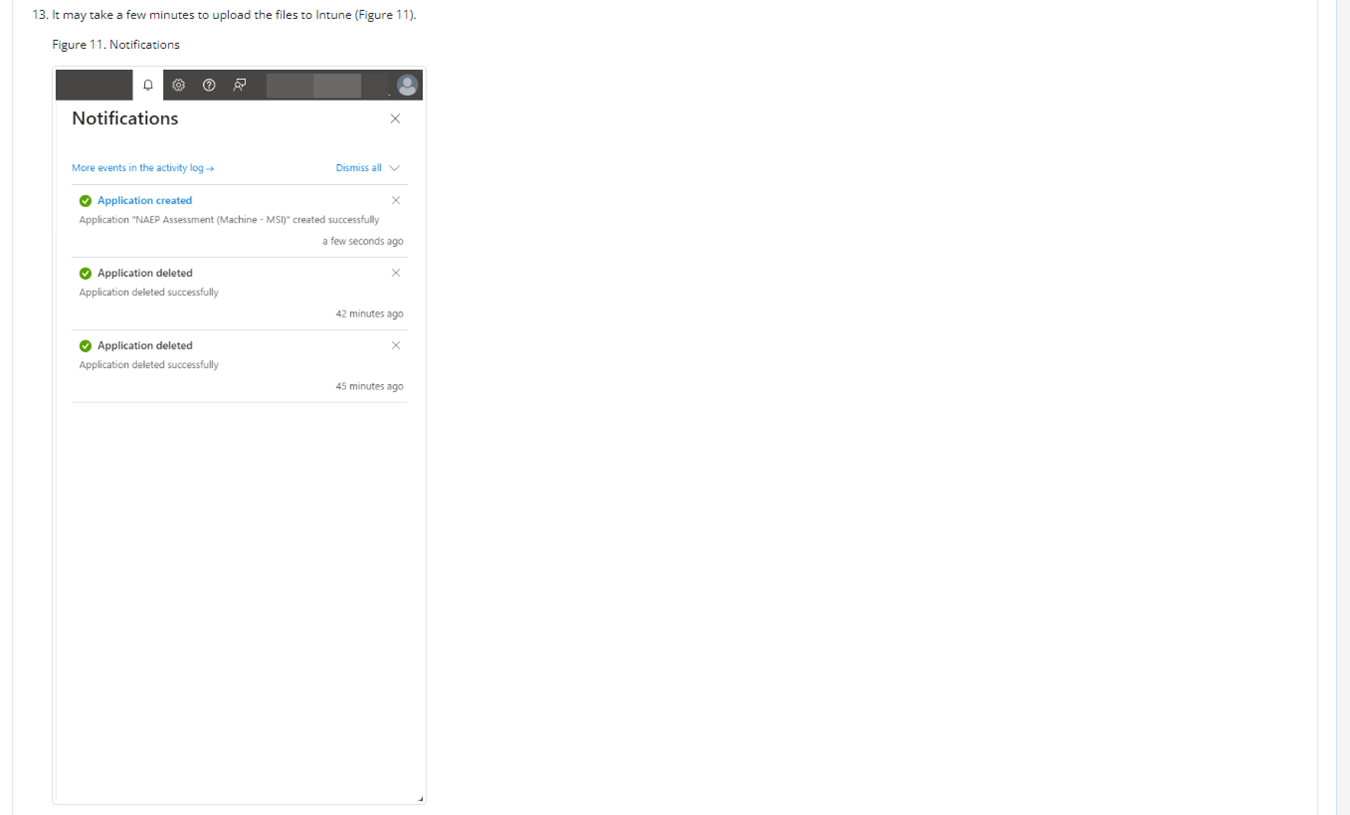
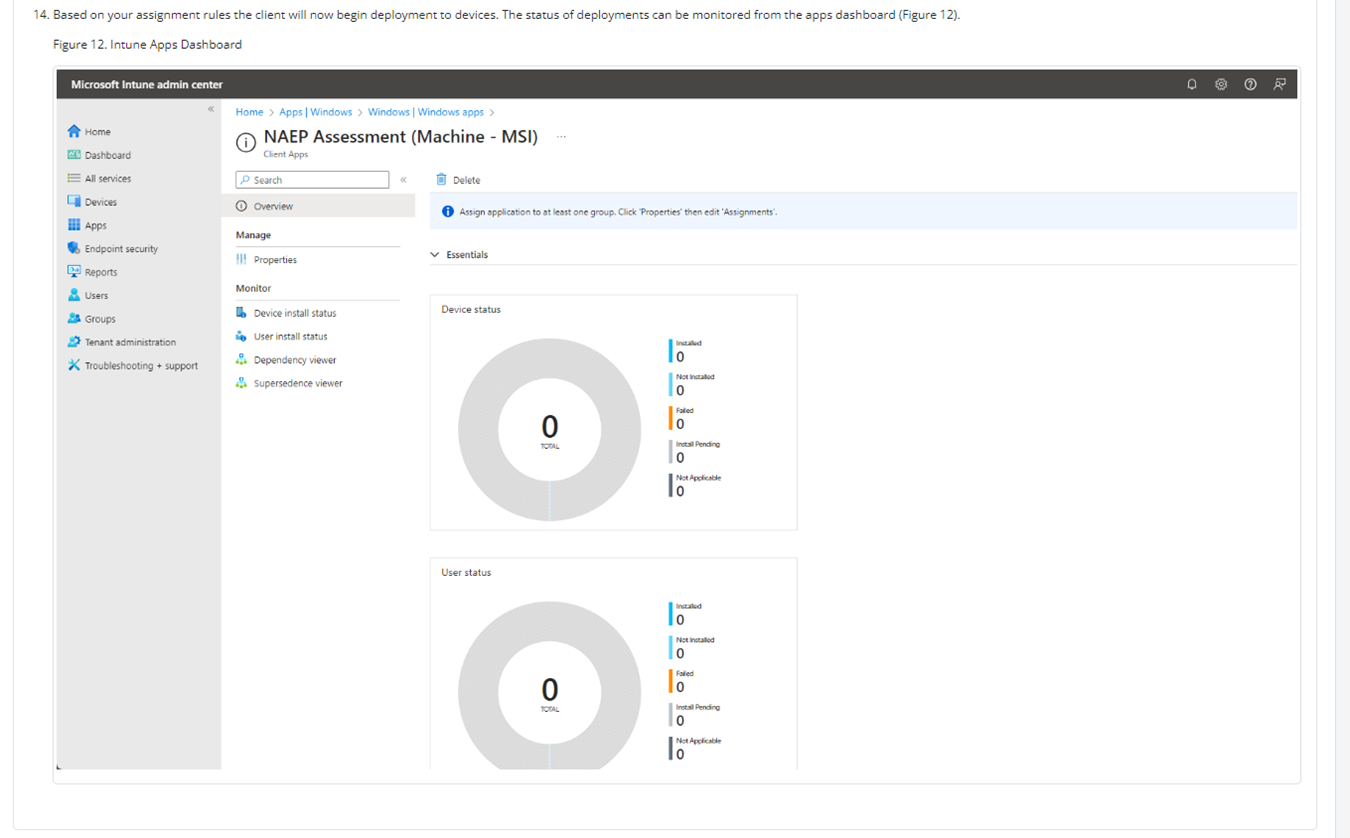
NAEP App Installation Instructions > Windows > At Scale Installation Instructions > Distributing and Installing the NAEP App via the Command Line
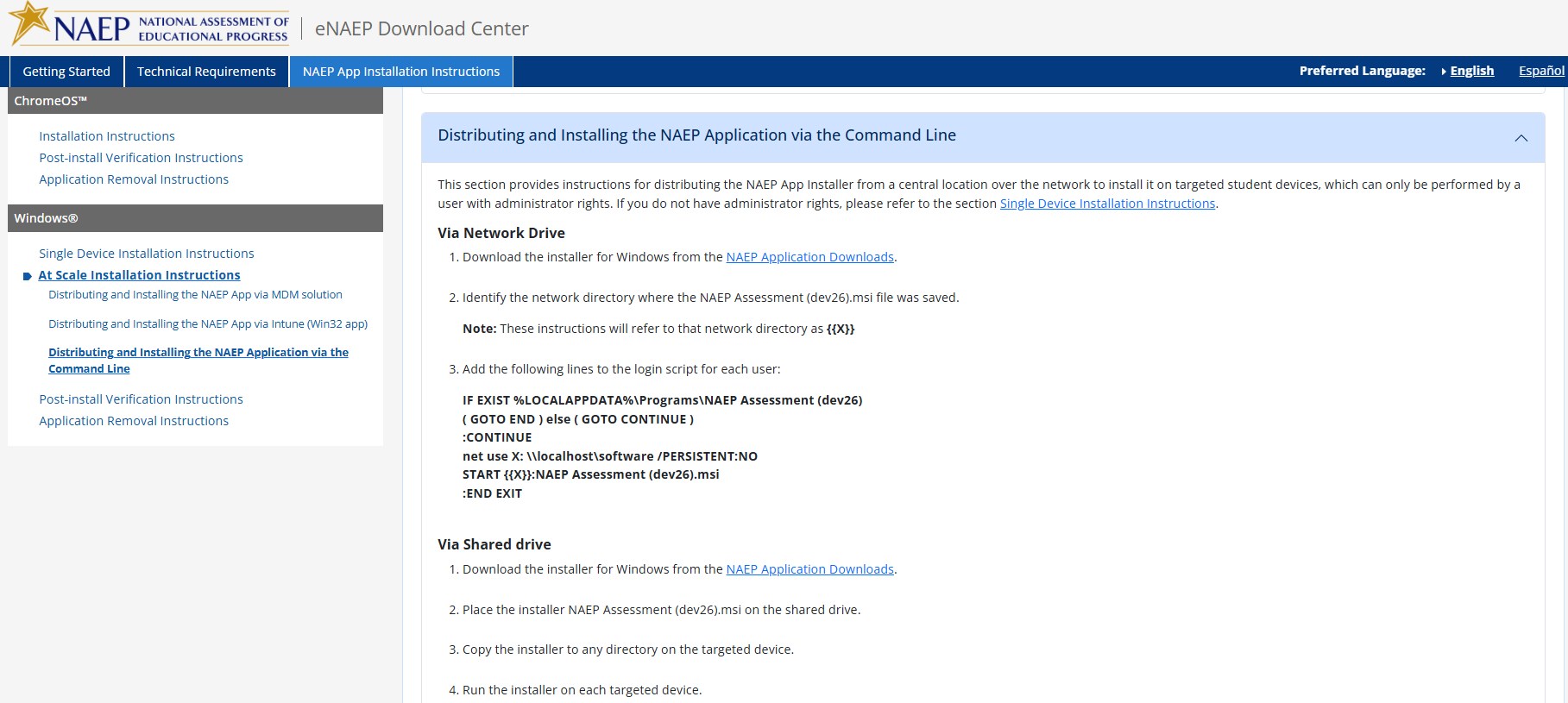
NAEP App Installation Instructions > Windows > Post-Install Verification Instructions
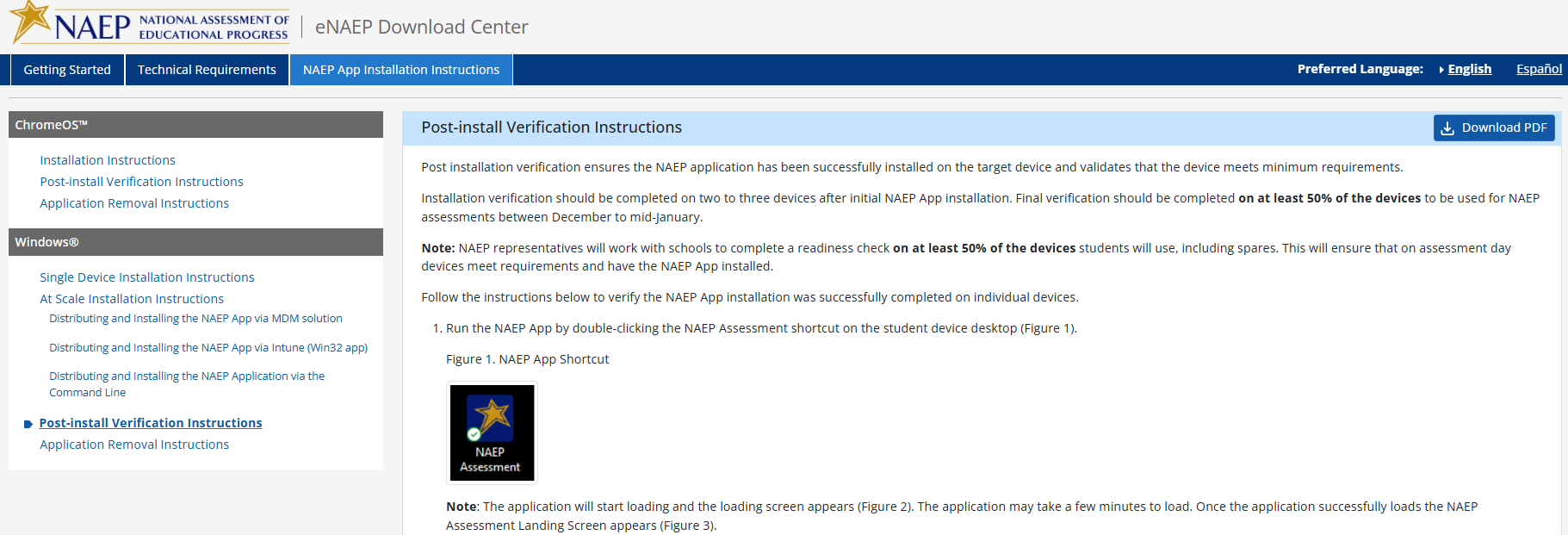

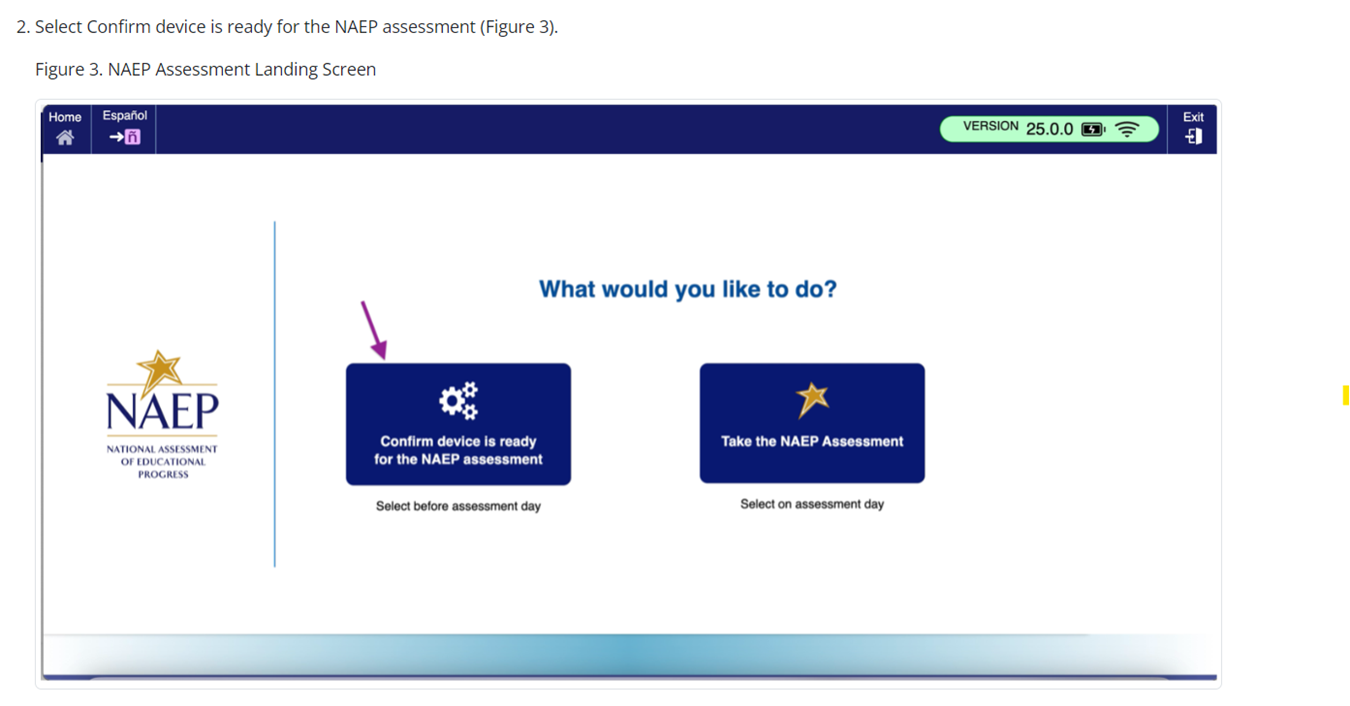
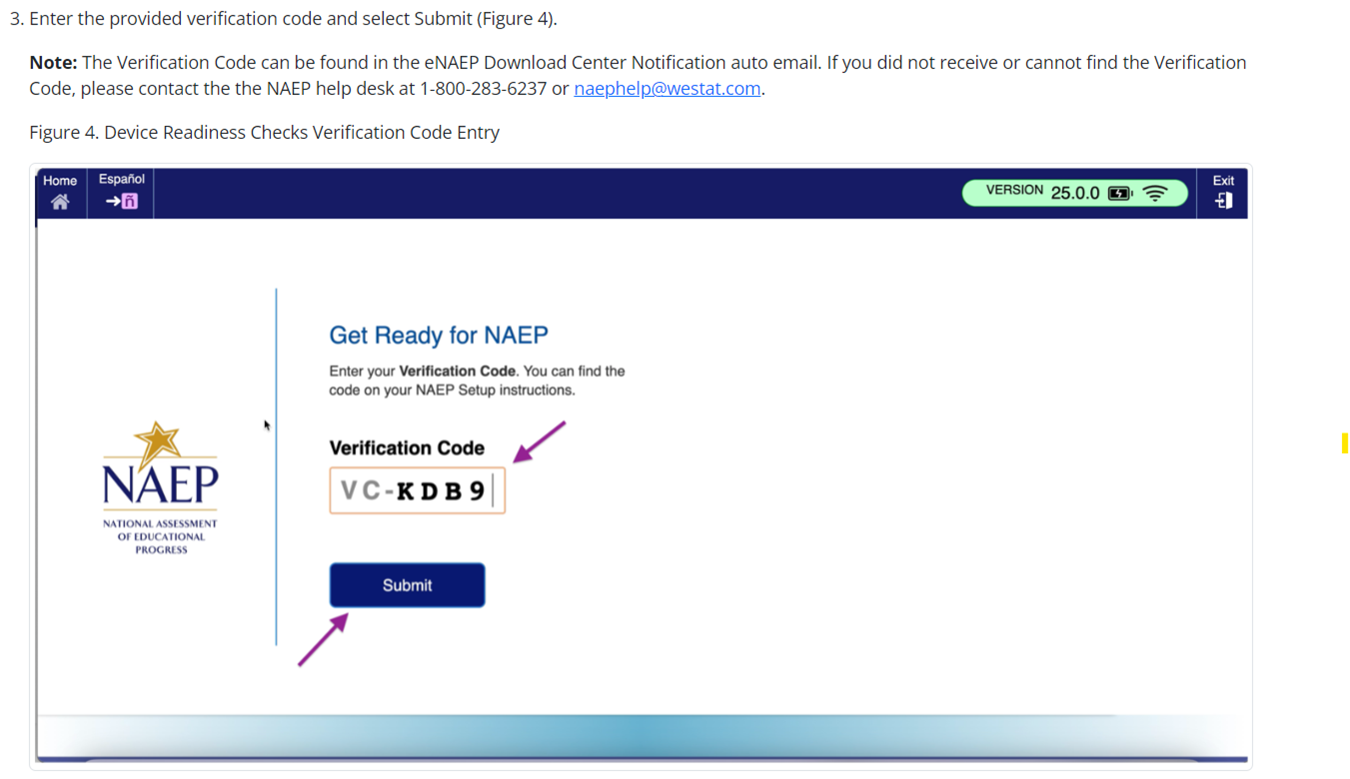

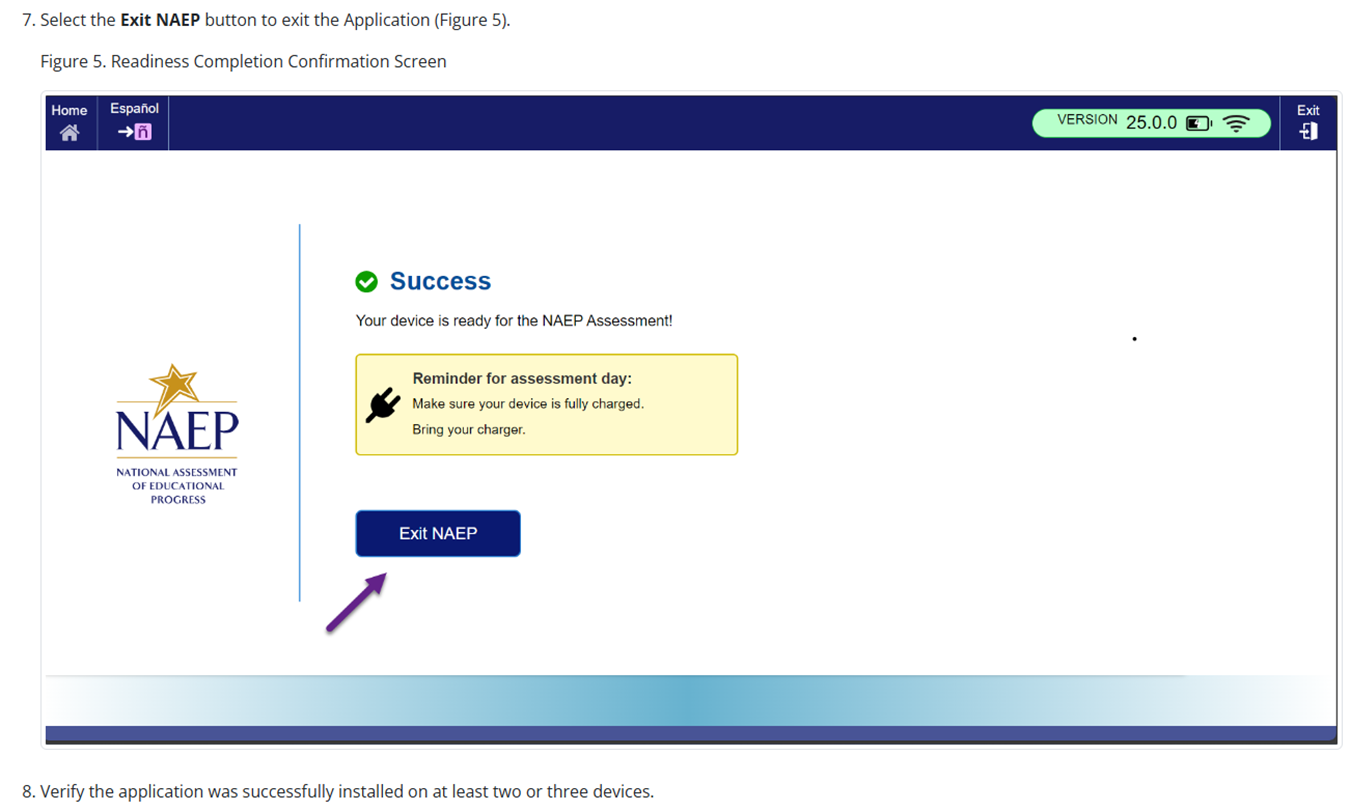
NAEP App Installation Instructions > Windows > Application Removal Instructions
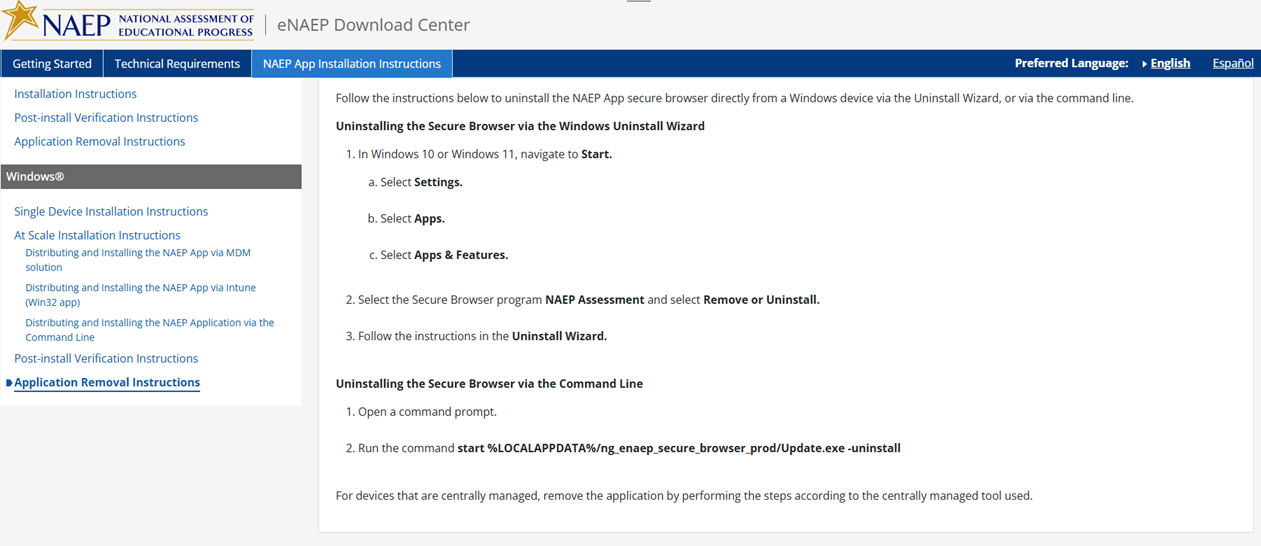
Appendix D-63: NAEP 2026 eNAEP Download Center, Spanish (Revised)
Inicio > Preparación para la evaluación > Herramientas de preevaluación
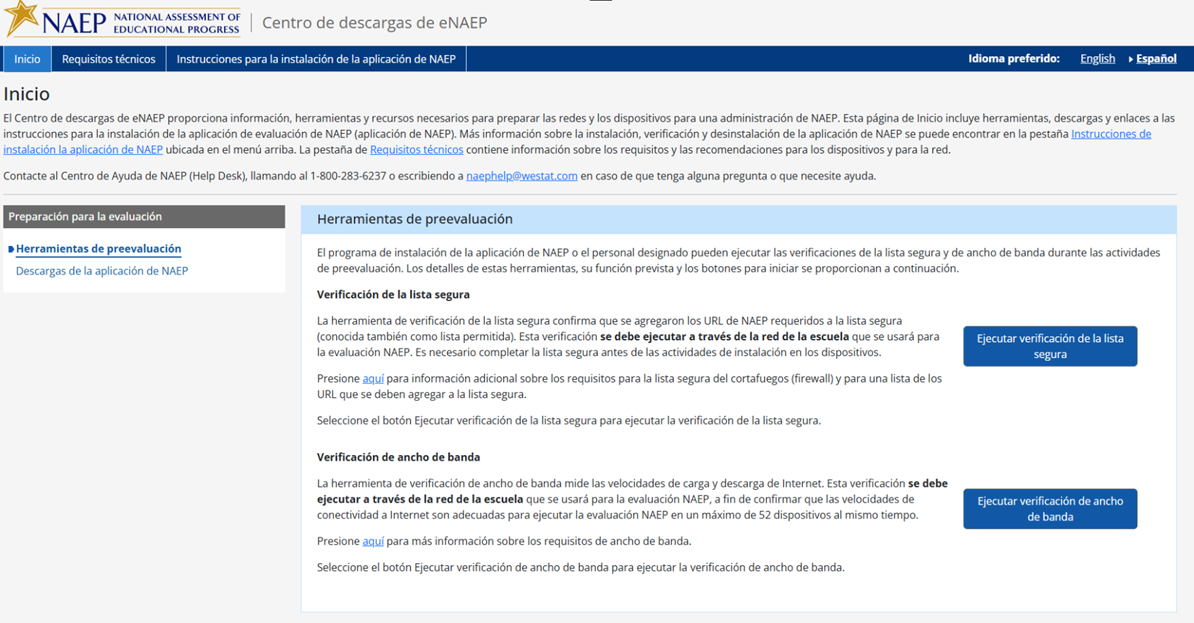
Inicio > Preparación para la evaluación > Descargas de la aplicación de NAEP


Requisitos técnicos > Requisitos del sistema > Requisitos de los sistemas operativos y del equipo
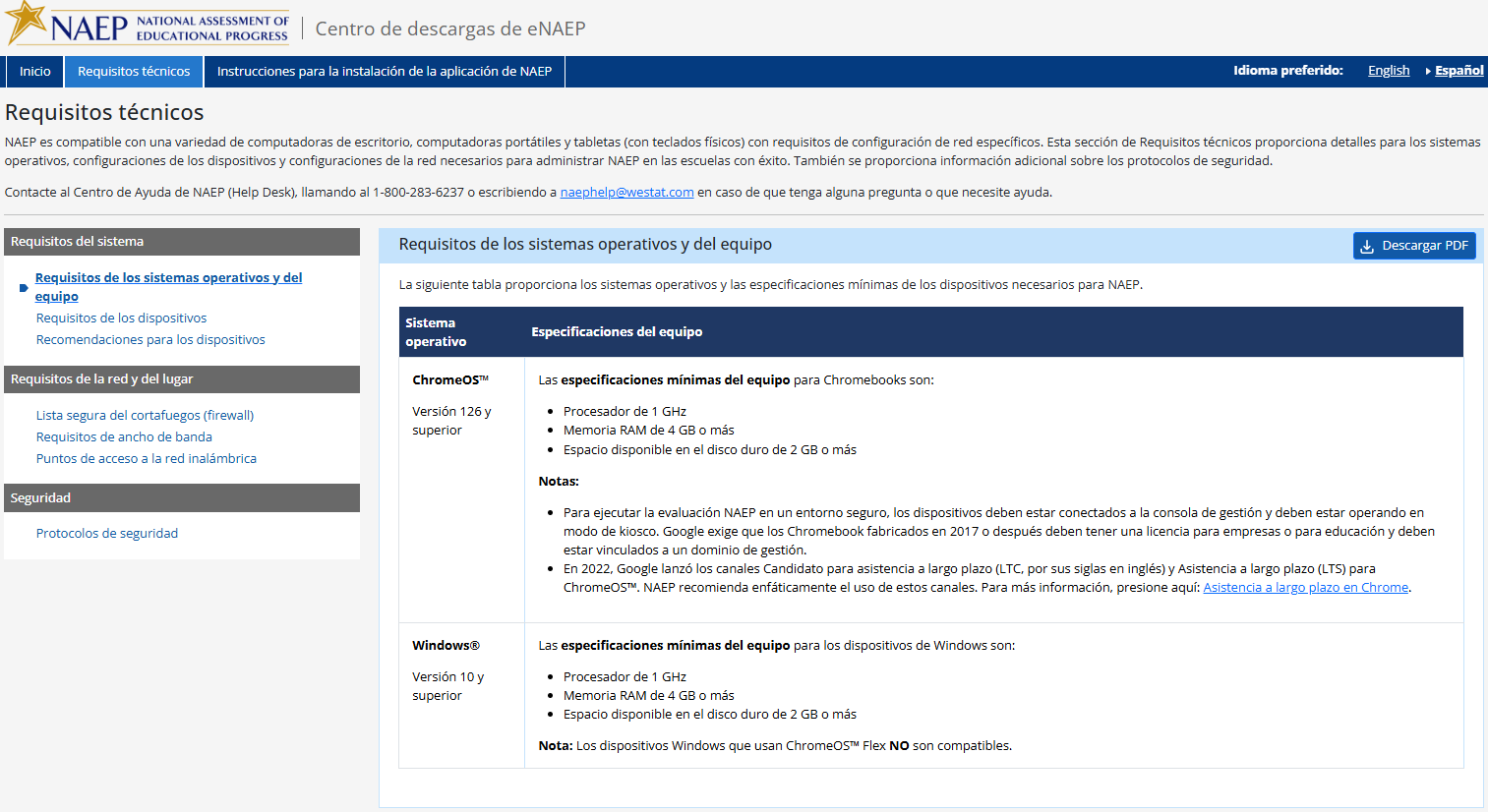
Requisitos
técnicos > Requisitos del sistema >Requisitos de
los dispositivos

Requisitos técnicos > Requisitos del sistema > Recomendaciones para los dispositivos
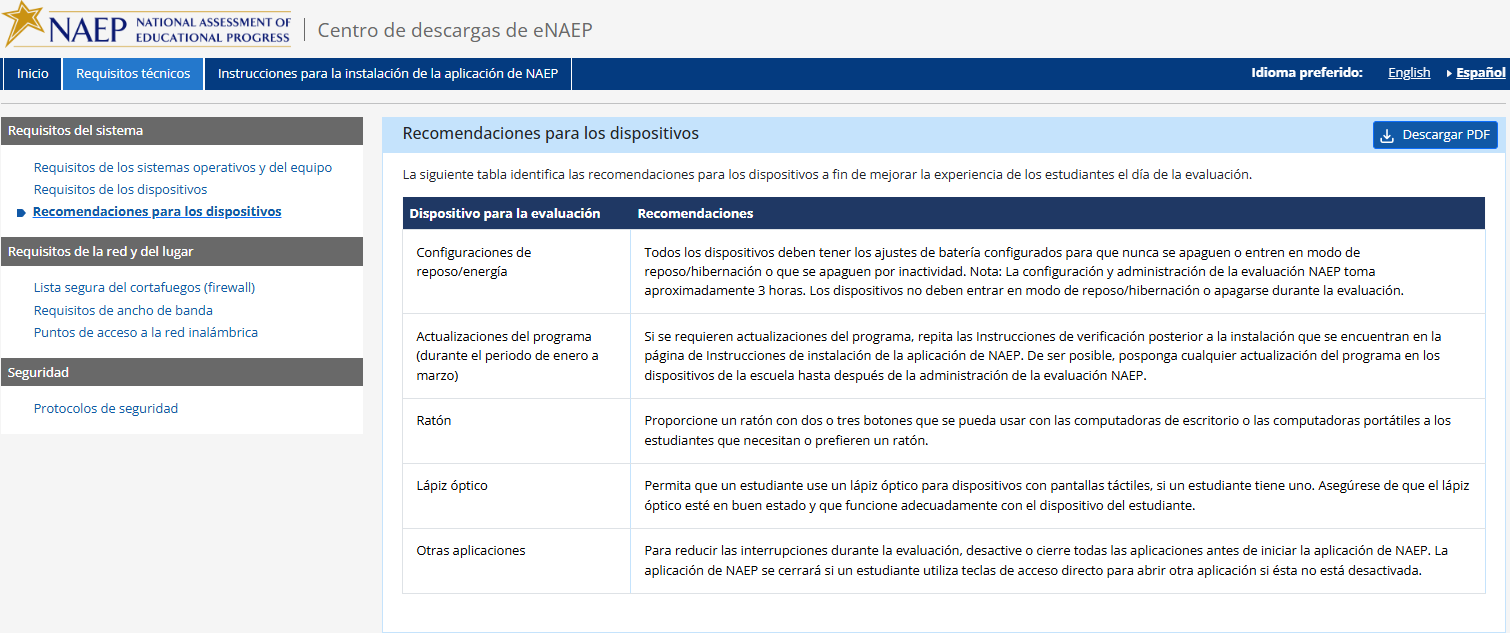
Requisitos técnicos > Requisitos de la red y del lugar >Lista segura del cortafuegos (firewall)
Requisitos técnicos > Requisitos de la red y del lugar > Requisitos de ancho de banda

Requisitos técnicos > Requisitos de la red y del lugar > Puntos de acceso a la red inalámbrica

Requisitos técnicos > Seguridad > Protocolos de seguridad

Instrucciones para la instalación de la aplicación de NAEP > ChromeOS > Instrucciones de instalación


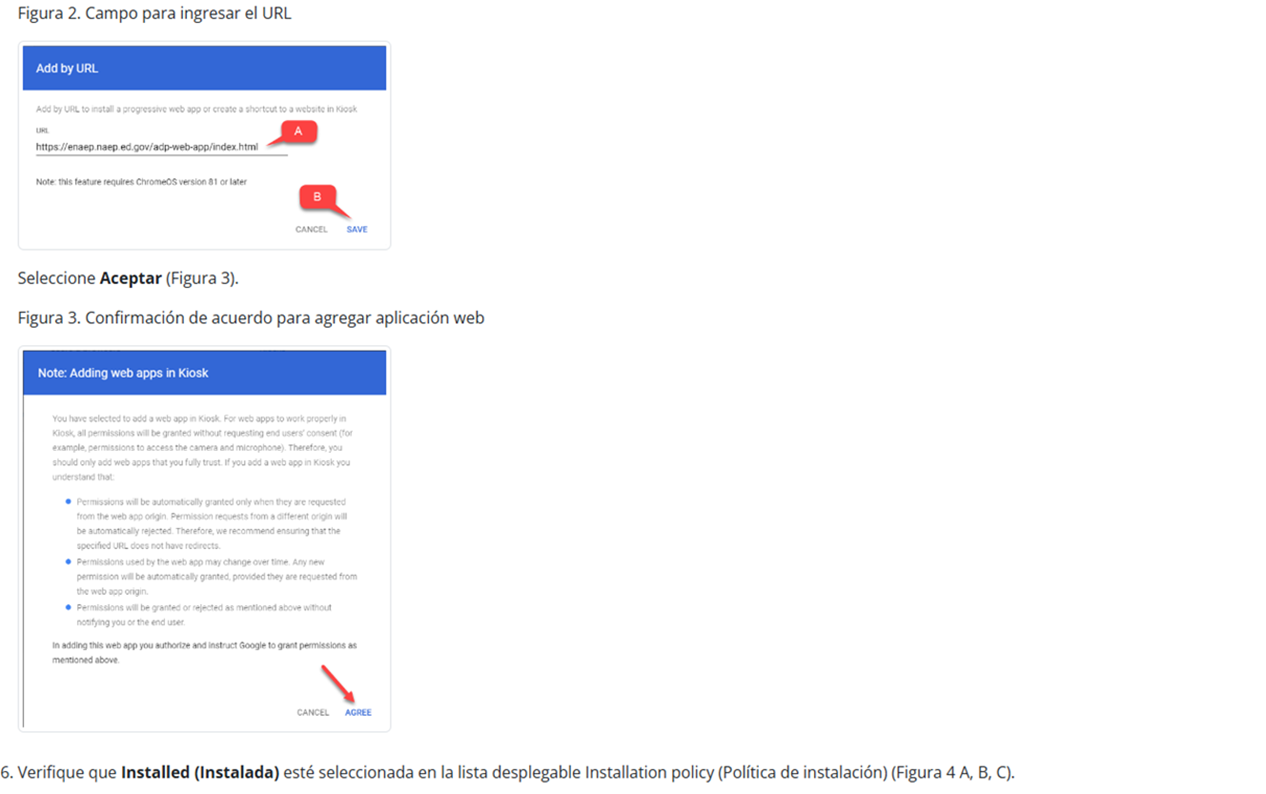

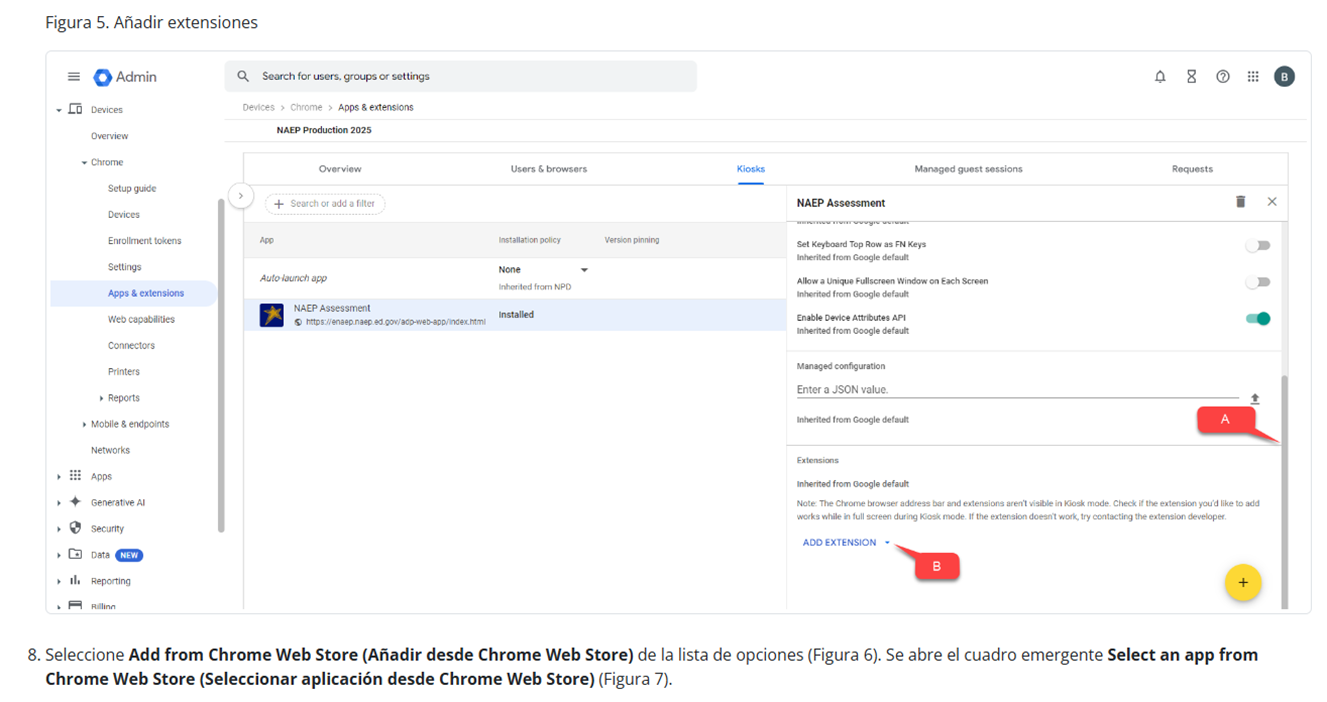
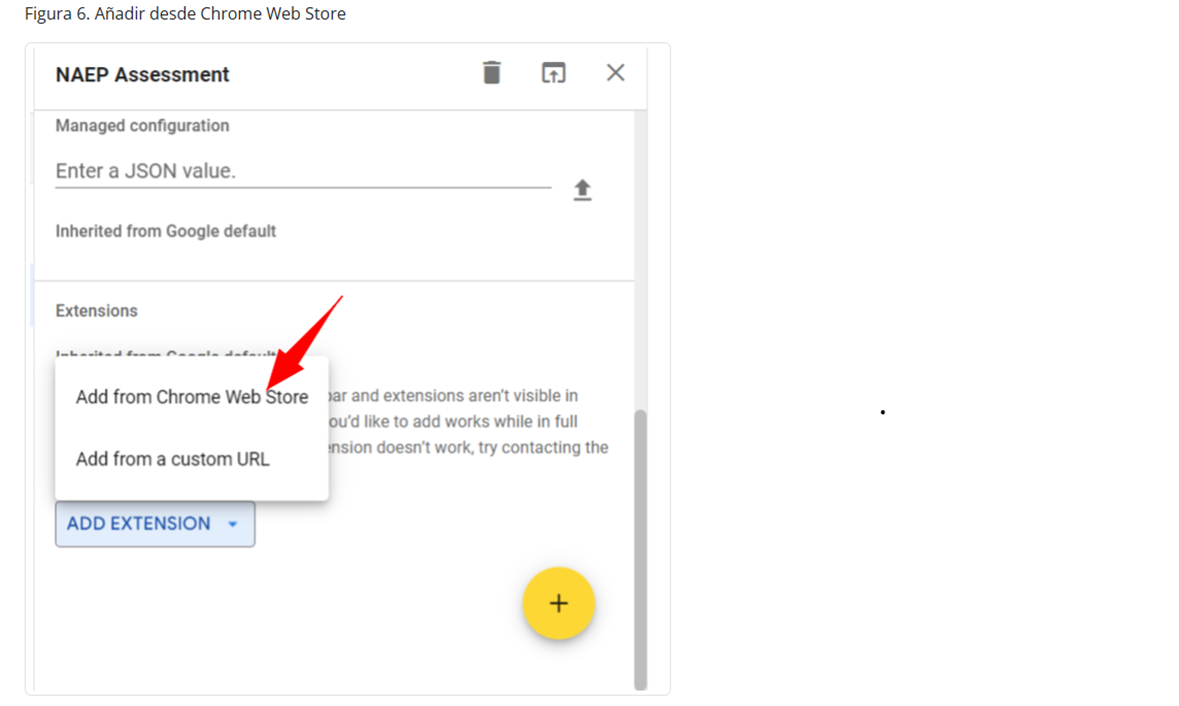
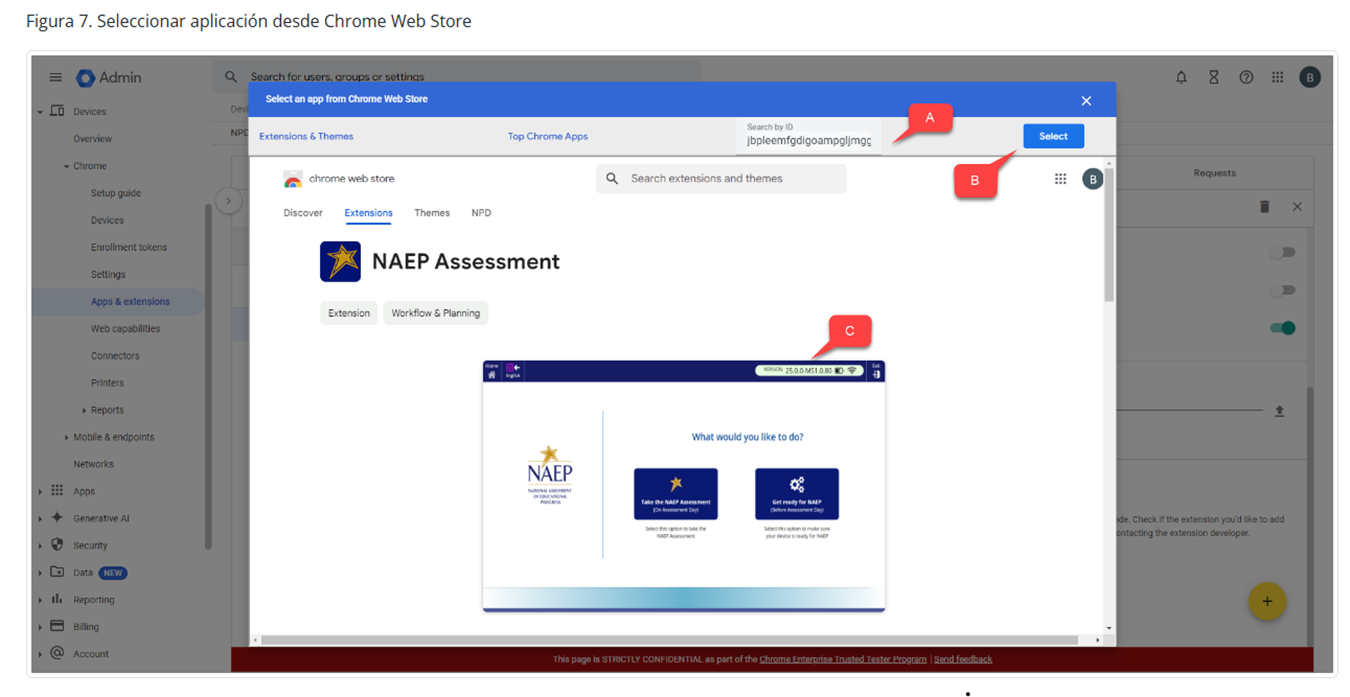
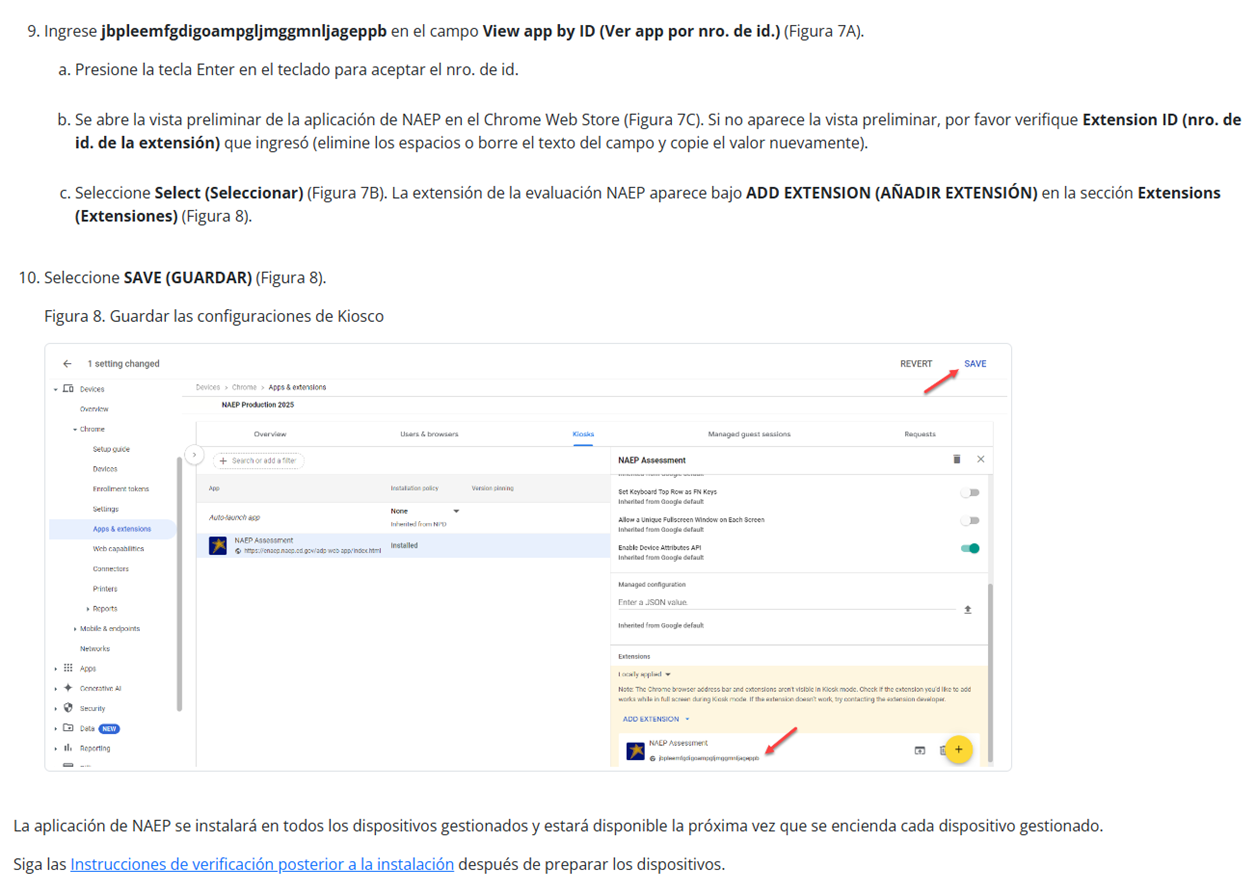
Instrucciones para la instalación de la aplicación de NAEP > ChromeOS > Instrucciones de verificación posterior a la instalación



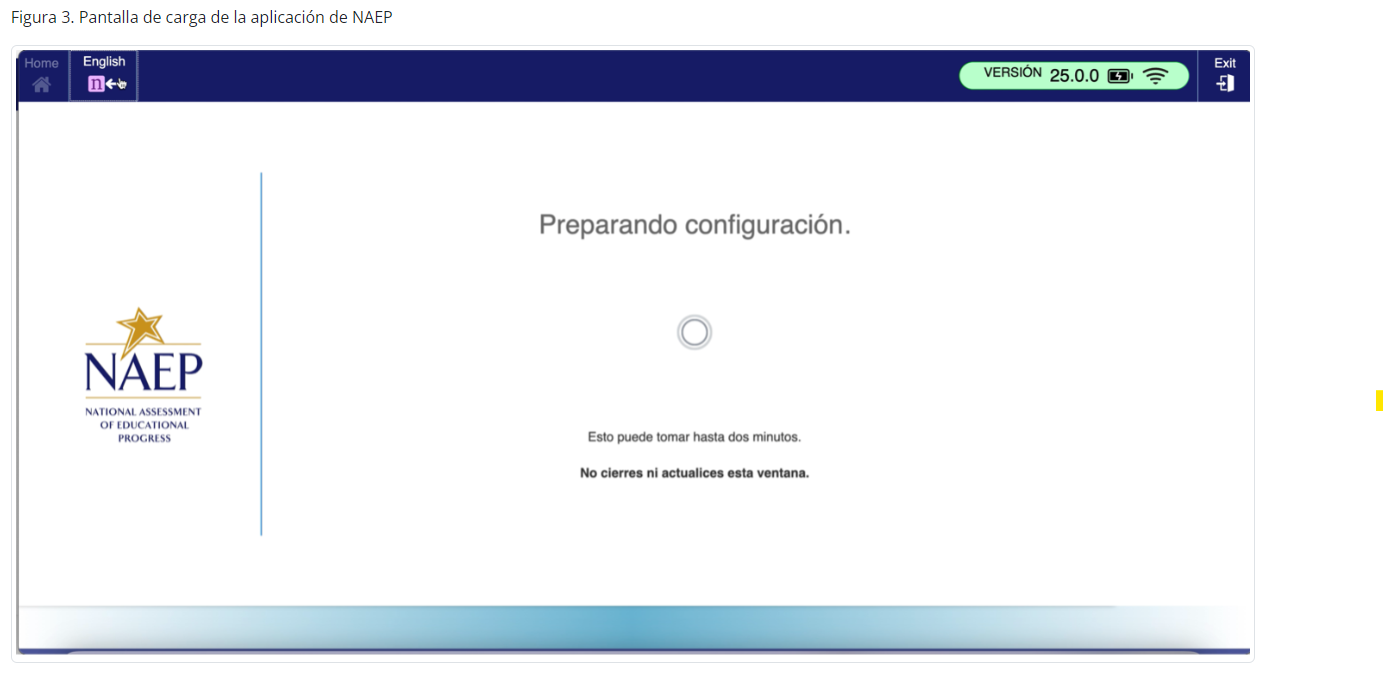
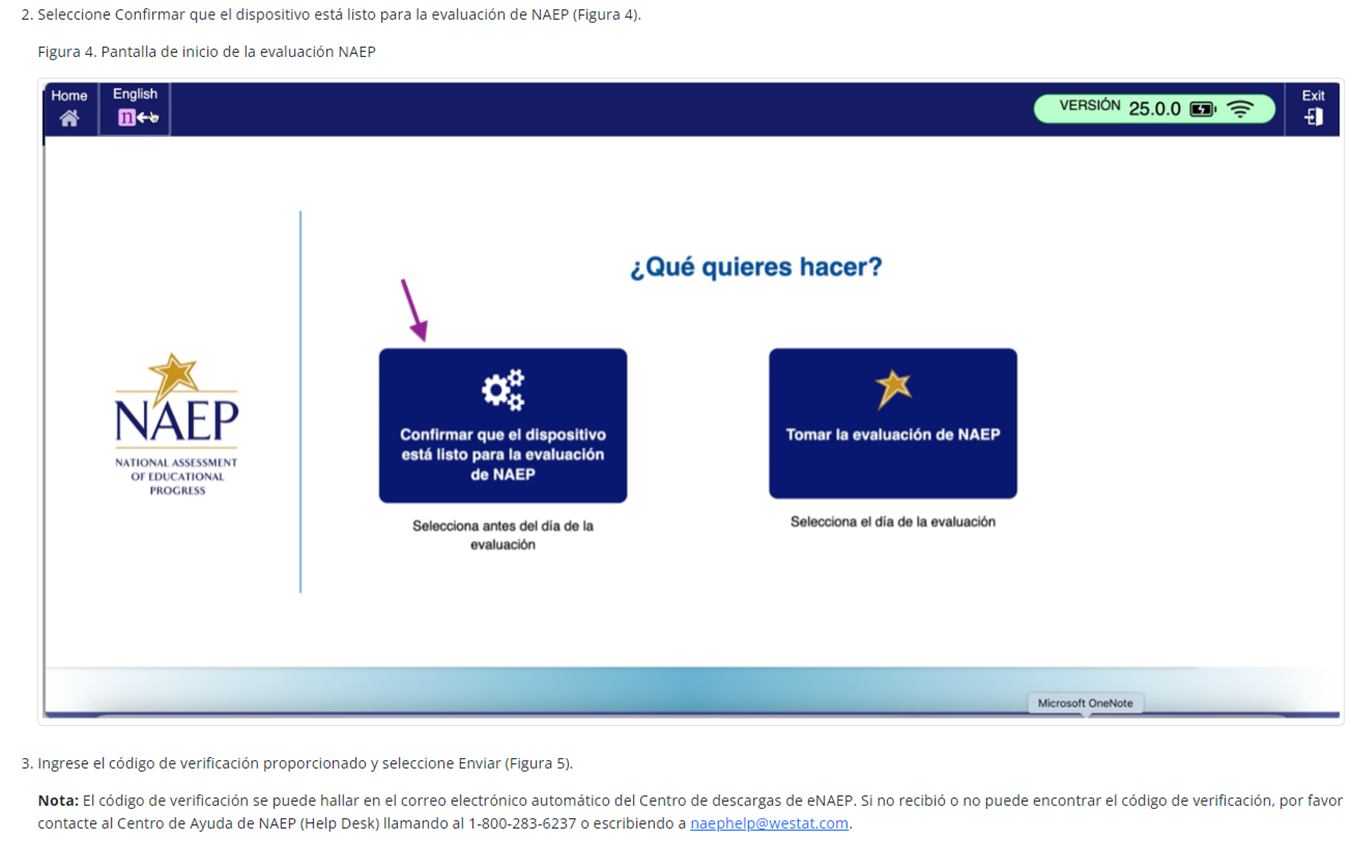
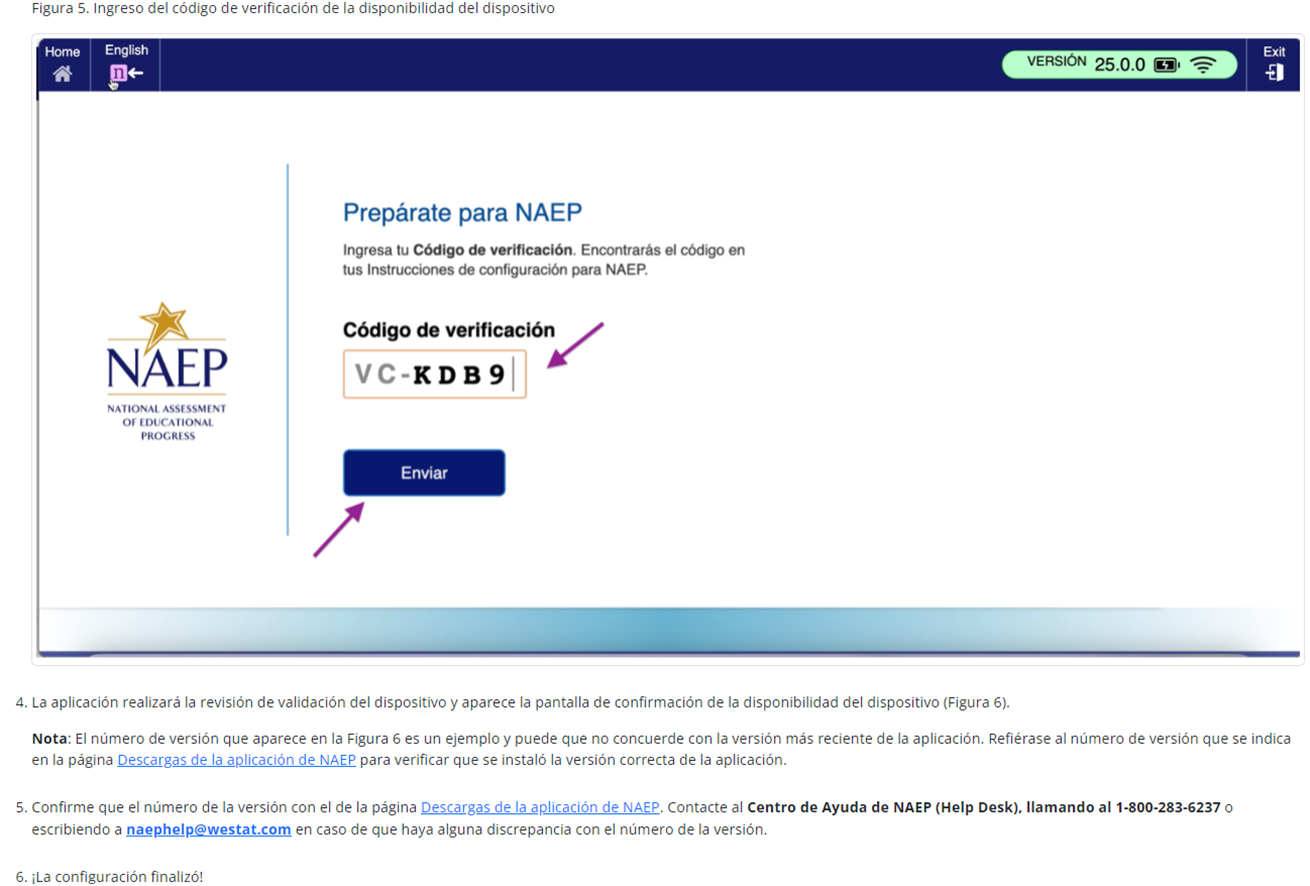
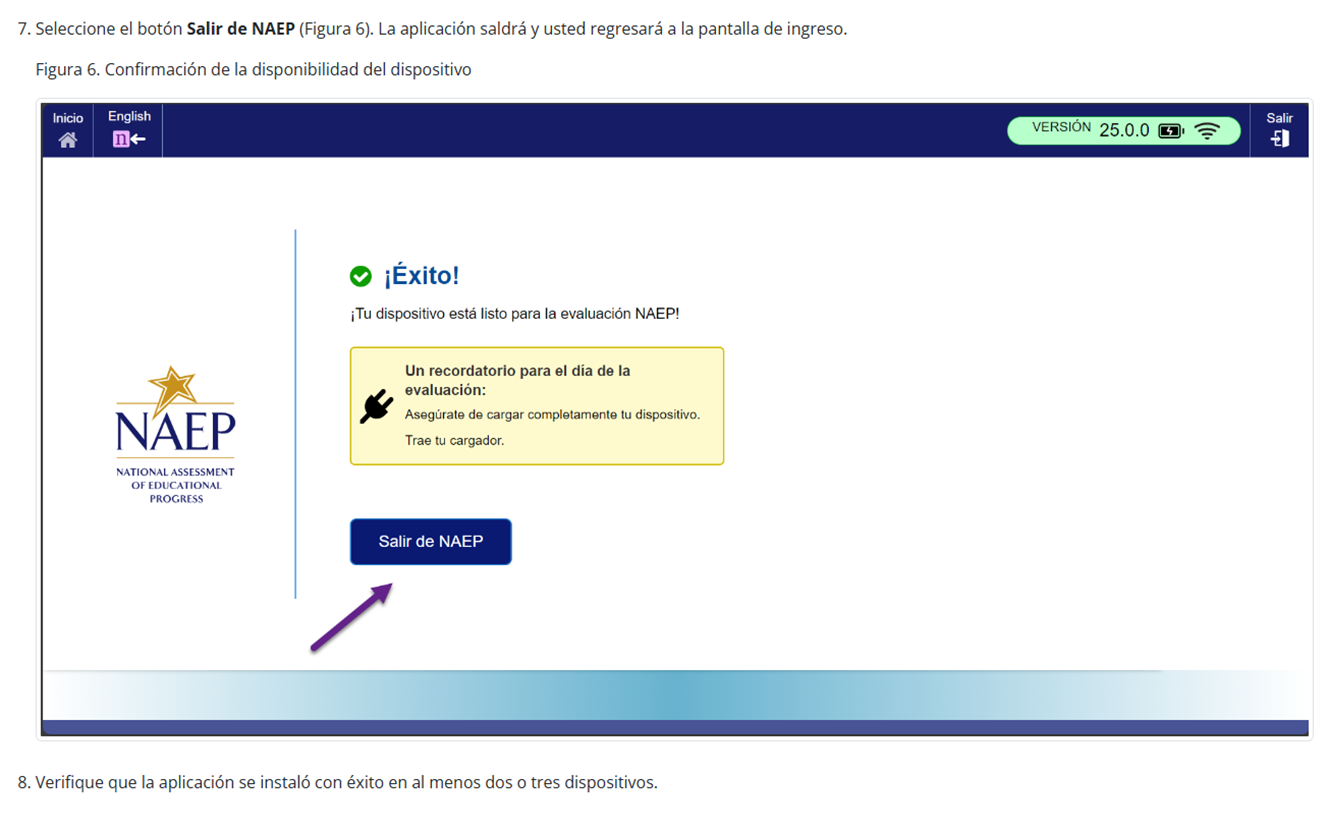
Instrucciones para la instalación de la aplicación de NAEP > ChromeOS > Instrucciones para desinstalar la aplicación de NAEP

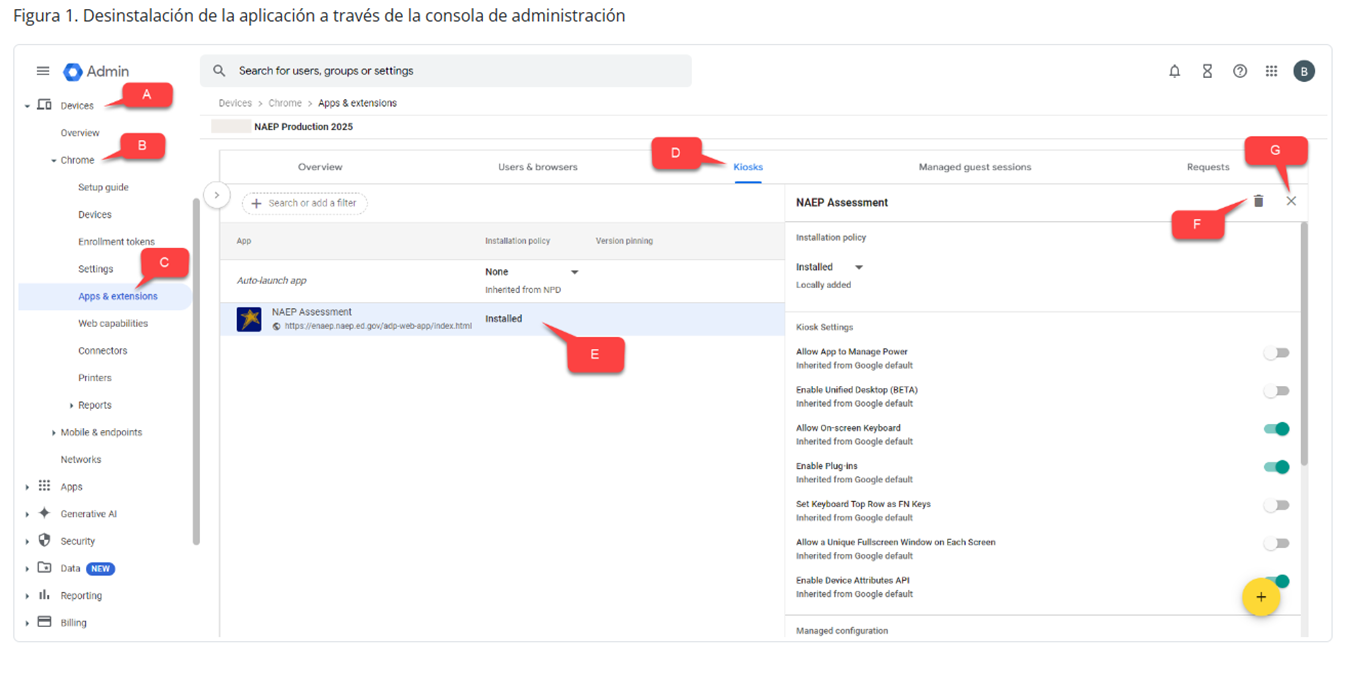
Instrucciones para la instalación de la aplicación de NAEP > Windows > Instrucciones para la instalación en un solo dispositivo


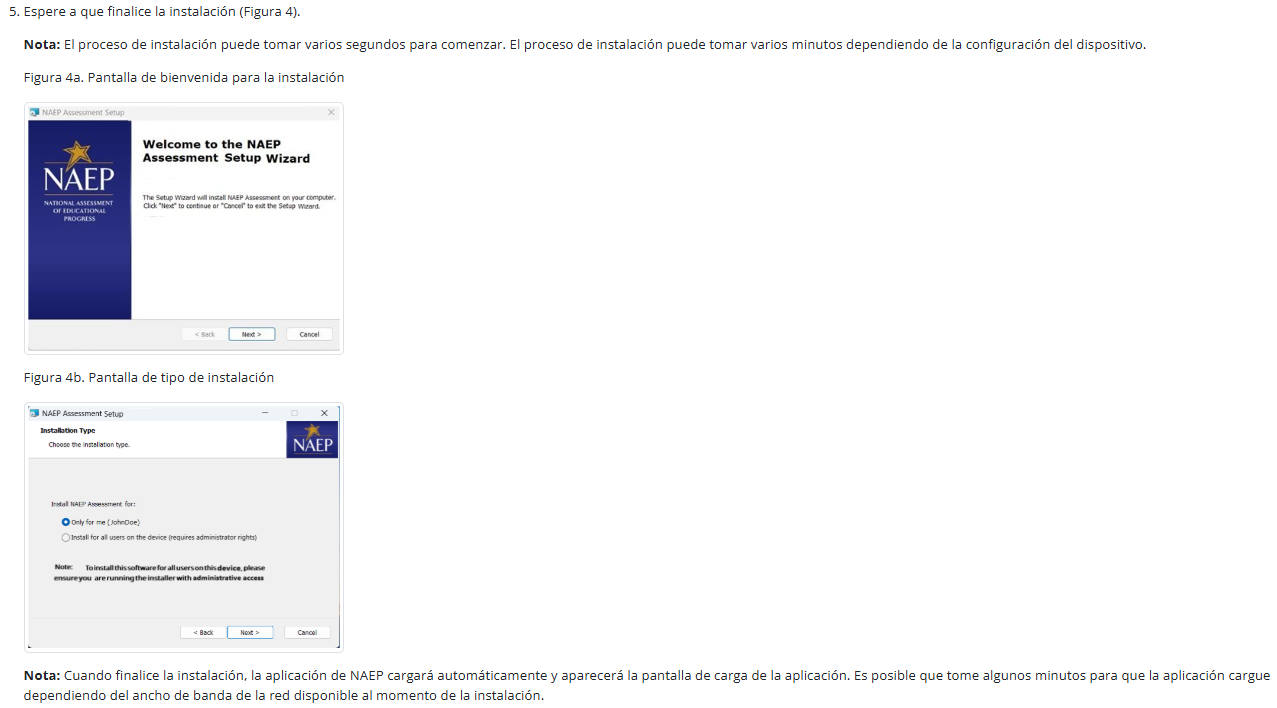
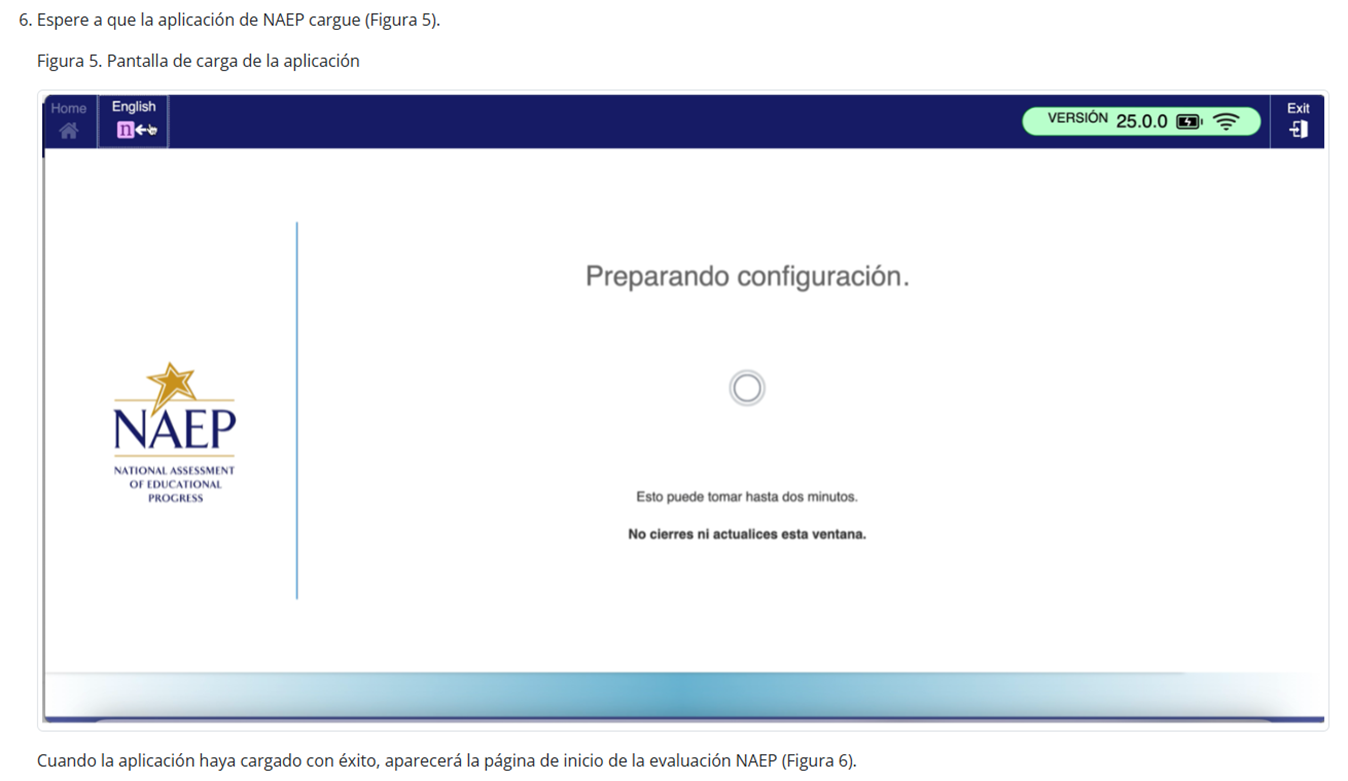
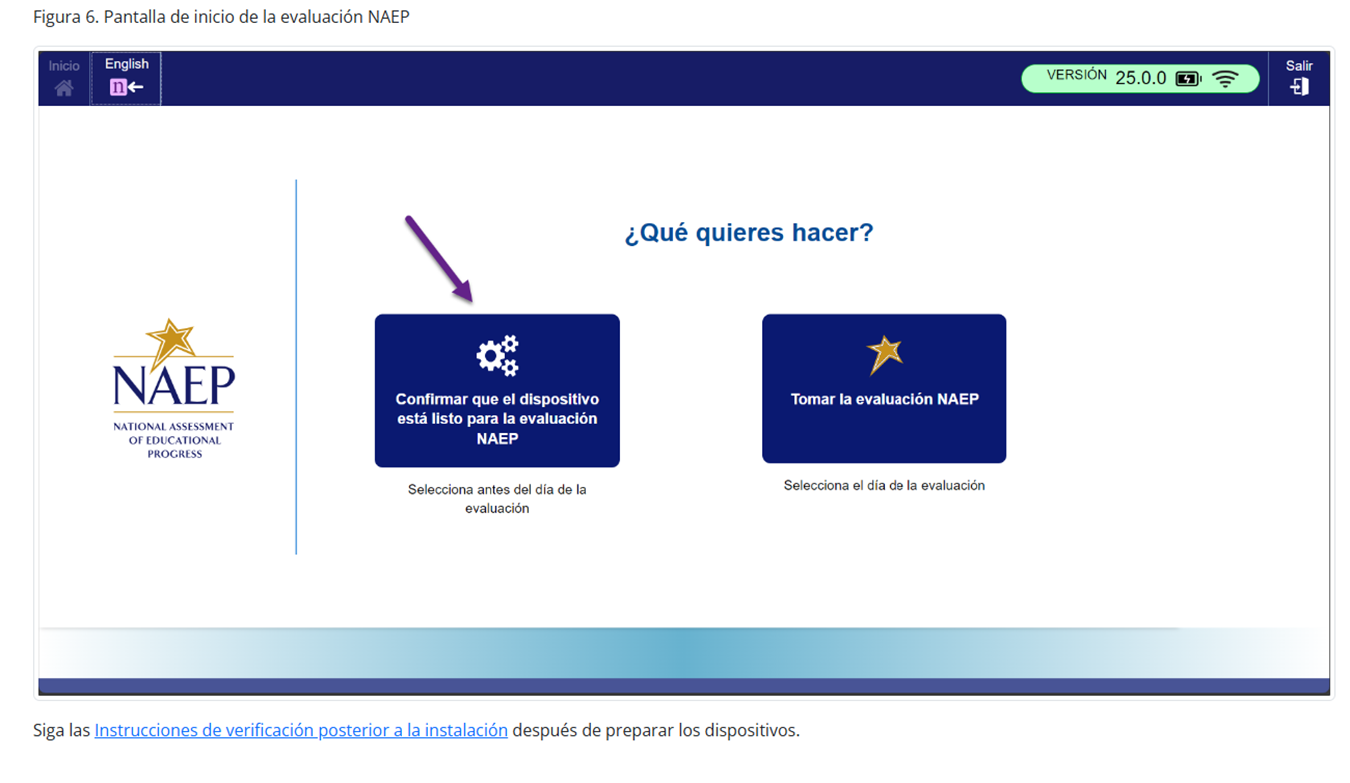
Instrucciones para la instalación de la aplicación de NAEP > Windows > Instrucciones de instalación a gran escala
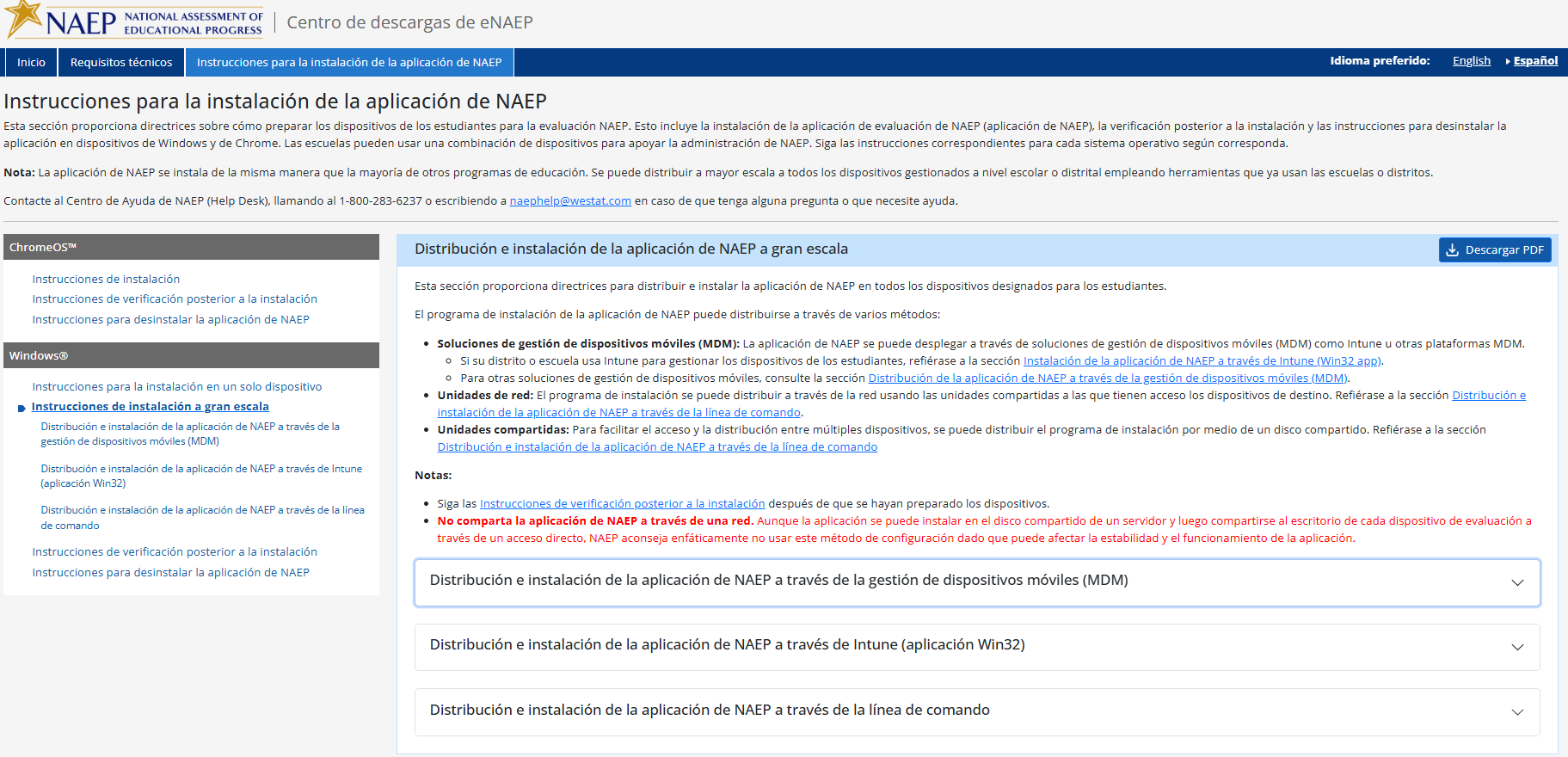
Instrucciones para la instalación de la aplicación de NAEP > Windows > Instrucciones de instalación a gran escala > Distribución e instalación de la aplicación de NAEP a través de la gestión de dispositivos móviles (MDM)

Instrucciones para la instalación de la aplicación de NAEP > Windows > Instrucciones de instalación a gran escala > Distribución e instalación de la aplicación de NAEP a través de Intune (aplicación Win32)
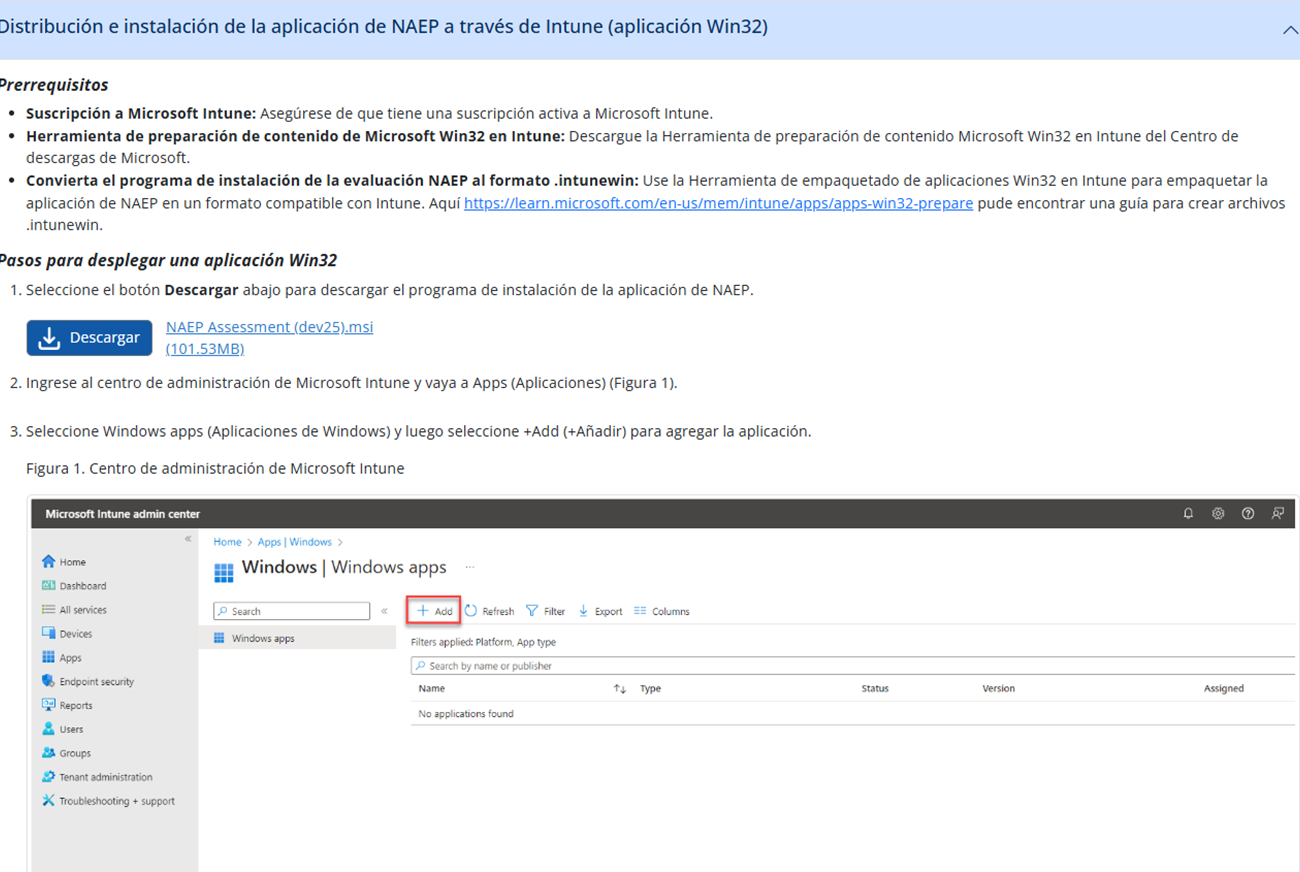
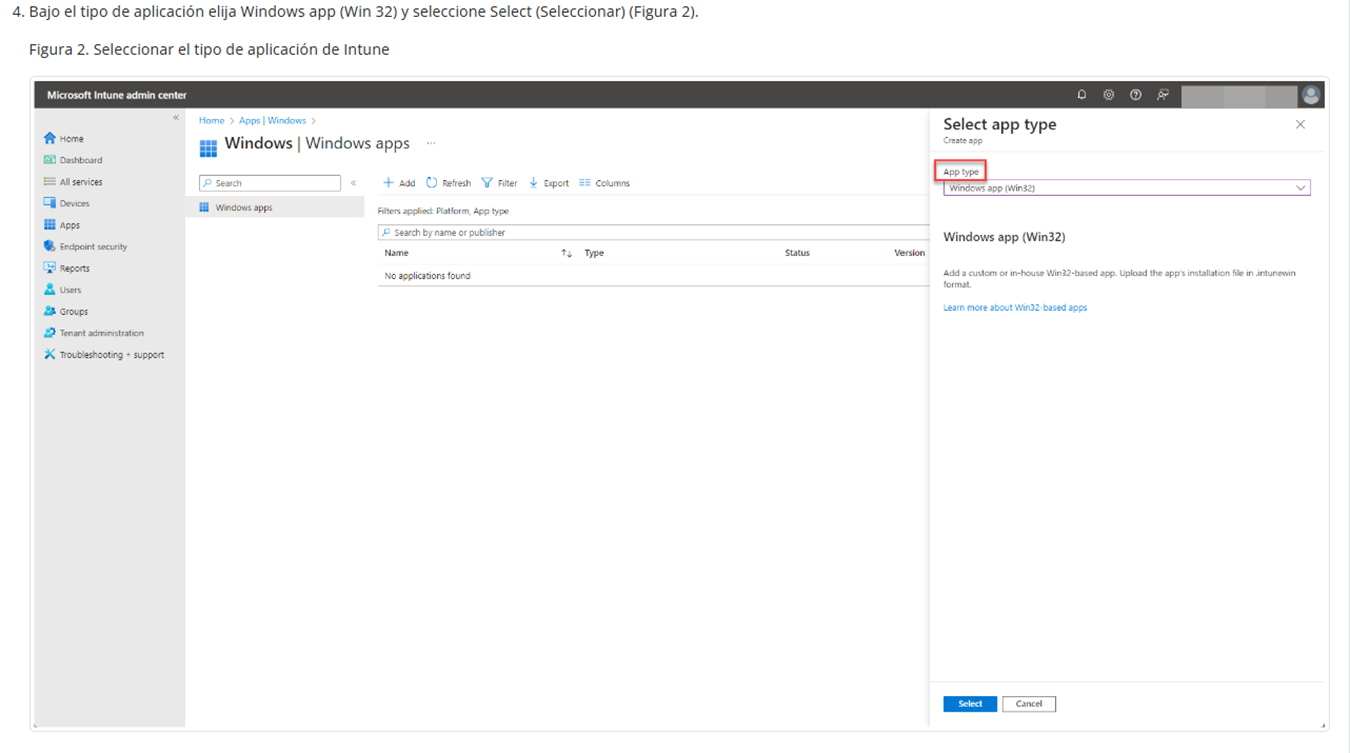


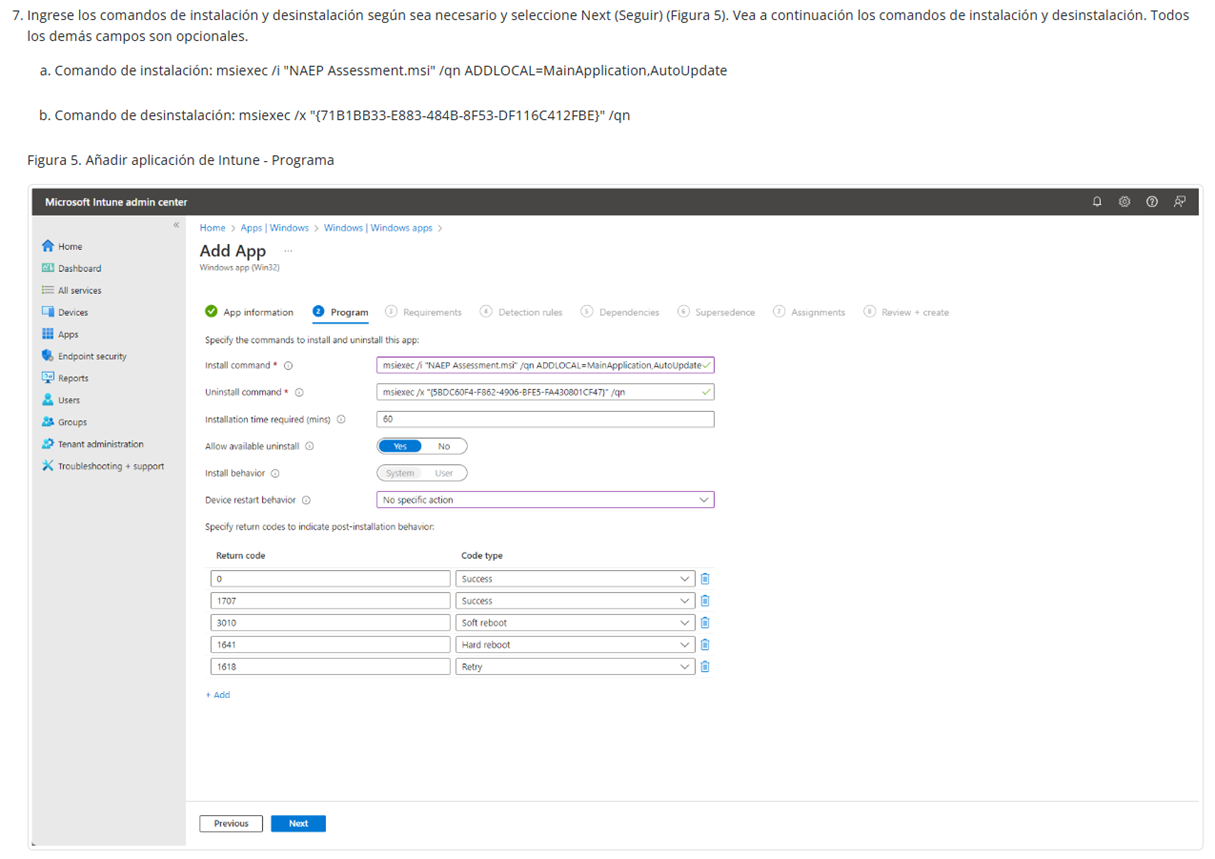
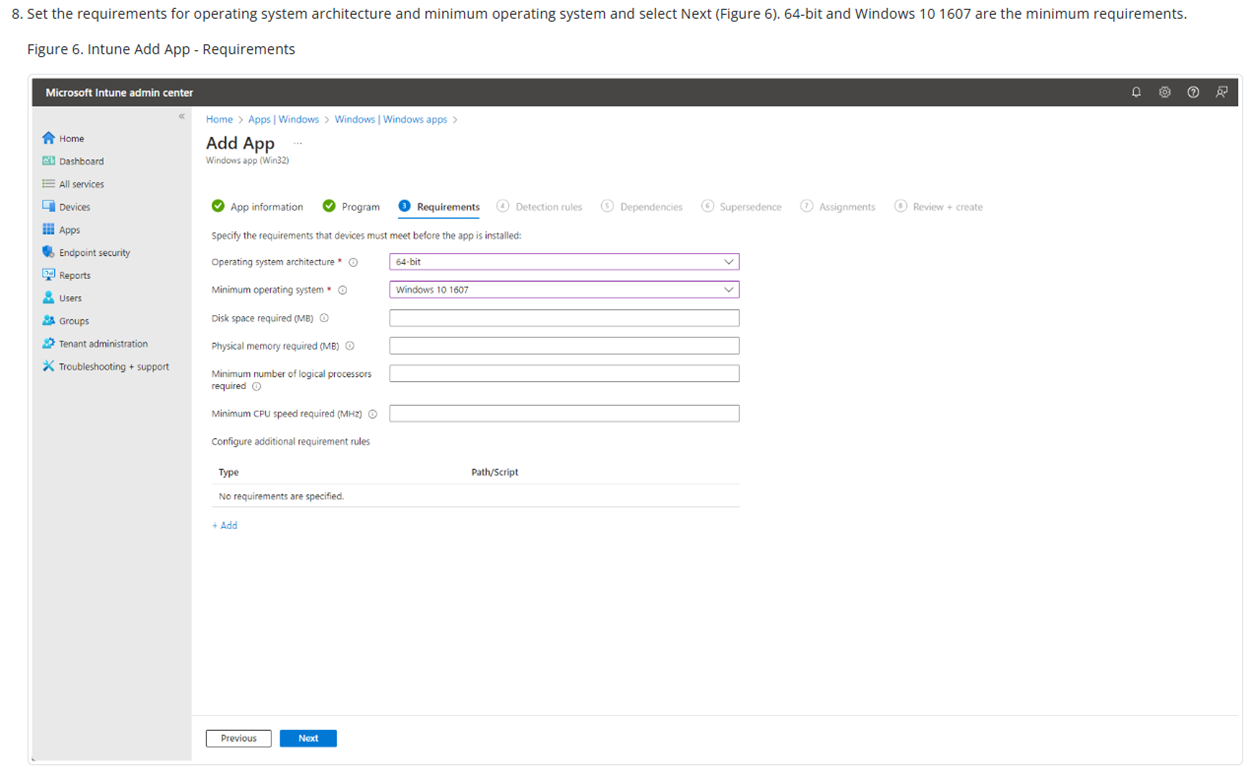
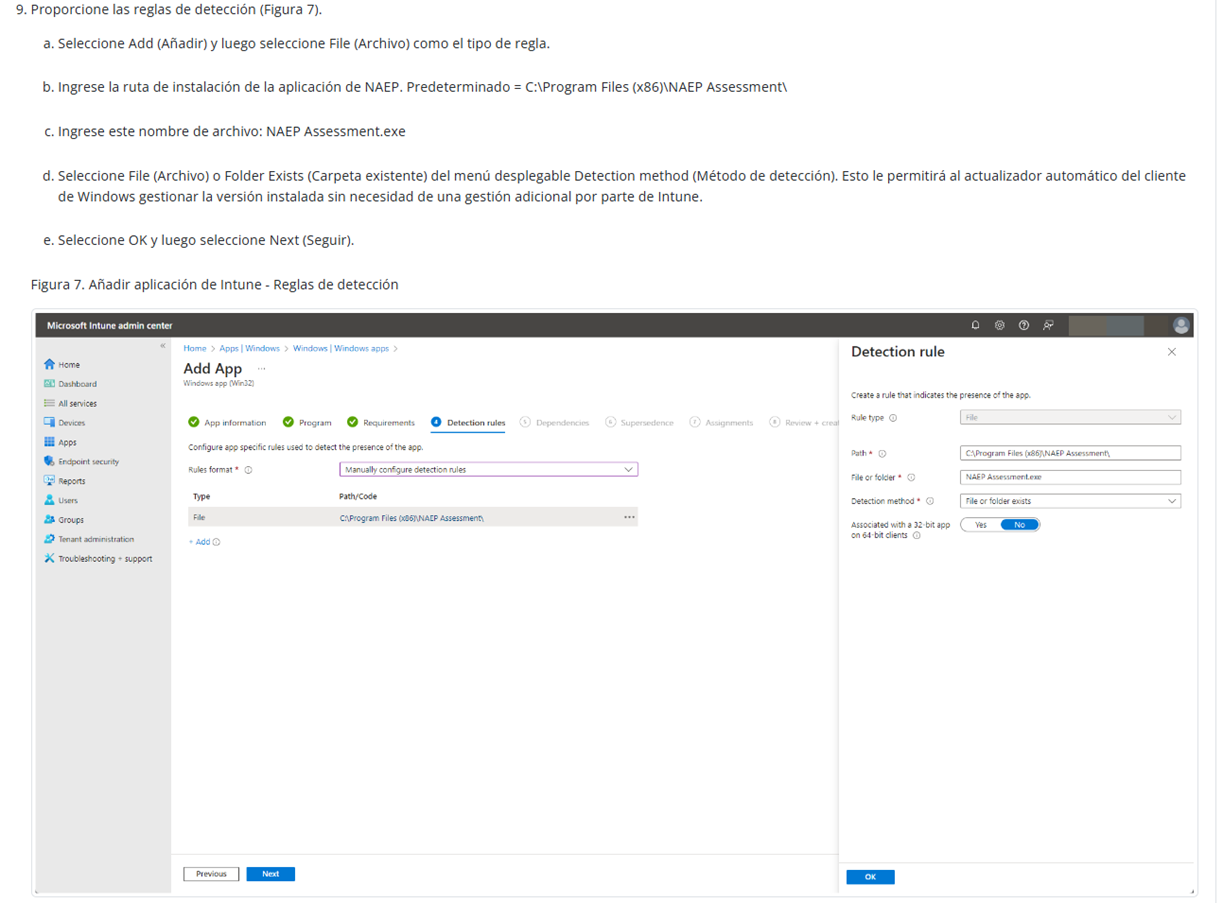
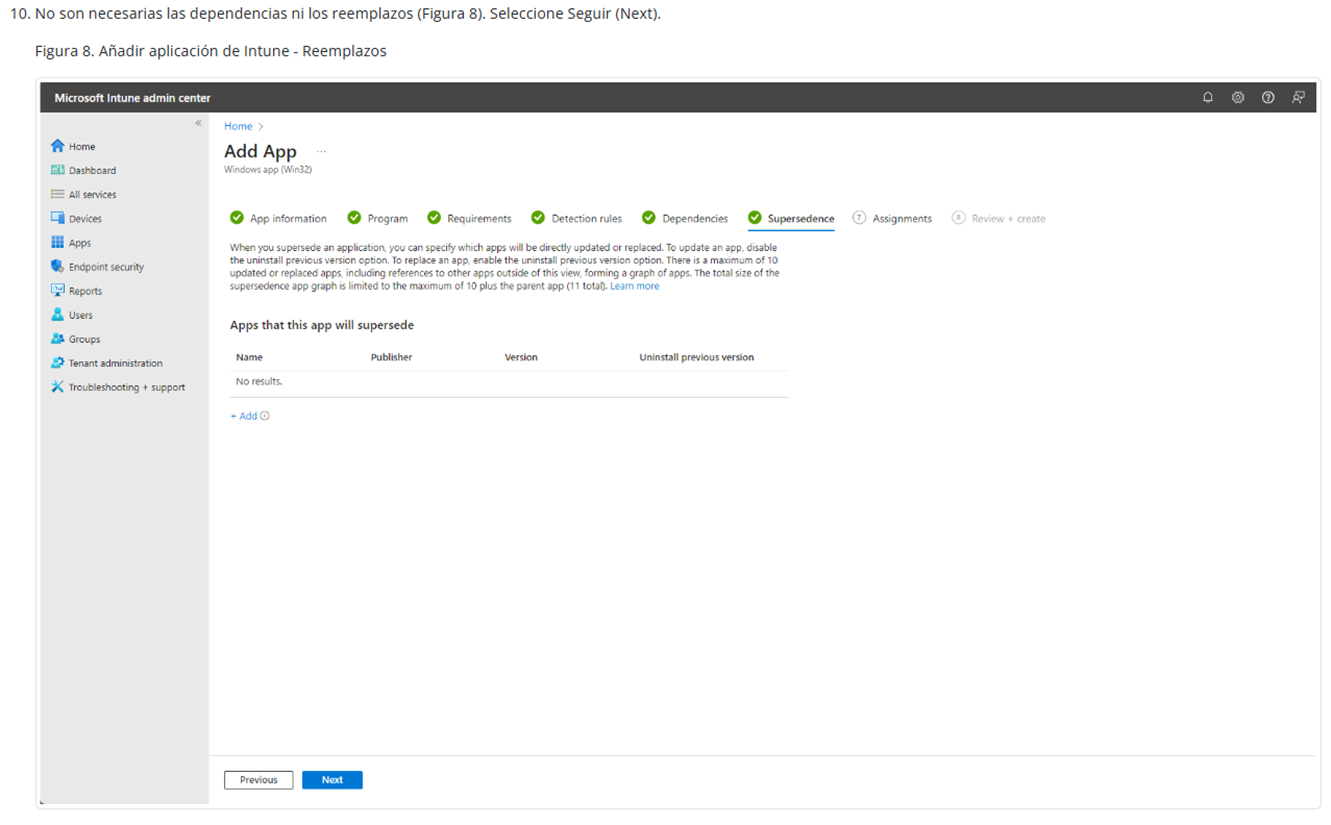
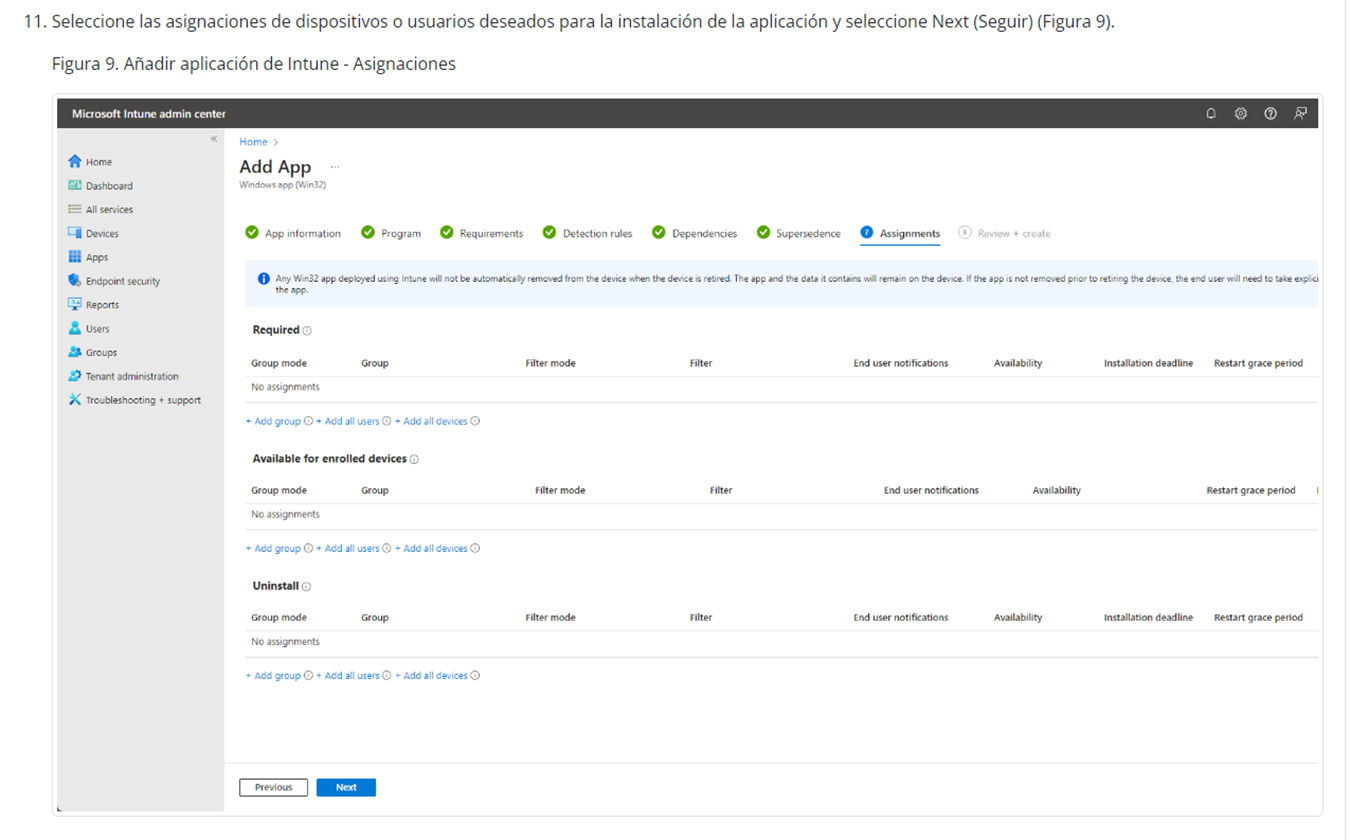
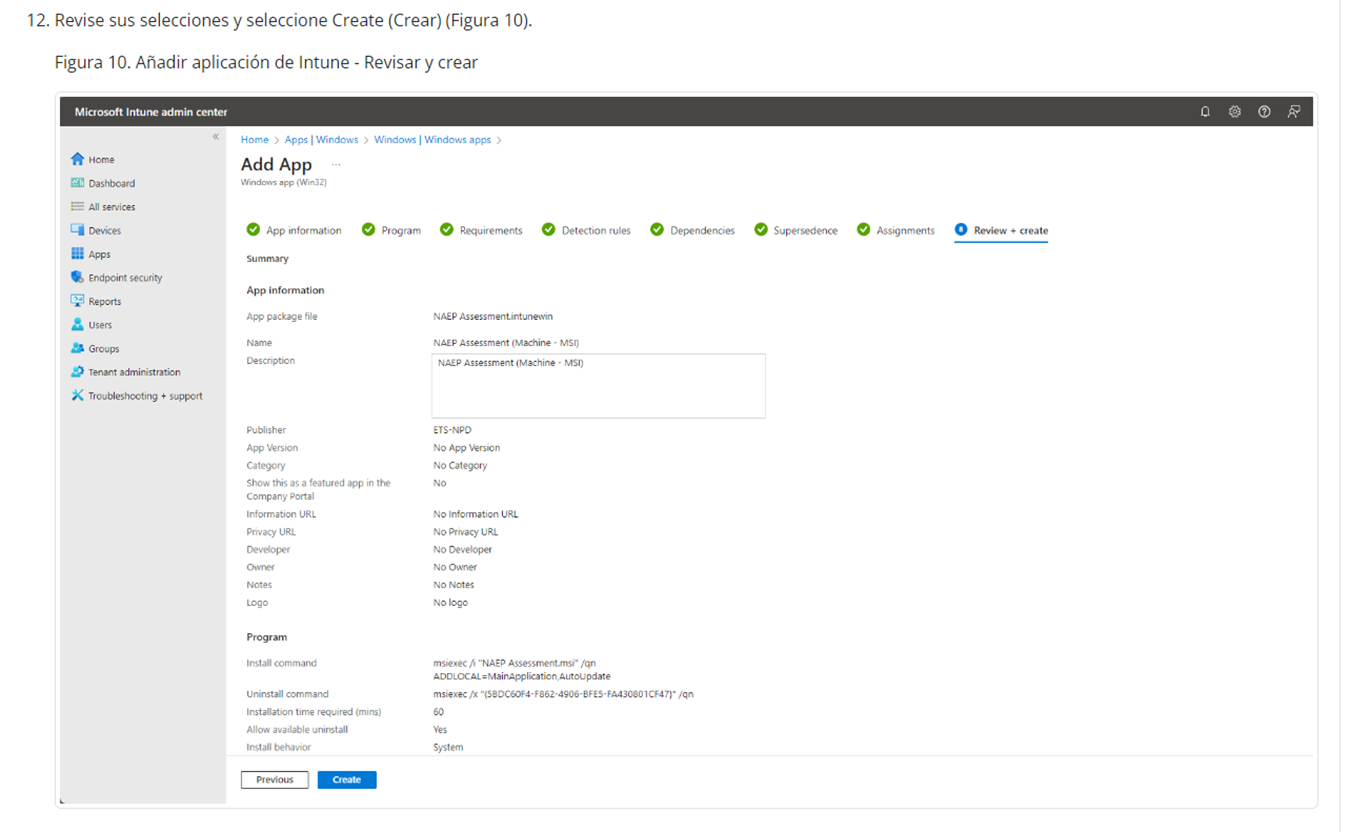

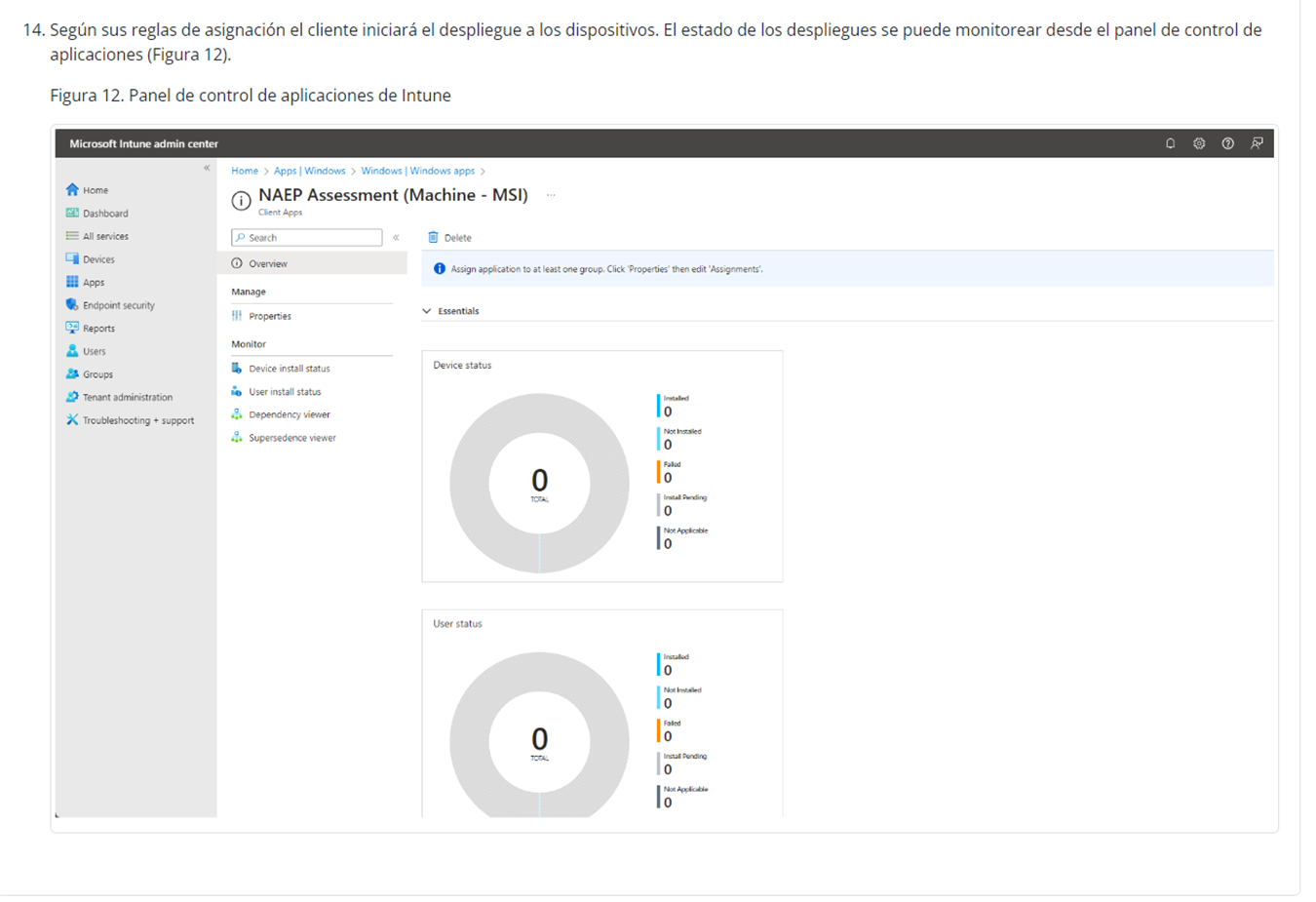
Instrucciones para la instalación de la aplicación de NAEP > Windows > Instrucciones de instalación a gran escala > Distribución e instalación de la aplicación de NAEP a través de la línea de commando
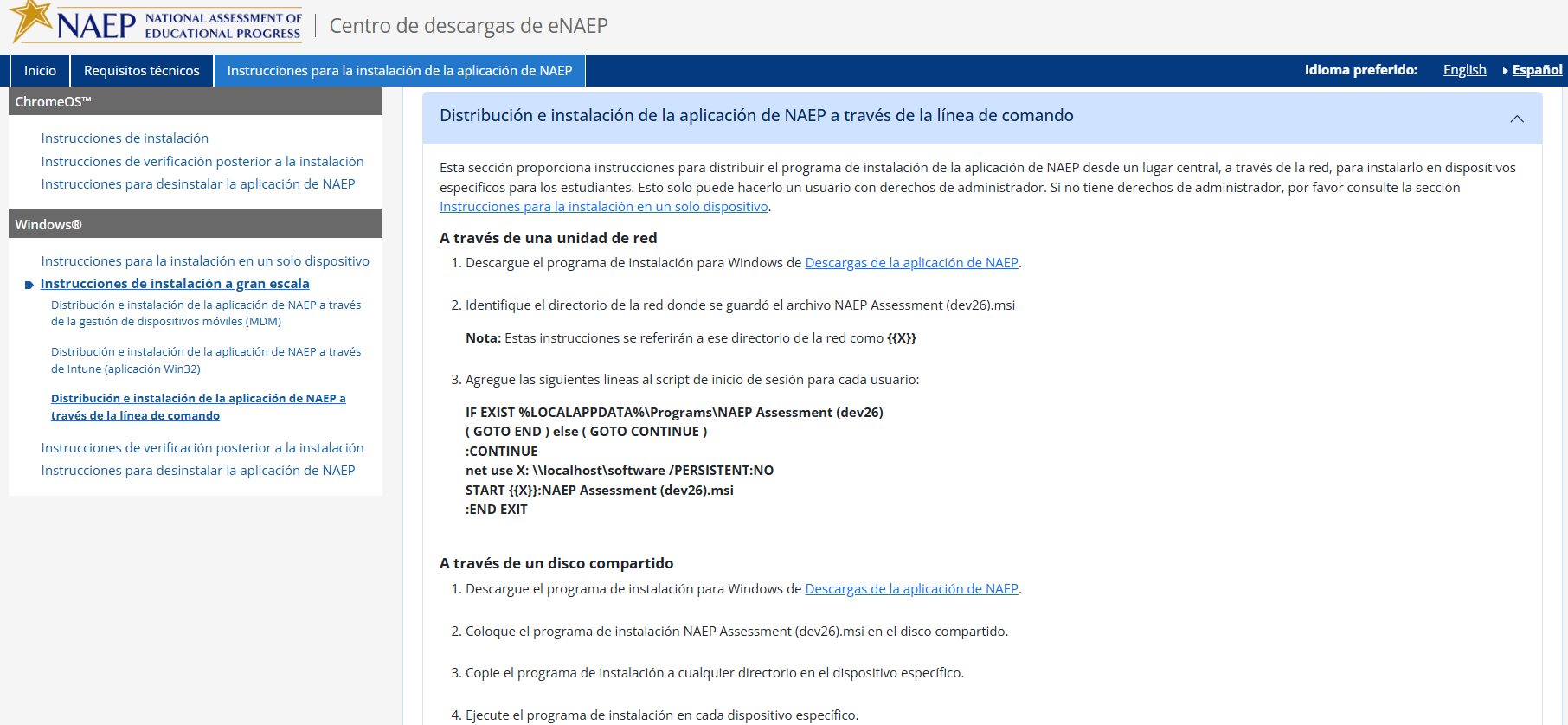
Instrucciones para la instalación de la aplicación de NAEP > Windows > Instrucciones de verificación posterior a la instalación

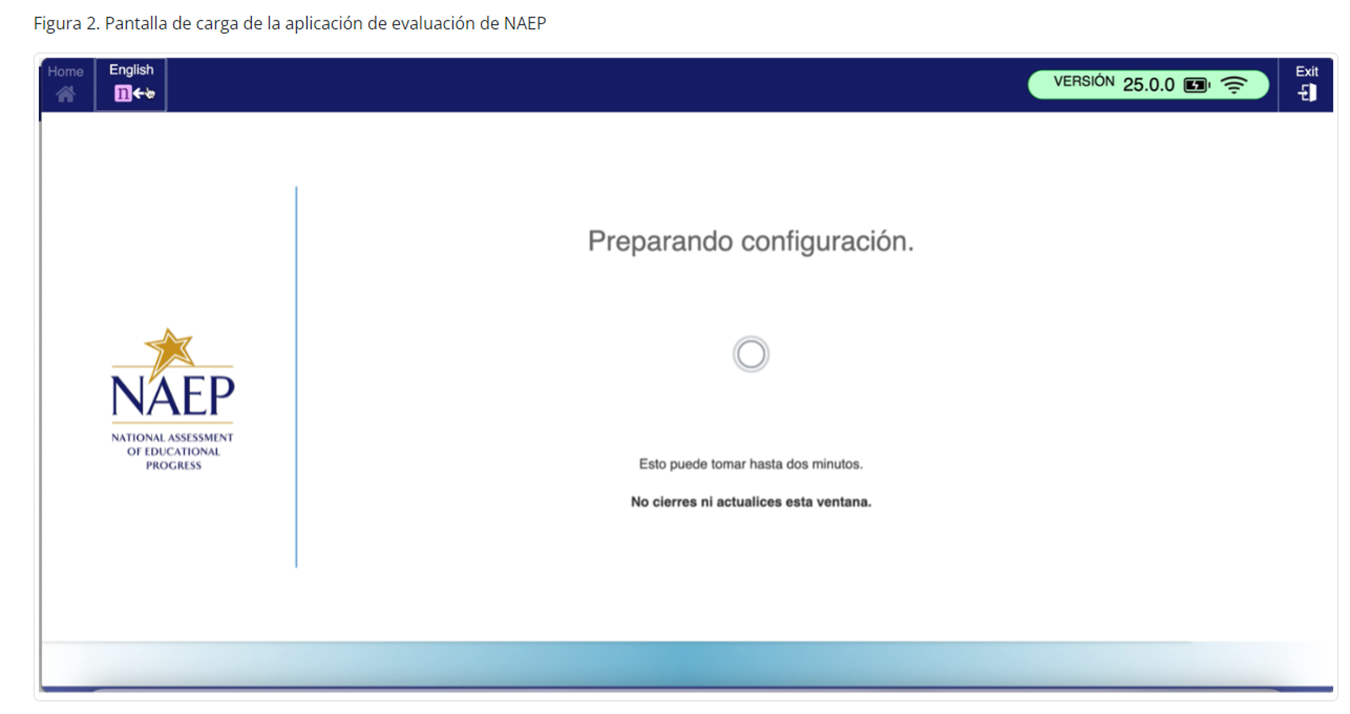

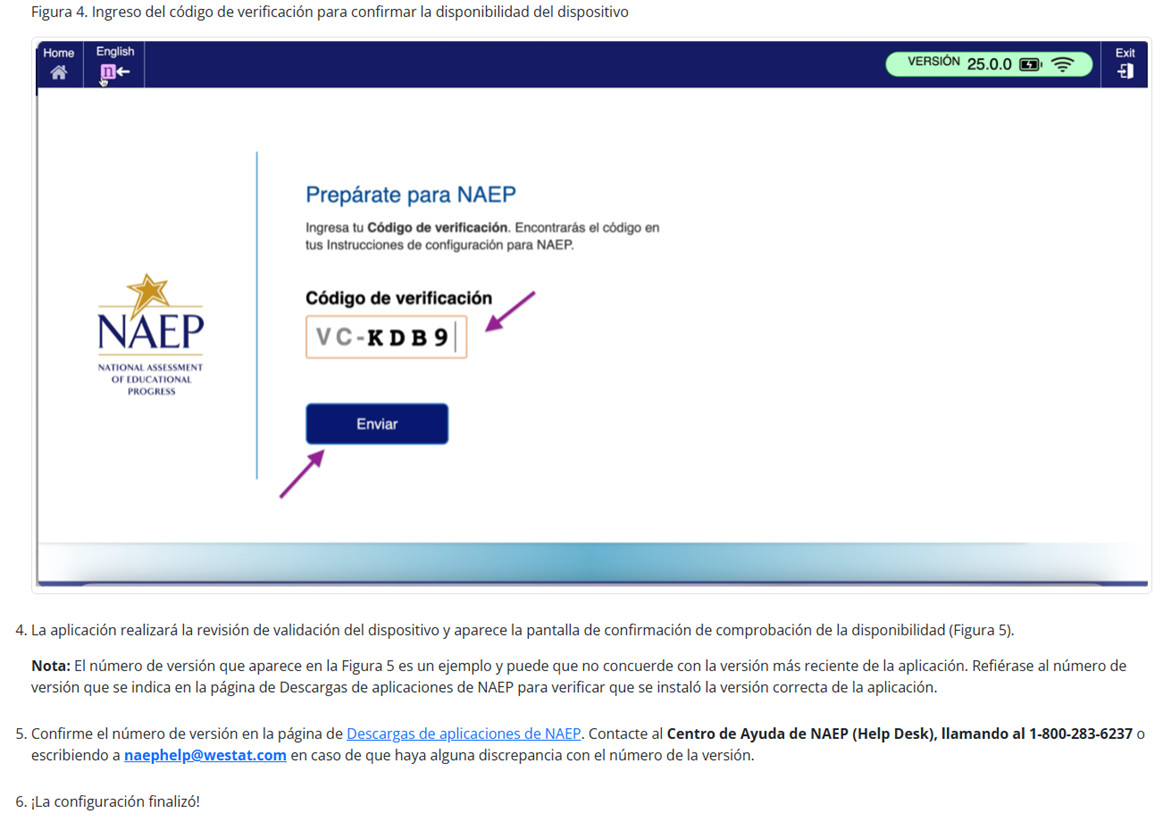

Instrucciones para la instalación de la aplicación de NAEP > Windows > Instrucciones para desinstalar la aplicación de NAEP
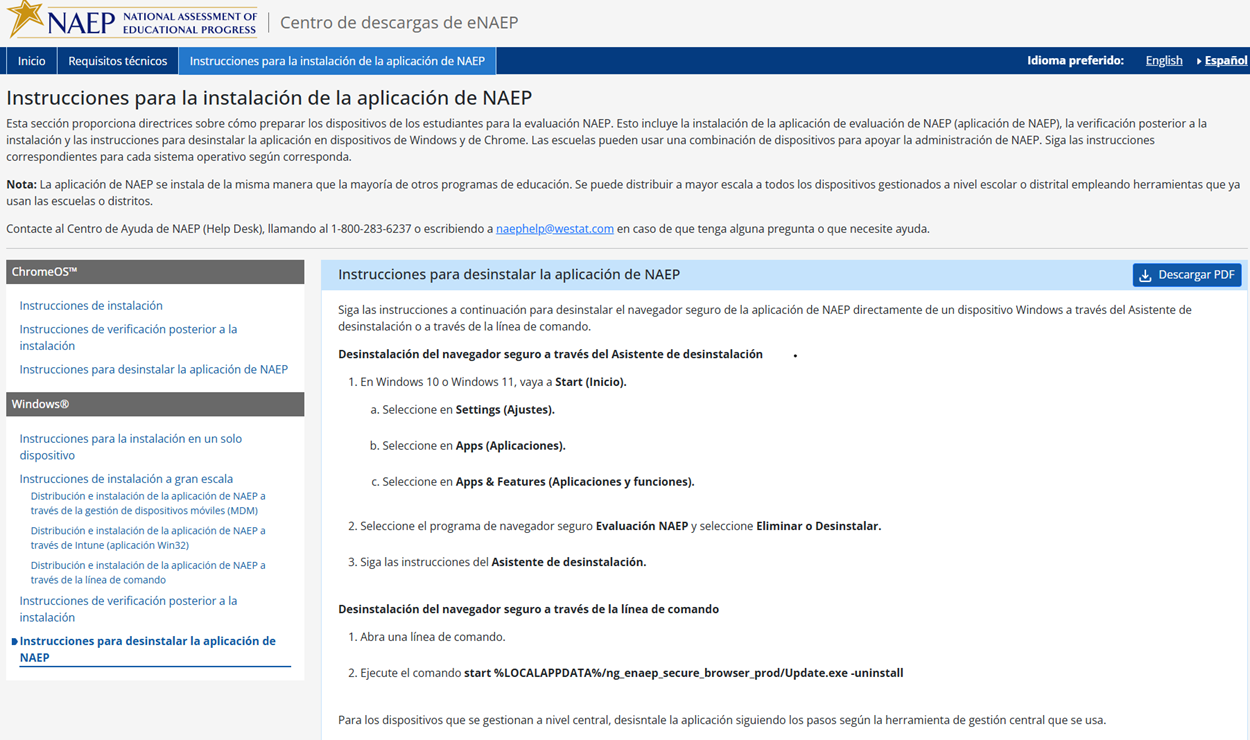
Appendix D-64: NAEP 2026 eNAEP Download Center – Maintenance Page in English (Revised)
Maintenance Page - English
The below maintenance page will communicate to users who access the eNAEP Download Center that it is not available yet for the 2026 administration. The page will be up starting May 1, 2025 through ~June 15, 2025. It will be inactivated when the School Technology Survey is available in the AMS.
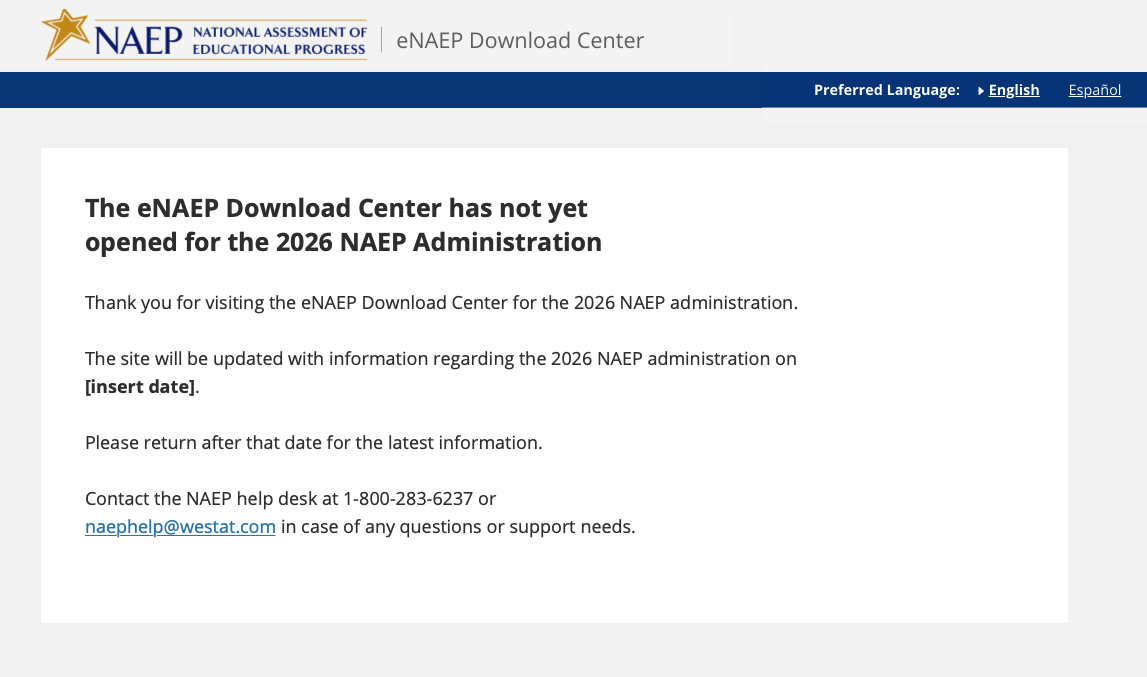
Appendix D-65: NAEP 2026 eNAEP Download Center – Maintenance Page in Spanish (Revised)
Maintenance Page – Spanish

Appendix D-66: NAEP 2026 eNAEP Download Center – Page Not Found Error Page in English (Revised)
Page Not Found Error Page – English
A user will see the below page if the user attempts to access a link for the eNAEP Download Center that is not valid (e.g., mistype the link).

Appendix D-67: NAEP 2026 eNAEP Download Center – Page Not Found Error Page in Spanish (Revised)
Page Not Found Error Page – Spanish

Appendix D-68: NAEP 2026 Best Practices Introduction (NEW)
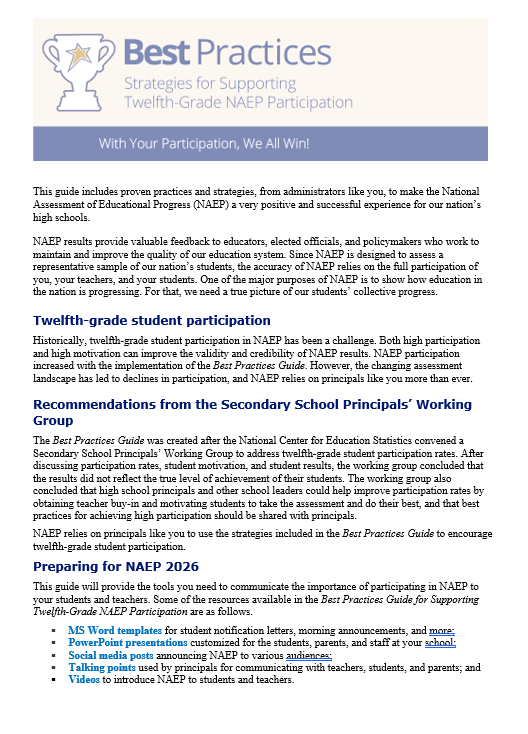

Appendix D-69: NAEP 2026 Best Practices Notification (NEW)

Appendix D-70: NAEP 2026 Best Practices Storyboard for Introduction Video (NEW)
Storyboard for Introduction to Best Practices Video
Section |
Narration |
Description of Video |
1 - Introduction |
Thank you for your school’s participation in NAEP, the National Assessment for Educational Progress, for 2026, in mathematics and reading. |
Title slide. |
2 - What is NAEP |
NAEP is the largest nationally representative assessment in mathematics and reading. Results from this assessment help inform educators, policymakers, and elected officials about the state of education in the nation. |
Image of US map and results from the Nation’s Report Card site. |
3 - Importance of Student Participation |
It’s important for NAEP to assess as many students selected to participate as possible. These students represent the nation. Assessing representative samples of students, including students with disabilities and English learners, helps ensure that NAEP results accurately reflect the educational performance of all twelfth-grade students, so NAEP can continue to serve as a meaningful measure of U.S. students’ academic achievement over time. |
Images depicting nationally representative sample. |
4 – Grade 12 participation and Best Practices Guide |
Twelfth-grade student participation in NAEP is a challenge. The Best Practices Guide for Supporting Twelfth-Grade Student NAEP Participation was developed based on suggestions from principals like you to help address the challenge.
We need your help to encourage your students to participate in NAEP to ensure twelfth-grade results can be reported for 2026. To help you support greater student participation, your NAEP State Coordinator will present you with a copy of this Best Practices Guide. |
Image of the front cover of the guide. |
5 – Resources |
This guide provides the tools, resources, and strategies to communicate the importance of participating in NAEP to students, teachers, and parents and encourage students to show up and do their best on the assessment. |
Show table of contents and some resources. |
6 – Thank you |
We encourage you to review this guide and implement these best practices in your school. If you have questions, please reach out to your NAEP State Coordinator. Thanks again for your school’s participation. |
Thank you slide. |
Appendix D-71: NAEP 2026 Best Practices Storyboard for Introduction Video, Private Schools (NEW)
Video Title: NAEP is Supported by Many Private School Organizations
Screen # |
Narrated Text |
Description of Screen |
1 |
The National Assessment of Educational Progress, also known as NAEP, or The Nation’s Report Card, is supported by many private school organizations. |
NAEP logo appears on screen. |
2 |
Several organizations have provided letters of support for the NAEP 2026 assessment, including the Council for American Private Education (CAPE), the National Catholic Educational Association (NCEA), the National Association of Independent Schools (NAIS), and the Association of Christian Schools International (ACSI) among many others. |
Screen shots of endorsement letters from CAPE, NCEA, NAIS, and ACSI appear on screen.
[Note, we have not yet received these letters and will customize the narrated text to match the letters we receive] |
3 |
Here is the full list of private school organizations that have provided letters of support for NAEP 2026. |
[Placeholder for full list of organizations that provide letters in 2026] |
4 |
By participating in NAEP 2026, your school will contribute to the picture of education across the nation and to future policy decisions. For more information about the importance of participation in NAEP, contact your private school organization leaders or your NAEP representative. |
A map of the United States with education icons popping out of various locations in the map |
5 |
NAEP, giving private schools a voice in the national education conversation. |
NAEP, giving private schools a voice in the national education conversation. |
Video Title: NAEP Benefits for Students, Teachers, and Schools
Screen # |
Narrated Text |
Description of Screen |
1 |
Your school has been selected to represent private schools across our nation by participating in the National Assessment of Educational Progress, also known as NAEP or The Nation’s Report Card. |
NAEP logo appears on screen. |
2 |
Students, teachers, and schools all benefit by participating in NAEP. |
Icons representing students, teachers, and schools |
3 |
By participating, students can receive a certificate of community service for their time spent on the NAEP assessment. |
Screen shot of community service certificate |
4 |
Students experience an engaging assessment with rich content in a low-stakes environment as there are no results for individual students or schools. |
Images of students participating in the NAEP assessment |
5 |
Students who participate in NAEP contribute to improving the quality of education for all students in the United States. |
A map of the United States with education icons popping out of various locations in the map |
6 |
Teachers do not need to prepare their students to take the NAEP assessment, but make an important contribution by encouraging their students to participate and to give their best effort; this helps ensure that NAEP results provide the most accurate measure possible of student achievement across the country. |
Image of teachers supporting students in the classroom |
7 |
Teachers can also use NAEP’s free data tools such as the NAEP Questions Tool to review sample NAEP questions, see how students performed on these sample questions, and generate tests online using NAEP questions. |
Screen shot of the NAEP Questions Tool website |
8 |
Schools will receive a certificate of appreciation for participating in NAEP. |
Screen shot of the school certificate |
9 |
We look forward to working with you to make NAEP a success in your private school. Please reach out to your NAEP representative to discuss any participation questions. NAEP, giving private schools a voice in the national education conversation. |
Image of NAEP representatives.
NAEP, giving private schools a voice in the national education conversation. |
Video Title: Participation in NAEP is Easy
Screen # |
Narrated Text |
Description of Screen |
1 |
Your school has been selected to represent private schools across our nation by participating in the National Assessment of Educational Progress, also known as NAEP or The Nation’s Report Card. |
NAEP logo appears on screen. |
2 |
In order to have a complete picture of the academic achievement and progress of the nation's private school students, selected private schools must participate in NAEP. Your school’s participation is an opportunity to help make it possible for private school data to be reported and compared with public school data. |
Icons representing public and private schools
Your school’s participation is important! |
3 |
Participating in NAEP is easy and there is no cost to your school to participate. Your school has been assigned a NAEP representative who will support your school’s designated NAEP school coordinator to ensure smooth assessment day activities. NAEP representatives will work with the school coordinator to confirm that the assessment date works with the school calendar, to secure a space for the assessment to take place, and to confirm other assessment day logistics. |
Participating in NAEP is easy!
Image of the NAEP representatives on the phone with a school coordinator |
4 |
NAEP representatives will provide significant support to schools and administer the assessment to students. When the assessment is complete, NAEP representatives will return the testing location to its original condition. |
Images of NAEP representatives bringing the equipment to the school and administering the assessment |
5 |
We look forward to working with you to make NAEP a success in your private school. Please reach out to your NAEP representative to discuss any participation questions. NAEP, giving private schools a voice in the national education conversation. |
Image of NAEP representatives.
NAEP, giving private schools a voice in the national education conversation. |
Appendix D-72: NAEP 2026 Best Practices HTML Email 1 (NEW)


Appendix D-73: NAEP 2026 Best Practices HTML Email 2 (NEW)
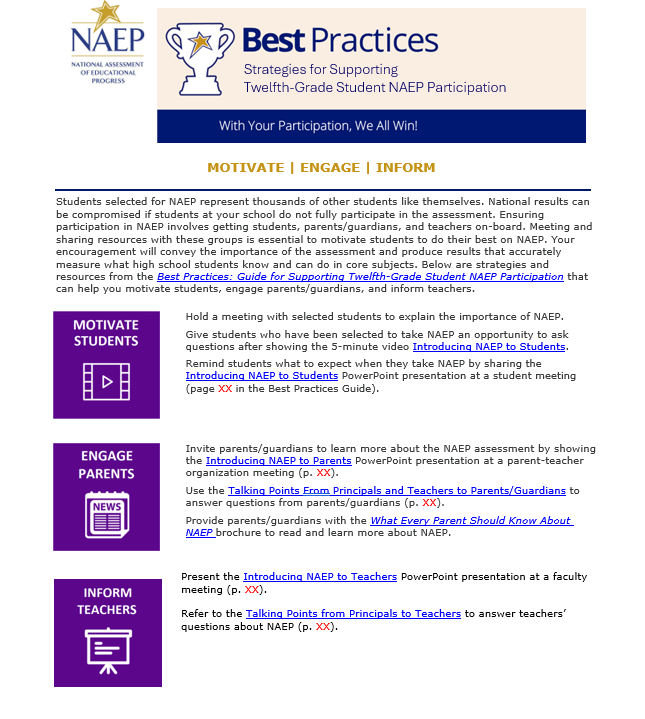
Appendix D-74: NAEP 2026 Best Practices HTML Email 3 (NEW)

Storyboard for Introduction to Best Practices Video
Section |
Narration |
Description of Video |
1 - Introduction |
Thank you for your school’s participation in NAEP, the National Assessment for Educational Progress, for 2025, in mathematics and reading. |
Title slide. |
2 - What is NAEP |
NAEP is the largest nationally representative assessment in mathematics and reading. Results from this assessment help inform educators, policymakers, and elected officials about the state of education in the nation. |
Image of US map and results from NRC site. |
3 - Importance of Student Participation |
It’s important for NAEP to assess as many students selected to participate as possible.. Assessing representative samples of students, including students with disabilities and English learners, helps ensure that NAEP results accurately reflect the educational performance of all high school students, so NAEP can continue to serve as a meaningful measure of U.S. students’ academic achievement over time. |
Images depicting nationally representative sample. |
4 – The grade 12 participation challenge |
High school student participation in NAEP is a challenge. In 2005, when only 67 percent of sampled high school students participated, the Best Practices Guide for Supporting High School NAEP Participation was developed based on suggestions from principals like you to help address the challenge. |
Graph of student participation rate over time. |
5 – The Best Practices Guide |
We need your help in encouraging your students to participate in NAEP to ensure high school results can be reported for 2025. To help you support greater student participation, your NAEP State Coordinator will present you with a copy of this Best Practices Guide. |
Image of the front cover of the guide. |
6 – Resources |
This guide provides the tools, resources, and strategies to communicate to students, teachers, and parents the importance of participating in NAEP and to encourage students to show up and do their best on the assessment. |
Show table of contents and some resources. |
7– Thank you |
We encourage you to review this guide and implement these best practices in your school. If you have questions, please reach out to your NAEP State Coordinator. Thanks again for your school’s participation. |
Thank you slide. |
Appendix D-75: NAEP 2026 Best Practices 2019 Infographic Grade 12 Mathematics and Reading Results (NEW)
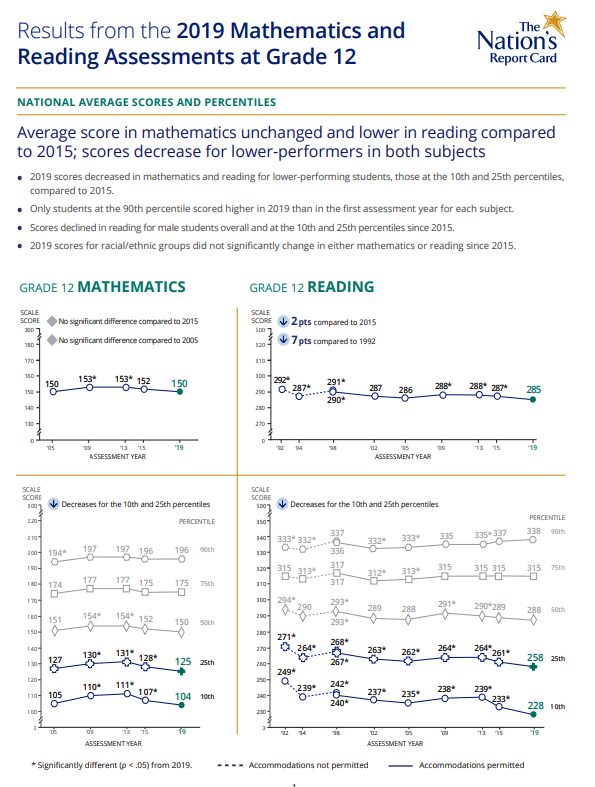
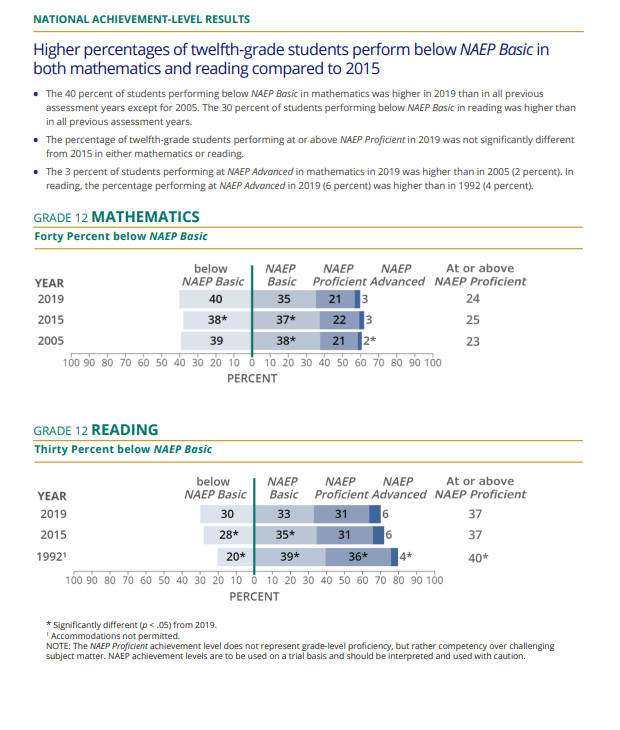
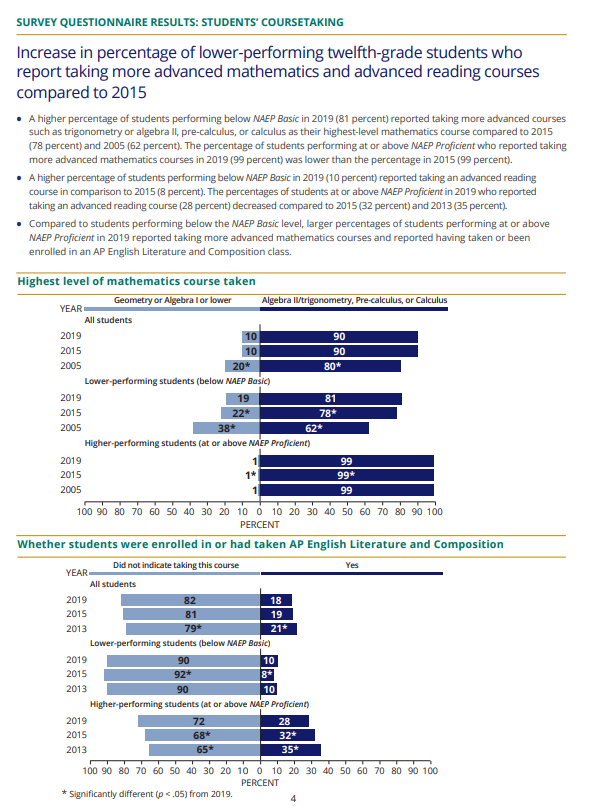
Appendix D-76: NAEP 2026 Best Practices PowerPoint Slide TV Monitor Announcement (NEW)

Appendix D-77: NAEP 2026 Best Practices PowerPoint Slides: Introducing NAEP to Parents (NEW)
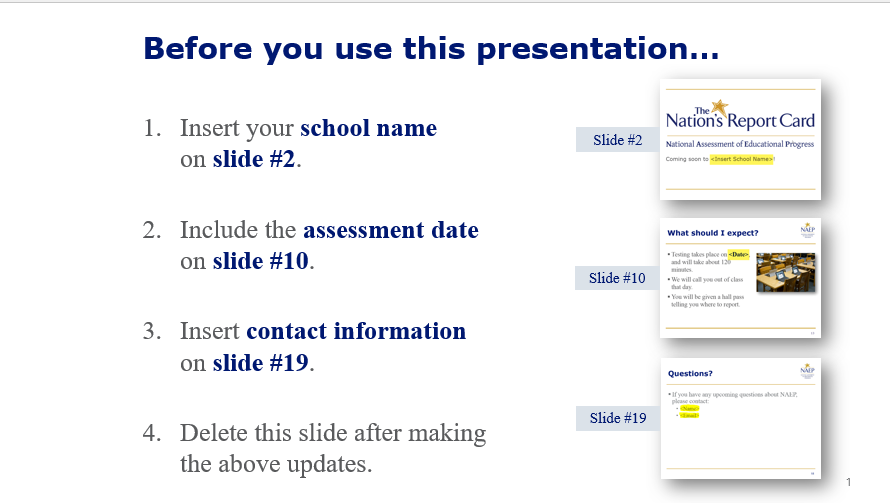
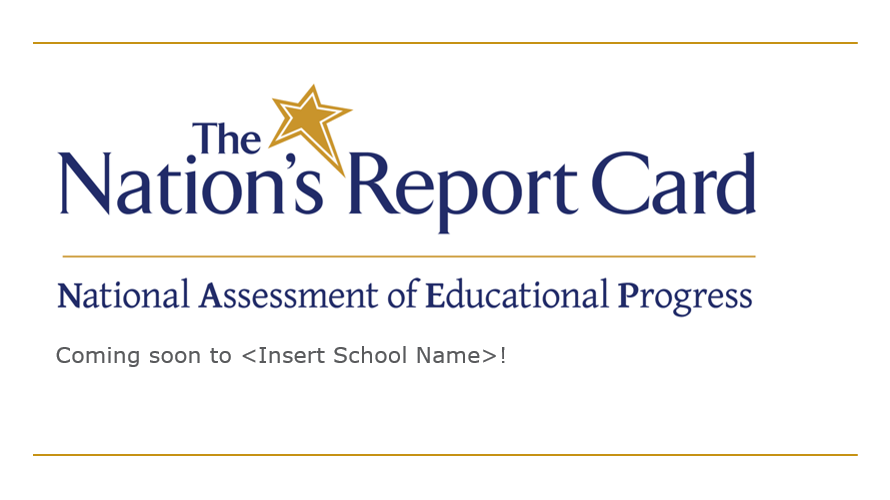

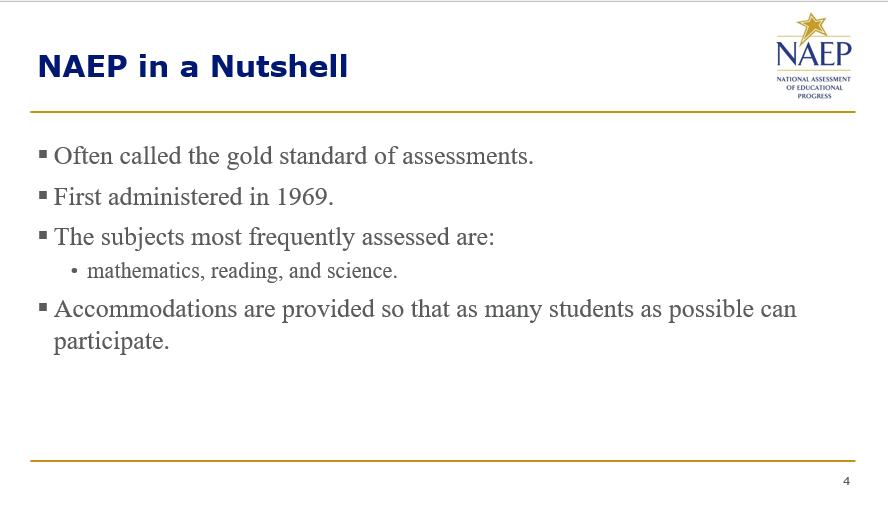

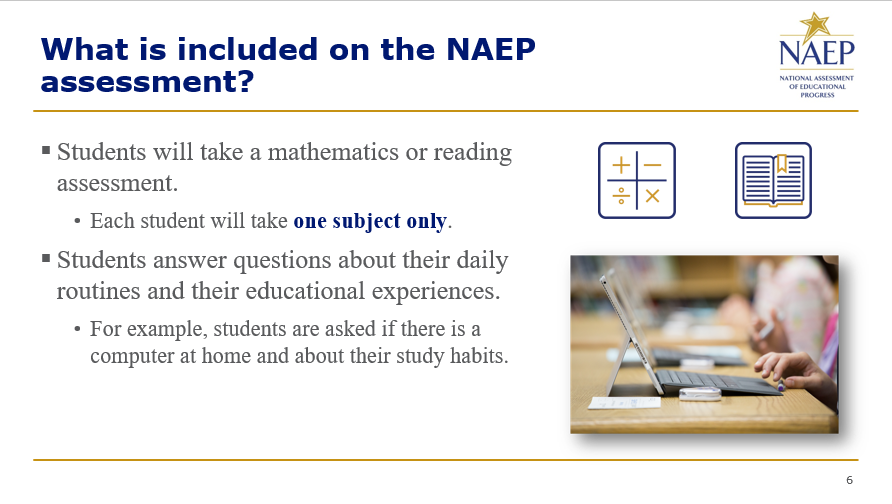



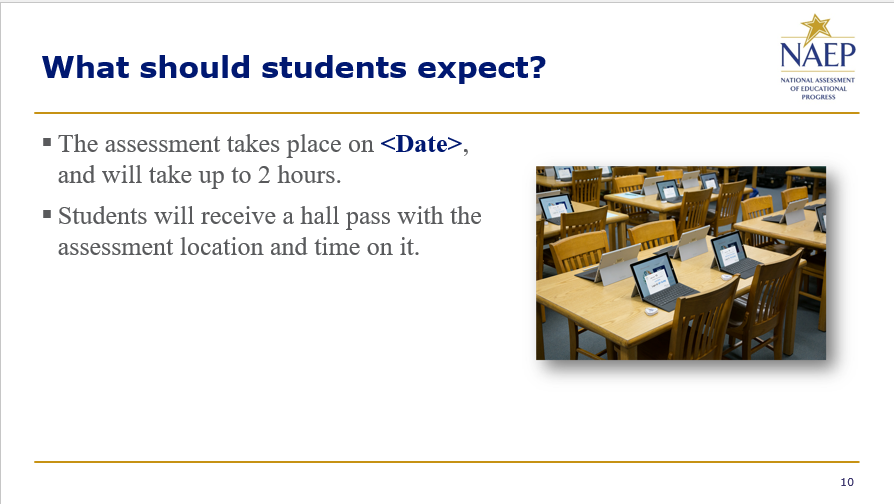
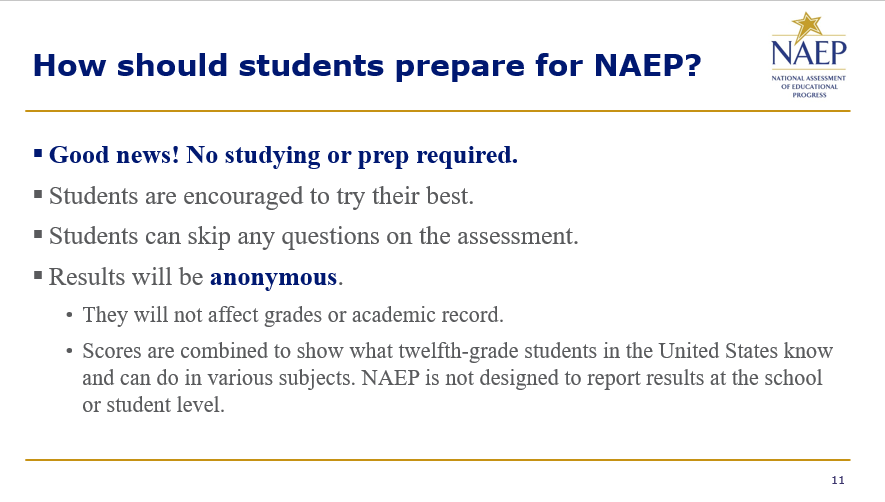
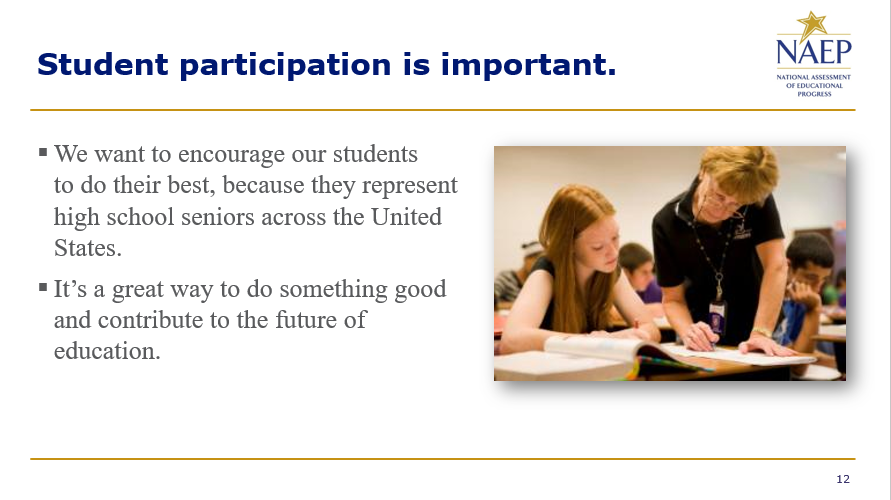
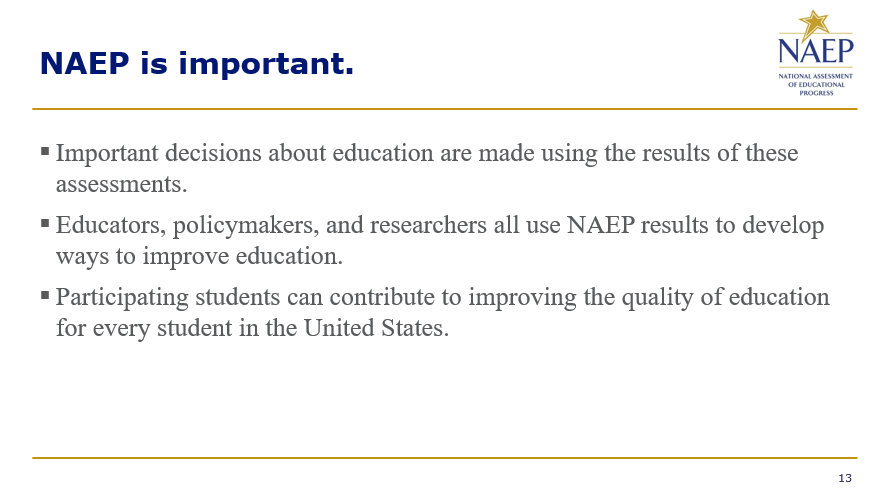

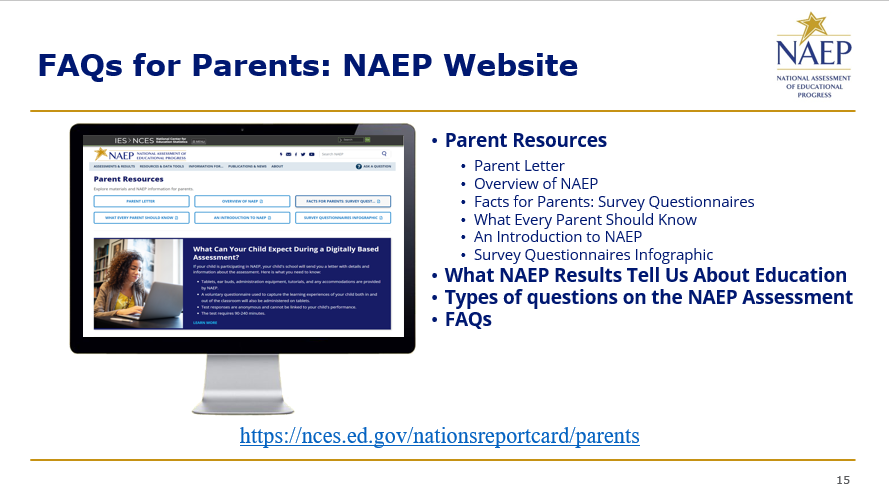


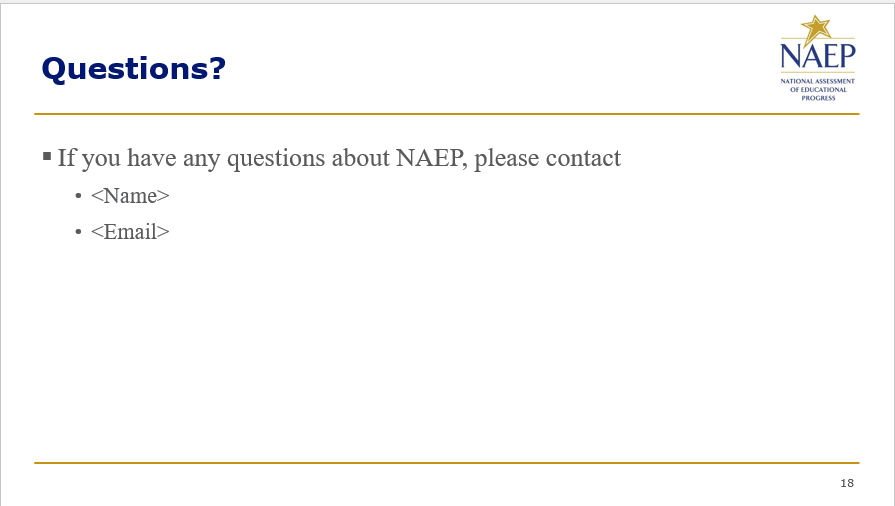
Appendix D-78: NAEP 2026 Best Practices PowerPoint Slides: Introducing NAEP to Students (NEW)
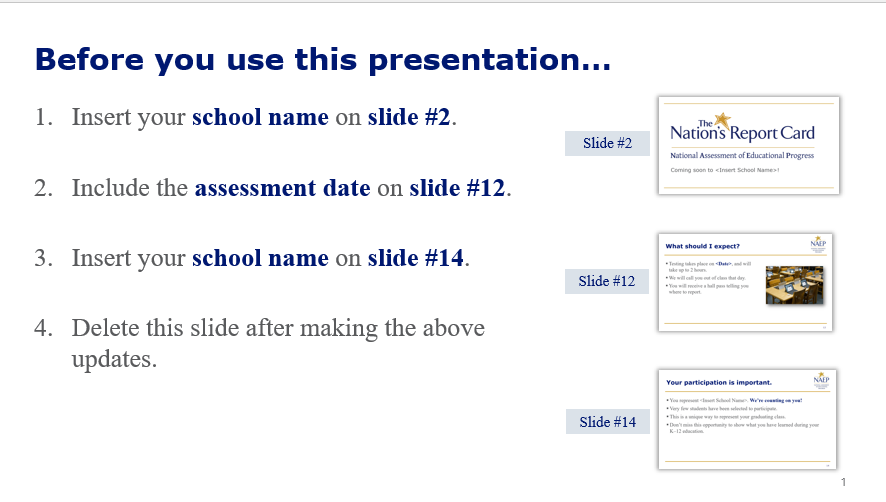
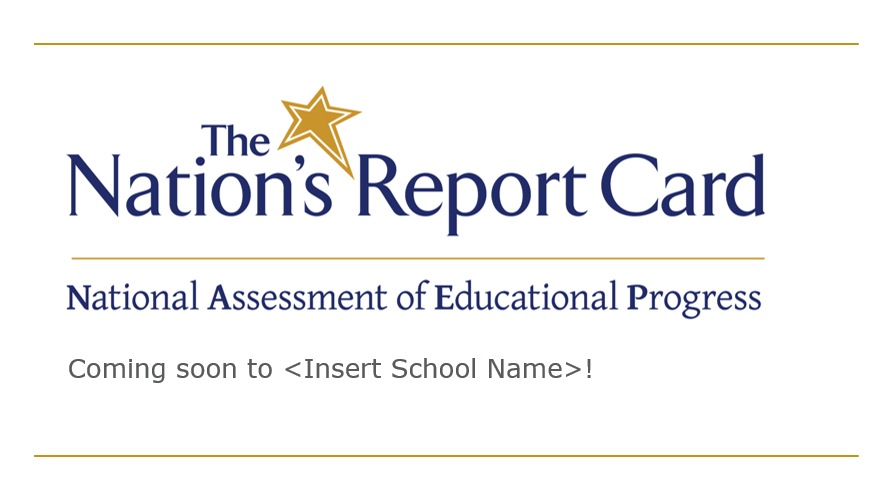

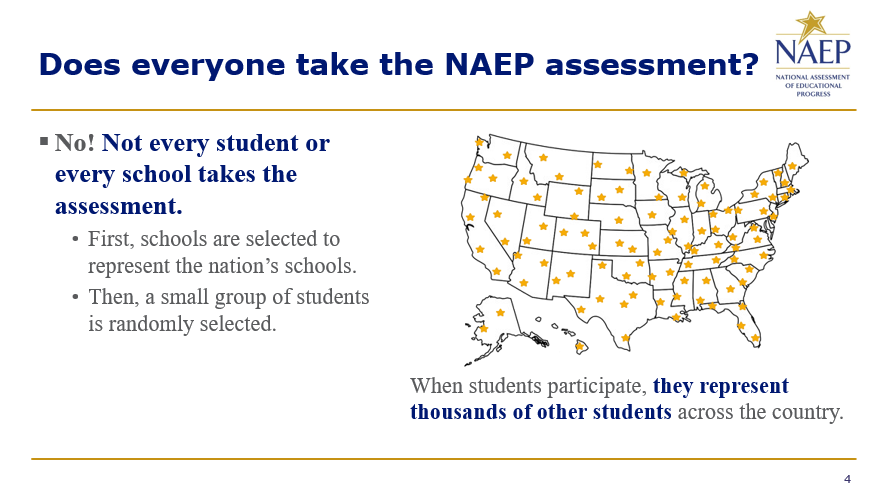
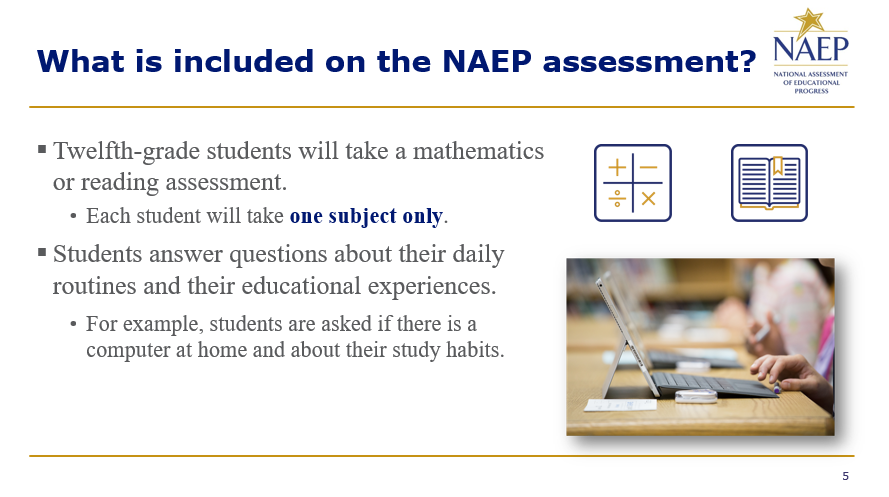
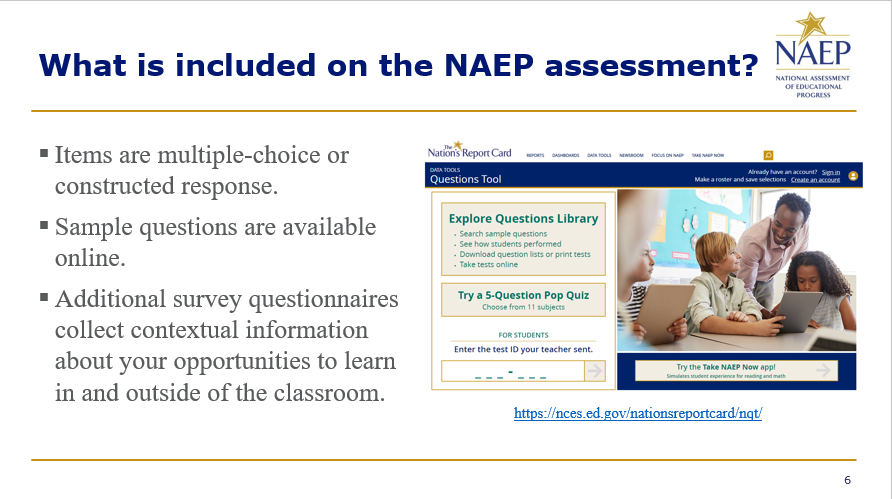
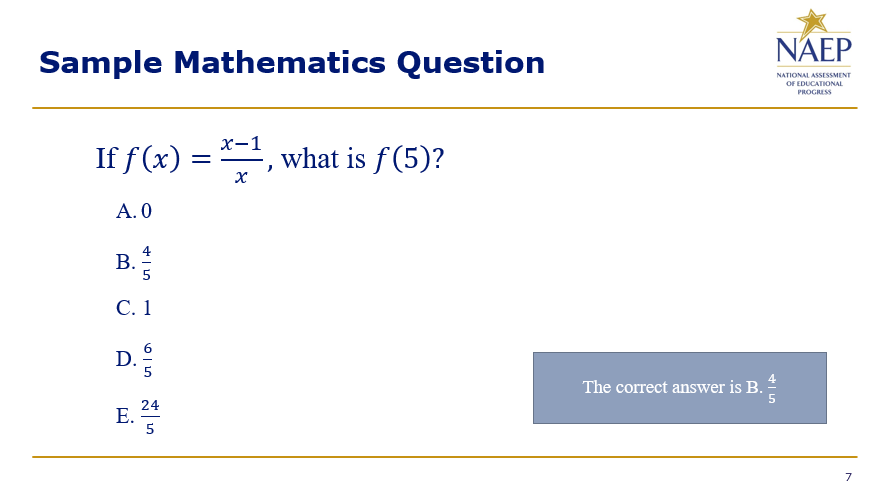
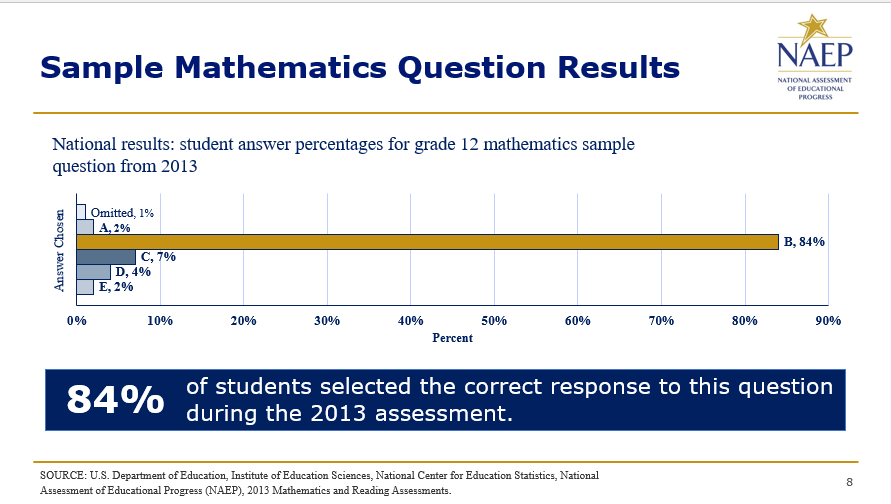


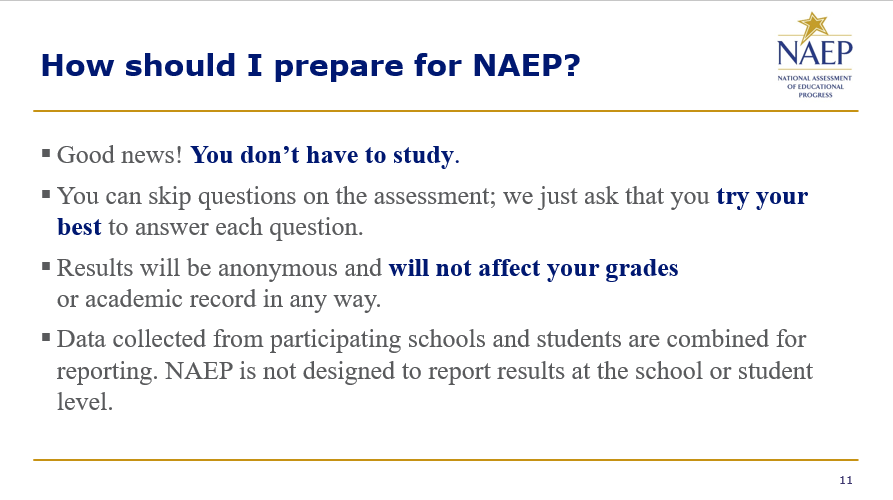

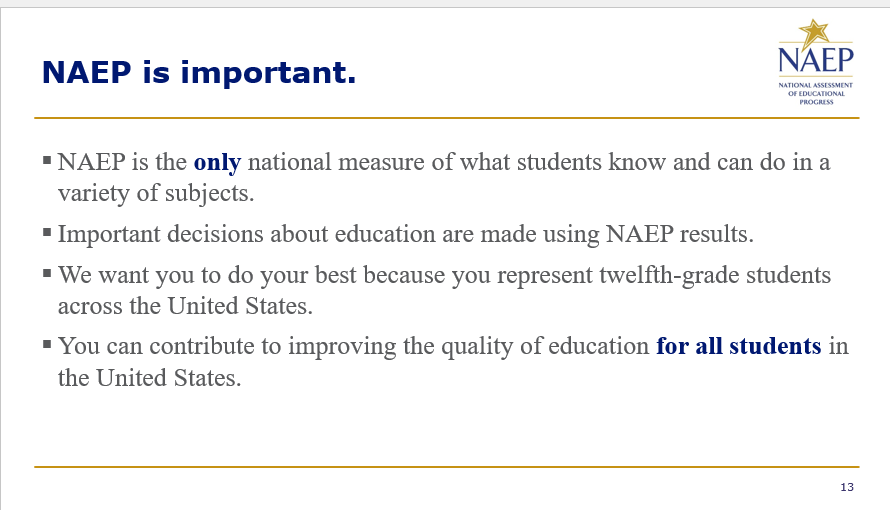
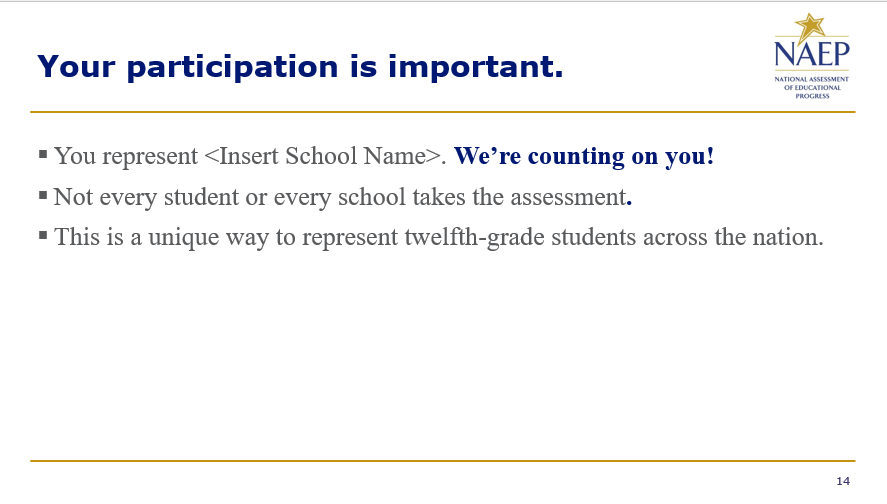

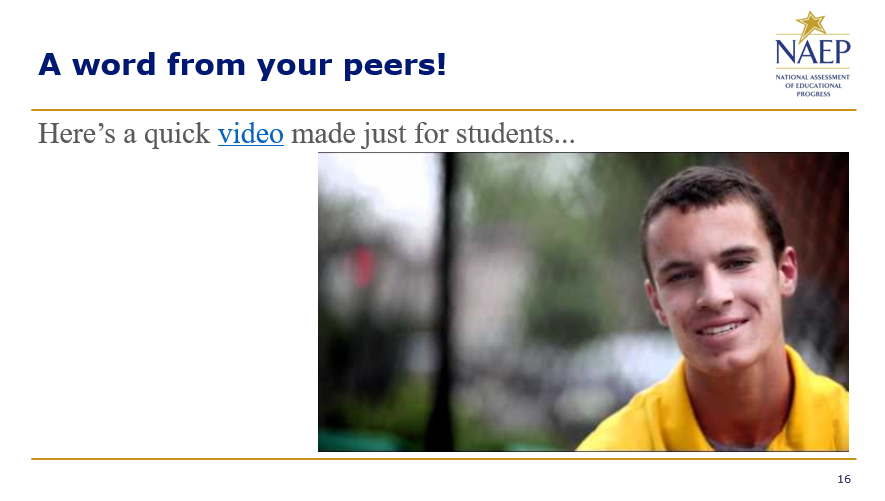
Appendix D-79: NAEP 2026 Best Practices PowerPoint Slides: Introducing NAEP to Teachers (NEW)
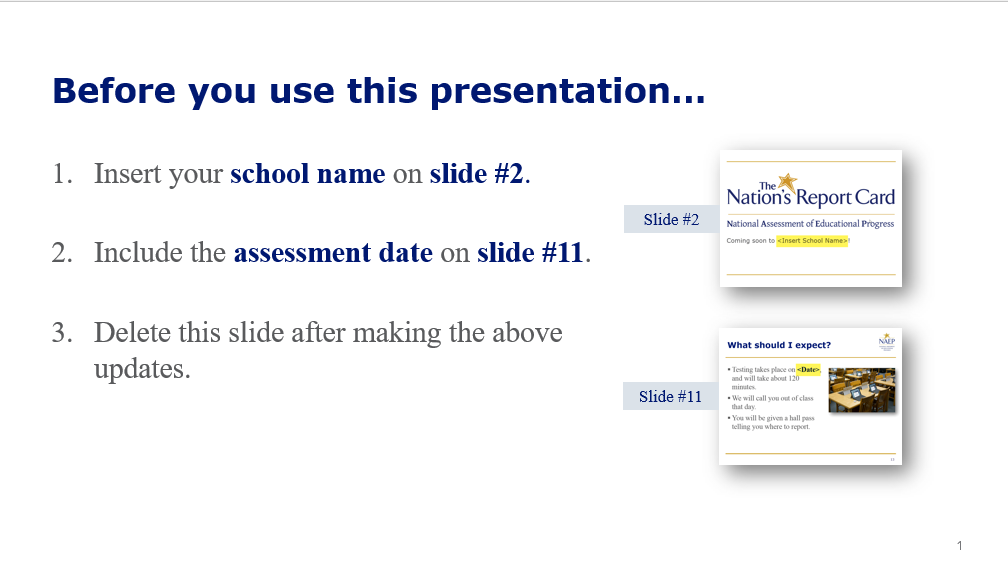
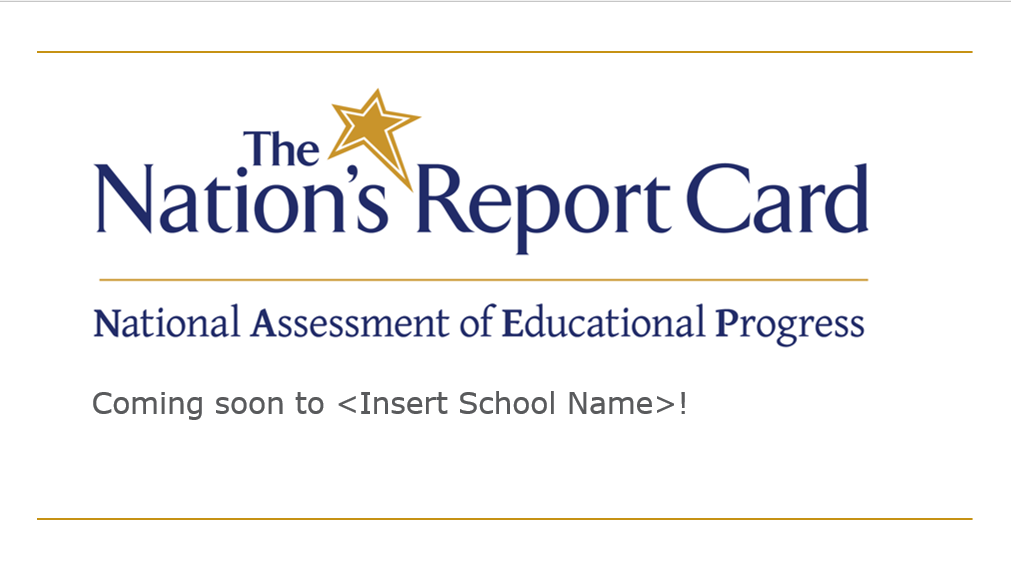
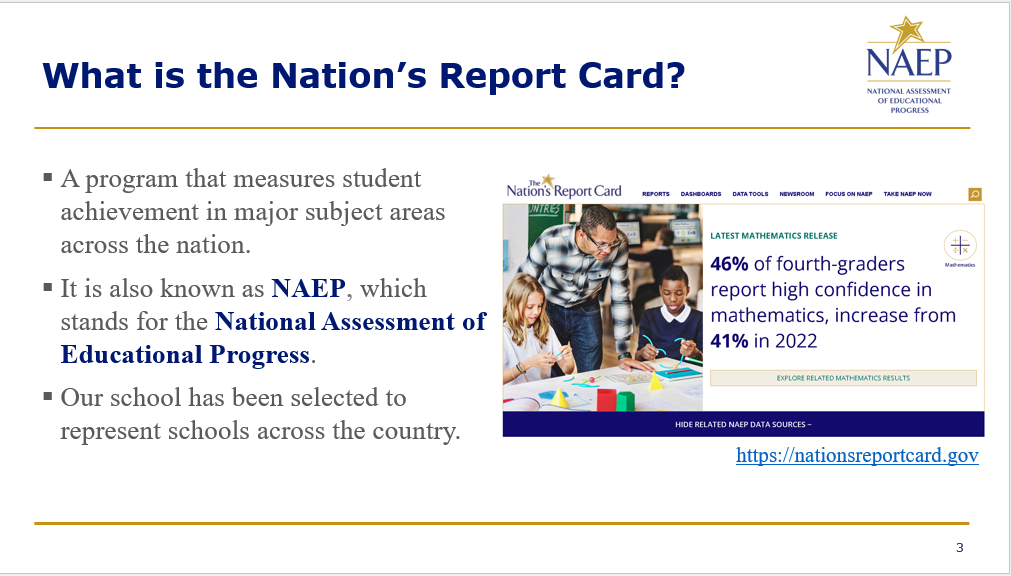
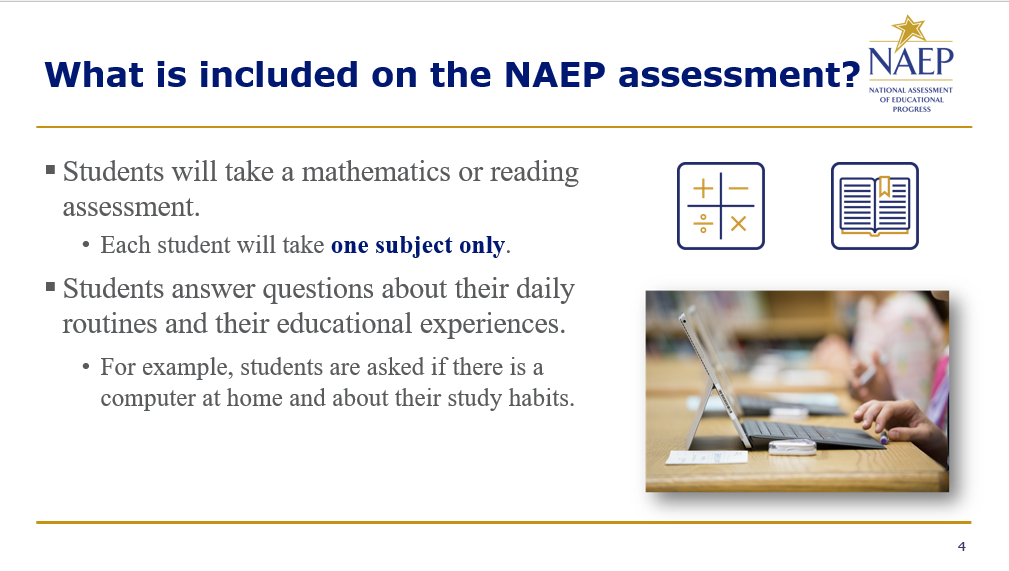
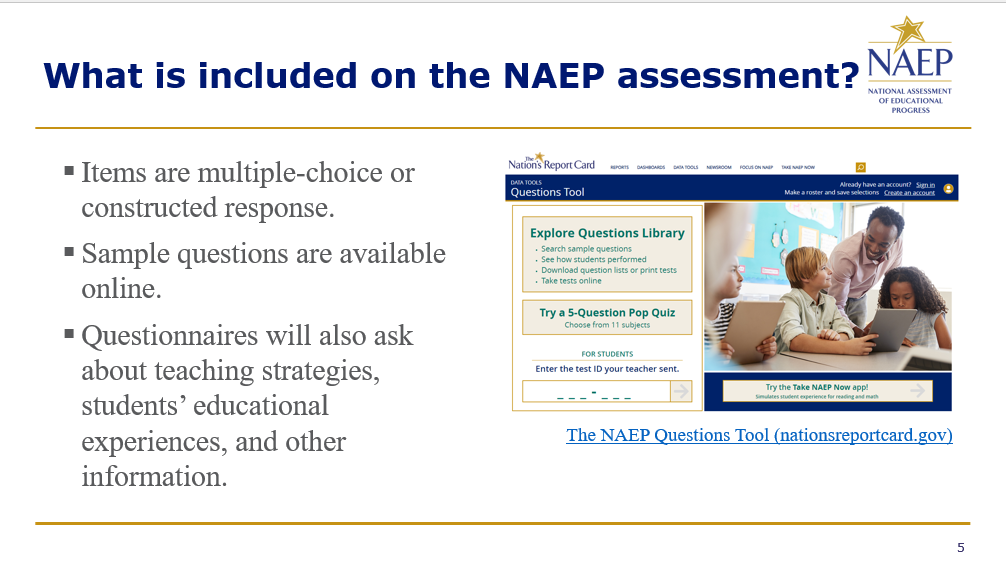
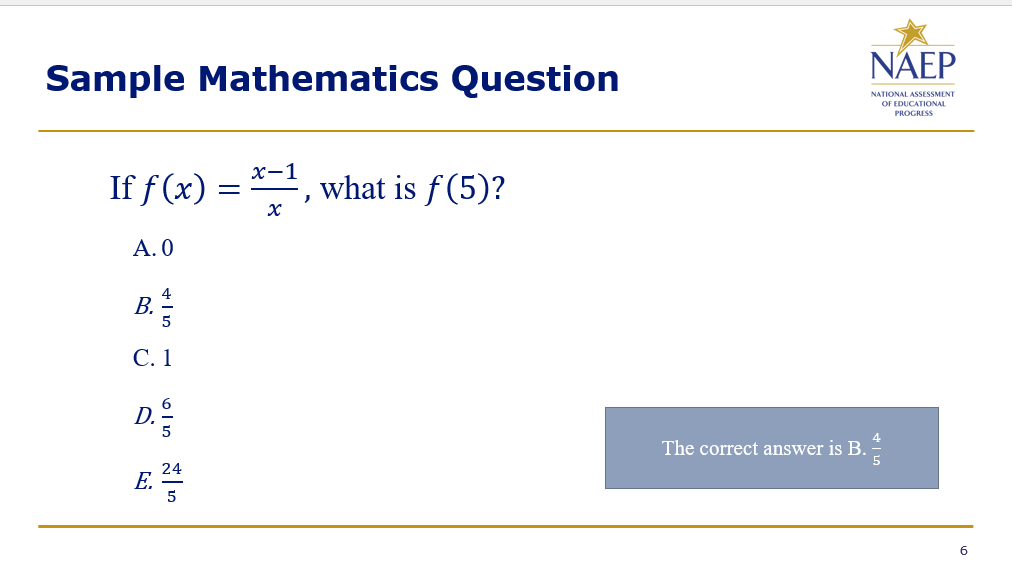


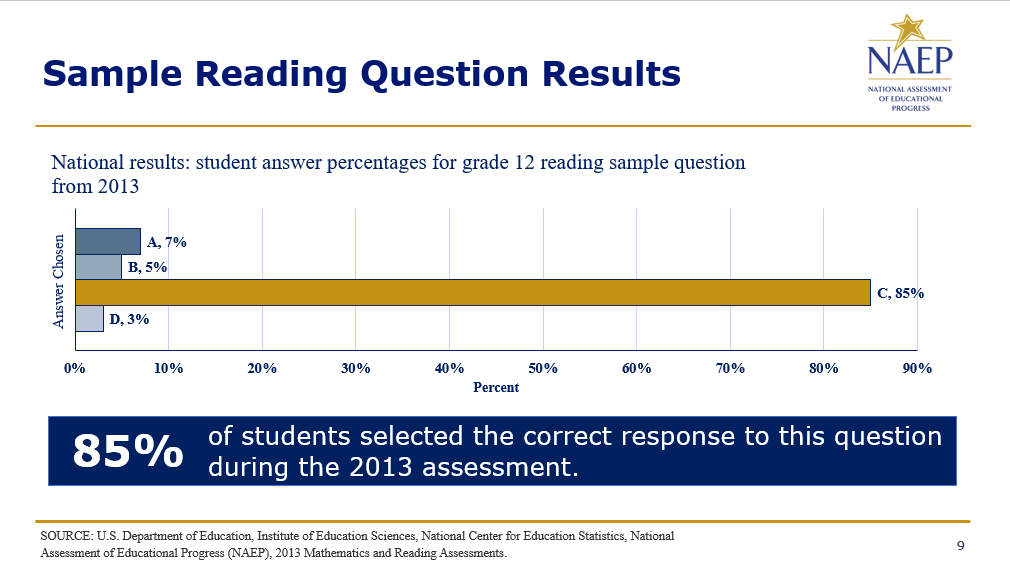

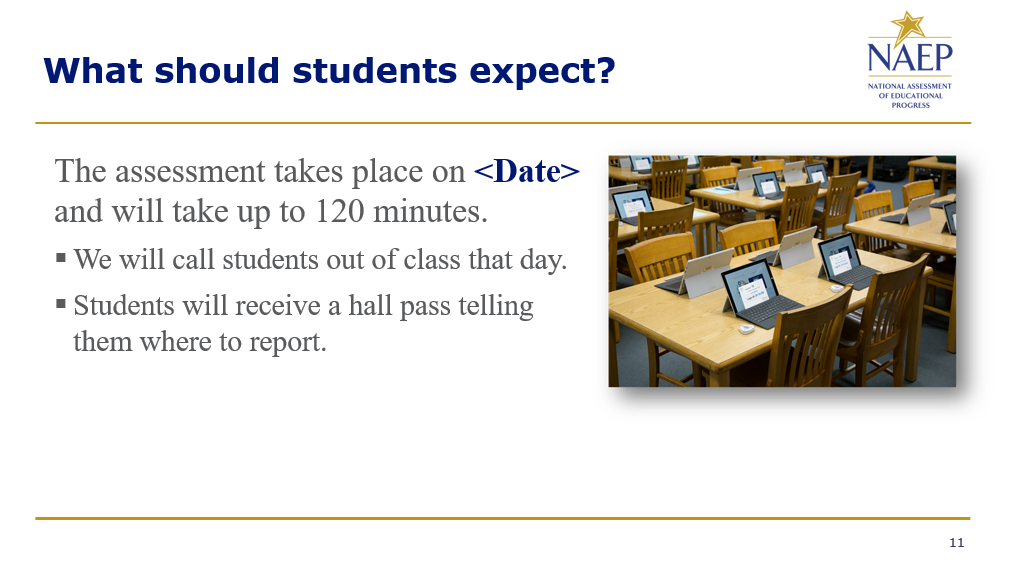

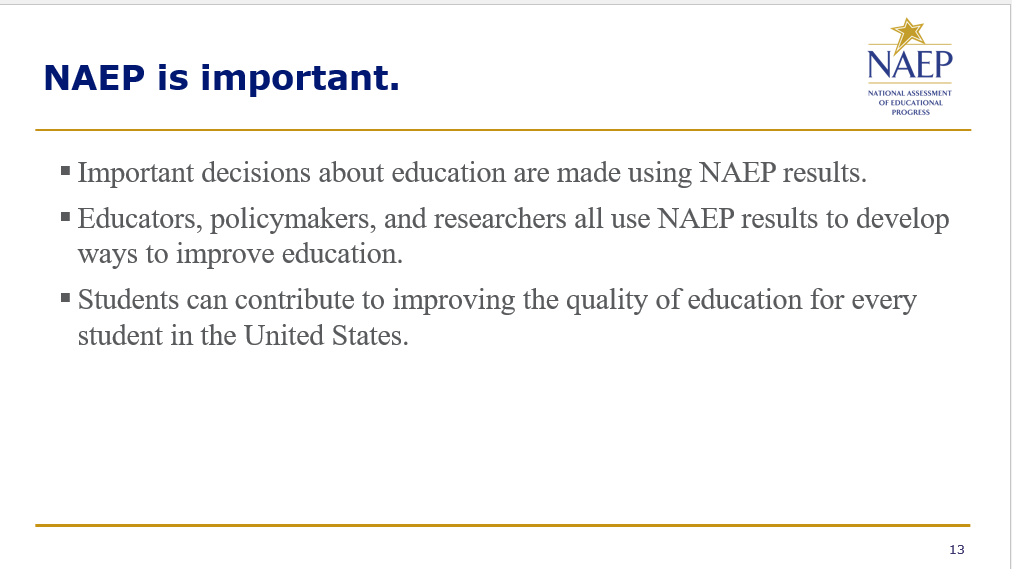
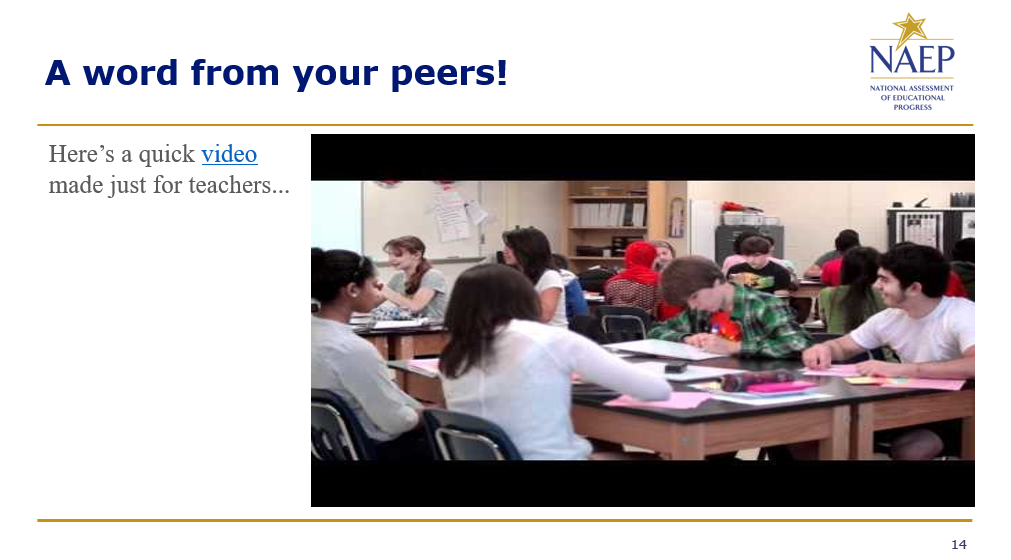

Appendix D-80: NAEP 2026 Best Practices Talking Points Principals and Teachers to Parents (NEW)
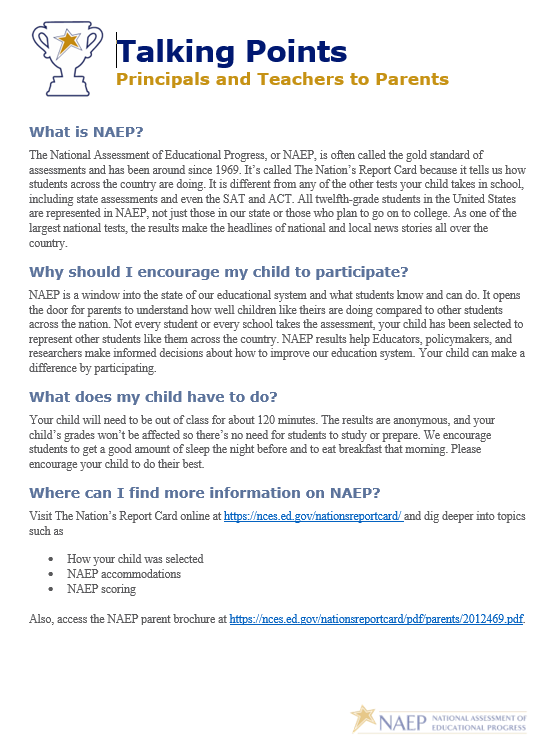
Appendix D-81: NAEP 2026 Best Practices Talking Points Principals and Teachers to Students (NEW)
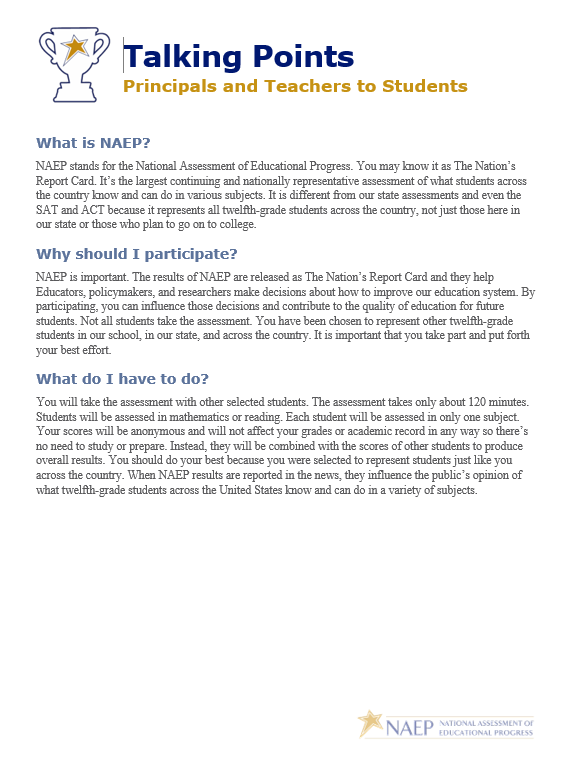
Appendix D-82: NAEP 2026 Best Practices Talking Points Principals to Teachers (NEW)
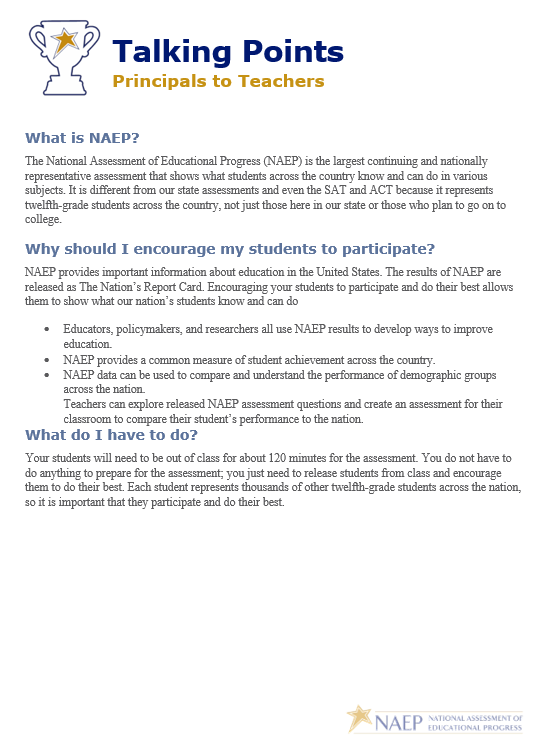
Appendix D-83: NAEP 2026 Best Practices School Announcement Templates (NEW)

Appendix D-84: NAEP 2026 Best Practices High School Incentive Ideas (NEW)

Appendix D-85: NAEP 2026 Best Practices Social Media and Online Communication Sample Announcements (NEW)


Appendix D-86: NAEP 2026 Best Practices NAEP Data, Tools, and Resources (NEW)
[Cover]
NAEP Data Tools and Resources
nationsreportcard.gov
[Page 1]
Do you want to know
how the nation’s students are performing?
how your state is doing compared to other states?
how to find NAEP sample questions?
what a NAEP Proficient student can do?
Whether you’re an educator, member of the media, parent, student, policymaker, or researcher, there are many resources available from the National Assessment of Educational Progress (NAEP) that can help you find exactly what you’re looking for!
NAEP results provide the following:
A
 high-level snapshot of student performance for the nation,
states, and participating districts
on the most recent NAEP assessments
high-level snapshot of student performance for the nation,
states, and participating districts
on the most recent NAEP assessmentsFor example, you’ll see how the percentage of fourth-grade students who reached or exceeded the Proficient level in mathematics grew from 36 percent in 2022 to 39 percent in 2024.
R
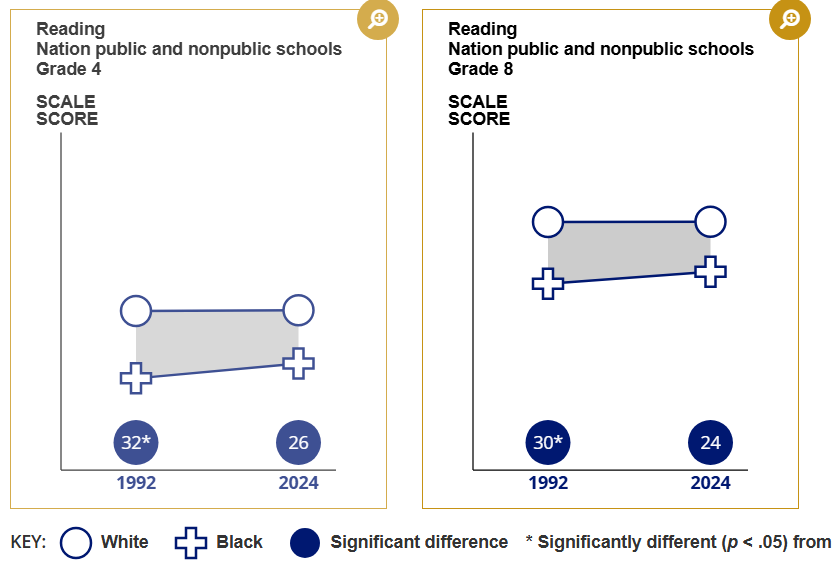 esults
for groups of students with similar characteristics, such as sex,
race or ethnicity,
and student socioeconomic status
esults
for groups of students with similar characteristics, such as sex,
race or ethnicity,
and student socioeconomic status
For example, you can discover how score gains made by Black fourth- and eighth-grade students from 1992 to 2024 contributed to smaller achievement gaps compared to White students.
I
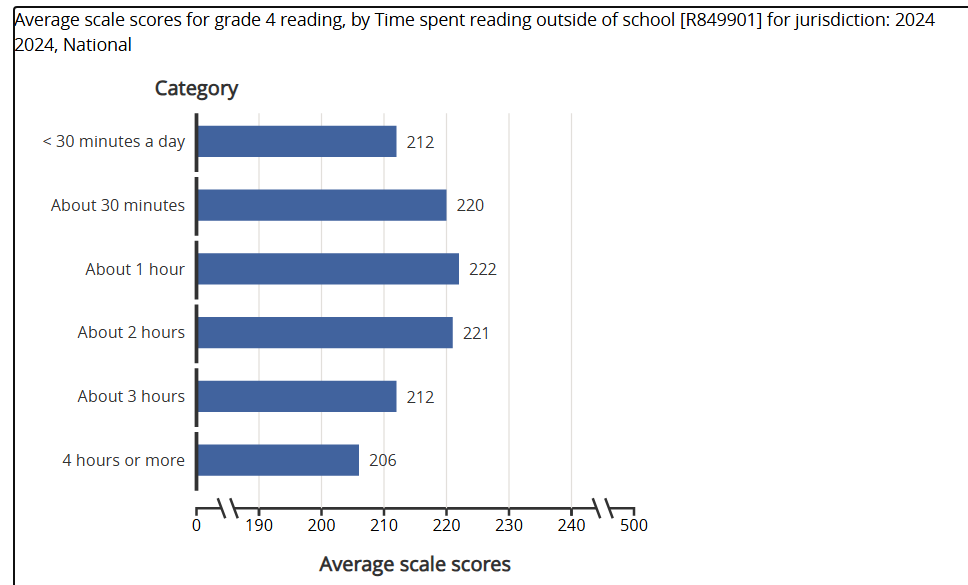 nsights
into students’
educational experiences and
other factors that relate to students’ learning
nsights
into students’
educational experiences and
other factors that relate to students’ learningFor example, you’ll find that fourth-grade students who reported reading outside of school about 1 or 2 hours a day had higher average reading scores in 2024.
[Page 2]
NAEP web tools and resources include the following:
Achievement Gaps Dashboard
Shows the differences in performance between two groups of students, such as male and female students, or White and Black students. https://www.nationsreportcard.gov/dashboards/achievement_gaps.aspx
Data Explorer
Allows users to analyze decades of assessment results and factors that may be related to student learning, as well as create statistical tables, charts, and maps. https://www.nationsreportcard.gov/ndecore/landing
Item Maps
Illustrates the knowledge and skills demonstrated by students performing at different scale scores and each achievement level on NAEP assessments. https://www.nationsreportcard.gov/itemmaps/
Questions Tool
Houses more than 3,000 released NAEP questions and allows users to search for questions by subject, grade, difficulty, and other characteristics; view actual student responses for available questions; and create quizzes for students. https://nces.ed.gov/nationsreportcard/nqt/
State and District Profiles
Provides key information about the characteristics of a state’s or participating district’s students and schools and allows users to create tables and maps to compare state and district results.
State Profiles: https://www.nationsreportcard.gov/profiles/stateprofile
District Profiles: https://www.nationsreportcard.gov/profiles/districtprofile
[Back cover]
The National Assessment of Educational Progress (NAEP) is the largest nationally representative and continuing assessment of what the nation’s students know and can do in various subject areas. Also known as The Nation’s Report Card, it has provided important information about how the nation’s students are performing academically since 1969.
Looking for more detailed data?
Restricted-use data sets are available and include raw data from NAEP and other NCES assessments and surveys. Qualified researchers can obtain a restricted-use data license from NCES to view these data. As part of the license, researchers are legally required to protect the confidentiality of participating schools and students.
For questions, please contact:
IES Data Security Office
Department of Education/IES/NCES
550 12th Street, SW, Room 4060
Washington, DC 20202
202-245-7674
The National Center for Education Statistics (NCES) conducts the National Assessment of Educational Progress to evaluate federally supported education programs. All of the information you provide may only be used for the purposes of research, statistics, and evaluation under the Education Sciences Reform Act of 2002 (ESRA; 20 U.S.C. § 9543) and may not be disclosed, or used, in identifiable form for any other purpose except as required by law. Every NCES employee as well as every NCES agent, such as contractors and NAEP coordinators, has taken an oath and is subject to a jail term of up to 5 years, a fine of $250,000, or both if he or she willfully discloses ANY identifiable information about you in any unauthorized manner. Electronic submission of your information will be monitored for viruses, malware, and other threats by Federal employees and contractors in accordance with the Cybersecurity Enhancement Act of 2015.
[Footer]
Visit nationsreportcard.gov for more!
Follow us on: <Facebook> <Instagram> <LinkedIn> <X> <YouTube>
<IES logo>
<ED logo>
<NAEP logo>
Appendix D-87: NAEP 2026 Facts for Districts (Approved v.36)
2026 Facts for Districts
“NAEP is the only assessment providing half a century of performance data to measure what students know and can do. The state and national trends inform local, state, and national program and policy discussions that improve teaching and learning.”
– David Atherton, EdD, Principal, Clear Creek Middle School, Gresham, OR
What is NAEP?
The National Assessment of Educational Progress (NAEP) is an integral measure of academic progress across the nation and over time. It is the largest nationally representative and continuing assessment of what our nation’s students know and can do in various subjects such as civics, mathematics, reading, science, and U.S. history. The program also provides valuable insights into students’ educational experiences and opportunities to learn in and outside of the classroom.
NAEP is a congressionally mandated program administered by the National Center for Education Statistics (NCES), within the U.S. Department of Education’s Institute of Education Sciences.
How are NAEP results reported?
The results of NAEP are released as The Nation’s Report Card. NAEP results are available for the nation and may be available for states and select urban districts that participate in the Trial Urban District Assessment (TUDA), depending on the assessment. Additionally, results are reported for different student groups, based on factors such as race/ethnicity, sex, school location, and more. NAEP is not designed to report results for individual students, classrooms, or schools.
Why should my district participate in NAEP?
Your district’s participation is vitally important for several reasons.
Results from the 2026 assessments will provide much needed information about the academic achievement and continued recovery of students whose elementary school experiences were impacted by the COVID-19 pandemic.
Schools and students selected to participate in NAEP represent schools and students across the country. Each school’s participation is critical and contributes to the understanding of students’ educational progress across the U.S.
What NAEP assessments will be administered in 2026?
The 2026 program will include
assessments in mathematics and reading at grades 4 and 8;
assessments in civics and U.S. history at grade 8;
pilot testing in mathematics and reading at grades 4, 8, and 12, to help improve future NAEP assessments; and
survey questionnaires for participating students, teachers, and principals to provide a better understanding of factors that may be related to students’ learning.2
The assessments will be administered between January 26 and March 6, 2026.
National, state, and select urban district results will be released for the mathematics and reading assessments at grades 4 and 8. National results will be released for the civics and U.S. history assessments at grade 8. Results from the pilot testing will not be released but will be used to inform future assessments.
What will students in my district do?
Participating students will complete
assessment items in civics, mathematics, reading, or U.S. history; and, if applicable,
survey questionnaires that provide valuable information about their educational experiences and opportunities to learn both in and outside of the classroom.
Students are given approximately 2 hours to complete the assessments unless accommodations are provided. This includes transition time, directions, and completion of survey questionnaires. A broad range of accommodations are provided for students with disabilities and English learners.
Students will take assessments using school devices or NAEP devices. NAEP representatives will contact your district in the coming months with more information.
Do teachers need to prepare students for the assessment?
Teachers do not need to prepare their students to take the assessment but should encourage them to do their best.
Who will administer NAEP? What do schools need to provide on the day of the assessment?
NAEP representatives will administer the NAEP assessment and provide significant support to schools on assessment day. Schools will need to provide space for students to take the assessment, desks or tables, and an adequate number of electrical outlets in the assessment location.
In schools where the assessment will be administered using school devices, school and/or district staff who have experience with the devices and technology used by the school may be required to be available during the testing session(s).
In schools where the assessment will be administered using NAEP devices, NAEP representatives will bring all necessary materials and equipment to assess the students.
How were schools in my district selected for NAEP?
Schools were selected as part of a carefully designed sampling process that ensures NAEP-selected schools and students are representative of your district, state, and the nation.
Under the Elementary and Secondary Education Act, districts and states that receive Title I funds are required to participate in the biennial assessments.
How can school administrators and teachers use NAEP data to help our students?
The NAEP Data Explorer (https://www.nationsreportcard.gov/ndecore) is a powerful tool that allows you to examine the relationships between student performance and factors such as instructional practices, school resources, and more.
Questions from previous NAEP assessments can also be used as a helpful educational resource in the classroom. Teachers can use the NAEP Questions Tool (http://nces.ed.gov/nationsreportcard/nqt) to see how their students’ performance compares to peers in your state and across the nation. Released NAEP questions come with a scoring guide, sample student responses, and performance data.
How long has NAEP been around?
NAEP was first administered in 1969 to measure student achievement nationally. In 1990, NAEP was administered at the state level for the first time. The NAEP TUDA program, which measures student achievement in some of the nation’s large urban districts, began in 2002.
Where can I find more information?
Learn more about the NAEP program at nces.ed.gov/nationsreportcard, and explore the latest NAEP results at nationsreportcard.gov.
You can also find NAEP on: <Facebook logo> <Instagram logo> <LinkedIn logo> <X logo> <YouTube logo>
The National Center for Education Statistics (NCES) conducts the National Assessment of Educational Progress to evaluate federally supported education programs. All of the information you provide may only be used for the purposes of research, statistics, and evaluation under the Education Sciences Reform Act of 2002 (ESRA; 20 U.S.C. § 9543) and may not be disclosed, or used, in identifiable form for any other purpose except as required by law. Every NCES employee as well as every NCES agent, such as contractors and NAEP coordinators, has taken an oath and is subject to a jail term of up to 5 years, a fine of $250,000, or both if he or she willfully discloses ANY identifiable information about you in any unauthorized manner. Electronic submission of your information will be monitored for viruses, malware, and other threats by Federal employees and contractors in accordance with the Cybersecurity Enhancement Act of 2015.
This publication was prepared for the National Assessment of Educational Progress by Manhattan Strategy Group under contract 91990018C0001 to the National Center for Education Statistics, U.S. Department of Education.
Appendix D-88: NAEP 2026 Facts for Districts, Puerto Rico (NEW)
2026 Información para los distritos
"NAEP es la única evaluación que proporciona medio siglo de datos de rendimiento para medir lo que los estudiantes saben y pueden hacer. Las tendencias estatales y nacionales orientan las discusiones de programas y políticas locales, estatales y nacionales que mejoran la enseñanza y el aprendizaje".
- David Atherton, Doctor en educación, Clear Creek Middle School, Greshan, Oregón
¿Qué es NAEP?
La Evaluación Nacional del Progreso Educativo (NAEP, por sus siglas en inglés) es una medida integral del progreso educativo en toda la nación y a lo largo del tiempo. Es la evaluación continua y nacionalmente representativa más grande que mide lo que los estudiantes de nuestro país saben y pueden hacer en diferentes materias, tales como educación cívica, matemáticas, lectura, ciencia e historia de Estados Unidos. El programa también proporciona información valiosa sobre las experiencias educativas de los estudiantes y las oportunidades de aprendizaje dentro y fuera del salón de clases.
NAEP es un proyecto autorizado por el Congreso y administrado por el Centro Nacional para Estadísticas de la Educación (NCES, por sus siglas en inglés), parte del Departamento de Educación de Estados Unidos y el Instituto de Ciencias de la Educación.
¿Cómo se informan los resultados de NAEP?
Los resultados de NAEP se publican en un informe llamado la Libreta de Calificaciones de la Nación. Dependiendo de la evaluación, los resultados de NAEP están disponibles a nivel nacional y pueden estar disponibles a nivel estatal y para determinados distritos urbanos que participan en la Evaluación Piloto de Distritos Urbanos (TUDA, por sus siglas en inglés). Además, los resultados se informan para diferentes grupos de estudiantes con base en factores como la raza/grupo étnico, el sexo y la ubicación de la escuela, entre otros. NAEP no está diseñada para informar los resultados individuales de estudiantes, salones de clase o escuelas.
¿Por qué mi distrito debería participar en NAEP?
La participación de su distrito es de vital importancia por varios motivos.
Los resultados de las evaluaciones de 2026 proporcionarán información muy necesaria sobre el rendimiento académico y la recuperación continua de los estudiantes cuyas experiencias en la escuela elemental se vieron afectadas por la pandemia de COVID-19.
Las escuelas y los estudiantes seleccionados para participar en NAEP representan a las escuelas y a los estudiantes de todo el país. La participación de cada escuela es fundamental y contribuye a la comprensión del progreso educativo de los estudiantes en todo Estados Unidos y Puerto Rico.
¿Qué evaluaciones de NAEP se administrarán en Puerto Rico en 2026?
El programa de 2026 incluirá:
evaluaciones de matemáticas;
prueba piloto de matemáticas en 4.° y 8.° grado, para ayudar a mejorar futuras evaluaciones de NAEP; y
cuestionarios de contexto para estudiantes, maestros y directores participantes, para comprender mejor los factores que pueden estar relacionados con el aprendizaje de los estudiantes.
Las evaluaciones se realizarán entre el 26 de enero y el 20 de marzo de 2026.
Los resultados nacionales, estatales y de distritos urbanos seleccionados se publicarán para las evaluaciones de matemáticas en 4.° y 8.° grado. Los resultados de las pruebas piloto no se darán a conocer, pero servirán para orientar futuras evaluaciones.
¿Qué harán los estudiantes en mi distrito?
Los estudiantes participantes completarán:
preguntas sobre matemáticas; y
cuestionarios de contexto que proporcionan información valiosa sobre sus experiencias educativas y oportunidades de aprendizaje tanto dentro como fuera del salón de clase.
Los estudiantes tienen aproximadamente 2 horas para completar las evaluaciones a menos que se proporcionen acomodos. Se ofrece una amplia gama de acomodos para los estudiantes con impedimentos y para aprendices del español.
Los estudiantes tomarán las evaluaciones utilizando dispositivos de la escuela o dispositivos de NAEP. Los representantes de NAEP se comunicarán con su distrito en los próximos meses para brindarle más información.
¿Es necesario que los maestros preparen a los estudiantes para la evaluación?
Los maestros no tienen que preparar a sus estudiantes para la evaluación, pero sí deben motivarlos a que hagan su mejor esfuerzo.
¿Quién administrará NAEP? ¿Qué deben proporcionar las escuelas el día de la evaluación?
El personal de NAEP administrará la evaluación y proporcionará un importante apoyo a las escuelas el día de la evaluación. Las escuelas deberán proporcionar espacio para que los estudiantes tomen la evaluación, escritorios o mesas, y un número adecuado de tomas de corriente en el lugar de la evaluación.
En las escuelas donde la evaluación se administrará utilizando dispositivos de la escuela, se puede requerir que el personal de la escuela o del distrito que tenga experiencia con los dispositivos y la tecnología utilizados por la escuela esté disponible durante la(s) sesión(es) de prueba.
En las escuelas donde la evaluación se administrará utilizando dispositivos de NAEP, los representantes de NAEP traerán todos los materiales y equipos necesarios para evaluar a los estudiantes.
¿Cómo se seleccionaron las escuelas de mi distrito para NAEP?
Las escuelas fueron seleccionadas como parte de un proceso de muestreo cuidadosamente diseñado que garantiza que las escuelas y los estudiantes seleccionados para NAEP representan a su distrito, al estado y a la nación.
En virtud de la Ley de Educación Primaria y Secundaria, se requiere que los distritos y estados que reciben fondos del Título I participen en las evaluaciones bienales. NAEP requiere que Puerto Rico participe solo en la evaluación de matemáticas. El Departamento de Educación de Estados Unidos eximió a Puerto Rico de participar en la evaluación de lectura, ya que esta mide la capacidad de un estudiante para leer inglés, sin embargo, el español es el idioma de enseñanza en Puerto Rico.
¿Cómo pueden los administradores escolares y los maestros utilizar los datos de NAEP para ayudar a nuestros estudiantes?
El Explorador de datos de NAEP (https://www.nationsreportcard.gov/ndecorev) es una poderosa herramienta que le permite examinar las relaciones entre el rendimiento de los estudiantes y factores tales como las prácticas de enseñanza y los recursos escolares, entre otros.
Las preguntas de evaluaciones de NAEP anteriores también pueden utilizarse como un recurso educativo útil en el salón de clases. Los maestros pueden utilizar la herramienta NAEP Questions Tool (http://nces.ed.gov/nationsreportcard/nqt) para ver cómo se compara el rendimiento de sus estudiantes con el de otros estudiantes en su estado y en todo el país. Las preguntas de NAEP publicadas incluyen una guía de puntuación, ejemplos de respuestas de los estudiantes y datos de rendimiento.
¿Desde cuándo existe NAEP?
NAEP se administró por primera vez en 1969 para medir los logros de los estudiantes a nivel nacional. En 1990, NAEP se administró por primera vez a nivel estatal.
¿Dónde puedo encontrar más información?
Conozca más sobre el programa NAEP en nces.ed.gov/nationsreportcard/puertorico y explore los últimos resultados de NAEP en nationsreportcard.gov.
También puede encontrar a NAEP en: <Facebook logo> <Instagram logo> <LinkedIn logo> <X logo> <YouTube logo>
El Centro Nacional para Estadísticas de la Educación (NCES, por sus siglas en inglés) administra la Evaluación Nacional del Progreso Educativo para evaluar programas de educación apoyados por el Gobierno federal. Toda la información que proporcione podrá usarse únicamente con fines de investigación, estadísticas y evaluación en virtud de la Ley de Reforma de las Ciencias Educativas de 2002 (ERSA; 20 U.S.C §9573) y no podrá darse a conocer para identificarlo ni para cualquier otro propósito salvo aquel requerido legalmente. Todos los empleados de NCES al igual que todos los representantes del mismo, como contratistas y coordinadores de NAEP, han hecho un juramento y están sujetos a una pena de prisión de hasta 5 años, una multa de hasta $250,000 o ambas cosas, si dan a conocer intencionalmente CUALQUIER información que lo identifique de manera no autorizada. El envío de su información por vía electrónica será monitoreado por empleados y contratistas federales para detectar virus, programas maliciosos (malware) y otras amenazas conforme a la Ley de Mejoramiento de la Seguridad Cibernética de 2015.
Esta publicación fue preparada para la Evaluación Nacional del Progreso Educativo por Manhattan Strategy Group bajo el contrato 91990018C0001 con el Centro Nacional para Estadísticas de la Educación, Departamento de Educación de Estados Unidos.
Appendix D-89: NAEP 2026 Facts for Principals (Approved v.36)
NAEP 2026
Facts for Principals
Grades 4 and 8 Mathematics and Reading
Page One Sidebar
NAEP is an integral part of education in the United States.
Elected officials, policymakers, and educators all use NAEP results to inform ways to improve education.
NAEP is a congressionally mandated program administered by the National Center for Education Statistics (NCES), within the U.S. Department of Education’s Institute of Education Sciences.
NAEP serves a different role than state assessments. While states have their own unique assessments with different content standards, the same NAEP assessment is administered in every state, providing a common measure of student achievement.
Depending on the type of NAEP assessment that is administered, NAEP data are available for the nation, your state, districts that participate in the Trial Urban District Assessment (TUDA), and student groups. NAEP is not designed to report results for individual students, classrooms, or schools.
To provide a better understanding of educational experiences and factors that may be related to students’ learning, students, teachers, and principals who participate in NAEP are asked to complete survey questionnaires.
Page One Body
“NAEP is the only assessment providing half-a-century of performance data to measure what students know and can do. The state and national trends inform local, state, and national program and policy discussions that improve teaching and learning.”
David Atherton, EdD, Principal, Clear Creek Middle School, Gresham, OR
What is NAEP?
The National Assessment of Educational Progress (NAEP) is the largest nationally representative and continuing assessment of what our nation’s students know and can do in various subjects such as civics, mathematics, reading, science, and U.S. history. The results of NAEP are released as The Nation’s Report Card.
What can principals and schools expect?
NAEP representatives will provide significant support to your school on assessment day. As principals, you make an important contribution to the program by selecting and empowering a NAEP school coordinator, meeting with teachers and participating students, and encouraging your students to participate and do their best. You are essential partners in NAEP. Each school’s participation is critical and contributes to the understanding of students’ educational progress across the U.S.
In 2026, students in grades 4 and 8 will take NAEP mathematics and reading assessments. Each student will be assessed in only one subject. The assessments will be administered by NAEP representatives on school devices or NAEP devices. NAEP representatives will contact your school in the coming months with more information.
Schools will need to provide space for students to take the assessment, desks or tables, and an adequate number of electrical outlets in the assessment location. NAEP representatives will use school devices and Internet—when possible—to conduct the assessment. They will work with you or your district to determine if this is feasible for your school.
As part of the assessments, students may be asked to complete NAEP survey questionnaires that provide valuable information about participating students’ educational experiences and opportunities to learn both in and outside of the classroom.
Results in mathematics and reading will be released for the nation, states, and selected urban districts.
For more information about NAEP, visit www.nces.ed.gov/nationsreportcard.
Page Two Body
NAEP was first administered in 1969 to measure student achievement nationally. In 1990, NAEP was administered at the state level for the first time. Students in grades 4 and 8 are currently assessed at the national and state level in mathematics and reading every 2 years and in other subjects periodically. The NAEP TUDA program, which measures student achievement in some of the nation’s large urban districts, began in 2002.
From the development of assessment frameworks and questions to the reporting of results, NAEP delivers high technical quality and represents the best thinking of assessment and content specialists, state education staff, and teachers from around the nation. NAEP is a trusted resource that measures student progress and helps inform policy decisions that improve education in the United States.
How are NAEP results reported? NAEP results are reported for different demographic groups rather than for individual students or schools. Within a school, just some of the student population participates, and student responses are combined with those from other participating students to produce the results.
How are schools and students selected for NAEP? A carefully designed sampling process ensures that NAEP-selected schools and students are representative of all schools and students in their district, state, and across the United States. To ensure the sample represents all students in the nation’s schools, a broad range of accommodations are allowed for students with disabilities and English learners.
What can teachers and students expect? Including transition time, directions and tutorials, and completion of survey questions, it takes approximately 2 hours for students to complete the assessment. Teachers do not need to prepare their students to take the assessment but should encourage them to do their best. NAEP representatives provide significant support to your school by working with the designated coordinator in your school to organize assessment activities.
How can educators use NAEP resources to help students? Released NAEP items can be used as a helpful educational resource in the classroom. Teachers and district staff can use the NAEP Questions Tool (http://nces.ed.gov/nationsreportcard/nqt) to create a test and see how your students’ performance compares nationally on specific items. Released NAEP items come with a scoring guide, sample student responses, and performance data.
Visit the NAEP website at http://nces.ed.gov/nationsreportcard to access this information and more.
The National Center for Education Statistics (NCES) conducts the National Assessment of Educational Progress to evaluate federally supported education programs. All of the information you provide may only be used for the purposes of research, statistics, and evaluation under the Education Sciences Reform Act of 2002 (ESRA; 20 U.S.C. § 9543) and may not be disclosed, or used, in identifiable form for any other purpose except as required by law. Every NCES employee as well as every NCES agent, such as contractors and NAEP coordinators, has taken an oath and is subject to a jail term of up to 5 years, a fine of $250,000, or both if he or she willfully discloses ANY identifiable information about you in any unauthorized manner. Electronic submission of your information will be monitored for viruses, malware, and other threats by Federal employees and contractors in accordance with the Cybersecurity Enhancement Act of 2015.
Page Two Footer
Find us on: [insert social media icons]
This publication was prepared for the National Assessment of Educational Progress by Manhattan Strategy Group under contract 91990018C0001 to the National Center for Education Statistics, U.S. Department of Education.
NAEP 2026
Facts for Principals
Grade 8 Civics and U.S. History
Page One Sidebar
NAEP is an integral part of education in the United States.
Elected officials, policymakers, and educators all use NAEP results to inform ways to improve education.
NAEP is a congressionally mandated program administered by the National Center for Education Statistics (NCES), within the U.S. Department of Education’s Institute of Education Sciences.
NAEP serves a different role than state assessments. While states have their own unique assessments with different content standards, the same NAEP assessment is administered in every state, providing a common measure of student achievement.
Depending on the type of NAEP assessment that is administered, NAEP data are available for the nation, your state, districts that participate in the Trial Urban District Assessment (TUDA), and student groups. NAEP is not designed to report results for individual students, classrooms, or schools.
To provide a better understanding of educational experiences and factors that may be related to students’ learning, students, teachers, and principals who participate in NAEP are asked to complete survey questionnaires.
Page One Body
“NAEP is the only assessment providing half-a-century of performance data to measure what students know and can do. The state and national trends inform local, state, and national program and policy discussions that improve teaching and learning.”
David Atherton, EdD, Principal, Clear Creek Middle School, Gresham, OR
Visit https://nces.ed.gov/nationsreportcard/about/covid19.aspx for more information about NAEP health and safety protocols.
What is NAEP?
The National Assessment of Educational Progress (NAEP) is the largest nationally representative and continuing assessment of what our nation’s students know and can do in various subjects such as civics, mathematics, reading, science, and U.S. history. The results of NAEP are released as The Nation’s Report Card.
What can principals and schools expect?
NAEP representatives will provide significant support to your school on assessment day. As principals, you make an important contribution to the program by selecting and empowering a NAEP school coordinator, meeting with teachers and participating students, and encouraging your students to participate and do their best. You are essential partners in NAEP. Each school’s participation is critical and contributes to the understanding of students’ educational progress across the U.S.
In 2026, grade 8 students will take NAEP assessments in civics and U.S. history. The assessments will be administered by NAEP representatives on NAEP devices. NAEP representatives will contact your school in the coming months with more information.
Schools will need to provide space for students to take the assessment, desks or tables, and an adequate number of electrical outlets in the assessment location.
As part of the assessments, students may be asked to complete NAEP survey questionnaires that provide valuable information about participating students’ educational experiences and opportunities to learn both in and outside of the classroom.
Results in civics and U.S. history will be released for the nation.
For more information about NAEP, visit www.nces.ed.gov/nationsreportcard.
Page Two Body
NAEP was first administered in 1969 to measure student achievement nationally. In 1990, NAEP was administered at the state level for the first time. Students in grades 4 and 8 are currently assessed at the national and state level in mathematics and reading every 2 years and in other subjects periodically. The NAEP TUDA program, which measures student achievement in some of the nation’s large urban districts, began in 2002.
From the development of assessment frameworks and questions to the reporting of results, NAEP delivers high technical quality and represents the best thinking of assessment and content specialists, state education staff, and teachers from around the nation. NAEP is a trusted resource that measures student progress and helps inform policy decisions that improve education in the United States.
How are NAEP results reported? NAEP results are reported for different demographic groups rather than for individual students or schools. Within a school, just some of the student population participates, and student responses are combined with those from other participating students to produce the results.
How are schools and students selected for NAEP? A carefully designed sampling process ensures that NAEP-selected schools and students are representative of all schools and students in their district, state, and across the United States. To ensure that the sample represents all students in the nation’s schools, a broad range of accommodations are allowed for students with disabilities and English learners.
What can teachers and students expect? Including transition time, directions and tutorials, and completion of survey questions, it takes approximately 2 hours for students to complete the assessment. Teachers do not need to prepare their students to take the assessment but should encourage them to do their best. NAEP representatives provide significant support to your school by working with the designated coordinator in your school to organize assessment activities.
How can educators use NAEP resources to help students? Released NAEP items can be used as a helpful educational resource in the classroom. Teachers and district staff can use the NAEP Questions Tool (http://nces.ed.gov/nationsreportcard/nqt) to create a test and see how your students’ performance compares nationally on specific items. Released NAEP items come with a scoring guide, sample student responses, and performance data.
Visit the NAEP website at http://nces.ed.gov/nationsreportcard to access this information and more.
The National Center for Education Statistics (NCES) conducts the National Assessment of Educational Progress to evaluate federally supported education programs. All of the information you provide may only be used for the purposes of research, statistics, and evaluation under the Education Sciences Reform Act of 2002 (ESRA; 20 U.S.C. § 9543) and may not be disclosed, or used, in identifiable form for any other purpose except as required by law. Every NCES employee as well as every NCES agent, such as contractors and NAEP coordinators, has taken an oath and is subject to a jail term of up to 5 years, a fine of $250,000, or both if he or she willfully discloses ANY identifiable information about you in any unauthorized manner. Electronic submission of your information will be monitored for viruses, malware, and other threats by Federal employees and contractors in accordance with the Cybersecurity Enhancement Act of 2015.
Page Two Footer
Find us on: [insert social media icons]
This publication was prepared for the National Assessment of Educational Progress by Manhattan Strategy Group under contract 91990018C0001 to the National Center for Education Statistics, U.S. Department of Education.
NAEP 2026
Facts for Principals
Pilot
Page One Sidebar
NAEP is an integral part of education in the United States.
Elected officials, policymakers, and educators all use NAEP results to inform ways to improve education.
NAEP is a congressionally mandated program administered by the National Center for Education Statistics (NCES), within the U.S. Department of Education’s Institute of Education Sciences.
NAEP serves a different role than state assessments. While states have their own unique assessments with different content standards, the same NAEP assessment is administered in every state, providing a common measure of student achievement.
Depending on the type of NAEP assessment that is administered, NAEP data are available for the nation, your state, districts that participate in the Trial Urban District Assessment (TUDA), and student groups. NAEP is not designed to report results for individual students, classrooms, or schools.
To provide a better understanding of educational experiences and factors that may be related to students’ learning, students, teachers, and principals who participate in NAEP are asked to complete survey questionnaires.3
Page One Body
“NAEP is the only assessment providing half-a-century of performance data to measure what students know and can do. The state and national trends inform local, state, and national program and policy discussions that improve teaching and learning.”
David Atherton, EdD, Principal, Clear Creek Middle School, Gresham, OR
Visit https://nces.ed.gov/nationsreportcard/about/covid19.aspx for more information about NAEP health and safety protocols.
What is NAEP?
The National Assessment of Educational Progress (NAEP) is the largest nationally representative and continuing assessment of what our nation’s students know and can do in various subjects such as civics, mathematics, reading, science, and U.S. history. The results of NAEP are released as The Nation’s Report Card.
What can principals and schools expect?
NAEP representatives will provide significant support to your school on assessment day. As principals, you make an important contribution to the program by selecting and empowering a NAEP school coordinator, meeting with teachers and participating students, and encouraging your students to participate and do their best. You are essential partners in NAEP. Each school’s participation is critical and contributes to the understanding of students’ educational progress across the U.S.
In 2026, NCES will conduct pilot testing in mathematics and reading at grades 4, 8, and 12. This testing will help improve future NAEP assessments and ensure that they continue to be a reliable measure of student achievement. The pilot test will be administered by NAEP representatives on school devices or NAEP devices. NAEP representatives will contact your school in the coming months with more information.
Schools will need to provide space for students to take the assessment, desks or tables, and an adequate number of electrical outlets in the assessment location.
As part of the assessments, students may be asked to complete NAEP survey questionnaires that provide valuable information about participating students’ educational experiences and opportunities to learn both in and outside of the classroom.
Results from the field test will not be released but will be used to inform future NAEP assessments.
For more information about NAEP, visit www.nces.ed.gov/nationsreportcard.
Page Two Body
NAEP was first administered in 1969 to measure student achievement nationally. In 1990, NAEP was administered at the state level for the first time. Students in grades 4 and 8 are currently assessed at the national and state level in mathematics and reading every 2 years and in other subjects periodically. The NAEP TUDA program, which measures student achievement in some of the nation’s large urban districts, began in 2002.
From the development of assessment frameworks and questions to the reporting of results, NAEP delivers high technical quality and represents the best thinking of assessment and content specialists, state education staff, and teachers from around the nation. NAEP is a trusted resource that measures student progress and helps inform policy decisions that improve education in the United States.
How are NAEP results reported? NAEP results are reported for different demographic groups rather than for individual students or schools. Within a school, just some of the student population participates, and student responses are combined with those from other participating students to produce the results.
How are schools and students selected for NAEP? A carefully designed sampling process ensures that NAEP-selected schools and students are representative of all schools and students in their district, state, and across the United States. To ensure that the sample represents all students in the nation’s schools, a broad range of accommodations are allowed for students with disabilities and English learners.
What can teachers and students expect? Including transition time, directions and tutorials, and completion of survey questions, it takes approximately 2 hours for students to complete the assessment. Teachers do not need to prepare their students to take the assessment but should encourage them to do their best. NAEP representatives provide significant support to your school by working with the designated coordinator in your school to organize assessment activities.
How can educators use NAEP resources to help students? Released NAEP items can be used as a helpful educational resource in the classroom. Teachers and district staff can use the NAEP Questions Tool (http://nces.ed.gov/nationsreportcard/nqt) to create a test and see how your students’ performance compares nationally on specific items. Released NAEP items come with a scoring guide, sample student responses, and performance data.
Visit the NAEP website at http://nces.ed.gov/nationsreportcard to access this information and more.
The National Center for Education Statistics (NCES) conducts the National Assessment of Educational Progress to evaluate federally supported education programs. All of the information you provide may only be used for the purposes of research, statistics, and evaluation under the Education Sciences Reform Act of 2002 (ESRA; 20 U.S.C. § 9543) and may not be disclosed, or used, in identifiable form for any other purpose except as required by law. Every NCES employee as well as every NCES agent, such as contractors and NAEP coordinators, has taken an oath and is subject to a jail term of up to 5 years, a fine of $250,000, or both if he or she willfully discloses ANY identifiable information about you in any unauthorized manner. Electronic submission of your information will be monitored for viruses, malware, and other threats by Federal employees and contractors in accordance with the Cybersecurity Enhancement Act of 2015.
Page Two Footer
Find us on: [insert social media icons]
This publication was prepared for the National Assessment of Educational Progress by Manhattan Strategy Group under contract 91990018C0001 to the National Center for Education Statistics, U.S. Department of Education.
Appendix D-90: NAEP 2026 Facts for Principals, Puerto Rico (NEW)
NAEP 2026
Información general para los directores
4.° y 8.° grado Matemáticas
Page One Sidebar
NAEP es una parte esencial de la educación en Estados Unidos y Puerto Rico.
Los funcionarios electos, los legisladores y los educadores usan los resultados de NAEP para informar maneras de mejorar la educación.
NAEP es un proyecto autorizado por el Congreso y administrado por el Centro Nacional para Estadísticas de la Educación (NCES, por sus siglas en inglés), parte del Instituto de Ciencias de la Educación del Departamento de Educación de Estados Unidos.
NAEP desempeña un papel diferente al de las evaluaciones estatales. Si bien cada estado tiene su propia y única evaluación, con diferentes estándares de contenido, la misma evaluación NAEP se administra en cada estado, proporcionando una medida común de los logros de los estudiantes.
Dependiendo del tipo de evaluación NAEP que se administre, los datos de NAEP están disponibles para la nación, su estado, los distritos que participan en la Evaluación Piloto de Distritos Urbanos (TUDA) y grupos de estudiantes. NAEP no está diseñada para informar los resultados individuales de ningún estudiante, clase o escuela.
A los estudiantes, maestros y directores que participan en NAEP se les pide que completen cuestionarios que proporcionan una mayor comprensión de las experiencias educativas y de los factores que podrían estar relacionados con el aprendizaje estudiantil.
Page One Body
“NAEP es la única evaluación que proporciona medio siglo de datos de rendimiento para medir lo que los estudiantes saben y pueden hacer. Las tendencias estatales y nacionales orientan las discusiones de programas y políticas locales, estatales y nacionales que mejoran la enseñanza y el aprendizaje".
David Atherton, Doctor en educación, Clear Creek Middle School, Greshan, Oregón
¿Qué es NAEP?
La Evaluación Nacional del Progreso Educativo (NAEP, por sus siglas en inglés) es la evaluación continua y nacionalmente representativa más grande que mide lo que los estudiantes de nuestro país saben y pueden hacer en diferentes materias, tales como educación cívica, matemáticas, lectura, ciencias e historia de Estados Unidos. Los resultados de NAEP se publican en un informe llamado la Libreta de Calificaciones de la Nación. NAEP requiere que Puerto Rico participe solo en la evaluación de matemáticas. El Departamento de Educación de Estados Unidos eximió a Puerto Rico de participar en la evaluación de lectura, ya que esta mide la capacidad de un estudiante para leer inglés, sin embargo, el español es el idioma de instrucción en Puerto Rico.
¿Qué pueden esperar los directores y las escuelas?
Los representantes de NAEP le proporcionarán bastante apoyo a su escuela el día de la evaluación. Como directores, ustedes hacen una contribución importante al programa al seleccionar y facultar al coordinador escolar de NAEP, al reunirse con los maestros y estudiantes participantes y al animar a sus estudiantes a participar y a que hagan su mejor esfuerzo. Ustedes son aliados fundamentales para NAEP. La participación de cada escuela es fundamental y contribuye a la comprensión del progreso educativo de los estudiantes en todo el país.
En el 2026, los estudiantes de 4.° grado y 8.° grado tomarán la evaluación de matemáticas de NAEP. Los representantes de NAEP administrarán la evaluación en dispositivos de la escuela o en dispositivos de NAEP. Los representantes de NAEP se comunicarán con su escuela en los próximos meses con más información.
Las escuelas deberán proporcionar espacio para que los estudiantes tomen la evaluación, pupitres o mesas, y un número adecuado de tomas de corriente en el lugar de la evaluación. Los representantes de NAEP utilizarán los dispositivos de la escuela e Internet, cuando sea posible, para realizar la evaluación. Trabajarán con usted o con su distrito para determinar si esto es factible para su escuela.
Como parte de las evaluaciones, a los estudiantes se les podría pedir que completen cuestionarios de contexto de NAEP que proporcionan información valiosa sobre las experiencias educativas de los estudiantes y las oportunidades de aprendizaje dentro y fuera del salón de clase.
Los resultados de matemáticas se publicarán a nivel nacional, estatal y distritos urbanos seleccionados.
Para más información acerca de NAEP, visite www.nces.ed.gov/nationsreportcard/puertorico/.
Page Two Body
NAEP se administró por primera vez en 1969 para medir el rendimiento estudiantil a nivel nacional. En 1990, NAEP se administró a nivel estatal por primera vez. Actualmente se evalúa a los estudiantes de 4.° y 8.° grado a nivel nacional y estatal en matemáticas y lectura cada 2 años y en otras materias de manera periódica.
Desde el desarrollo de los marcos teóricos y las preguntas de la evaluación hasta la publicación de los resultados, NAEP ofrece una alta calidad técnica y representa las mejores ideas de especialistas de evaluación y de contenido, del personal estatal de educación y de maestros de todo el país. NAEP es un recurso confiable que mide el progreso estudiantil y que contribuye a informar la toma de decisiones sobre políticas que mejoren la educación de Estados Unidos y Puerto Rico.
¿Cómo se informan los resultados de NAEP? NAEP informa los resultados de distintos grupos demográficos en vez de los resultados individuales de estudiantes o escuelas. En una escuela, solamente algunos de los estudiantes participan y las respuestas de los estudiantes se combinan con las de otros estudiantes participantes para producir los resultados.
¿Cómo se seleccionan las escuelas y los estudiantes para NAEP? Un proceso de muestreo cuidadosamente diseñado garantiza que las escuelas y los estudiantes seleccionados para NAEP representan a todas las escuelas y estudiantes en Estados Unidos y Puerto Rico. Para asegurar que la muestra represente a todos los estudiantes en las escuelas del país, NAEP permite una gran variedad de acomodos para estudiantes con impedimentos y aprendices del español.
¿Qué pueden esperar los maestros y estudiantes? Incluyendo el tiempo de transición, las instrucciones y tutoriales y el contestar un cuestionario de contexto, a los estudiantes les toma aproximadamente 2 horas completar la evaluación. Los maestros no tienen que preparar a sus estudiantes para que tomen la evaluación, pero sí deben motivarlos a que hagan su mejor esfuerzo. Los representantes de NAEP le brindan un gran apoyo a su escuela al trabajar con el coordinador escolar designado para organizar las actividades de la evaluación.
Visite la página web de NAEP en http://nces.ed.gov/nationsreportcard/puertorico/ para ver esta y más información.
El Centro Nacional para Estadísticas de la Educación (NCES, por sus siglas en inglés) administra la Evaluación Nacional del Progreso Educativo para evaluar programas de educación apoyados por el Gobierno federal. Toda la información que proporcione podrá usarse únicamente con fines de investigación, estadísticas y evaluación en virtud de la Ley de Reforma de las Ciencias Educativas de 2002 (ERSA; 20 U.S.C §9573) y no podrá darse a conocer para identificarlo ni para cualquier otro propósito salvo aquel requerido legalmente. Todos los empleados de NCES al igual que todos los representantes del mismo, como contratistas y coordinadores de NAEP, han hecho un juramento y están sujetos a una pena de prisión de hasta 5 años, una multa de hasta $250,000 o ambas cosas, si dan a conocer intencionalmente CUALQUIER información que lo identifique de manera no autorizada. El envío de su información por vía electrónica será monitoreado por empleados y contratistas federales para detectar virus, programas maliciosos (malware) y otras amenazas conforme a la Ley de Mejoramiento de la Seguridad Cibernética de 2015.
Page Two Footer
Encuéntrenos en: [insert social media icons]
Esta publicación fue preparada para la Evaluación Nacional del Progreso Educativo por Manhattan Strategy Group bajo el contrato 91990018C0001 para el Centro Nacional de Estadísticas de la Educación, Departamento de Educación de Estados Unidos.
NAEP 2026
Información general para los directores
Piloto
Page One Sidebar
NAEP es una parte esencial de la educación en Estados Unidos y Puerto Rico.
Los funcionarios electos, los legisladores y los educadores usan los resultados de NAEP para informar maneras de mejorar la educación.
NAEP es un proyecto autorizado por el Congreso y administrado por el Centro Nacional para Estadísticas de la Educación (NCES, por sus siglas en inglés), parte del Instituto de Ciencias de la Educación del Departamento de Educación de Estados Unidos.
NAEP desempeña un papel diferente al de las evaluaciones estatales. Si bien cada estado tiene su propia y única evaluación, con diferentes estándares de contenido, la misma evaluación NAEP se administra en cada estado, proporcionando una medida común de los logros de los estudiantes.
Dependiendo del tipo de evaluación NAEP que se administre, los datos de NAEP están disponibles para la nación, su estado, los distritos que participan en la Evaluación Piloto de Distritos Urbanos (TUDA) y grupos de estudiantes. NAEP no está diseñada para informar los resultados individuales de ningún estudiante, clase o escuela.
A los estudiantes, maestros y directores que participan en NAEP se les pide que completen cuestionarios que proporcionan una mayor comprensión de las experiencias educativas y de los factores que podrían estar relacionados con el aprendizaje estudiantil.
Page One Body
“NAEP es la única evaluación que proporciona medio siglo de datos de rendimiento para medir lo que los estudiantes saben y pueden hacer. Las tendencias estatales y nacionales orientan las discusiones de programas y políticas locales, estatales y nacionales que mejoran la enseñanza y el aprendizaje".
David Atherton, Doctor en educación, Clear Creek Middle School, Greshan, Oregón
¿Qué es NAEP?
La Evaluación Nacional del Progreso Educativo (NAEP, por sus siglas en inglés) es la evaluación continua y nacionalmente representativa más grande que mide lo que los estudiantes de nuestro país saben y pueden hacer en diferentes materias, tales como educación cívica, matemáticas, lectura, ciencias e historia de Estados Unidos. Los resultados de NAEP se publican en un informe llamado la Libreta de Calificaciones de la Nación. NAEP requiere que Puerto Rico participe solo en la evaluación de matemáticas. El Departamento de Educación de Estados Unidos eximió a Puerto Rico de participar en la evaluación de lectura, ya que esta mide la capacidad de un estudiante para leer inglés, sin embargo, el español es el idioma de instrucción en Puerto Rico.
¿Qué pueden esperar los directores y las escuelas?
Los representantes de NAEP le proporcionarán bastante apoyo a su escuela el día de la evaluación. Como directores, ustedes hacen una contribución importante al programa al seleccionar y facultar al coordinador escolar de NAEP, al reunirse con los maestros y estudiantes participantes y al animar a sus estudiantes a participar y a que hagan su mejor esfuerzo. Ustedes son aliados fundamentales para NAEP. La participación de cada escuela es fundamental y contribuye a la comprensión del progreso educativo de los estudiantes en todo el país.
En el 2026, NCES llevará a cabo una prueba piloto de matemáticas en 4.° y 8.° grado. Esta prueba ayudará a mejorar las evaluaciones futuras y a garantizar que sigan siendo una medida fiable del rendimiento de los estudiantes. La prueba piloto será administrada por representantes de NAEP en dispositivos de la escuela o dispositivos de NAEP. Los representantes de NAEP se comunicarán con su escuela en los próximos meses con más información.
Las escuelas deberán proporcionar espacio para que los estudiantes tomen la evaluación, pupitres o mesas, y un número adecuado de tomas de corriente en el lugar de la evaluación.
Como parte de las evaluaciones, a los estudiantes se les podría pedir que completen cuestionarios de contexto de NAEP que proporcionan información valiosa sobre las experiencias educativas de los estudiantes y las oportunidades de aprendizaje dentro y fuera del salón de clase.
Los resultados de la prueba piloto no se darán a conocer, pero se utilizarán para orientar futuras evaluaciones de NAEP.
Para más información acerca de NAEP, visite www.nces.ed.gov/nationsreportcard/puertorico/.
Page Two Body
NAEP se administró por primera vez en 1969 para medir el rendimiento estudiantil a nivel nacional. En 1990, NAEP se administró a nivel estatal por primera vez. Actualmente se evalúa a los estudiantes de 4.° y 8.° grado a nivel nacional y estatal en matemáticas y lectura cada 2 años y en otras materias de manera periódica.
Desde el desarrollo de los marcos teóricos y las preguntas de la evaluación hasta la publicación de los resultados, NAEP ofrece una alta calidad técnica y representa las mejores ideas de especialistas de evaluación y de contenido, del personal estatal de educación y de maestros de todo el país. NAEP es un recurso confiable que mide el progreso estudiantil y que contribuye a informar la toma de decisiones sobre políticas que mejoren la educación de Estados Unidos y Puerto Rico.
¿Cómo se informan los resultados de NAEP? NAEP informa los resultados de distintos grupos demográficos en vez de los resultados individuales de estudiantes o escuelas. En una escuela, solamente algunos de los estudiantes participan y las respuestas de los estudiantes se combinan con las de otros estudiantes participantes para producir los resultados.
¿Cómo se seleccionan las escuelas y los estudiantes para NAEP? Un proceso de muestreo cuidadosamente diseñado garantiza que las escuelas y los estudiantes seleccionados para NAEP representan a todas las escuelas y estudiantes en Estados Unidos y Puerto Rico. Para asegurar que la muestra represente a todos los estudiantes en las escuelas del país, NAEP permite una gran variedad de acomodos para estudiantes con impedimentos y aprendices del español.
¿Qué pueden esperar los maestros y estudiantes? Incluyendo el tiempo de transición, las instrucciones y tutoriales y el contestar un cuestionario de contexto, a los estudiantes les toma aproximadamente 2 horas completar la evaluación. Los maestros no tienen que preparar a sus estudiantes para que tomen la evaluación, pero sí deben motivarlos a que hagan su mejor esfuerzo. Los representantes de NAEP le brindan un gran apoyo a su escuela al trabajar con el coordinador escolar designado para organizar las actividades de la evaluación.
Visite la página web de NAEP en http://nces.ed.gov/nationsreportcard/puertorico/ para ver esta y más información.
El Centro Nacional para Estadísticas de la Educación (NCES, por sus siglas en inglés) administra la Evaluación Nacional del Progreso Educativo para evaluar programas de educación apoyados por el Gobierno federal. Toda la información que proporcione podrá usarse únicamente con fines de investigación, estadísticas y evaluación en virtud de la Ley de Reforma de las Ciencias Educativas de 2002 (ERSA; 20 U.S.C §9573) y no podrá darse a conocer o usarse ni para identificarlo ni para cualquier otro propósito salvo aquel requerido legalmente. Todos los empleados de NCES al igual que todos los representantes del mismo, como contratistas y coordinadores de NAEP, han hecho un juramento y están sujetos a una pena de prisión de hasta 5 años, una multa de hasta $250,000 o ambas cosas, si dan a conocer intencionalmente CUALQUIER información que lo identifique. El envío de su información por vía electrónica será monitoreado por empleados y contratistas federales para detectar virus, programas maliciosos (malware) y otras amenazas conforme a la Ley de Mejoramiento de la Seguridad Cibernética de 2015.
Page Two Footer
Encuéntrenos en: [insert social media icons]
Esta publicación fue preparada para la Evaluación Nacional del Progreso Educativo por Manhattan Strategy Group bajo el contrato 91990018C0001 para el Centro Nacional de Estadísticas de la Educación, Departamento de Educación de Estados Unidos.
Appendix D-91: NAEP 2026 Notification Letter to Chief State Officer to District Superintendent (Approved v.36)
NAEP 2026 Notification Letter From
CHIEF STATE SCHOOL OFFICER TO DISTRICT SUPERINTENDENT
Red text should be customized before mail merge: highlighted text represents mail merge fields
Dear District Superintendent name,
Thank you for all you do to support education in state name. I am writing to notify you that number schools in your district have been selected to participate in the 2026 administration of the National Assessment of Educational Progress (NAEP). NAEP is the largest nationally representative and continuing assessment of what students in the United States know and can do in various subjects. It is administered by the National Center for Education Statistics (NCES), within the U.S. Department of Education. Selected schools represent schools across the nation, and their participation provides an accurate picture of student performance. School District will play an important role by participating, and your full support will help make this a positive experience for your schools and students.
Selected schools will be notified soon, so principals can include the assessment on their calendars and incorporate NAEP into the planned school program. Schools may work with the NAEP State Coordinator on the assessment date as needed. A few additional replacement schools within School District may also be selected at a later date; your NAEP State Coordinator will contact you if this happens.
NAEP representatives will reach out to schools or districts about using school devices and Internet.
NAEP 2026 Program Overview
The NAEP 2026 administration will assess students between January 26 and March 6, 2026. The attached list of district schools selected for NAEP shows the assessment program for each school. Students will respond to questions in mathematics, reading, civics, or U.S. history; each student will answer questions in only one subject.
National- and state-level assessments
grades 4 and 8: mathematics and reading
National-level only assessments
grade 8: civics and U.S. history
State and national results will be released as The Nation’s Report Card.
Pilot Tests and Special Studies
NAEP will also administer pilot tests and special studies for mathematics and reading at grades 4, 8, and 12 between January 26 and March 6, 2026. Results from pilots will not be released but will inform NAEP assessments.
Next Steps
Please include the NAEP assessment window (January 26 to March 6, 2026) on your district test calendar.
Information about NAEP can be found in the enclosures/attachments listed below and at http://nces.ed.gov/nationsreportcard. Name, our NAEP State Coordinator, will contact your staff with additional information and may reach out to district staff to answer technology questions about your schools.
Thank you for supporting this important assessment and helping us accomplish our goal of 100 percent participation.
Sincerely,
Name of Chief State School Officer
Enclosures/Attachments: List of district schools selected for NAEP
Facts for Districts
CC: State Testing Director
District Assessment Coordinator
NAEP State Coordinator
The National Center for Education Statistics (NCES) conducts the National Assessment of Educational Progress to evaluate federally supported education programs. All of the information you provide may only be used for the purposes of research, statistics, and evaluation under the Education Sciences Reform Act of 2002 (ESRA; 20 U.S.C. § 9543) and may not be disclosed, or used, in identifiable form for any other purpose except as required by law. Every NCES employee as well as every NCES agent, such as contractors and NAEP coordinators, has taken an oath and is subject to a jail term of up to 5 years, a fine of $250,000, or both if he or she willfully discloses ANY identifiable information about you in any unauthorized manner. Electronic submission of your information will be monitored for viruses, malware, and other threats by Federal employees and contractors in accordance with the Cybersecurity Enhancement Act of 2015.
Appendix D-92: NAEP 2026 Notification Letter to Chief State Officer to District Superintendent, Puerto Rico (NEW)
Carta de notificación sobre NAEP de 2026 en Puerto Rico del
SECRETARIO DE EDUCACIÓN AL SUPERINTENDENTE DISTRITAL
Se debe personalizar el texto en rojo antes de combinar la correspondencia: El texto resaltado representa los campos que se deben combinar
Estimado(a) nombre del superintendente distrital,
Gracias por todo lo que hace para apoyar la educación en Puerto Rico. Le escribo para informarle que cantidad escuelas en su distrito han sido seleccionadas para participar en la administración de la Evaluación Nacional del Progreso Educativo (NAEP, por sus siglas en inglés) de 2025. NAEP es la evaluación continua y nacionalmente representativa más grande acerca de lo que los estudiantes en Estados Unidos y Puerto Rico saben y pueden hacer en diferentes materias. NAEP es administrada por el Centro Nacional de Estadísticas de la Educación (NCES, por sus siglas en inglés), que forma parte del Departamento de Educación de Estados Unidos. Las escuelas seleccionadas representan a escuelas en el país y su participación proporciona una idea precisa del rendimiento de los estudiantes. Distrito escolar desempeñará un papel importante al participar y su apoyo ayudará para hacer que esta sea una experiencia positiva para sus escuelas y estudiantes.
Las escuelas seleccionadas serán notificadas pronto, de manera que los directores puedan incluir la fecha para la evaluación en sus calendarios e incorporar a NAEP en el programa escolar planificado. Las escuelas pueden trabajar con el(la) coordinador(a) estatal de NAEP en la fecha para la evaluación, según sea necesario. Es posible que se seleccionen algunas escuelas adicionales como reemplazo dentro del distrito escolar en una fecha posterior; el(la) coordinador(a) estatal de NAEP se comunicará con usted si esto sucede.
Los representantes de NAEP se comunicarán con las escuelas o distritos sobre el uso de los dispositivos y del Internet de la escuela.
Visión general del progama de NAEP de 2026
La administración de NAEP de 2026 evaluará a los estudiantes del 26 de enero al 6 de marzo de 2026. La lista adjunta de escuelas del distrito seleccionadas para NAEP muestra el programa de evaluación de cada escuela. Los estudiantes responderán a preguntas de matemáticas. Los resultados estatales y nacionales se publicarán como La Libreta de Calificaciones de la Nación.
Pruebas piloto y estudios especiales
NAEP también administrará pruebas piloto y estudios especiales de matemáticas en 4.º y 8.º grado, del 26 de enero al 6 de marzo de 2026. Los resultados de las pruebas piloto no se darán a conocer, pero servirán para orientar las evaluaciones de NAEP.
Próximos pasos
Incluya el período de la evaluación de NAEP (del 26 de enero al 6 de marzo de 2026) en el calendario de evaluaciones de su distrito.
Puede encontrar información acerca de NAEP en los adjuntos detallados a continuación y en https://nces.ed.gov/nationsreportcard/puertorico/sp.aspx. Nombre, nuestro(a) Coordinador(a) Estatal de NAEP, se comunicará con su personal para brindarles información adicional y puede ponerse en contacto con el personal del distrito para responder a preguntas sobre tecnología en sus escuelas.
Gracias por apoyar esta importante evaluación y por ayudar a alcanzar nuestra meta de participación total.
Atentamente,
Nombre del secretario(a) de educación
Adjuntos: Lista distrital de escuelas seleccionadas para participar en NAEP
Información para los distritos
CC: Director(a) estatal de evaluaciones
Director(a) distrital de evaluaciones
Coordinador(a) estatal de NAEP
El Centro Nacional para Estadísticas de la Educación (NCES, por sus siglas en inglés) administra la Evaluación Nacional del Progreso Educativo para evaluar programas de educación apoyados por el Gobierno federal. Toda la información que proporcione podrá usarse únicamente con fines de investigación, estadísticas y evaluación en virtud de la Ley de Reforma de las Ciencias Educativas de 2002 (ERSA; 20 U.S.C §9573) y no podrá darse a conocer para identificarlo ni para cualquier otro propósito salvo aquel requerido legalmente. Todos los empleados de NCES al igual que todos los representantes del mismo, como contratistas y coordinadores de NAEP, han hecho un juramento y están sujetos a una pena de prisión de hasta 5 años, una multa de hasta $250,000 o ambas cosas, si dan a conocer intencionalmente CUALQUIER información que lo identifique de manera no autorizada. El envío de su información por vía electrónica será monitoreado por empleados y contratistas federales para detectar virus, programas maliciosos (malware) y otras amenazas conforme a la Ley de Mejoramiento de la Seguridad Cibernética de 2015.
Appendix D-93: NAEP 2026 Initial Notification Letters from NAEP State Coordinator to School Principal (Approved v.36)
NAEP 2026 Initial School Notification Letter From
NAEP STATE COORDINATOR TO SCHOOL PRINCIPAL: Operational
Red text should be customized before mail merge; highlighted text represents mail merge fields
Dear Principal,
Thank
you for all you do to support education in state
name.
I am writing to inform you that school
name
has been selected to represent schools across the nation by
participating in the 2026 administration of the National Assessment
of Educational Progress (NAEP).
Assessment Overview for Your School
Subjects: [Mathematics and reading / Civics and U.S. history / Mathematics, reading, civics, and U.S. history]
Students to be assessed: [Grade 4 / Grade 8 / Grades 4 and 8]
Assessment window: January 26–March 6, 2026
Assessment duration: About 120 minutes (including transition time, instructions, and
completion of survey questions)
Assessment administrators: NAEP representatives
What do I need to know?
Each student will answer questions in only one subject.
Your school will be assigned to participate using school or NAEP devices later this year. I will identify and contact a district or school person to complete a School Technology Survey to help make that assignment.
NAEP representatives will provide significant support to your school.
Results will be released as The Nation’s Report Card.
What are the next steps?
In [month], I will send you an assessment date. You may work with me on the assessment date as needed.
I will ask you to identify a school coordinator to serve as the main point of contact, provide a student list, and submit additional information.
Additional information about NAEP can be found in the enclosed/attached copy of Facts for Principals and at http://nces.ed.gov/nationsreportcard. If you have questions, please contact me at NSC/NTC telephone number or via email at NSC/NTC email address.
Our chief state school officer, name, and your district superintendent, name, support NAEP and look forward to your school’s participation. We know that we can count on you to help us reach our goal of 100 percent participation.
Sincerely,
NAEP State Coordinator
Enclosure (or link for electronic mailing): Facts for Principals
CC: District Assessment Coordinator
The National Center for Education Statistics (NCES) conducts the National Assessment of Educational Progress to evaluate federally supported education programs. All of the information you provide may only be used for the purposes of research, statistics, and evaluation under the Education Sciences Reform Act of 2002 (ESRA; 20 U.S.C. § 9543) and may not be disclosed, or used, in identifiable form for any other purpose except as required by law. Every NCES employee as well as every NCES agent, such as contractors and NAEP coordinators, has taken an oath and is subject to a jail term of up to 5 years, a fine of $250,000, or both if he or she willfully discloses ANY identifiable information about you in any unauthorized manner. Electronic submission of your information will be monitored for viruses, malware, and other threats by Federal employees and contractors in accordance with the Cybersecurity Enhancement Act of 2015.
Appendix D-94: NAEP 2026 Initial Notification Letters from NAEP State Coordinator to School Principal, Puerto Rico (NEW)
Carta inicial de notificación a la escuela sobre NAEP de 2026
DE PARTE DEL(DE LA) COORDINADOR(A) ESTATAL DE NAEP PARA EL(LA) DIRECTOR(A) – PUERTO RICO
Se debe personalizar el texto en rojo antes de combinar la correspondencia, el texto resaltado representa los campos que se deben combinar.
Estimado(a) director(a),
Gracias por todo lo que hace para apoyar la educación en Puerto Rico. Le escribo para informarle que nombre de la escuela ha sido seleccionada para representar a las escuelas de Puerto Rico y el país al participar en la administración de la Evaluación Nacional del Progreso Educativo (NAEP, por sus siglas en inglés) de 2026.
Visión general de la evaluación en su escuela
|
Matemáticas |
|
Grado [4.° u 8.°] |
|
26 de enero al 6 de marzo de 2026 |
|
Aproximadamente 120 minutos (incluyendo el tiempo de transición, las instrucciones y tiempo para contestar las preguntas del cuestionario de contexto). |
|
Representantes de NAEP |
¿Qué debo saber?
Los estudiantes responderán a preguntas sobre matemáticas.
Su escuela será asignada para participar utilizando dispositivos de la escuela o de NAEP a finales de este año. Identificaré y contactaré a una persona del distrito o de la escuela para completar una encuesta sobre la tecnología de la escuela para ayudar a completar esa asignación.
Los representantes de NAEP le proporcionarán apoyo considerable a su escuela.
Los resultados darán a conocer como La Libreta de Calificaciones de la Nación.
¿Cuáles son los próximos pasos?
En [mes], le enviaré la fecha de la evaluación. Puede trabajar conmigo para modificar la fecha de la evaluación según sea necesario.
Le pediré que designe a un(a) coordinador(a) escolar de NAEP para que sea la persona de contacto, y para que envíe información adicional.
Puede encontrar información adicional sobre NAEP en la copia adjunta de Información para los directores y en https://nces.ed.gov/nationsreportcard/puertorico/. Si tiene preguntas, por favor, comuníquese conmigo llamando al número de teléfono o por correo electrónico escribiendo a correo electrónico.
Nuestro(a) secretario(a) de educación, nombre, apoya NAEP y espera la participación de su escuela. Sabemos que podemos contar con usted para ayudarnos a alcanzar nuestro objetivo de participación del 100 por ciento.
Atentamente,
Coordinador(a) estatal de NAEP
Adjuntos (o enlace para envío electrónico): Información para los directores
CC: Director(a) distrital de evaluación
El Centro Nacional para Estadísticas de la Educación (NCES, por sus siglas en inglés) administra la Evaluación Nacional del Progreso Educativo para evaluar programas de educación apoyados por el Gobierno federal. Toda la información que proporcione podrá usarse únicamente con fines de investigación, estadísticas y evaluación en virtud de la Ley de Reforma de las Ciencias Educativas de 2002 (ERSA; 20 U.S.C §9573) y no podrá darse a conocer para identificarlo ni para cualquier otro propósito salvo aquel requerido legalmente. Todos los empleados de NCES al igual que todos los representantes del mismo, como contratistas y coordinadores de NAEP, han hecho un juramento y están sujetos a una pena de prisión de hasta 5 años, una multa de hasta $250,000 o ambas cosas, si dan a conocer intencionalmente CUALQUIER información que lo identifique de manera no autorizada. El envío de su información por vía electrónica será monitoreado por empleados y contratistas federales para detectar virus, programas maliciosos (malware) y otras amenazas conforme a la Ley de Mejoramiento de la Seguridad Cibernética de 2015.
Appendix D-95: NAEP 2026 Initial Notification Letters from NAEP State Coordinator to School Principal, Pilots (Approved v.36)
NAEP 2026 Initial School Notification Letter From
NAEP STATE COORDINATOR TO SCHOOL PRINCIPAL: Pilots
Red text should be customized before mail merge; highlighted text represents mail merge fields
Dear Principal,
Thank
you for all you do to support education in state
name.
I am writing to inform you that school
name
has been selected to represent schools across the nation by
participating in the 2026 administration of the National Assessment
of Educational Progress (NAEP).
Assessment Overview for Your School
Subjects: Mathematics and reading pilot testing
Students to be assessed: [Grade 4 / Grade 8 / Grade 12]
Assessment window: January 26–March 6, 2026
Assessment duration: About 120 minutes (including transition time, instructions, and
completion of survey questions)
Assessment administrators: NAEP representatives
What do I need to know?
Each student will answer questions in only one subject.
Your school will be assigned to participate using school or NAEP devices later this year. I will identify and contact a district or school person to complete a School Technology Survey to help make that assignment.
NAEP representatives will provide significant support to your school.
Pilot results will not be released but will inform future NAEP assessments.
What are the next steps?
In [month], I will send you an assessment date. You may work with me on the assessment date as needed.
I will ask you to identify a school coordinator to serve as the main point of contact, provide a student list, and submit additional information.
Additional information about NAEP can be found in the enclosed/attached copy of Facts for Principals and at http://nces.ed.gov/nationsreportcard. If you have questions, please contact me at NSC/NTC telephone number or via email at NSC/NTC email address.
Our chief state school officer, name, and your district superintendent, name, support NAEP and look forward to your school’s participation. We know that we can count on you to help us reach our goal of 100 percent participation.
Sincerely,
NAEP State Coordinator
Enclosure (or link for electronic mailing): Facts for Principals
CC: District Assessment Coordinator
The National Center for Education Statistics (NCES) conducts the National Assessment of Educational Progress to evaluate federally supported education programs. All of the information you provide may only be used for the purposes of research, statistics, and evaluation under the Education Sciences Reform Act of 2002 (ESRA; 20 U.S.C. § 9543) and may not be disclosed, or used, in identifiable form for any other purpose except as required by law. Every NCES employee as well as every NCES agent, such as contractors and NAEP coordinators, has taken an oath and is subject to a jail term of up to 5 years, a fine of $250,000, or both if he or she willfully discloses ANY identifiable information about you in any unauthorized manner. Electronic submission of your information will be monitored for viruses, malware, and other threats by Federal employees and contractors in accordance with the Cybersecurity Enhancement Act of 2015.
Appendix D-99: NAEP 2026 Initial Notification Letter from NAEP State Coordinator to School Principal, Pilots, Puerto Rico (NEW)
Carta inicial de notificación a la escuela sobre NAEP de 2026
DE PARTE DEL(DE LA) COORDINADOR(A) ESTATAL DE NAEP PARA EL(LA) DIRECTOR(A) – PUERTO RICO : Piloto
Se debe personalizar el texto en rojo antes de combinar la correspondencia, el texto resaltado representa los campos que se deben combinar.
Estimado(a) director(a),
Gracias por todo lo que hace para apoyar la educación en Puerto Rico. Le escribo para informarle que nombre de la escuela ha sido seleccionada para representar a las escuelas de Puerto Rico y el país al participar en la administración de la Evaluación Nacional del Progreso Educativo (NAEP, por sus siglas en inglés) de 2026.
Visión general de la evaluación en su escuela
|
Prueba piloto de matemáticas |
|
Grado [4.° u 8.°] |
|
26 de enero al 6 de marzo de 2026 |
|
Aproximadamente 120 minutos (incluyendo el tiempo de transición, las instrucciones y tiempo para contestar las preguntas del cuestionario de contexto). |
|
Representantes de NAEP |
¿Qué debo saber?
Los estudiantes responderán a preguntas sobre matemáticas.
Su escuela será asignada para participar utilizando dispositivos de la escuela o de NAEP a finales de este año. Identificaré y contactaré a una persona del distrito o de la escuela para completar una encuesta sobre la tecnología de la escuela para ayudar a completar esa asignación.
Los representantes de NAEP le proporcionarán apoyo considerable a su escuela.
Los resultados de la prueba piloto no se darán a conocer, pero orientarán las futuras evaluaciones de NAEP.
¿Cuáles son los próximos pasos?
En [mes], le enviaré la fecha de la evaluación. Puede trabajar conmigo para modificar la fecha de la evaluación según sea necesario.
Le pediré que designe a un(a) coordinador(a) escolar de NAEP para que sea la persona de contacto, y para que envíe información adicional.
Puede encontrar información adicional sobre NAEP en la copia adjunta de Información para los directores y en https://nces.ed.gov/nationsreportcard/puertorico/. Si tiene preguntas, por favor, comuníquese conmigo llamando al número de teléfono o por correo electrónico escribiendo a correo electrónico.
Nuestro(a) secretario(a) de educación, nombre, apoya NAEP y espera la participación de su escuela. Sabemos que podemos contar con usted para ayudarnos a alcanzar nuestro objetivo de participación del 100 por ciento.
Atentamente,
Coordinador(a) estatal de NAEP
Adjuntos (o enlace para envío electrónico): Información para los directores
CC: Director(a) distrital de evaluación
El Centro Nacional para Estadísticas de la Educación (NCES, por sus siglas en inglés) administra la Evaluación Nacional del Progreso Educativo para evaluar programas de educación apoyados por el Gobierno federal. Toda la información que proporcione podrá usarse únicamente con fines de investigación, estadísticas y evaluación en virtud de la Ley de Reforma de las Ciencias Educativas de 2002 (ERSA; 20 U.S.C §9573) y no podrá darse a conocer o usarse ni para identificarlo ni para cualquier otro propósito salvo aquel requerido legalmente. Todos los empleados de NCES al igual que todos los representantes del mismo, como contratistas y coordinadores de NAEP, han hecho un juramento y están sujetos a una pena de prisión de hasta 5 años, una multa de hasta $250,000 o ambas cosas, si dan a conocer intencionalmente CUALQUIER información que lo identifique. El envío de su información por vía electrónica será monitoreado por empleados y contratistas federales para detectar virus, programas maliciosos (malware) y otras amenazas conforme a la Ley de Mejoramiento de la Seguridad Cibernética de 2015.
Appendix D-96: NAEP 2026 State Guide (Approved v.36)
State Guide to NAEP Participation 2026
The National Assessment of Educational Progress (NAEP), often called The Nation’s Report Card, is the largest nationally representative and continuing assessment of what students in the United States know and can do in various subjects. Since 1969, NAEP has been a common measure of student achievement across the country in civics, mathematics, reading, science, U.S. history, and many other subjects. NAEP report cards provide national results, as well as results for states, some districts, and various demographic groups, depending on the assessment. Federal and state policymakers, educators, and researchers use NAEP results to assess student progress and develop ways to improve education across the country and ensure that all students have the opportunity to succeed.
NAEP is congressionally mandated and administered by the National Center for Education Statistics (NCES), located within the U.S. Department of Education’s Institute of Education Sciences.
Since its inception, NAEP has been a partnership between the federal government and the states, which have continued to support NAEP national assessments through their schools’ participation. In 1990, NAEP was administered at the state level for the first time. Since then, state-level results in mathematics, reading, science, and writing at grades 4 and 8 have been released, allowing for national and state-level comparisons over time. Beginning in 2003, all states have participated in the state NAEP mathematics and reading assessments at grades 4 and 8.
The NAEP 2026 Assessment Program
The 2026 NAEP program will include digitally based assessments in mathematics and reading at grades 4 and 8 and civics and U.S. history at grade 8. Schools and students may also be selected to participate in NAEP pilot testing in mathematics and reading to help improve future NAEP assessments and ensure that they continue to be a reliable measure of student achievement. Participating students, teachers, and principals will also be asked to complete survey questionnaires to provide a better understanding of factors that may be related to students’ learning.
The assessments will be administered between January 26 and March 6, 2026.
In 2026, state-level data will be collected in mathematics and reading assessments at grades 4 and 8. Under the Elementary and Secondary Education Act Reauthorization of 2001 and continuing with the Every Student Succeeds Act (ESSA), which was signed into law in December 2015, state applications for Title I funds must include an assurance that states will participate in the biennial NAEP mathematics and reading assessments at grades 4 and 8 and that state results will be reported.
Twenty-six districts will participate in the NAEP Trial Urban District Assessment (TUDA) in mathematics and reading in grades 4 and 8. A primary goal of NAEP TUDA is to focus attention on urban education by measuring what students in the nation’s large urban districts know and can do in mathematics and reading.
NAEP representatives will administer the NAEP assessment and provide significant support to schools on assessment day. Schools will need to provide space for students to take the assessment, desks or tables, and an adequate number of electrical outlets in the assessment location. NAEP representatives will use school devices and Internet—when possible—to conduct the assessment. NAEP representatives will contact districts and schools in the coming months with more information.
Additional information about the NAEP program and the data collection process is available from your state’s NAEP State Coordinator and through the NAEP website at http://nces.ed.gov/nationsreportcard.
Sidebar text:
This publication provides an overview of the NAEP 2026 assessments for state officials to promote understanding of the activities that will take place during the assessment cycle.
School and Student Participation
The NAEP 2026 state assessments will be administered to representative state samples of public school students in grades 4 and 8. States that have districts participating in NAEP TUDA will have more schools and students added to their samples to ensure a representative TUDA sample.
The NAEP contractor responsible for sampling and data collection will draw the sample for each state from the Common Core of Data (CCD), an NCES program that annually collects fiscal and other data about all public schools, public school districts, and state education agencies in the United States. The NAEP State Coordinator ensures the list of schools is current. As appropriate, demographic variables of racial and ethnic composition, type of school location, and school achievement on state assessments are used to help define which schools are selected within each state.
Within selected schools, students are randomly selected from a list of all students enrolled in the grade(s) to be assessed. The NAEP contractor works directly with the NAEP State Coordinators and districts on the submission of the student lists.
Federal law requires that parents or legal guardians of students selected for the NAEP sample be notified about the assessment and informed that they may choose not to allow their children to participate. NAEP State Coordinators are responsible for ensuring that districts or schools provide this information to all parents of students selected to participate in NAEP. Sample letters will be provided for NAEP State Coordinators to customize to state needs.
NAEP 2026 Mathematics and Reading Assessment Content
Each NAEP assessment is based on a framework that describes the specific knowledge and skills that should be assessed. The National Assessment Governing Board oversees the creation of NAEP frameworks, with input from subject matter experts, practitioners, and members of the general public—including researchers, educators, business leaders, and policymakers. NAEP frameworks also describe the types of questions that should be included and how they should be designed and scored. NAEP frameworks are available at the National Assessment Governing Board website at https://www.nagb.gov.
In 2026, NAEP will use a new framework for mathematics assessments at grades 4 and 8. This framework, approved by the National Assessment Governing Board, replaces the last framework which was updated in 2006. Trends in student performance for participating states can be measured since 1992 for grade 4 and 1990 for grade 8.
The mathematics framework calls for questions based on five content areas: (1) number properties and operations; (2) measurement; (3) geometry; (4) data analysis, statistics, and probability; and (5) algebra. Questions are also categorized according to mathematical complexity, which describes what level of cognitive demand (low, moderate, or high) is required for students to answer each question correctly.
Students respond to both multiple-choice and constructed-response questions designed to assess the framework objectives.
In 2026, NAEP will use a new framework for reading assessments at grades 4 and 8. This framework, approved by the National Assessment Governing Board, replaces the last framework, which was updated in 2004. Trends in state achievement for participating states can be measured since 1992 for grades 4 and 8.
The reading framework specifies two types of texts be included on the assessment: literary and informational. The framework also specifies that vocabulary knowledge will be assessed. Vocabulary items function both as a measure of passage comprehension and as a test of readers’ understanding of how the text influences the meaning of the word. The framework also specifies three cognitive targets, or behaviors and skills, for items from both literary and informational texts: locate/recall, integrate/interpret, and critique/evaluate. To measure these cognitive skills, students respond to both multiple-choice and constructed-response items.
NAEP Reports and the Release of the Results
Prior to the NCES release of the NAEP 2026 national and state results, NAEP State Coordinators will receive selected data for review, which will include inclusion rates and demographic data. Because state participation is mandatory for the mathematics and reading assessments at grades 4 and 8, no formal approval process is required for results to be published; that is, a state is deemed to have given its permission to release its results if the state has submitted an application for Title I funds.
Results for each participating state will be analyzed and reported in a manner that permits comparisons both over time and to other participating states and the nation. To prepare for the release, NCES works with NAEP State Coordinators to analyze the data and assist in understanding the results.
The National Assessment Governing Board facilitates the initial public release of NAEP reports and determines the date and time for the release. To assist state participation in the release of the results, each state will be given the date and time of the national release so state releases can be coordinated with the release of national and state NAEP results. States may prepare and release reports of their state NAEP results either concurrently with or subsequent to the official public release.
All assessment results are embargoed until the NCES commissioner releases the national NAEP data. This means that no individual or party may share or disclose NAEP results prior to the initial public release of NAEP reports by NCES.
For more information about participating in the 2026 state assessment program, contact your NAEP State Coordinator and/or Gina Broxterman (Gina.Broxterman@ed.gov), Assessment Division, NCES (202-245-7791). Additional information about NAEP is available at http://nces.ed.gov/nationsreportcard and http://www.nationsreportcard.gov. Information about the National Assessment Governing Board is available at http://www.nagb.org.
Sidebar text:
Find us on: [include updated social media icons]
Released questions from previous assessments are available online by using the NAEP Questions Tool at https://nces.ed.gov/nationsreportcard/nqt/. NAEP Item Maps can also be examined at the NAEP website at https://www.nationsreportcard.gov/itemmaps.
The National Center for Education Statistics (NCES) conducts the National Assessment of Educational Progress to evaluate federally supported education programs. All of the information you provide may only be used for the purposes of research, statistics, and evaluation under the Education Sciences Reform Act of 2002 (ESRA; 20 U.S.C. § 9543) and may not be disclosed, or used, in identifiable form for any other purpose except as required by law. Every NCES employee as well as every NCES agent, such as contractors and NAEP coordinators, has taken an oath and is subject to a jail term of up to 5 years, a fine of $250,000, or both if he or she willfully discloses ANY identifiable information about you in any unauthorized manner. Electronic submission of your information will be monitored for viruses, malware, and other threats by Federal employees and contractors in accordance with the Cybersecurity Enhancement Act of 2015.
This publication was prepared for the National Assessment of Educational Progress by Manhattan Strategy Group under contract 91990018C0001 to the National Center for Education Statistics, U.S. Department of Education.
Appendix D-97: NAEP 2026 TUDA Guide to NAEP Participation (Approved v.36)
Trial Urban District Assessment (TUDA) Guide to NAEP Participation 2026
The National Assessment of Educational Progress (NAEP), often called The Nation’s Report Card, is the largest nationally representative and continuing assessment of what students in the United States know and can do in various subjects. Since 1969, NAEP has been a common measure of student achievement across the country in civics, mathematics, reading, science, U.S. history, and many other subjects. NAEP report cards provide national results, as well as results for states, some districts, and various demographic groups, depending on the assessment. Federal and state policymakers, educators, and researchers use NAEP results to assess student progress and develop ways to improve education across the country and ensure that all students have the opportunity to succeed.
NAEP is a congressionally mandated project administered by the National Center for Education Statistics (NCES), located within the U.S. Department of Education’s Institute of Education Sciences.
The Trial Urban District Assessment (TUDA), a program within NAEP, uses the NAEP assessment to measure the performance of public school students at the district level. In 2001, after discussion with NCES, the National Assessment Governing Board, and the Council of the Great City Schools (CGCS), Congress appropriated funds for a district-level NAEP assessment on a trial basis. Data collected from the TUDA districts allow for comparisons with other participating districts, as well as with states and the nation. A primary goal of NAEP TUDA is to focus attention on urban education by measuring what students in the nation’s large urban districts know and can do in mathematics and reading.
The TUDA program has grown from six urban districts participating in the 2002 assessments to 26 districts participating in the 2024 assessments.
Information about the TUDA program is available on the NAEP website at https://nces.ed.gov/nationsreportcard/tuda/.
The NAEP 2026 Assessment Program
The 2026 NAEP program will include digitally based assessments in mathematics and reading at grades 4 and 8, and civics and U.S. history at grade 8. Schools and students may also be selected to participate in NAEP pilot testing in mathematics and reading to help improve future NAEP assessments and ensure that they continue to be a reliable measure of student achievement. Participating students, teachers, and principals will also be asked to complete survey questionnaires to provide a better understanding of factors that may be related to students’ learning.
The assessments will be administered between January 26 and March 6, 2026.
In 2026, state-level and TUDA data will be collected in mathematics and reading assessments at grades 4 and 8. Under the Elementary and Secondary Education Act Reauthorization of 2001 and continuing with the Every Student Succeeds Act (ESSA), which was signed into law in December 2015, state applications for Title I funds must include an assurance that states will participate in the biennial NAEP mathematics and reading assessments at grades 4 and 8 and that state results will be reported.
Twenty-seven districts will participate in the NAEP Trial Urban District Assessment (TUDA) in mathematics and reading in grades 4 and 8. A primary goal of NAEP TUDA is to focus attention on urban education by measuring what students in the nation’s large urban districts know and can do in mathematics and reading.
NAEP representatives will administer the NAEP assessment and provide significant support to schools on assessment day. Schools will need to provide space for students to take the assessment, desks or tables, and an adequate number of electrical outlets in the assessment location. NAEP representatives will use school-based devices and Internet—when possible—to conduct the assessment.
Additional information about the NAEP program and the data collection process is available from your NAEP State and TUDA Coordinators through the NAEP website at http://nces.ed.gov/nationsreportcard.
Sidebar text:
This publication provides an overview of the NAEP 2026 assessments for state and TUDA district officials to promote understanding of the activities that will take place during the assessment cycle.
Additional information on the NAEP program and its data collection process, including health and safety protocols, is available from NAEP State Coordinators and through the NAEP website at http://nces.ed.gov/nationsreportcard.
School and Student Participation
The NAEP 2026 state assessments will be administered to representative state samples of public school students in grades 4 and 8. States that have districts participating in NAEP TUDA will have more schools and students added to their samples in order to ensure a representative TUDA sample.
The NAEP contractor responsible for sampling and data collection will draw the sample for each state from the Common Core of Data (CCD), an NCES program that annually collects fiscal and other data about all public schools, public school districts, and state and TUDA education agencies in the United States. NAEP State and TUDA Coordinators ensures the list of schools is current. As appropriate, demographic variables of racial and ethnic composition, type of school location, and school achievement on state assessments are used to help define which schools are selected within each state and TUDA districts.
Within selected schools, students are randomly selected from a list of all students enrolled in the grade(s) to be assessed. The NAEP contractor works directly with the NAEP state and TUDA coordinators on the submission of the student lists.
Federal law requires that parents or legal guardians of students selected for the NAEP sample be notified about the assessment and informed that they may choose not to allow their children to participate. NAEP State and TUDA Coordinators are responsible for ensuring that schools provide this information to all parents of students selected to participate in NAEP. Sample letters will be provided to NAEP State and TUDA Coordinators for tailoring to state and district needs.
NAEP 2026 Mathematics and Reading Assessment Content
Each NAEP assessment is based on a framework that describes the specific knowledge and skills that should be assessed. The National Assessment Governing Board oversees the creation of NAEP frameworks, with input from subject matter experts, practitioners, and members of the general public—including researchers, educators, business leaders, and policymakers. NAEP frameworks also describe the types of questions that should be included and how they should be designed and scored. NAEP frameworks are available at the National Assessment Governing Board website at https://www.nagb.gov.
In 2026, NAEP will use a new framework for mathematics assessments at grades 4 and 8. This framework, approved by the National Assessment Governing Board, replaces the last framework which was updated in 2006. Trends in student performance for participating states can be measured since 1992 for grade 4 and 1990 for grade 8.
The mathematics framework calls for questions based on five content areas: 1) number properties and operations; 2) measurement; 3) geometry; 4) data analysis, statistics, and probability; and 5) algebra. Questions are also categorized according to mathematical complexity, which describes what level of cognitive demand (low, moderate, or high) is required for students to answer each question correctly.
Students respond to both multiple-choice and constructed-response questions designed to assess the framework objectives.
In 2026, NAEP will use a new framework for reading assessments at grades 4 and 9. This framework, approved by the National Assessment Governing Board, replaces the last framework, which was updated in 2004. Trends in state achievement for participating states can be measured since 1992 for grades 4 and 8. Trends for TUDA achievement can be measured for grades 4 and 8 depending on the year the district began participation in the TUDA Program.
The reading framework specifies two types of texts be included on the assessment: literary texts and informational texts. The framework also specifies that vocabulary knowledge will be assessed. Vocabulary items function both as a measure of passage comprehension and as a test of readers’ understanding of how the text influences the meaning of the word. The framework also specifies three cognitive targets, or behaviors and skills, for items from both literary and informational texts: locate/recall, integrate/interpret, and critique/evaluate. To measure these cognitive skills, students respond to both multiple-choice and constructed-response items.
NAEP Reports and the Release of the Results
Prior to the NCES release of the NAEP 2026 national, state, and TUDA results, NAEP State and TUDA Coordinators will receive selected data for review, which will include inclusion rates and demographic data. Because state participation is mandatory for the mathematics and reading assessments at grades 4 and 8, no formal approval process is required for results to be published; that is, a state is deemed to have given its permission to release its results if the state has submitted an application for Title I funds.
Results for each participating state and TUDA district will be analyzed and reported in a manner that permits comparisons both over time and to other participating states and the nation. To prepare for the release, NCES works with NAEP Coordinators to analyze the data and assist in understanding the results.
The National Assessment Governing Board facilitates the initial public release of NAEP reports and determines the date and time for the release. To assist state and TUDA participation in the release of the results, states and TUDAs will be given the date and time of the national release so that state and TUDA releases can be coordinated with the release of national, state and TUDA NAEP results. TUDA districts may prepare and release reports of their NAEP results either concurrently with or subsequent to the official public release.
All assessment results are embargoed until the time of the national release of the NAEP data by the NCES commissioner. This means that no individual or party may share or disclose NAEP results prior to the initial public release of NAEP reports by NCES.
For more information about participating in the 2026 state assessment program, contact your NAEP State Coordinator and/or Gina Broxterman (Gina.Broxterman@ed.gov), Assessment Division, NCES (202-245-7791). Further information about NAEP is available at http://nces.ed.gov/nationsreportcard and http://www.nationsreportcard.gov. Information about the National Assessment Governing Board is available at http://www.nagb.org.
Sidebar text:
Find us on: [include updated social media icons]
Released questions from previous assessments are available online by using the NAEP Questions Tool at https://nces.ed.gov/nationsreportcard/nqt/. NAEP Item Maps can also be examined at the NAEP website at https://www.nationsreportcard.gov/itemmaps.
The National Center for Education Statistics (NCES) conducts the National Assessment of Educational Progress to evaluate federally supported education programs. All of the information you provide may only be used for the purposes of research, statistics, and evaluation under the Education Sciences Reform Act of 2002 (ESRA; 20 U.S.C. § 9543) and may not be disclosed, or used, in identifiable form for any other purpose except as required by law. Every NCES employee as well as every NCES agent, such as contractors and NAEP coordinators, has taken an oath and is subject to a jail term of up to 5 years, a fine of $250,000, or both if he or she willfully discloses ANY identifiable information about you in any unauthorized manner. Electronic submission of your information will be monitored for viruses, malware, and other threats by Federal employees and contractors in accordance with the Cybersecurity Enhancement Act of 2015.
This publication was prepared for the National Assessment of Educational Progress by Manhattan Strategy Group under contract 91990018C0001 to the National Center for Education Statistics, U.S. Department of Education.
Appendix D-98: NAEP 2026 Endorsement Letters to Private School Administrator (Approved v.36)
NAEP 2026 Sample Endorsement Letter
From Council for American Private Education (CAPE) to Private School Administrator
Red text should be customized and letter should be finalized on CAPE letterhead
Spring 2025
Dear Administrator:
I am writing to encourage you to participate in the 2026 National Assessment of Educational Progress (NAEP). CAPE considers NAEP an essential measure of student achievement in the United States.
Private schools represent about 23 percent of schools in the nation and educate about 9 percent of all students. Your school’s participation will help make it possible for private school data to be reported and contributes to the picture of education across the nation and future policy decisions.
NAEP data have historically shown, across subjects and over time, that students in private schools on average score higher than students in public schools. With your support, private schools can achieve excellent participation, and private school results can be reported.
NAEP is different from other assessments.
NAEP is administered at no cost to schools.
NAEP representatives provide significant support to schools.
Data collected from participating schools and students are combined for reporting. Because the burden on individual students and schools is far shorter than typical large scale assessment programs, NAEP is not designed to report results at the school or student level.
For the benefit of the private school community and to provide the most accurate information about student achievement in the United States, I strongly urge you to participate.
More information about private school participation in NAEP can be found at https://nces.ed.gov/nationsreportcard/participating/private_nonpublic.aspx.
If you have questions about NAEP, please contact [private school organization contact person and contact information] OR [NAEP Private School Recruiter, Contact Information].
Sincerely,
[Name]
Council for American Private Education
Title
NAEP 2026 Sample Endorsement Letter
From Private School Organization to Non-Religious Private School Administrator
Red text should be customized and letter should be finalized on organization letterhead
Spring 2025
Dear Administrator:
I am writing to encourage you to participate in the 2026 National Assessment of Educational Progress (NAEP). Your school’s participation in NAEP is an opportunity to help make it possible for private school data to be reported and compared with public school data.
First administered in 1969, NAEP is the largest continuing and nationally representative measure of student achievement in private and public schools across the country.
NAEP is different from other assessments.
NAEP is administered at no cost to schools.
NAEP representatives provide significant support to schools.
Data collected from participating schools and students are combined for reporting. Because the burden on individual students and schools is far shorter than typical large scale assessment programs, NAEP is not designed to report results at the school or student level.
By participating in NAEP 2026, your school will contribute to the picture of education across the nation and future policy decisions.
For the benefit of the private school community and to provide the most accurate information about student achievement in the United States, I strongly urge you to participate.
More information about private school participation in NAEP can be found at https://nces.ed.gov/nationsreportcard/participating/private_nonpublic.aspx.
If you have questions about NAEP, please contact [private school organization contact person and contact information] OR [NAEP Private School Recruiter, Contact Information].
Sincerely,
[Name]
Private School Organization
Title
NAEP 2026 Sample Endorsement Letter
From Private School Organization to Religious Private School Administrator
Red text should be customized and letter should be finalized on organization letterhead
Spring 2025
Dear Administrator:
I am writing to encourage you to participate in the 2026 National Assessment of Educational Progress (NAEP). Your school’s participation in NAEP is an opportunity to help make it possible for private school data to be reported and compared with public school data.
First administered in 1969, NAEP is the largest continuing and nationally representative measure of student achievement in private and public schools across the country.
NAEP is different from other assessments.
NAEP is administered at no cost to schools.
NAEP representatives provide significant support to schools.
Data collected from participating schools and students are combined for reporting. Because the burden on individual students and schools is far shorter than typical large scale assessment programs, NAEP is not designed to report results at the school or student level.
By participating in NAEP 2026, your school will contribute to the picture of education across the nation and future policy decisions.
For the benefit of the private school community and to provide the most accurate information about student achievement in the United States, I strongly urge you to participate. Participation in NAEP can become one of your building blocks for motivating students to contribute to the greater good as they model productive and faith-based lives.
More information about private school participation in NAEP can be found at https://nces.ed.gov/nationsreportcard/participating/private_nonpublic.aspx.
If you have questions about NAEP, please contact [private school organization contact person and contact information] OR [NAEP Private School Recruiter, Contact Information].
Sincerely,
[Name]
Private School Organization
Title
Appendix D-99: NAEP 2026 District Model Assignment Notification (NEW)
NAEP 2026 – District Model Assignment Notification
NAEP State Coordinator to District Assessment Coordinator
Red text should be customized before mail merge: highlighted text represents mail merge fields
Dear District Assessment Coordinator,
Thank you for all that you do to support education in state name. I am writing to inform you that administrative model assignments have been made for a school/schools in your district selected to participate in the 2026 administration of the National Assessment of Education Progress (NAEP).
I will reach out to selected schools with details about their administrative model assignment for NAEP and next steps.
Administrative Model Assignments:
NAEP will be administered using school devices (e.g., desktops, laptops, tablets with keyboards) for the following schools.
School 1 Name, Grade, and Assessed Subjects
School 2 Name, Grade, and Assessed Subjects
Etc.
NAEP will be administered using Chromebooks provided by NAEP for the following schools.
School 1 Name, Grade, and Assessed Subjects
School 2 Name, Grade, and Assessed Subjects
Etc.
Again, thank you for your assistance with this very important assessment of our nation’s students. If you have questions, please contact me at telephone number or via email at email address.
Sincerely,
NAEP State Coordinator
The National Center for Education Statistics (NCES) conducts the National Assessment of Educational Progress to evaluate federally supported education programs. All of the information you provide may only be used for the purposes of research, statistics, and evaluation under the Education Sciences Reform Act of 2002 (ESRA; 20 U.S.C. § 9543) and may not be disclosed, or used, in identifiable form for any other purpose except as required by law. Every NCES employee as well as every NCES agent, such as contractors and NAEP coordinators, has taken an oath and is subject to a jail term of up to 5 years, a fine of $250,000, or both if he or she willfully discloses ANY identifiable information about you in any unauthorized manner. Electronic submission of your information will be monitored for viruses, malware, and other threats by Federal employees and contractors in accordance with the Cybersecurity Enhancement Act of 2015.
Appendix D-100: NAEP 2026 District Model Assignment Notification, Puerto Rico (NEW)
Notificación de Asignación de Modelo de Distrito de NAEP 2026
De parte del (de la) coordinador(a) estatal de NAEP al (a la) coordinador(a) distrital de evaluación
Se debe personalizar el texto en rojo antes de combinar la correspondencia, el texto resaltado representa los campos que se deben combinar.
Estimado(a) Coordinador(a) distrital de evaluación,
Gracias por todo lo que hace para apoyar la educación en Puerto Rico. Le escribo simplemente para informarle que se han asignado modelos para una escuela o escuelas de su distrito que habían sido seleccionadas para participar en la administración de la Evaluación Nacional del Progreso Educativo (NAEP, por sus siglas en inglés) de 2026.
Me pondré en contacto con las escuelas que NAEP se propone evaluar para darles detalles sobre su modelo asignado y los próximos pasos.
NAEP será administrada en las siguientes escuelas utilizando dispositivos de la escuela (p. ej., computadores de escritorio, portátiles, tabletas con teclado).
Nombre de la escuela 1, grado y materias a ser evaluadas
Nombre de la escuela 2, grado y materias a ser evaluadas
Etc.
NAEP será administrada en las siguientes escuelas utilizando Chromebooks proporcionados por NAEP.
Nombre de la escuela 1, grado y materias a ser evaluadas
Nombre de la escuela 2, grado y materias a ser evaluadas
Etc.
Las siguientes escuelas no cumplieron con los criterios para continuar con la administración de NAEP 2026 y no se necesita información adicional para estas escuelas.
Nombre de la escuela 1, grado y materias a ser evaluadas
Nombre de la escuela 2, grado y materias a ser evaluadas
Etc.
Una vez más, gracias por su ayuda en esta importante evaluación de los estudiantes de nuestro país. Si tiene alguna pregunta, comuníquese conmigo llamando al número de teléfono o por correo electrónico escribiendo a dirección de correo electrónico.
Atentamente,
Coordinador(a) estatal de NAEP
El Centro Nacional para Estadísticas de la Educación (NCES, por sus siglas en inglés) administra la Evaluación Nacional del Progreso Educativo para evaluar programas de educación apoyados por el Gobierno federal. Toda la información que proporcione podrá usarse únicamente con fines de investigación, estadísticas y evaluación en virtud de la Ley de Reforma de las Ciencias Educativas de 2002 (ERSA; 20 U.S.C §9573) y no podrá darse a conocer para identificarlo ni para cualquier otro propósito salvo aquel requerido legalmente. Todos los empleados de NCES al igual que todos los representantes del mismo, como contratistas y coordinadores de NAEP, han hecho un juramento y están sujetos a una pena de prisión de hasta 5 años, una multa de hasta $250,000 o ambas cosas, si dan a conocer intencionalmente CUALQUIER información que lo identifique de manera no autorizada. El envío de su información por vía electrónica será monitoreado por empleados y contratistas federales para detectar virus, programas maliciosos (malware) y otras amenazas conforme a la Ley de Mejoramiento de la Seguridad Cibernética de 2015.
1 There is no teacher questionnaire at grade 12.
2 There is no teacher questionnaire at grade 12.
3 There is no teacher questionnaire at grade 12.
| File Type | application/vnd.openxmlformats-officedocument.wordprocessingml.document |
| Author | Molin, Ed C |
| File Modified | 0000-00-00 |
| File Created | 2025-08-05 |
© 2025 OMB.report | Privacy Policy

